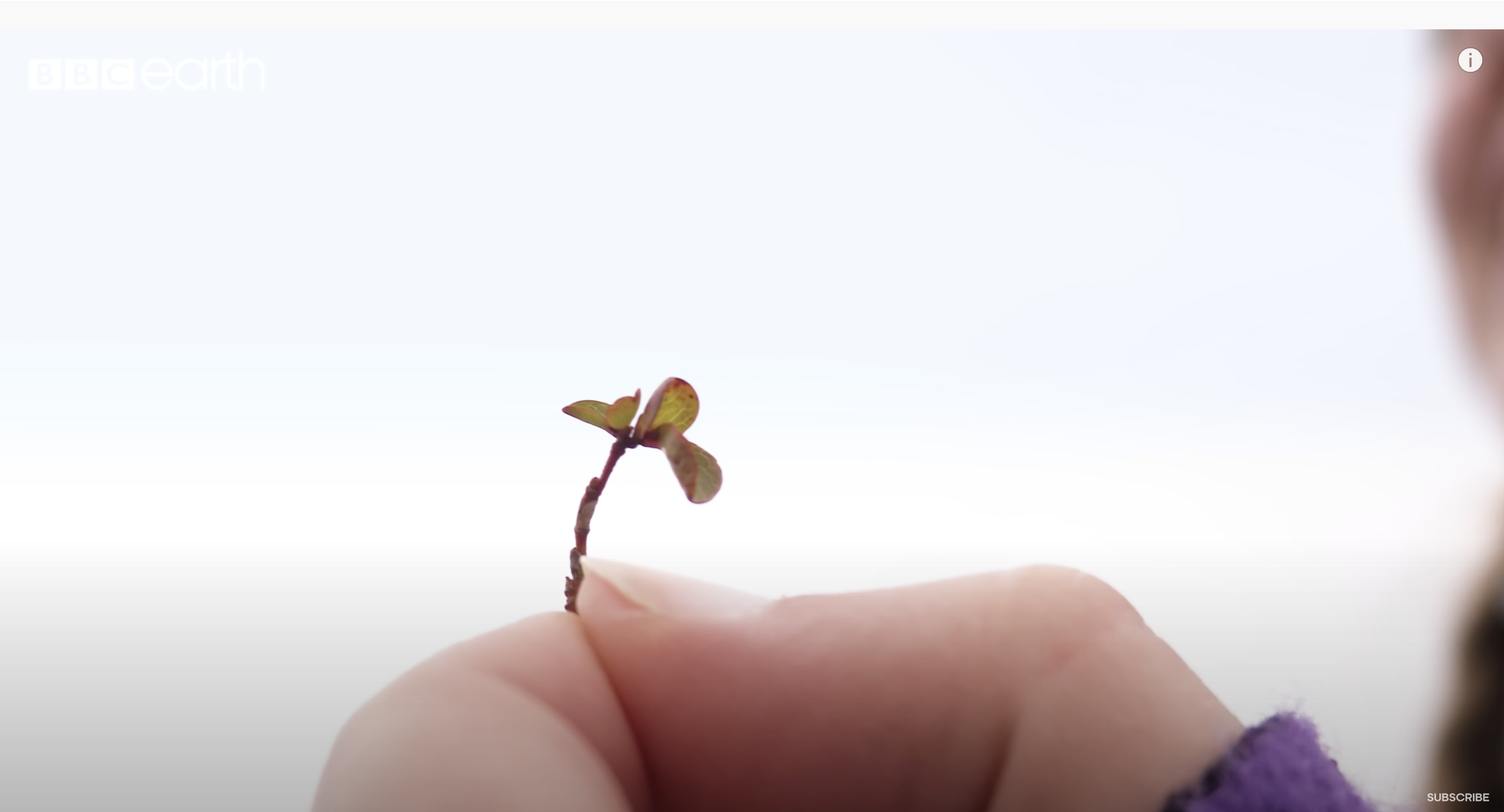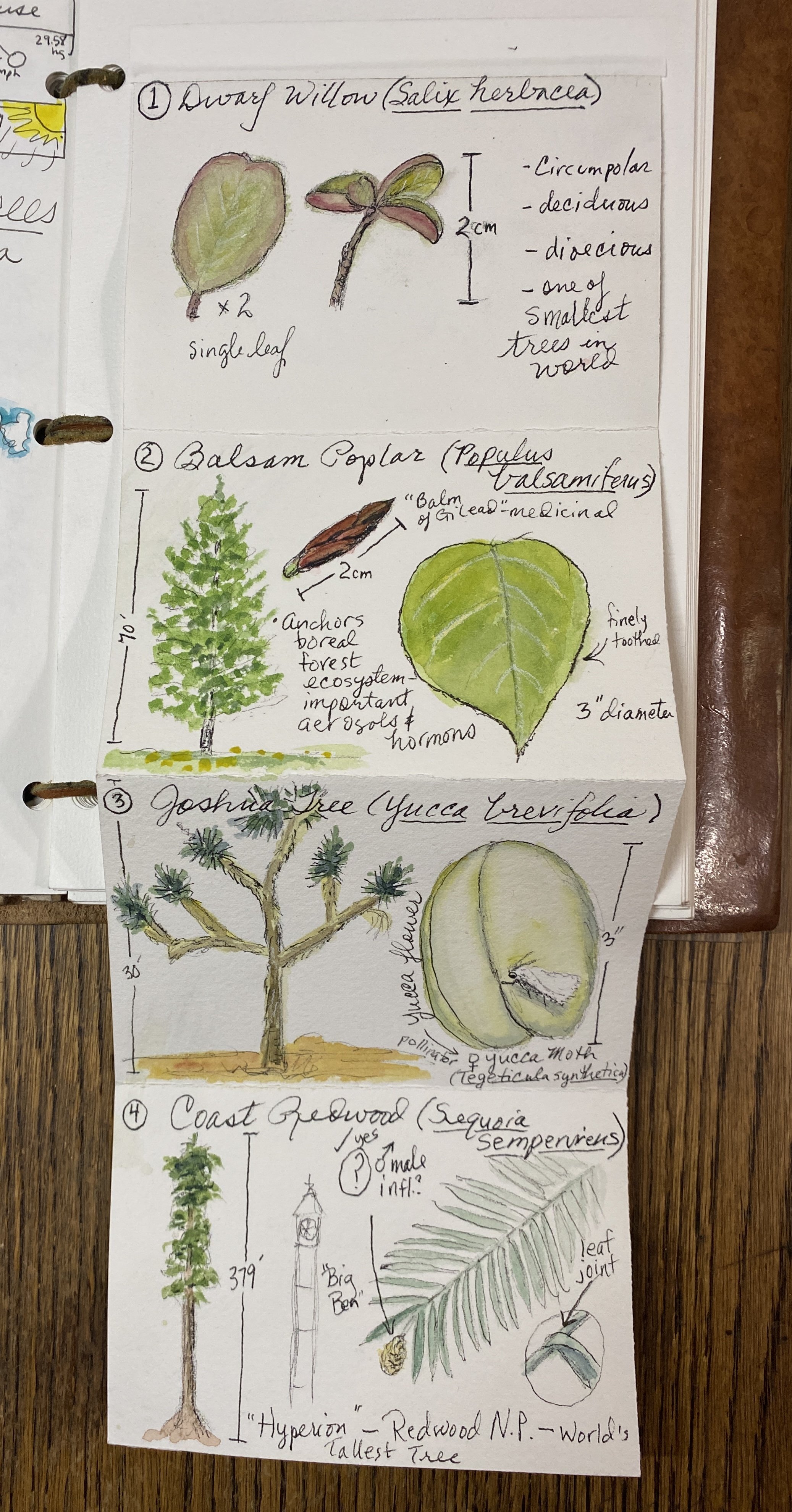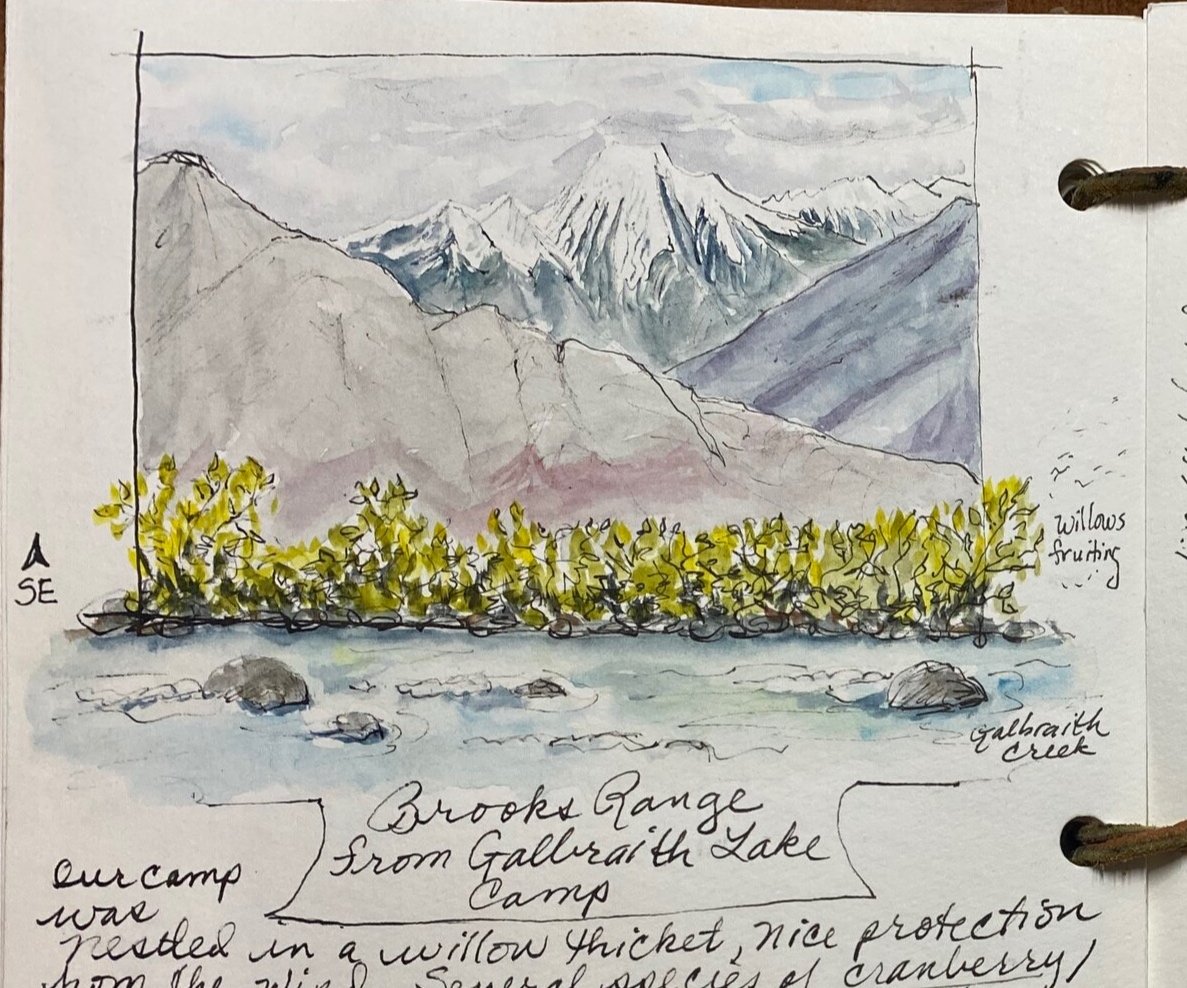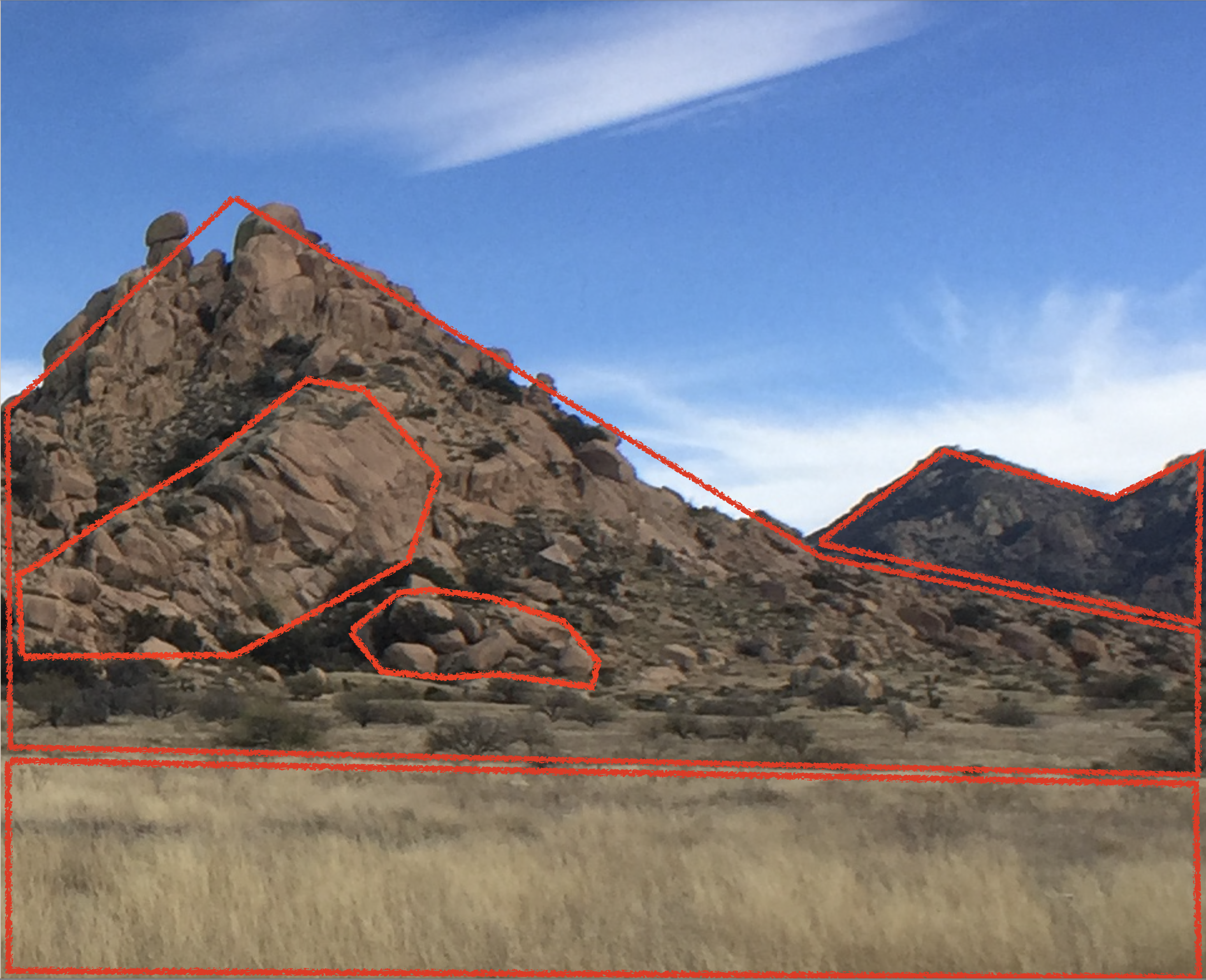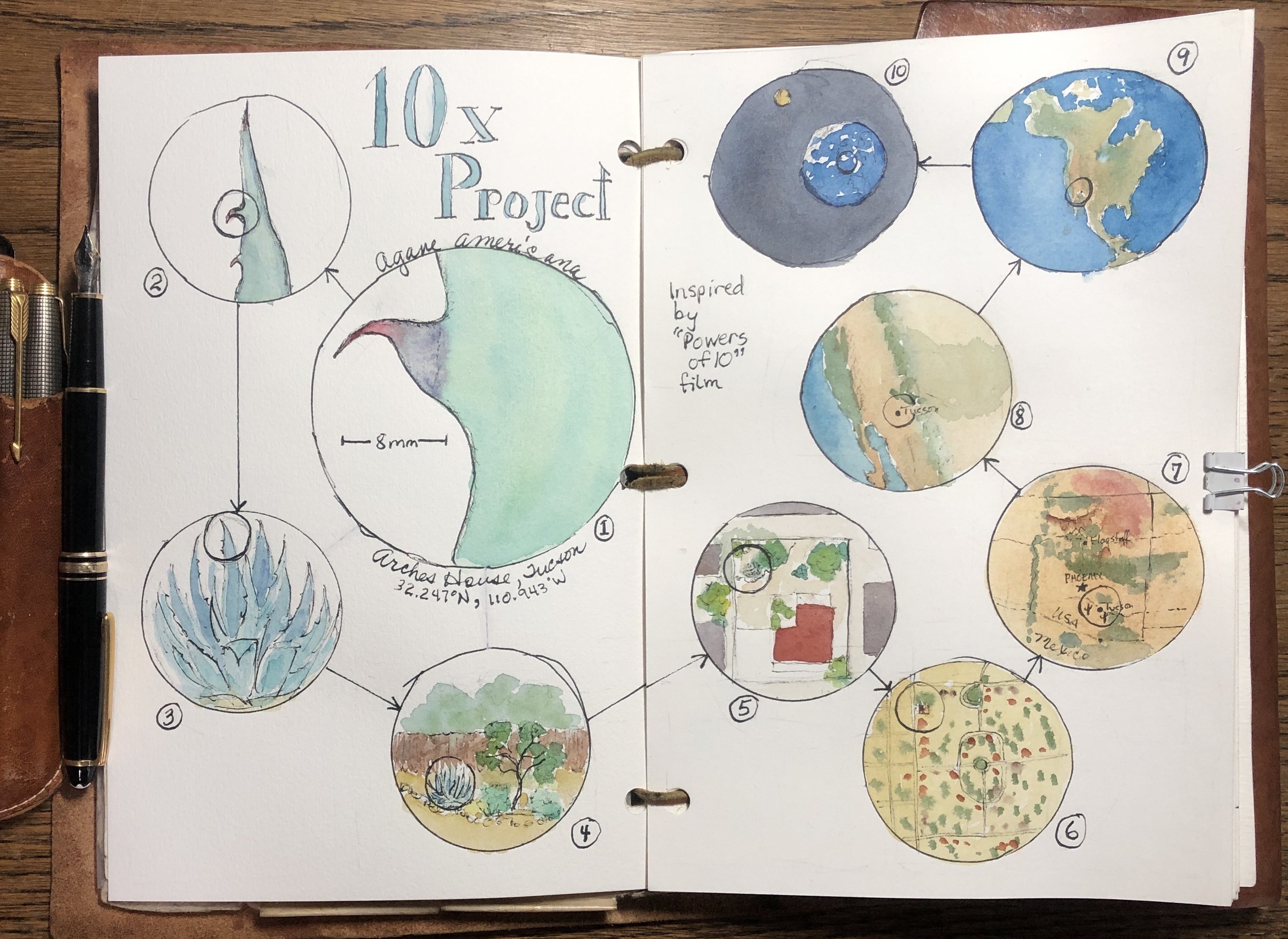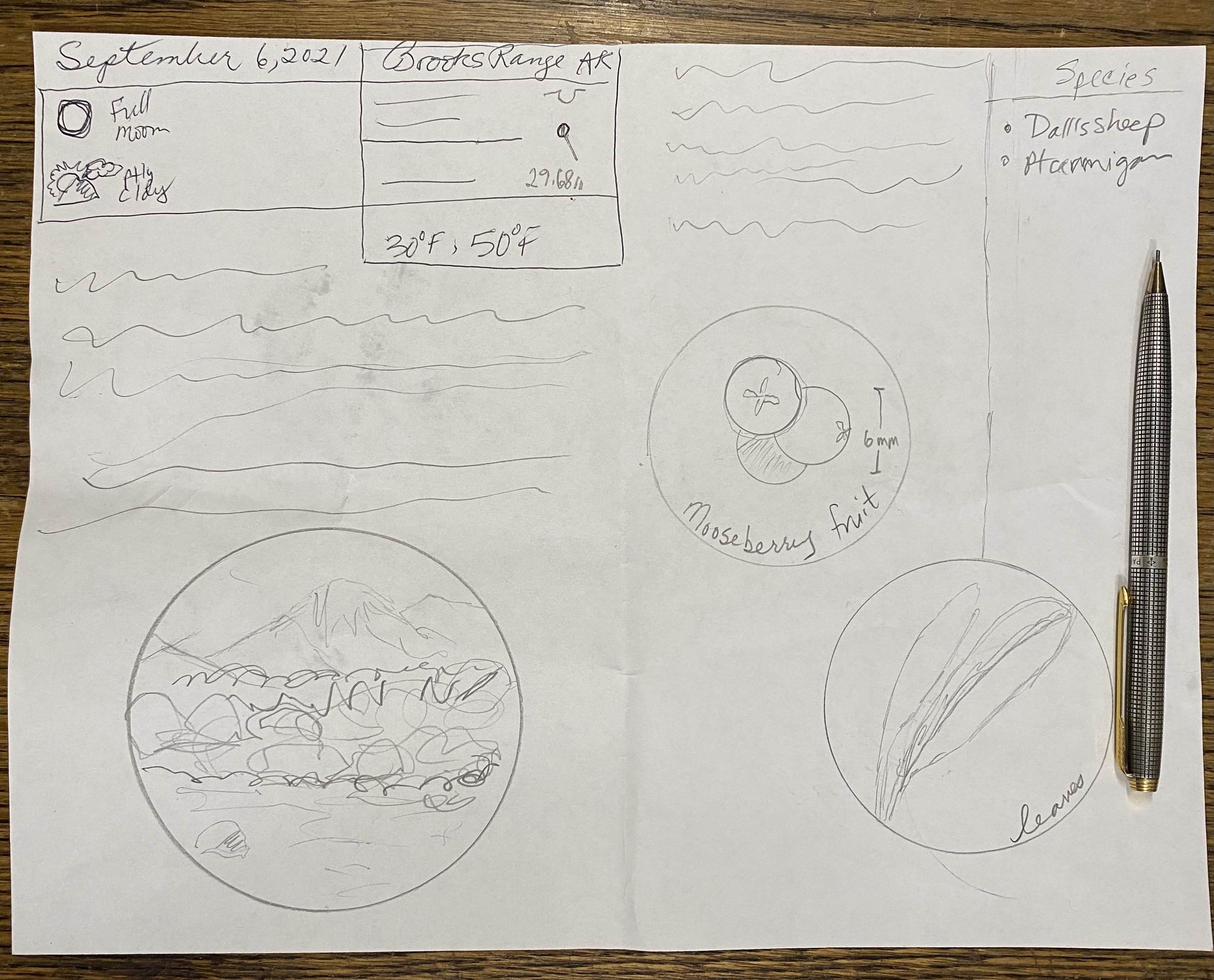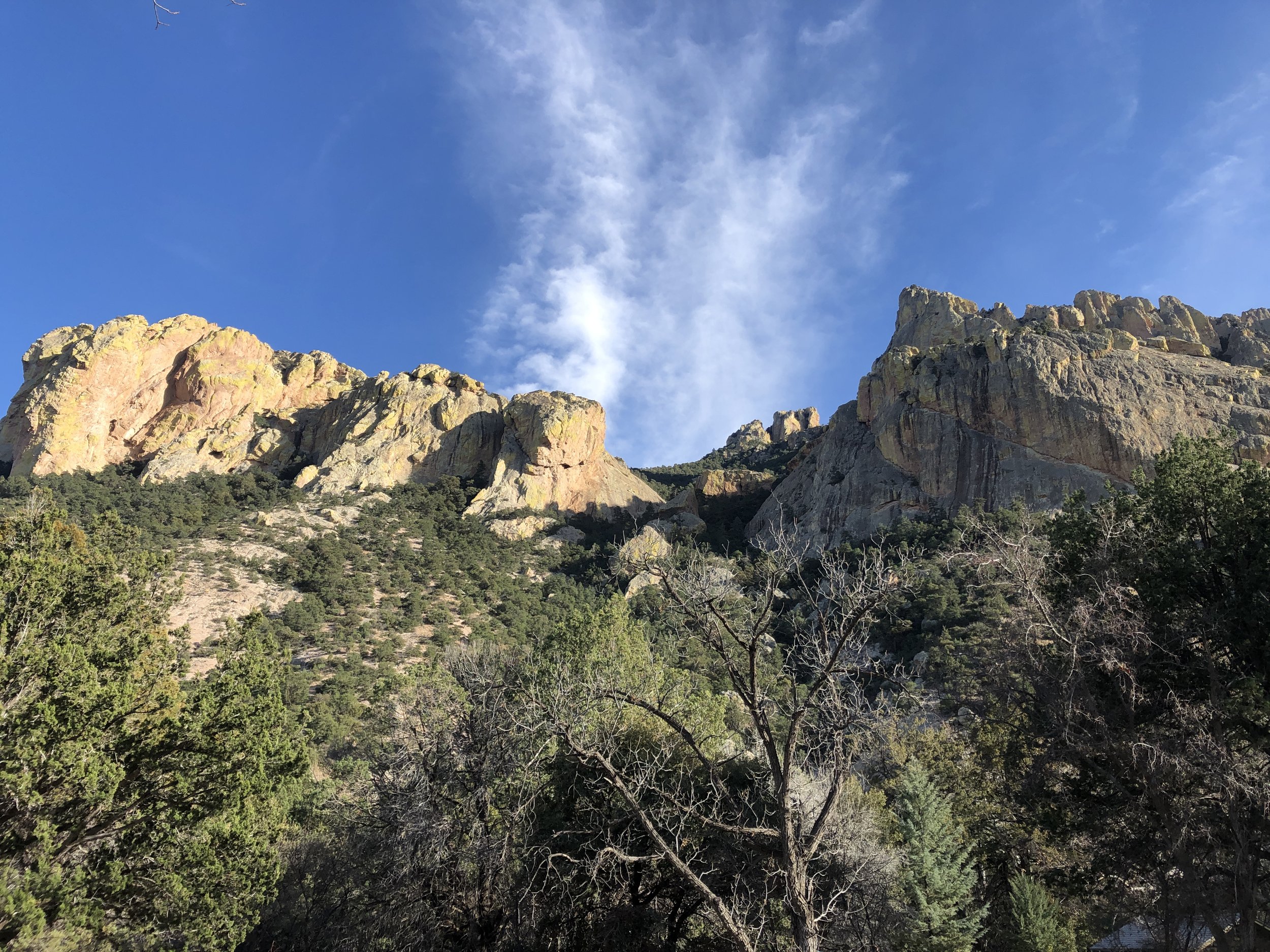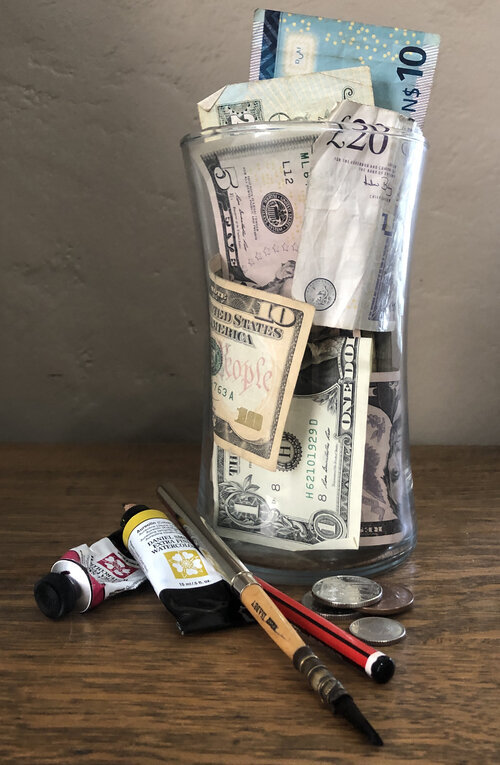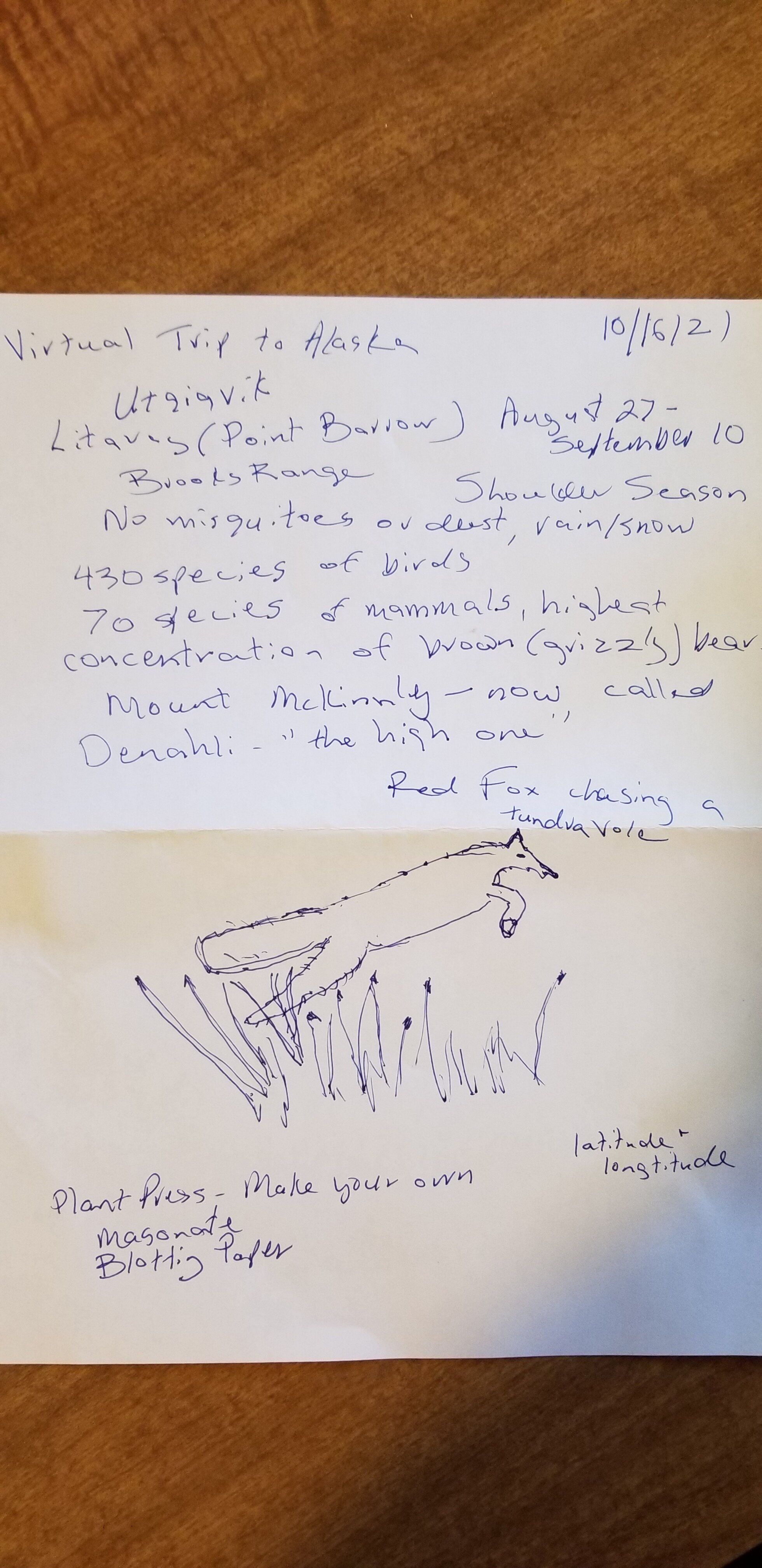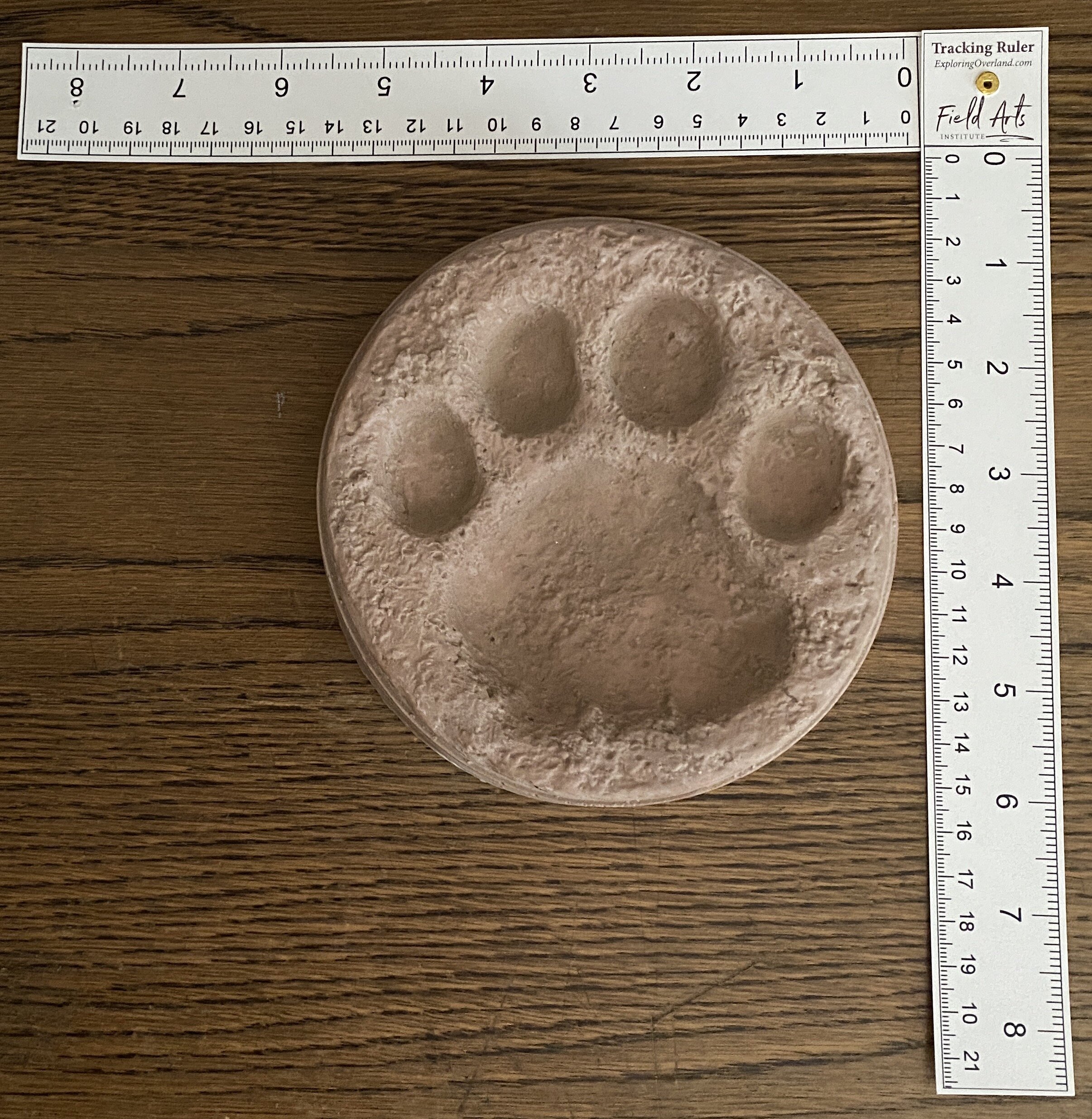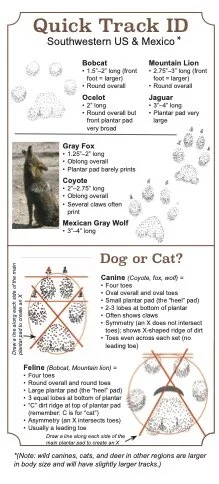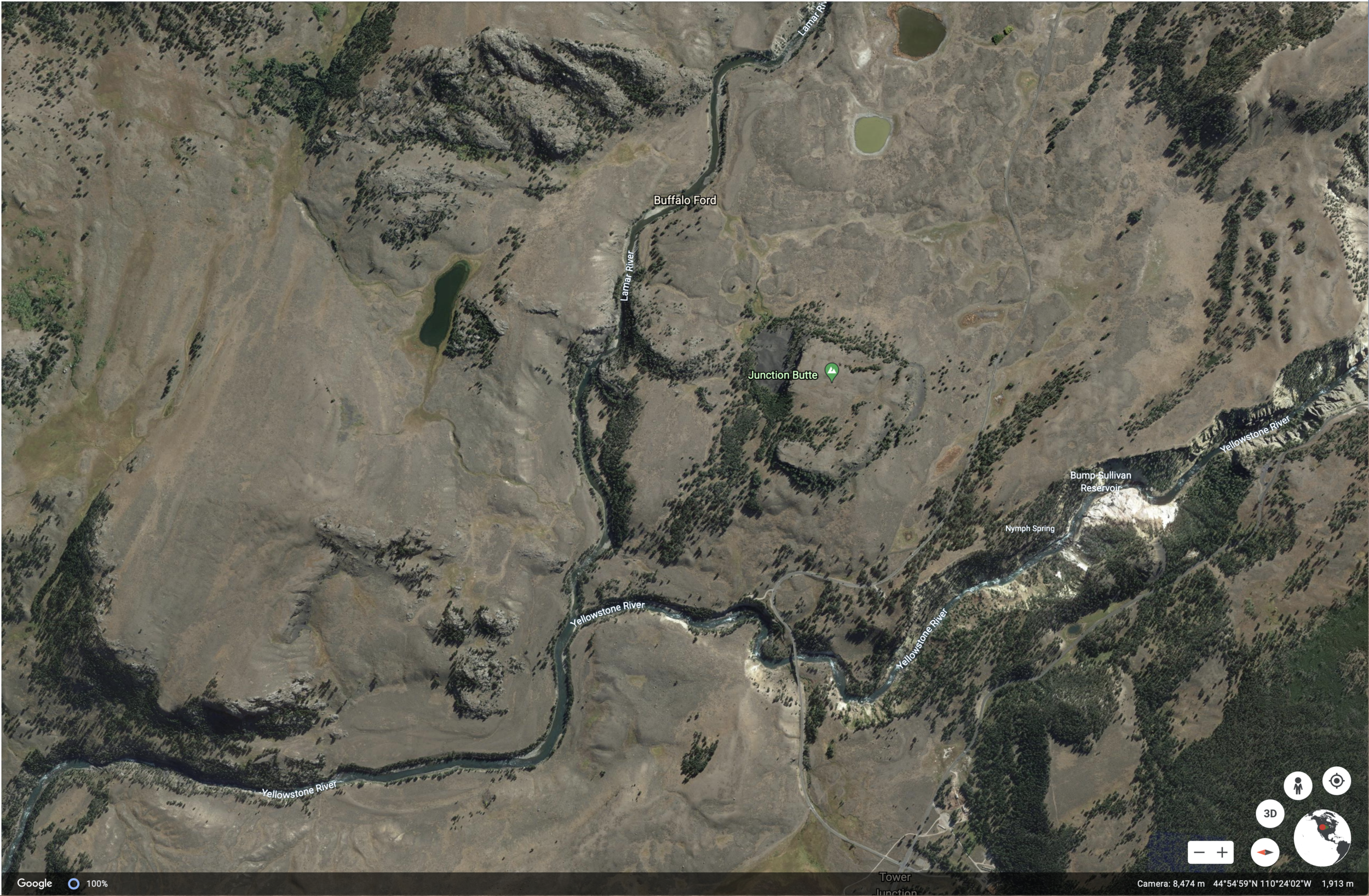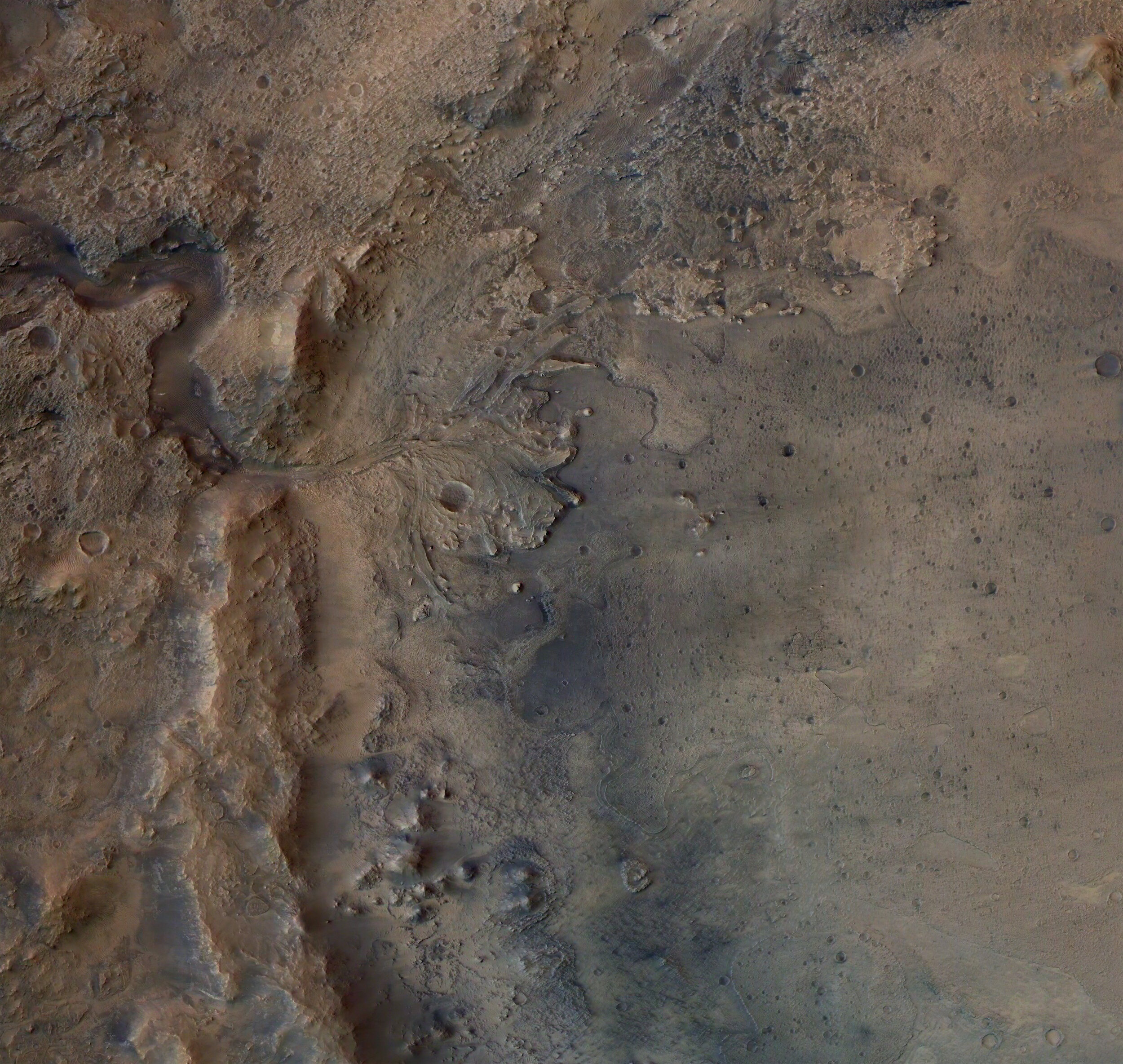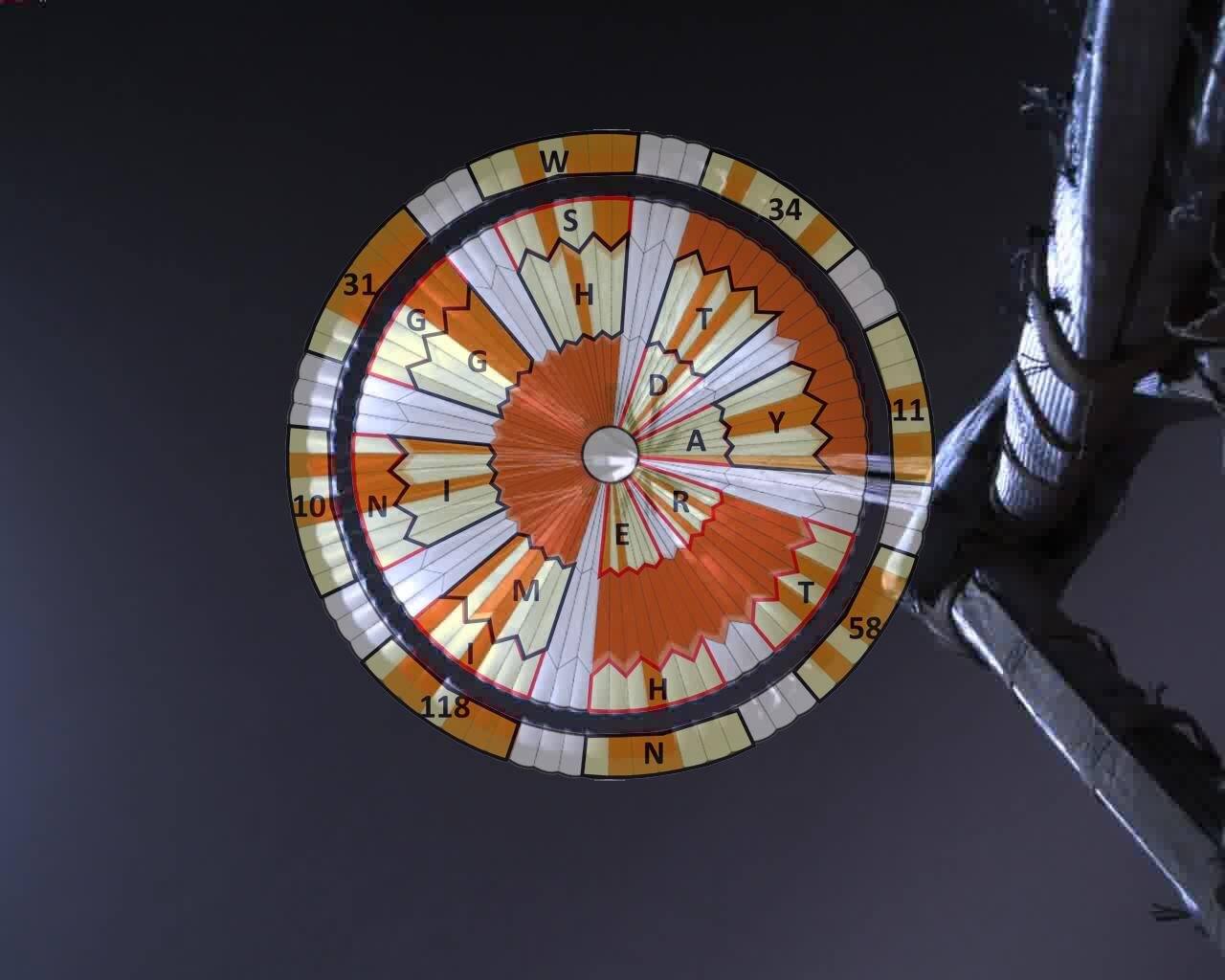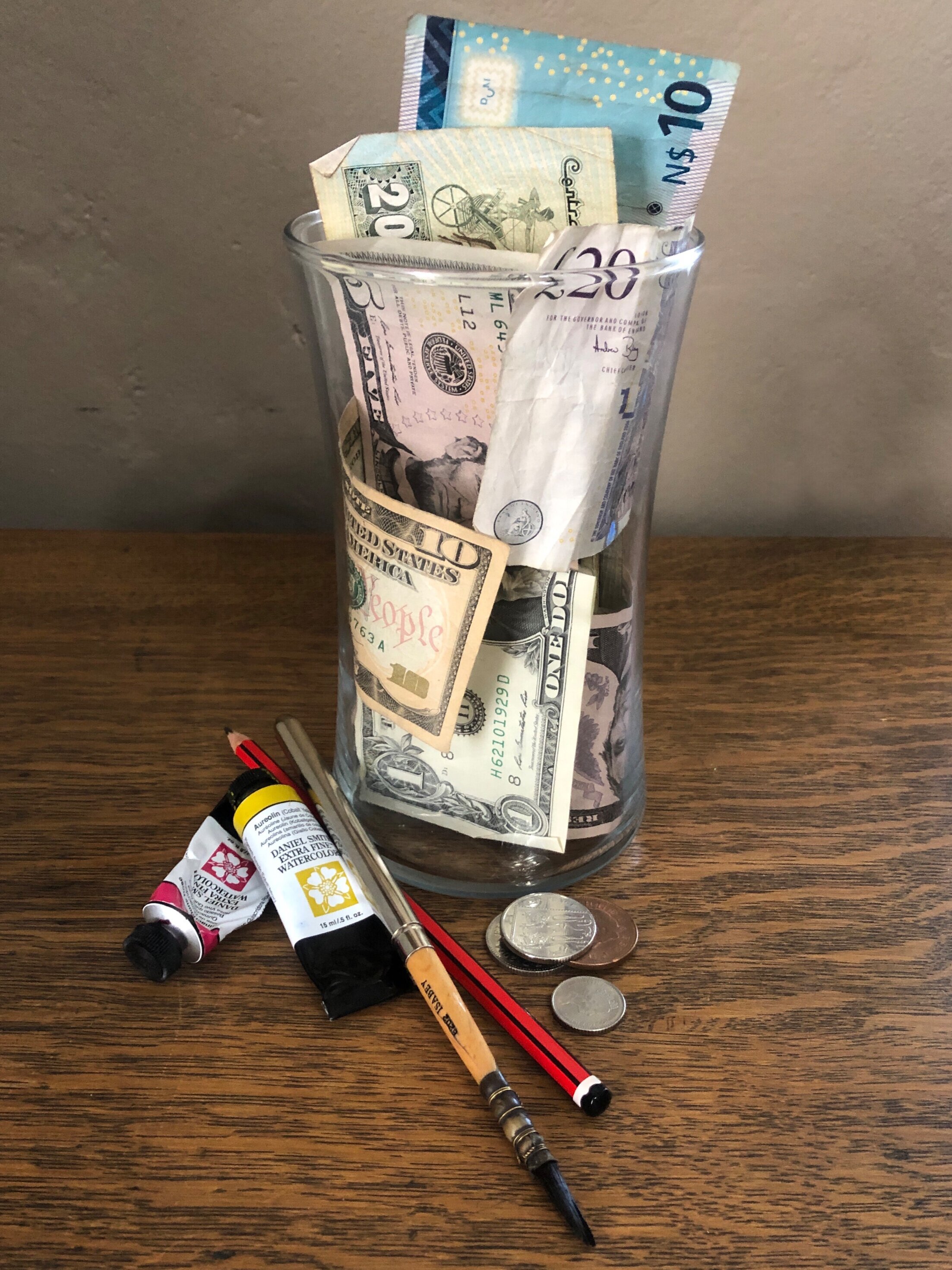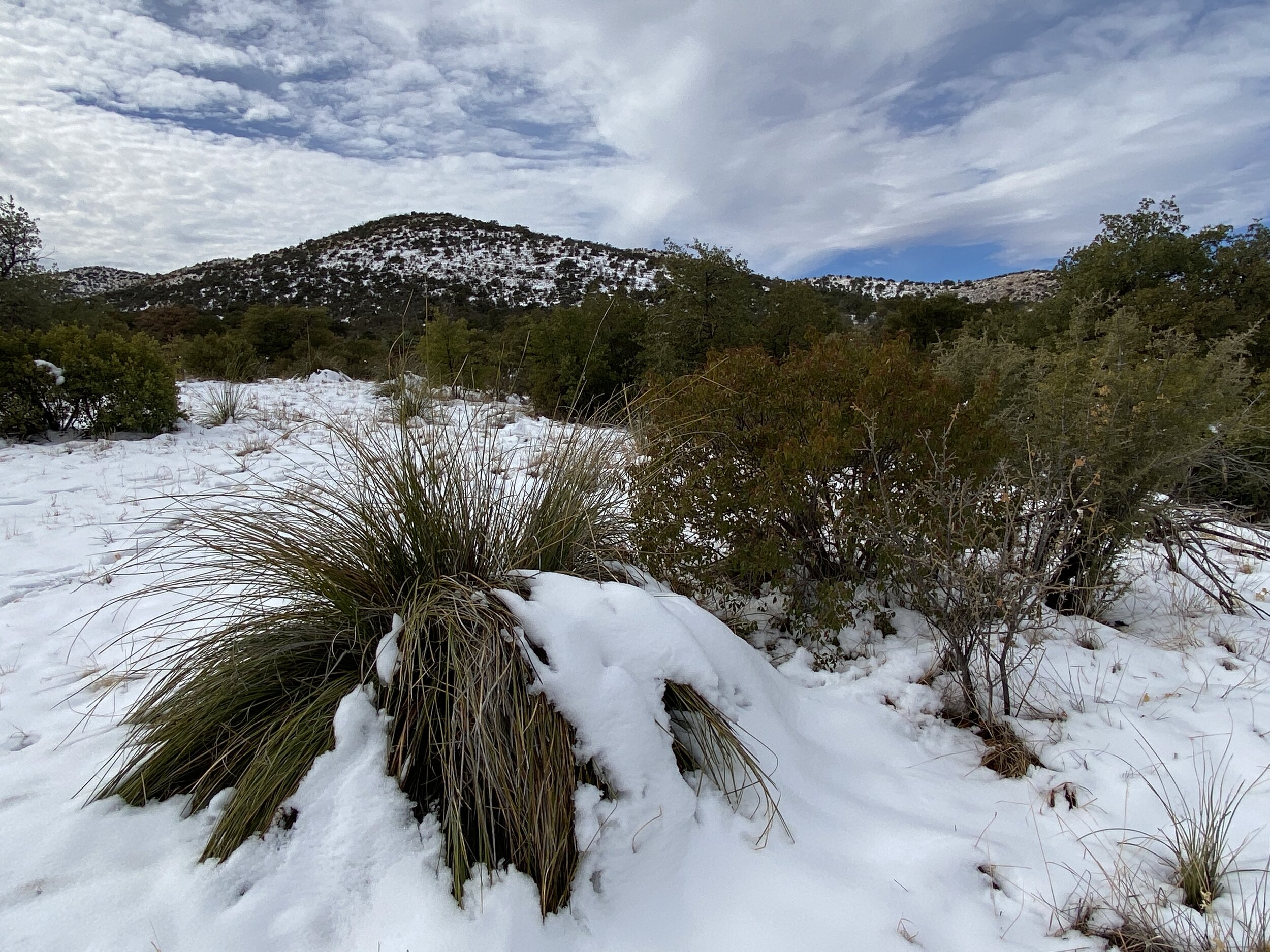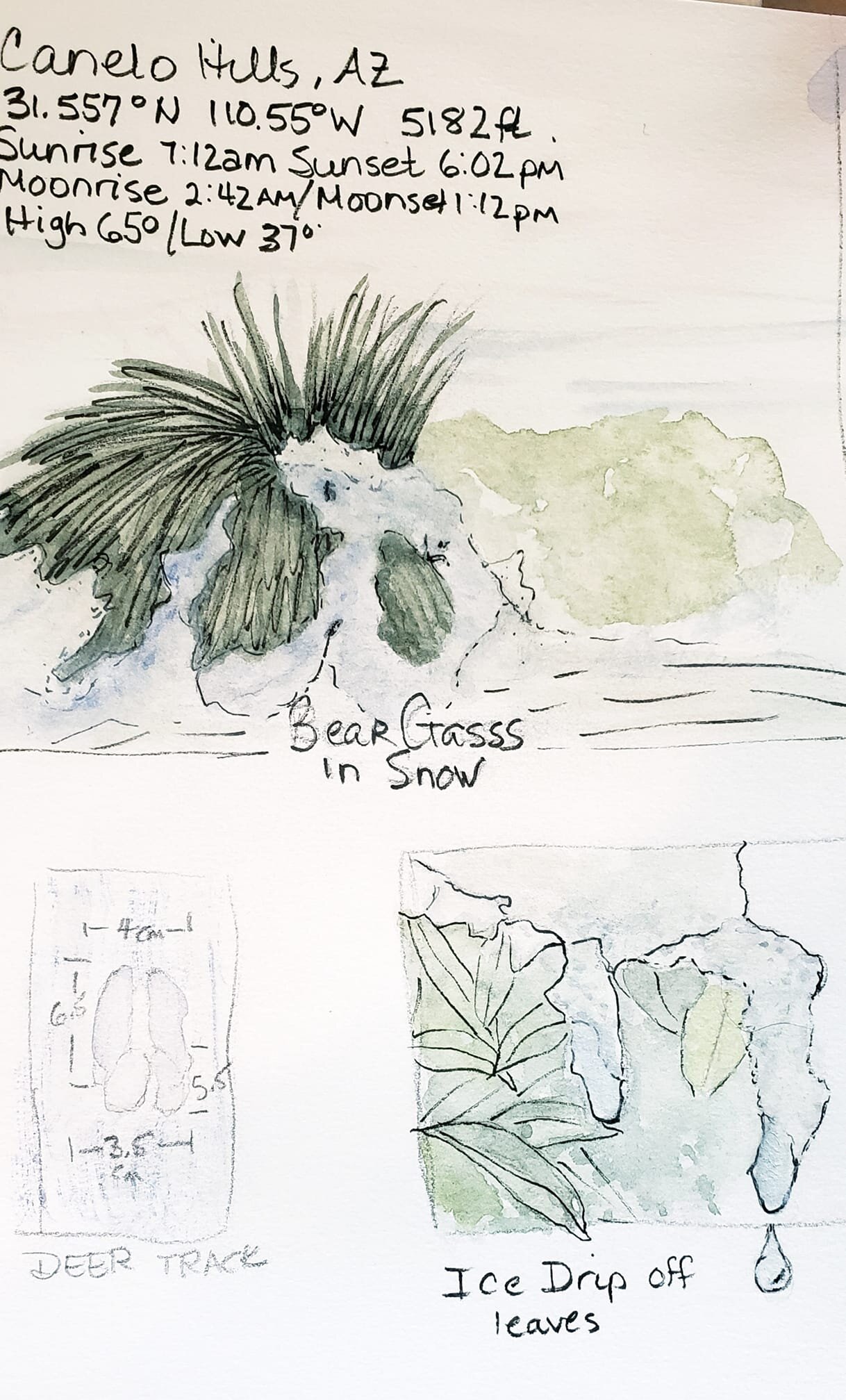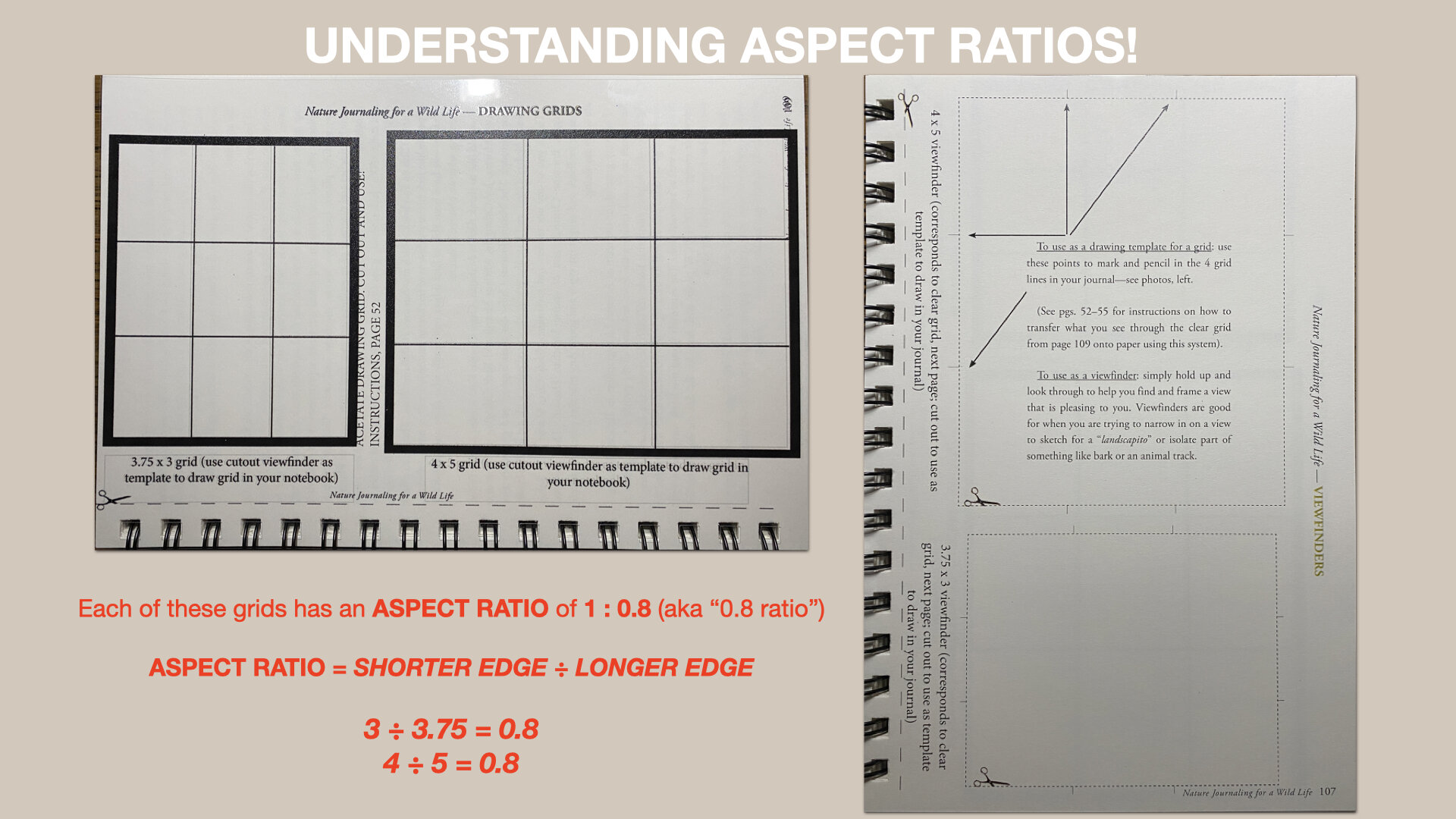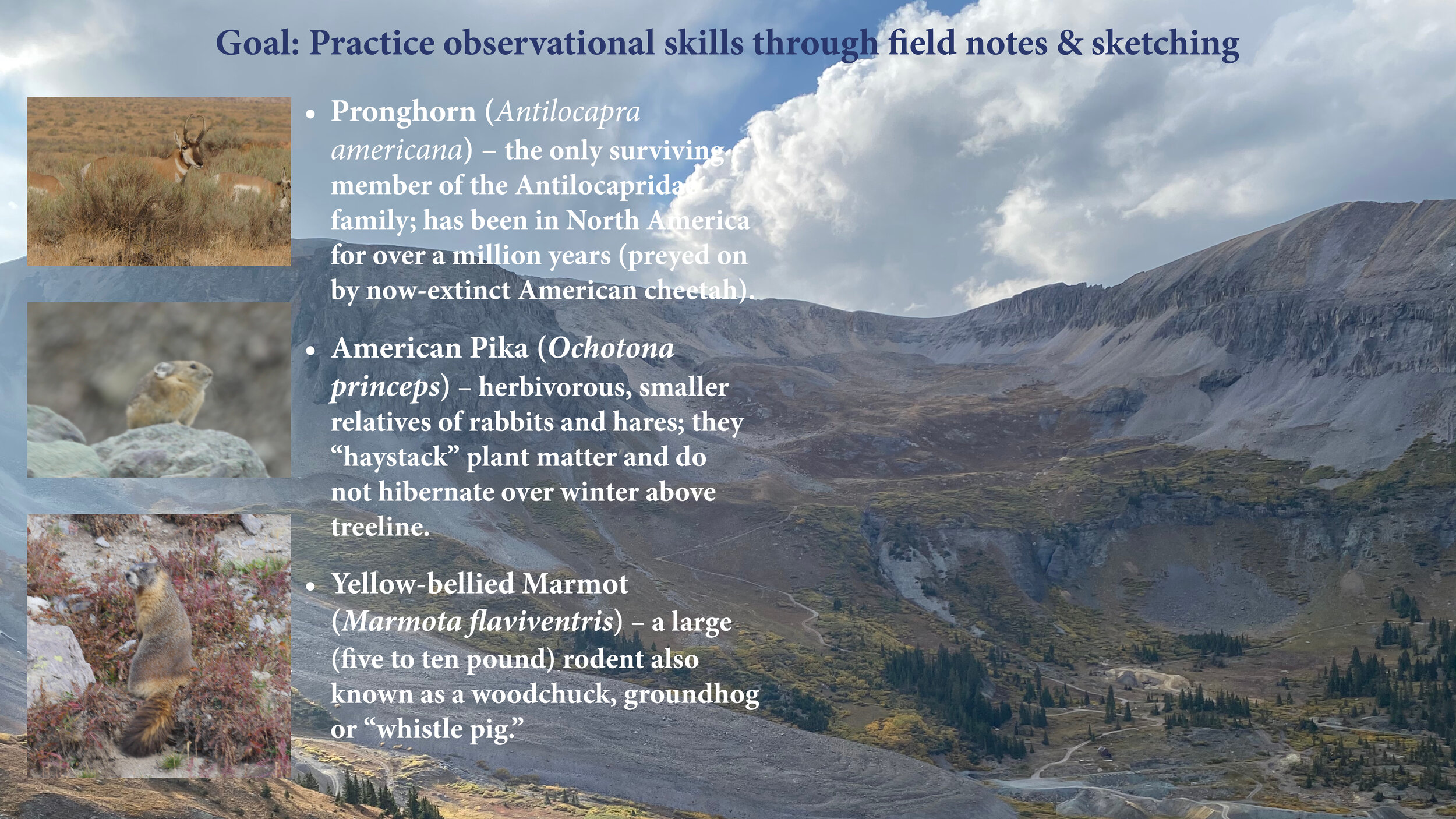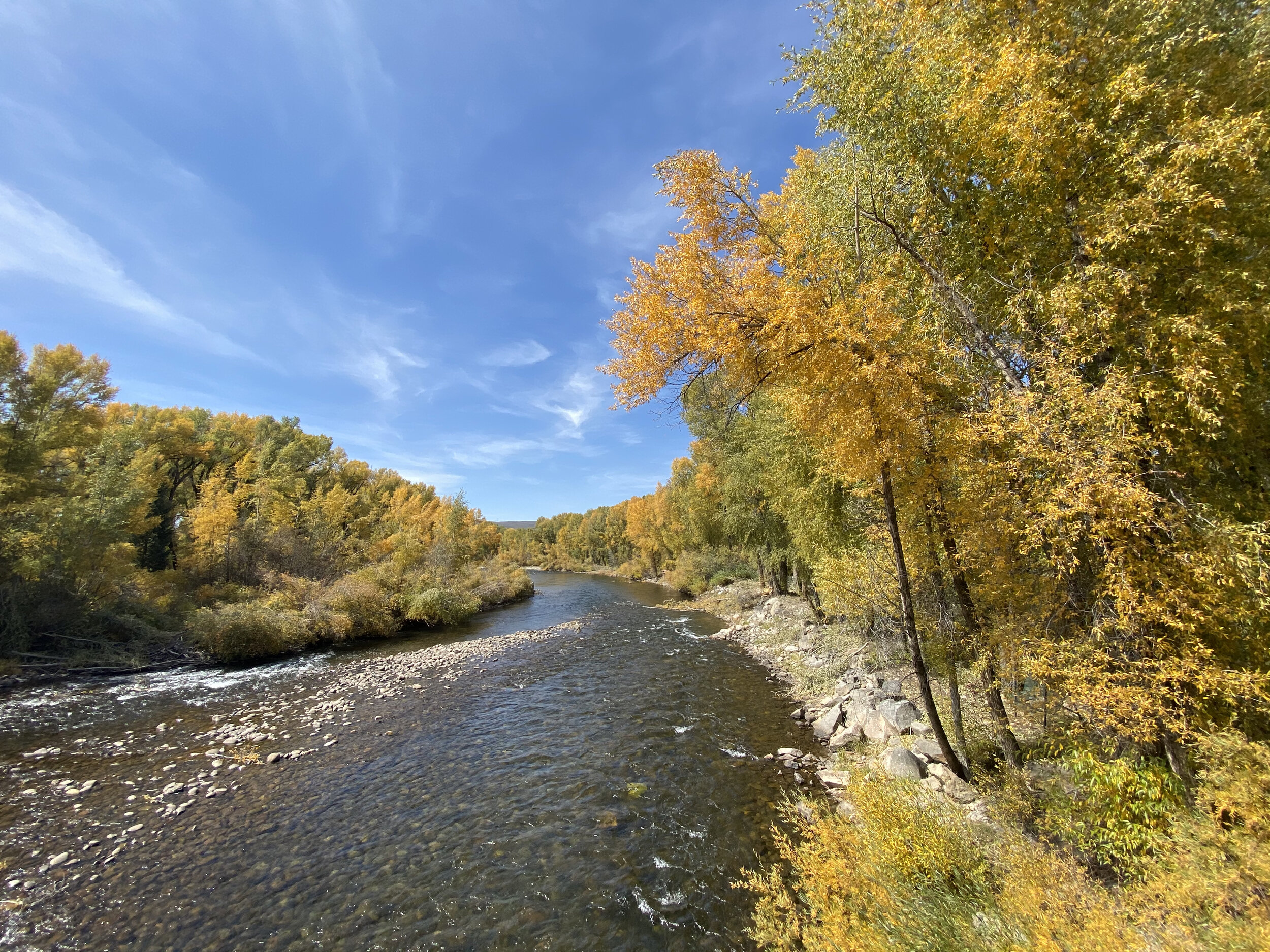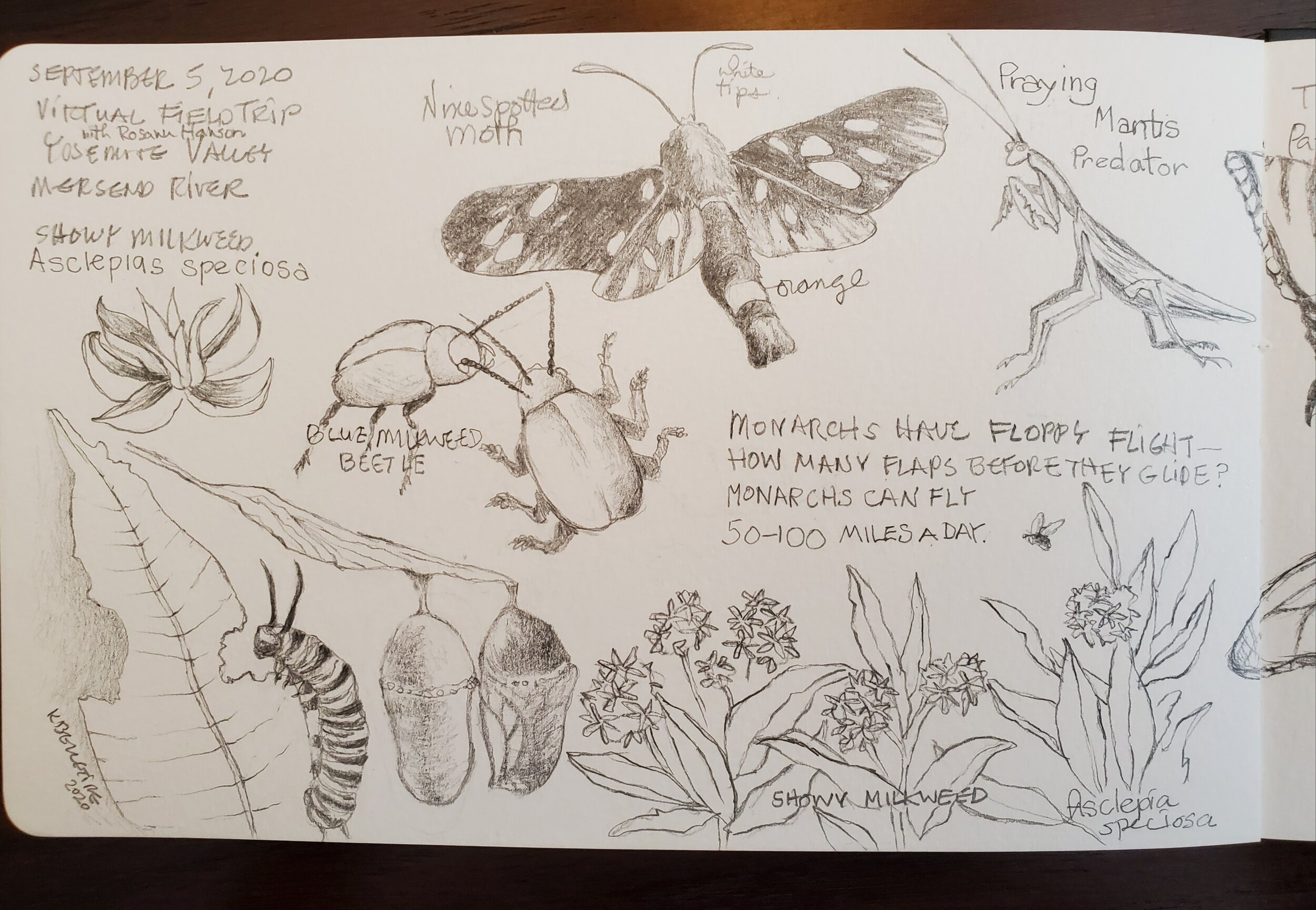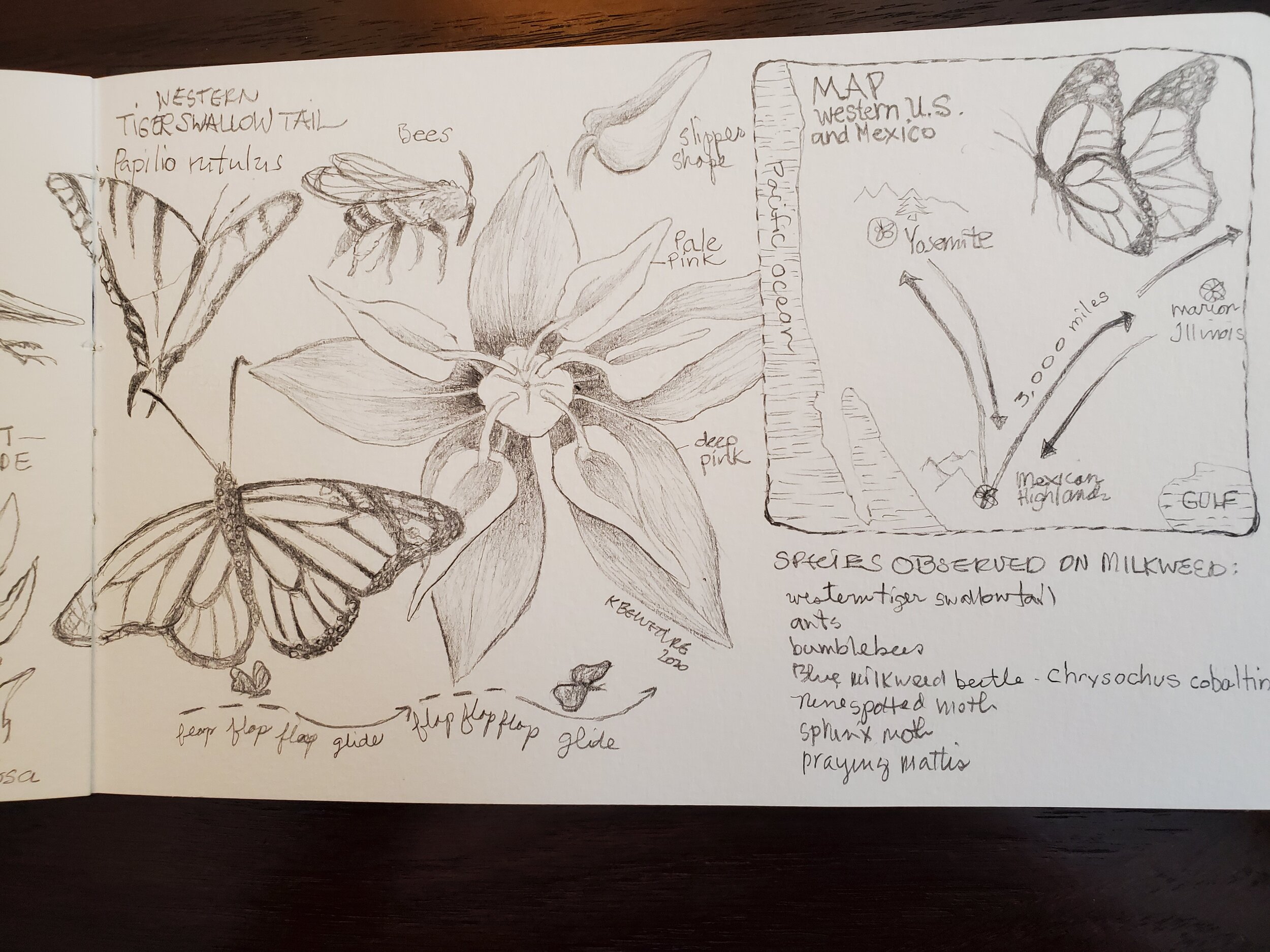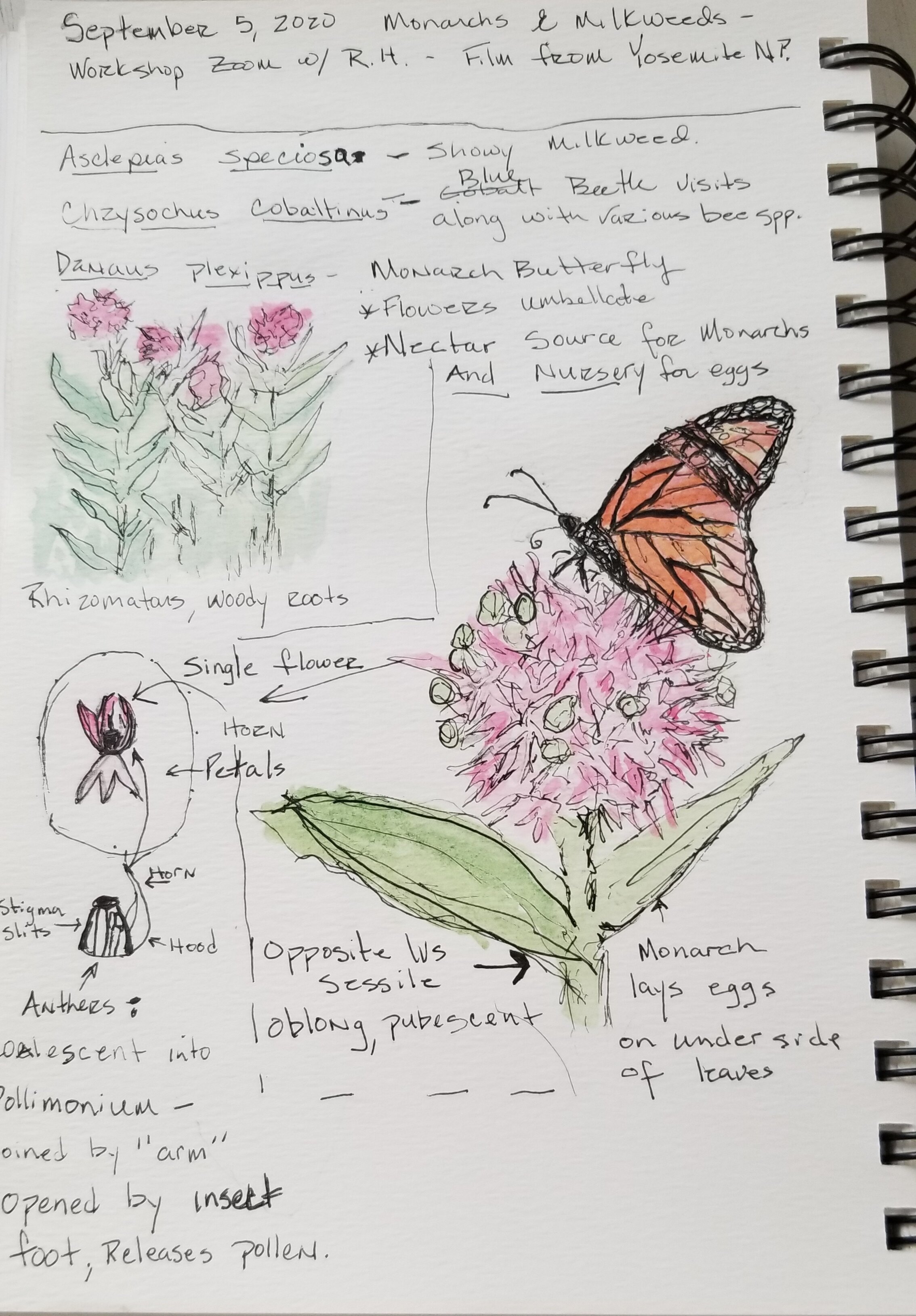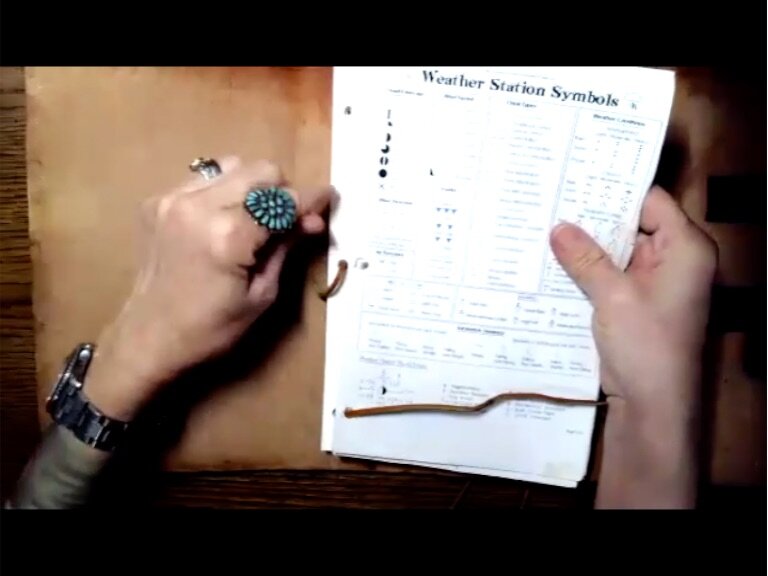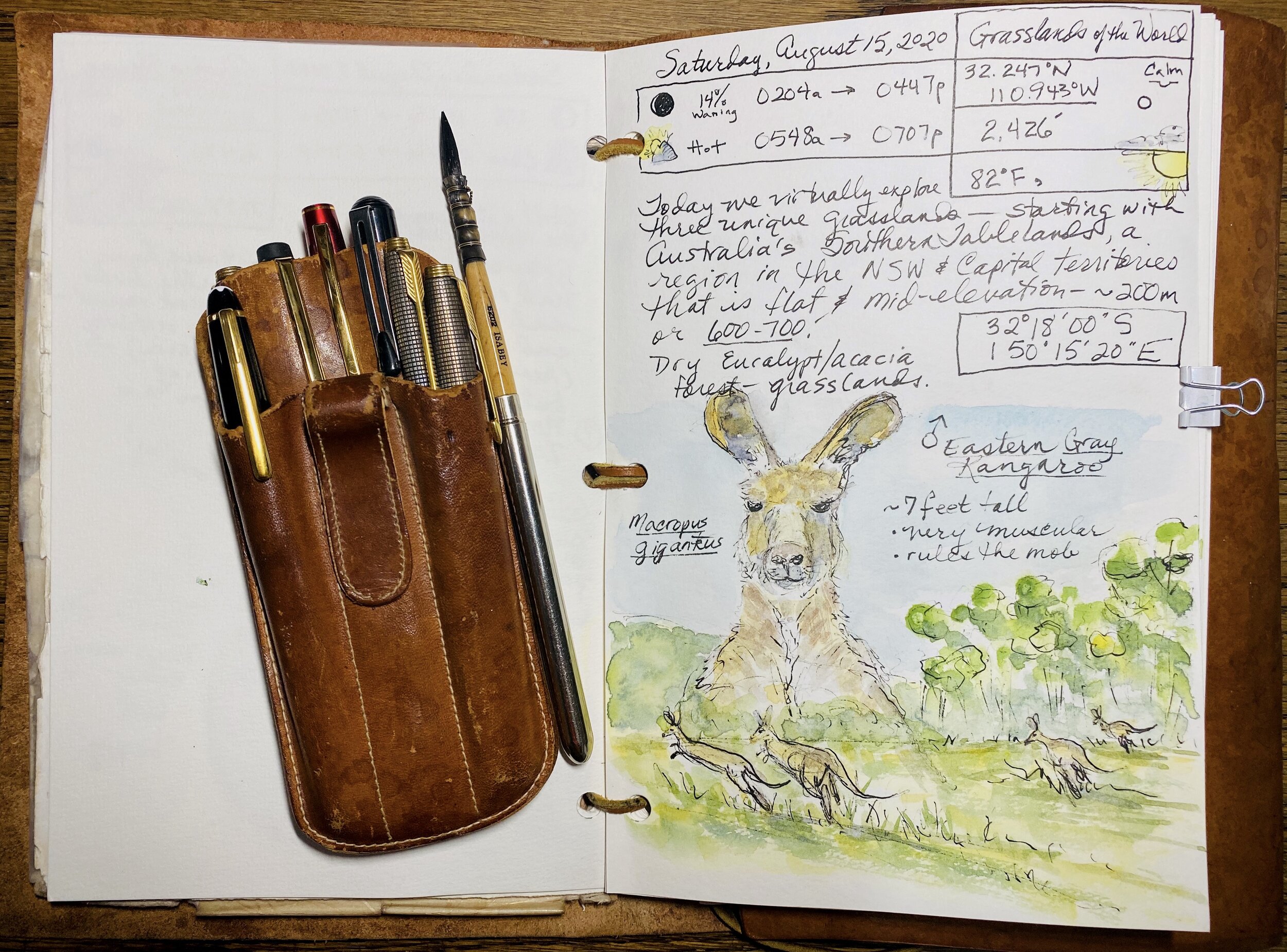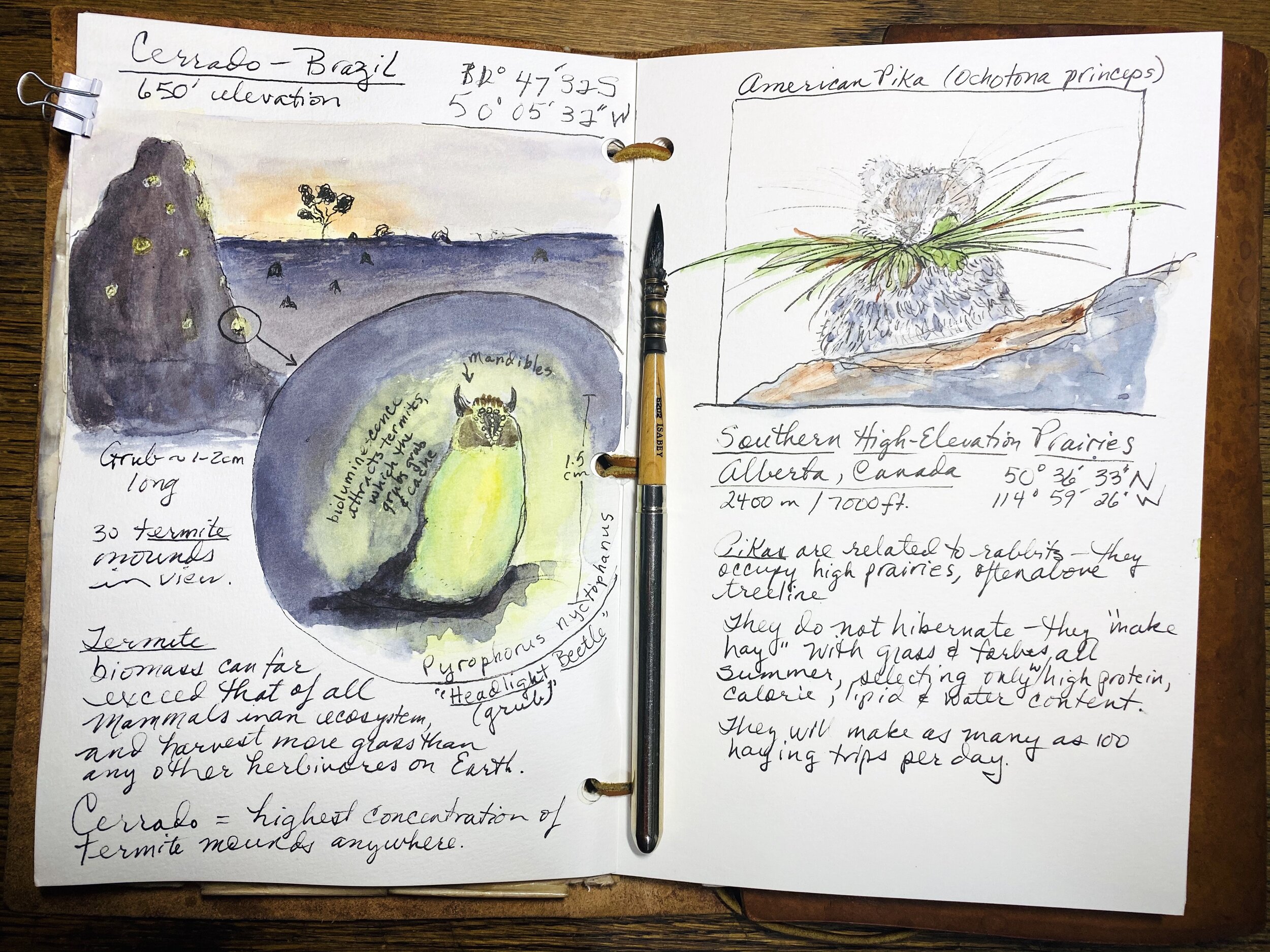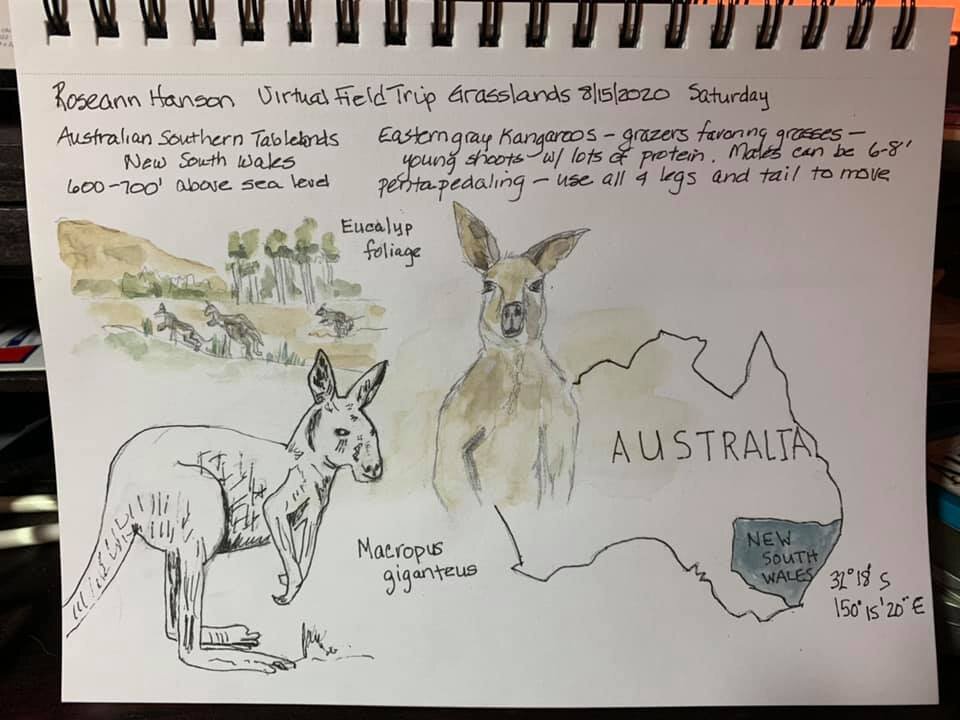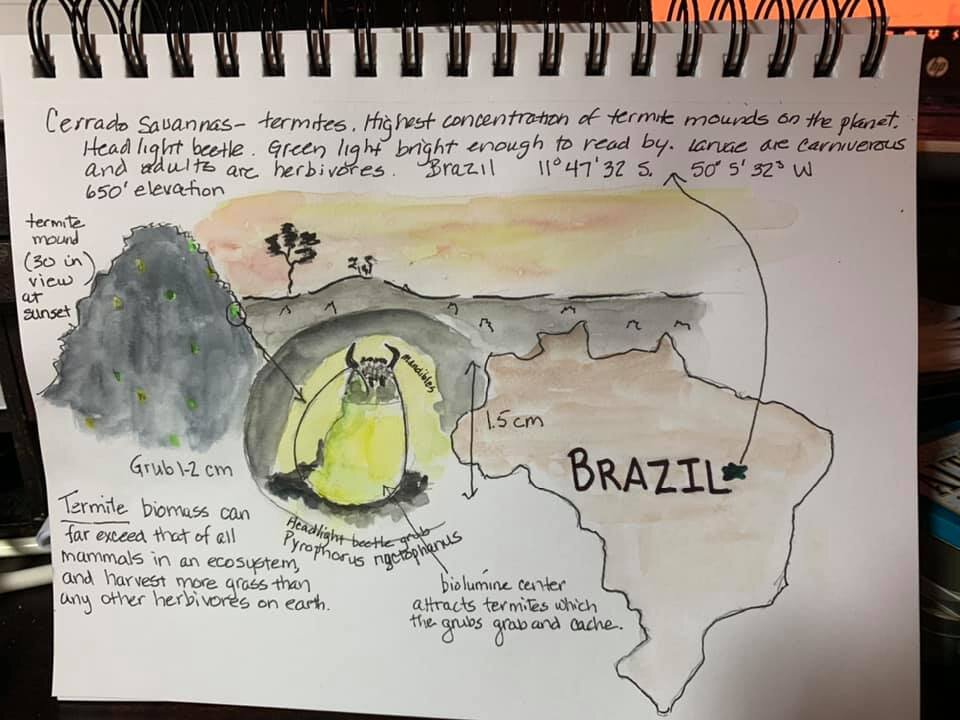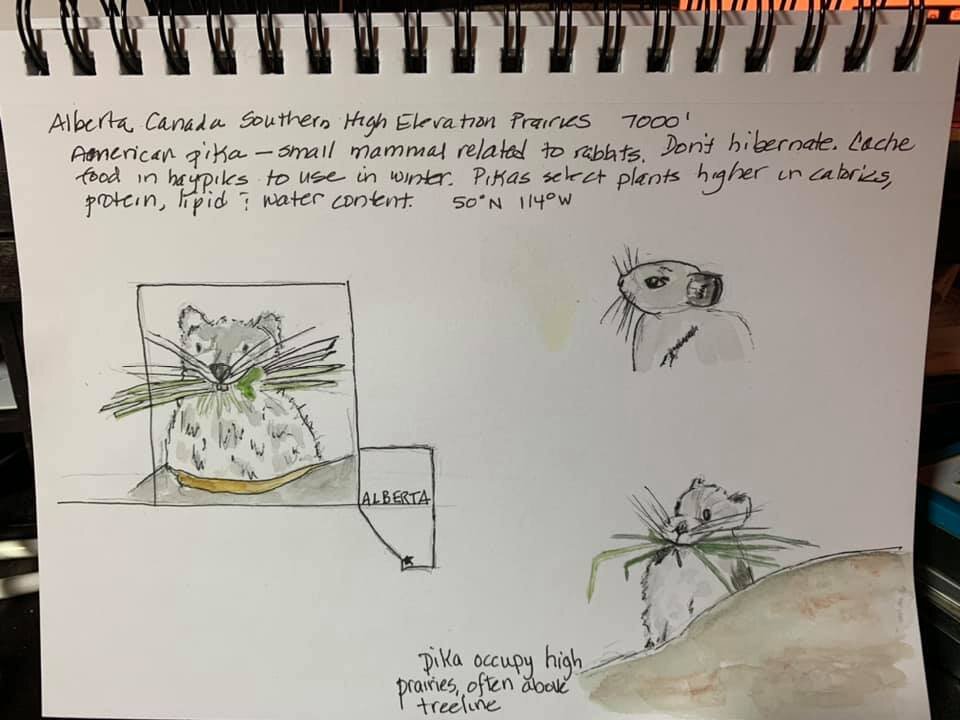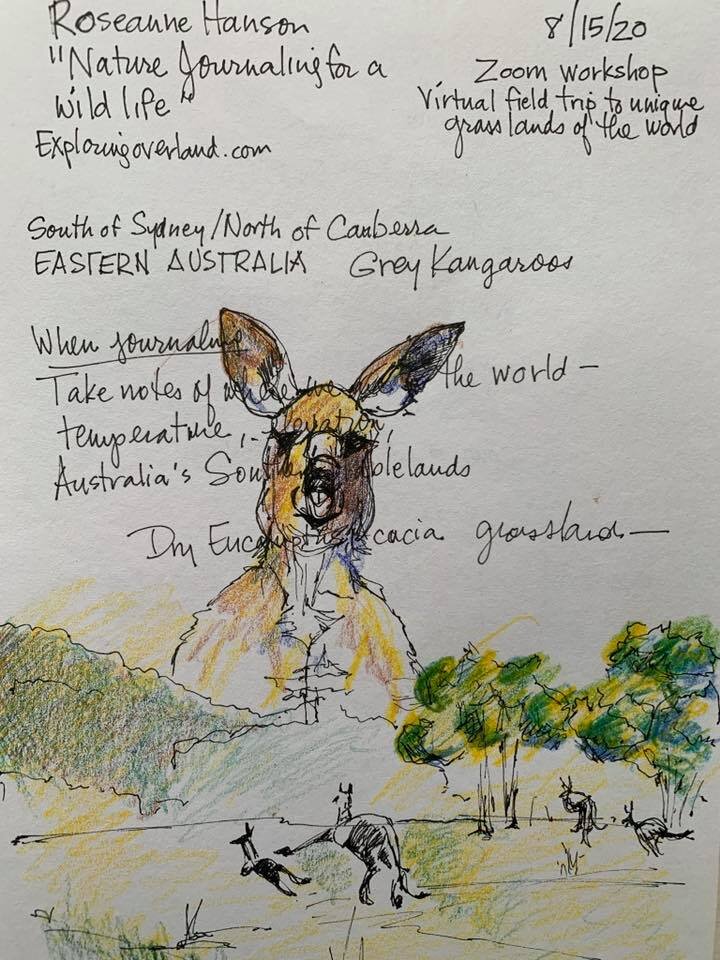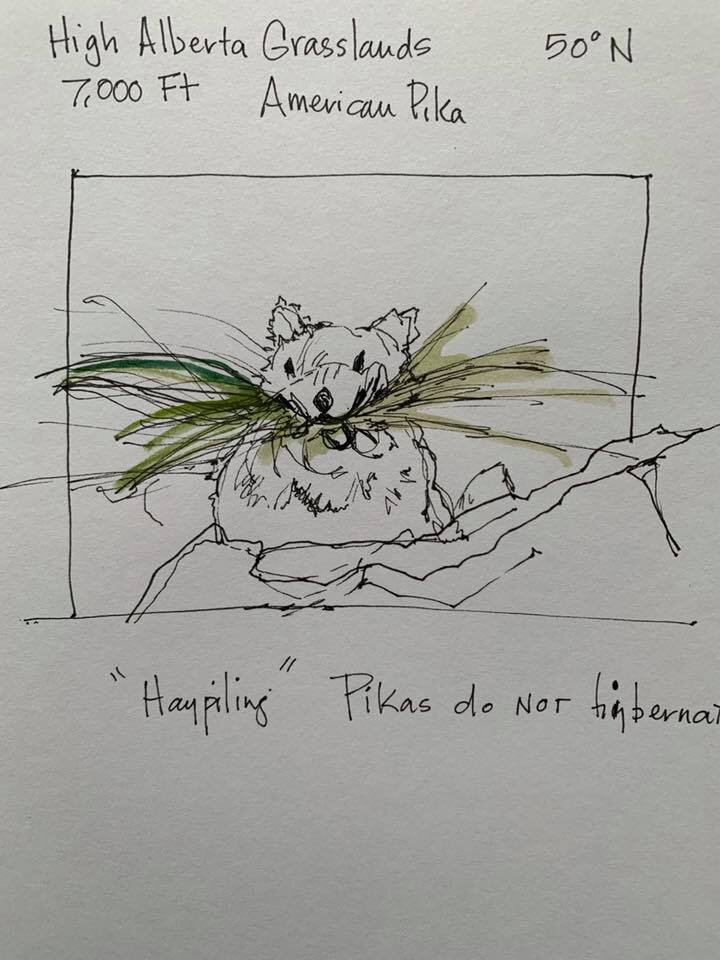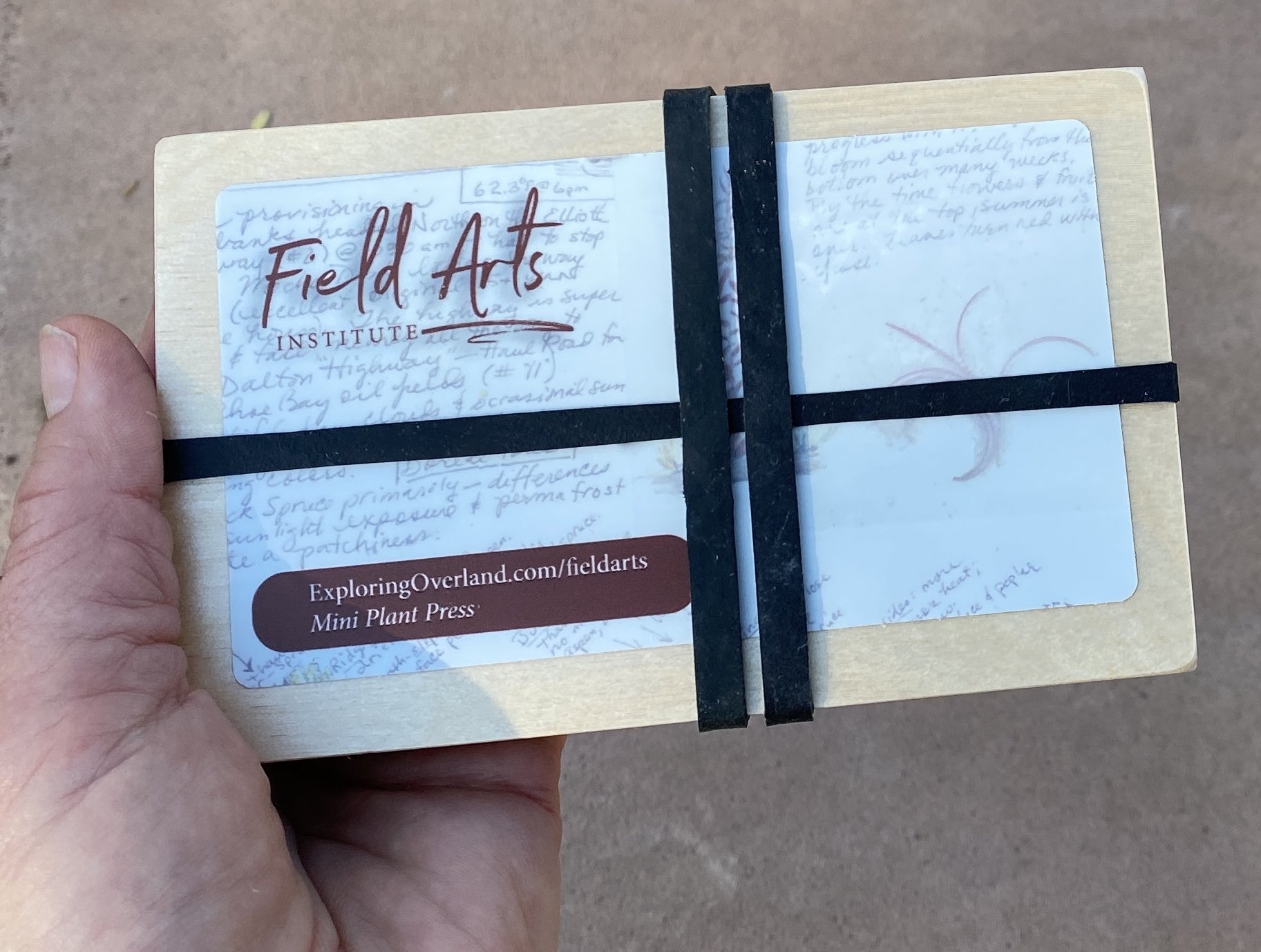Field Arts Workshop: Around the World in 80 Trees No. 1 (N. America)
Inspired by Jonathan Drori’s wonderful books Around the World in 80 Trees and Around the World Plants, we’re going to travel around the globe by region and sketch interesting, weird, iconic, or beautiful trees and tree-like plants.
Stop 1: North America!
What you’ll need: a multi-media sketchbook or an accordion style booklet (see below), pen and / or pencil for our base drawings, and then watercolor or colored pencil to quickly bring them to life.
TIP: I used a strip of heavy watercolor paper folded into four squares to create an “accordion” booklet to record my trees (8 total, 4 on each side).
Prepwork: have on hand a simple outline map of North America (from the Arctic to Panama) so you can sketch location points for each species.
Length: 2 hours
Downloads and Resources
Click to initiate download of a PDF of the workshop presentation (large file) * Please do not circulate this PDF; if you wish to share the workshop, please use the page link:
Locations of the 8 species for this workshop (these are not the ranges, but the site where the specimen we sketch is located).
Tip: Create an outline of North America in your journal so you can mark the site locations of our sketched species. Credit: TimVandevall.com
Books and References:
Treeline: The Last Forest and the Future of Life on Earth by Ben Rawlance
NYTimes article about Diana Beresford-Kroeger, a medical biochemist, botanist, organic chemist, poet, author, and developer of artificial blood. But her main focus for decades now has been to telegraph to the world, in prose that is scientifically exacting yet startlingly affecting, the wondrous capabilities of trees. She is featured in the Balsam Poplar chapter in Rawlance’s book.
Colors I use:
I favor a simple primary “triad” plus two extra colors: Manganese Blue (“cyan”), Quinacridone Rose (“magenta”), Aureolin Yellow (“yellow”), and Burnt Sienna and Indanthrone Blue, all Daniel Smith.
ROSEANN’S FINISHED ACCORDION PAGE
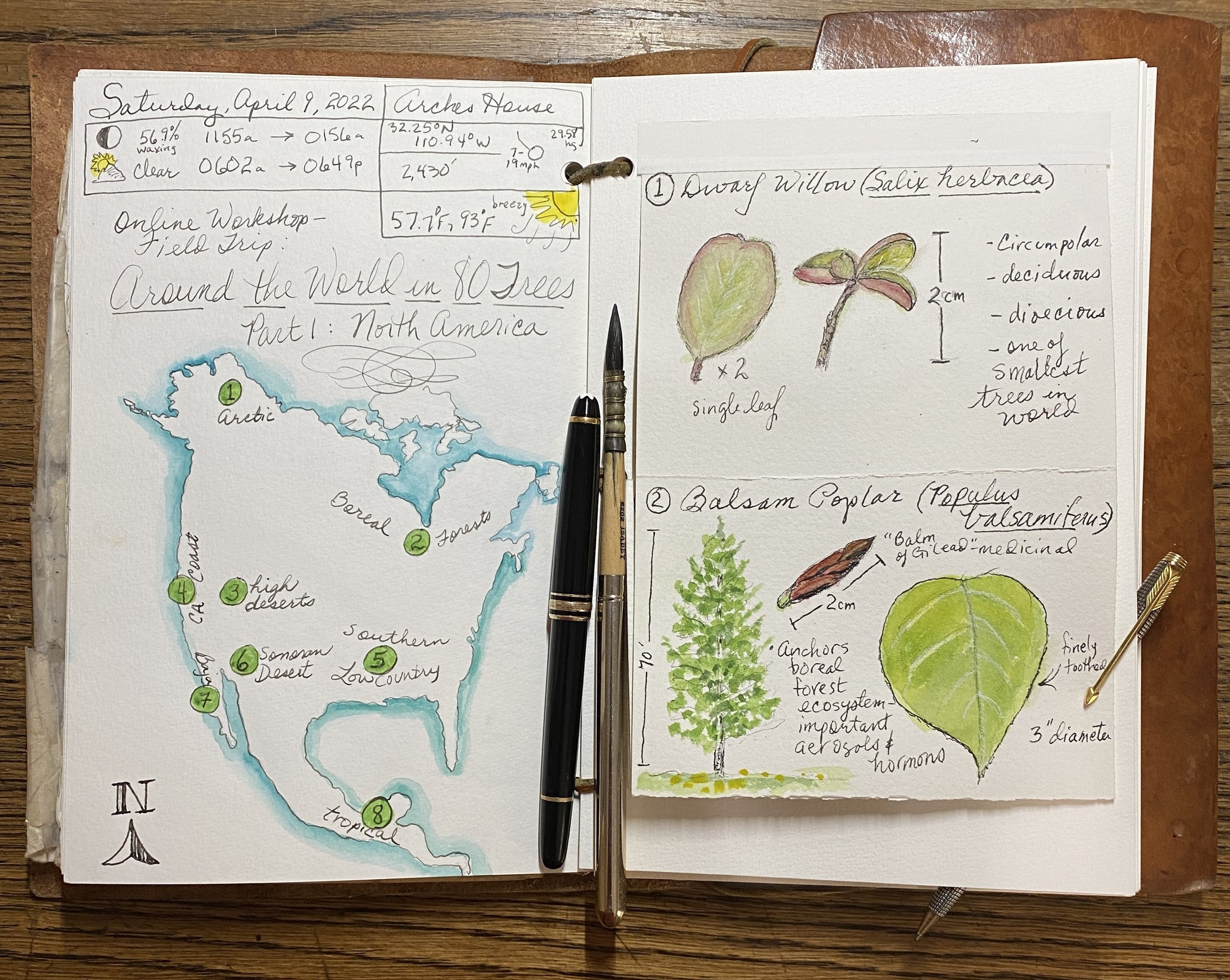
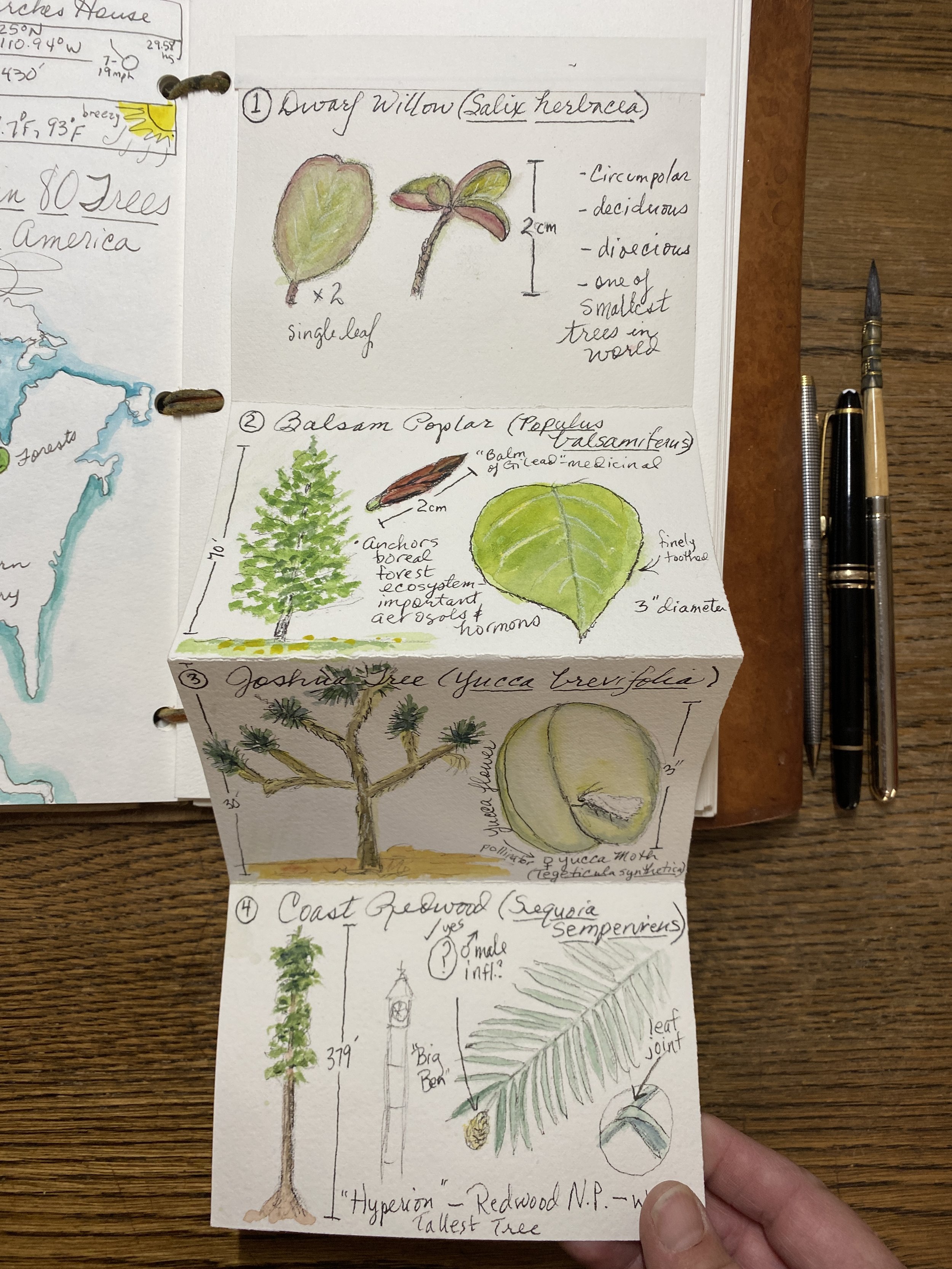
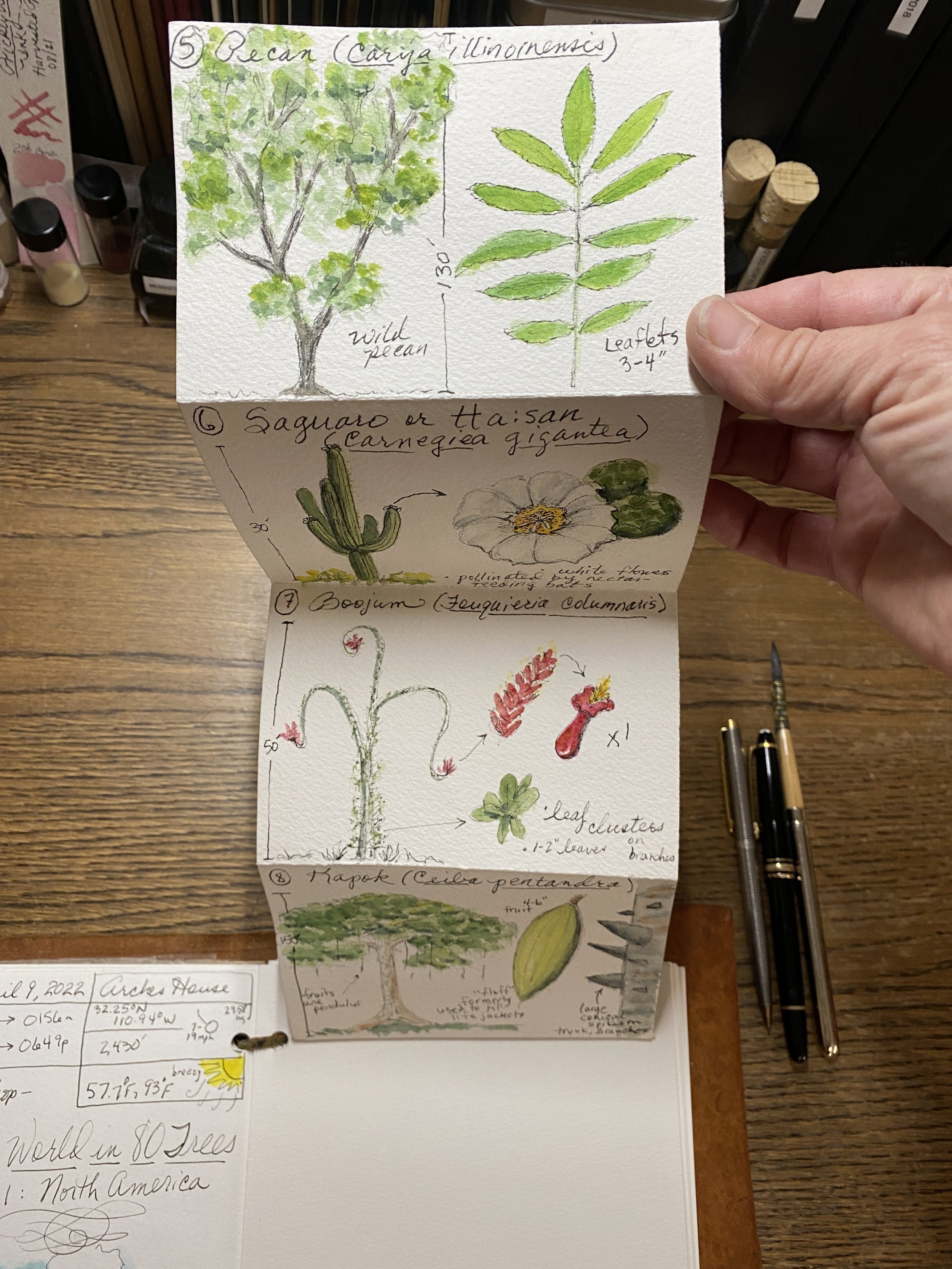
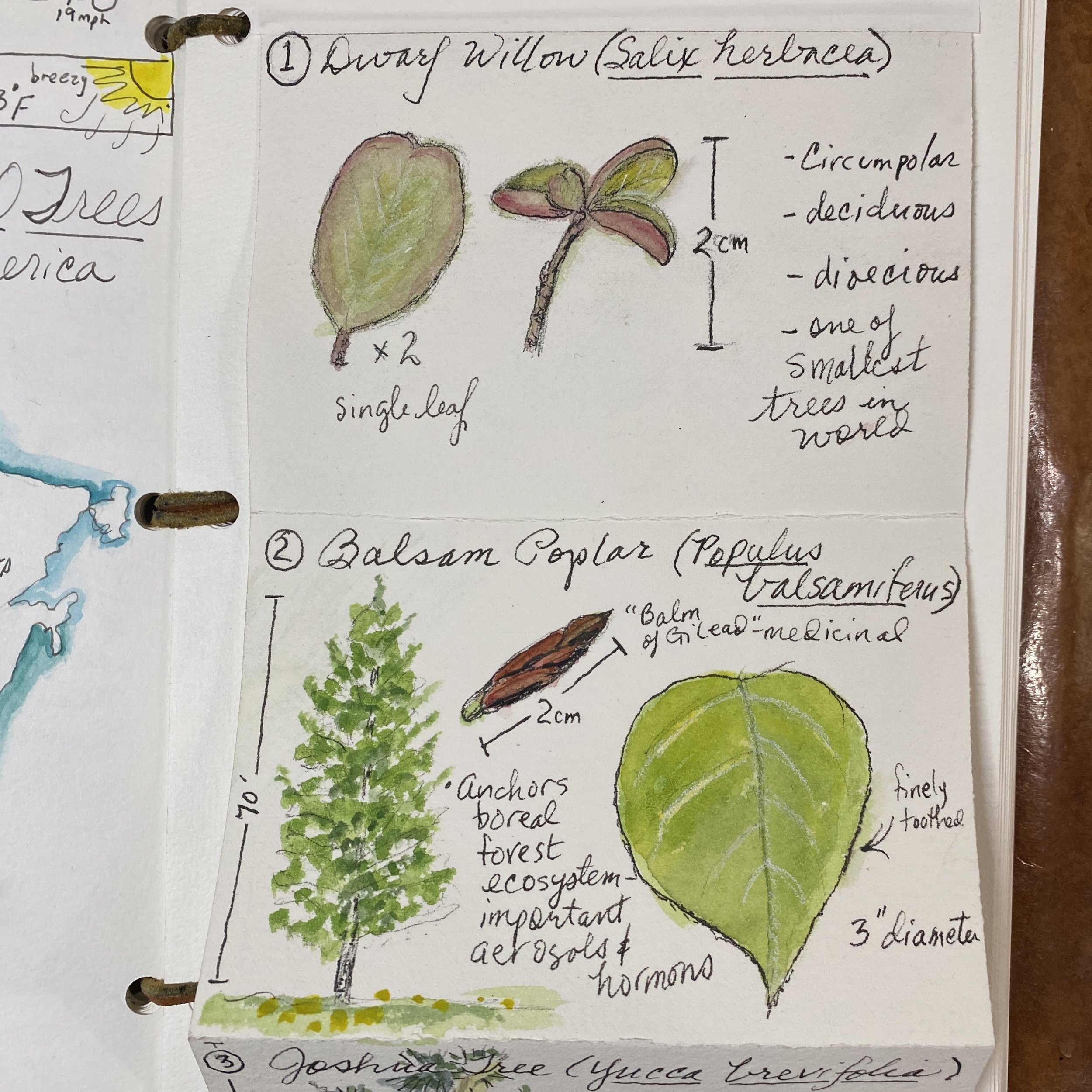
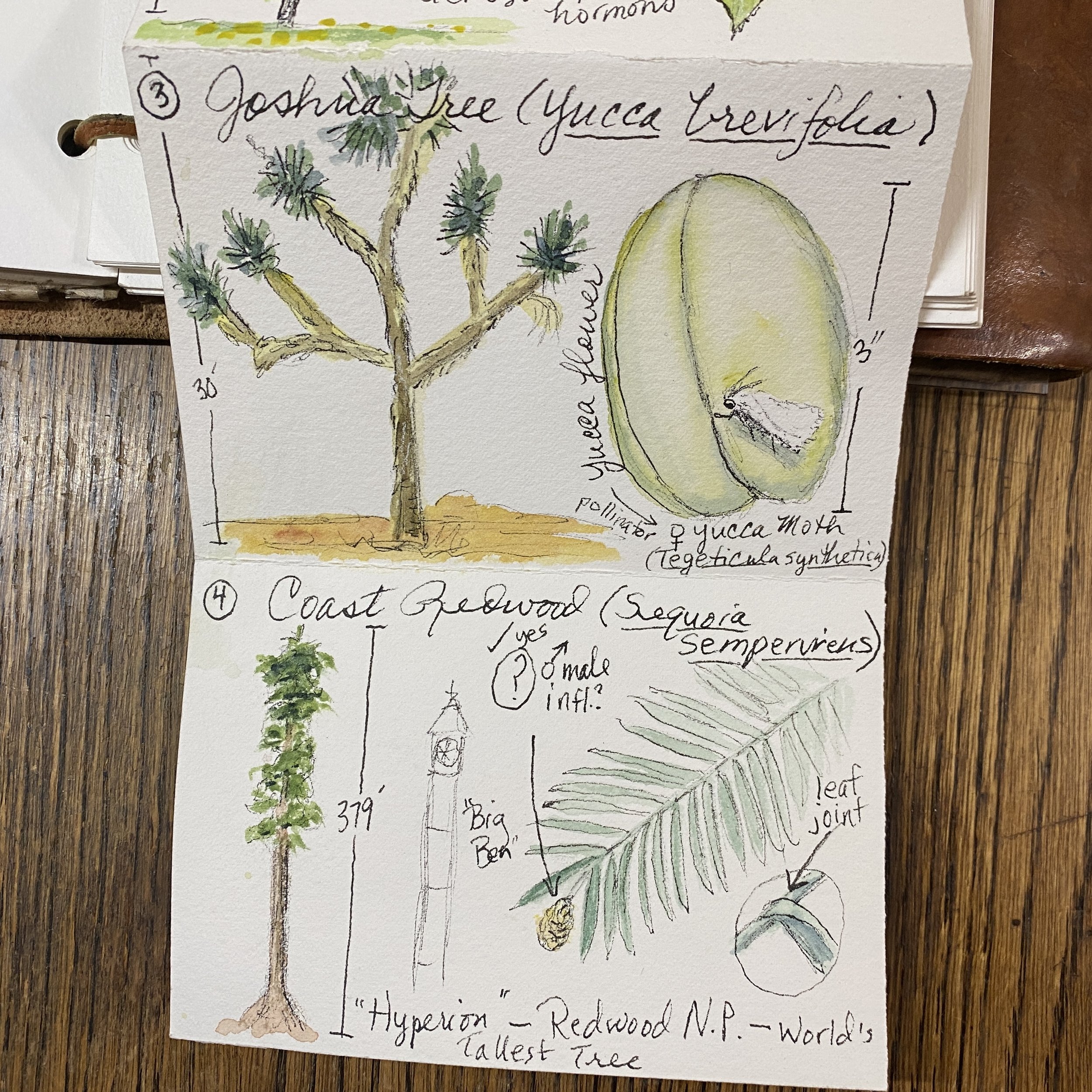
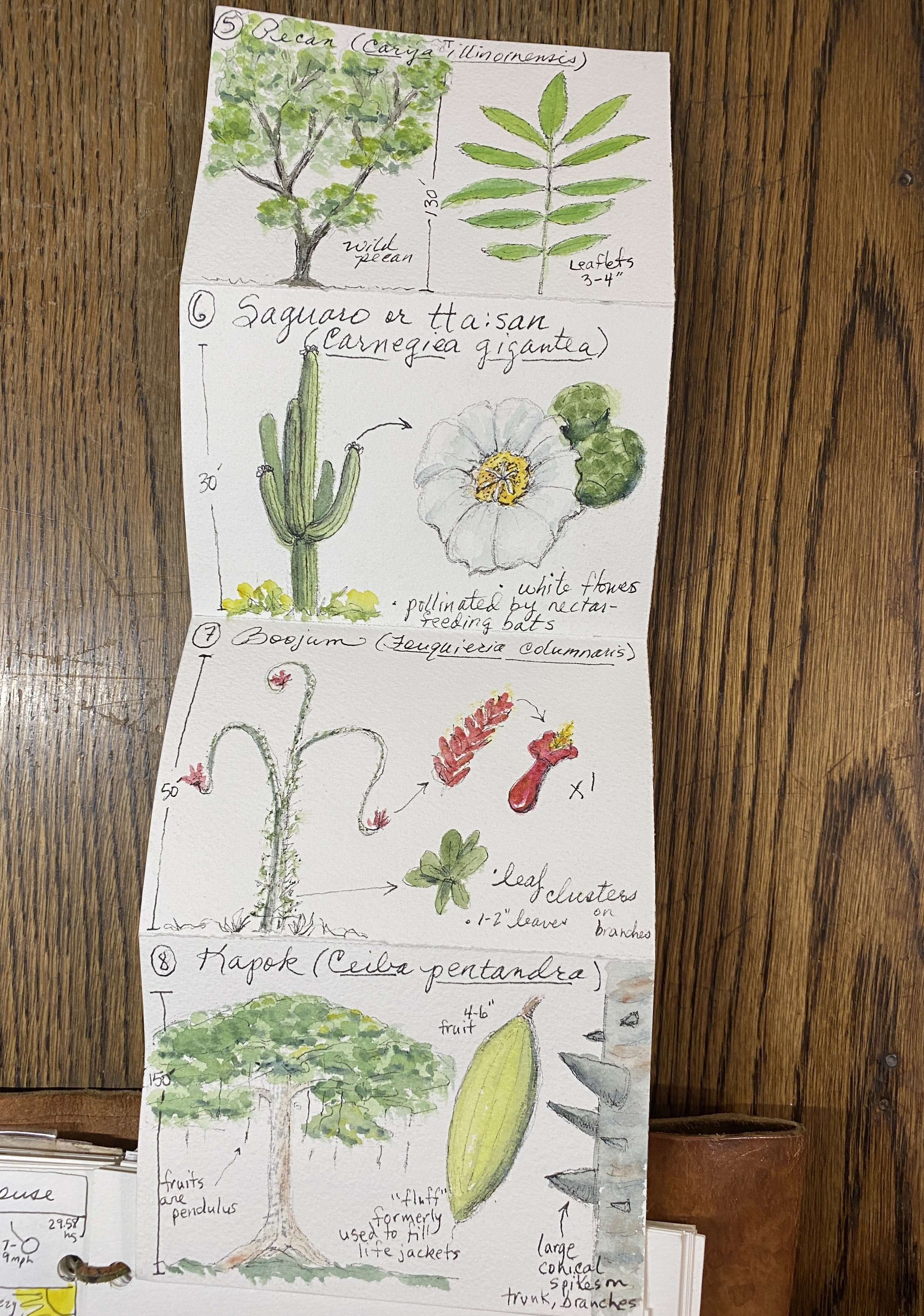
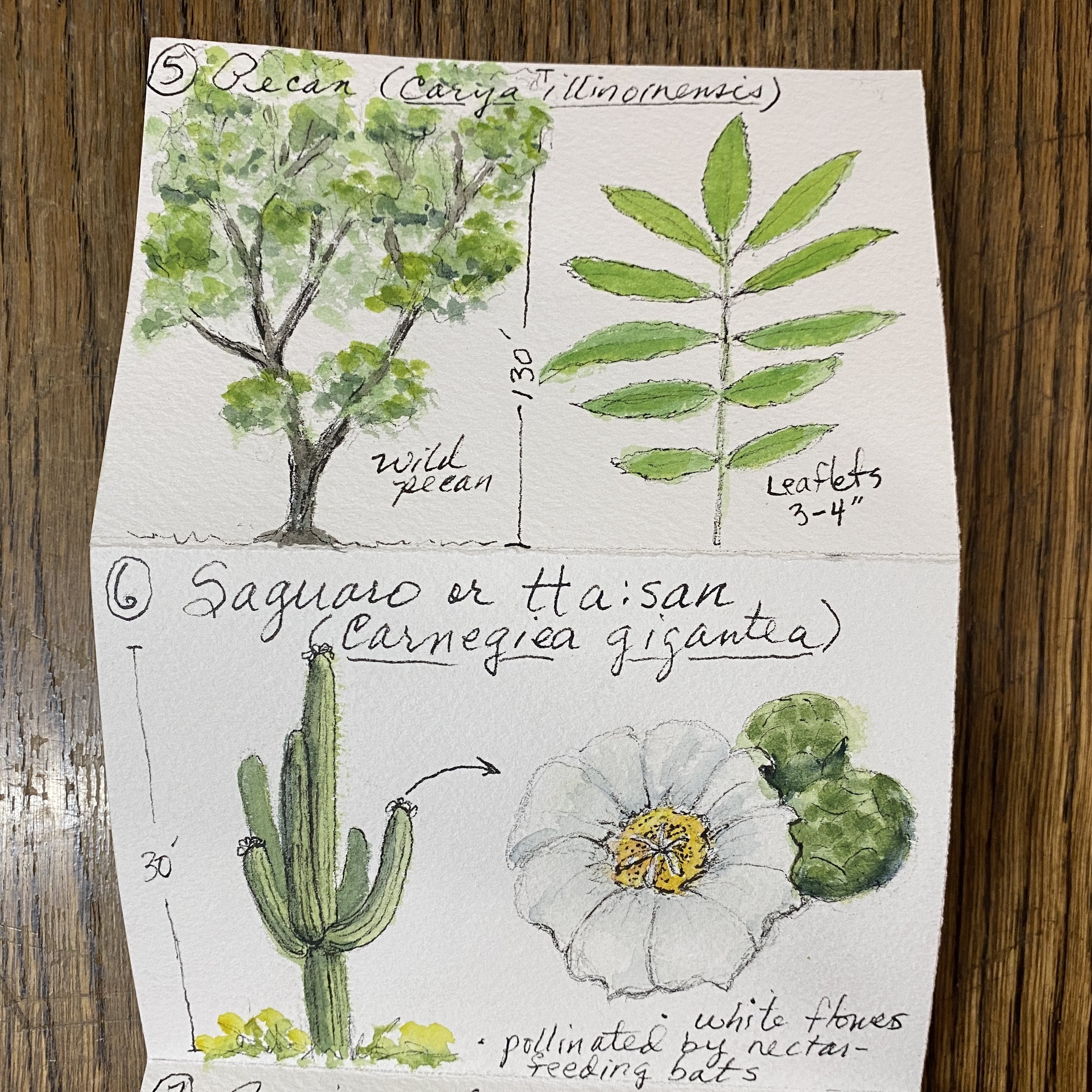
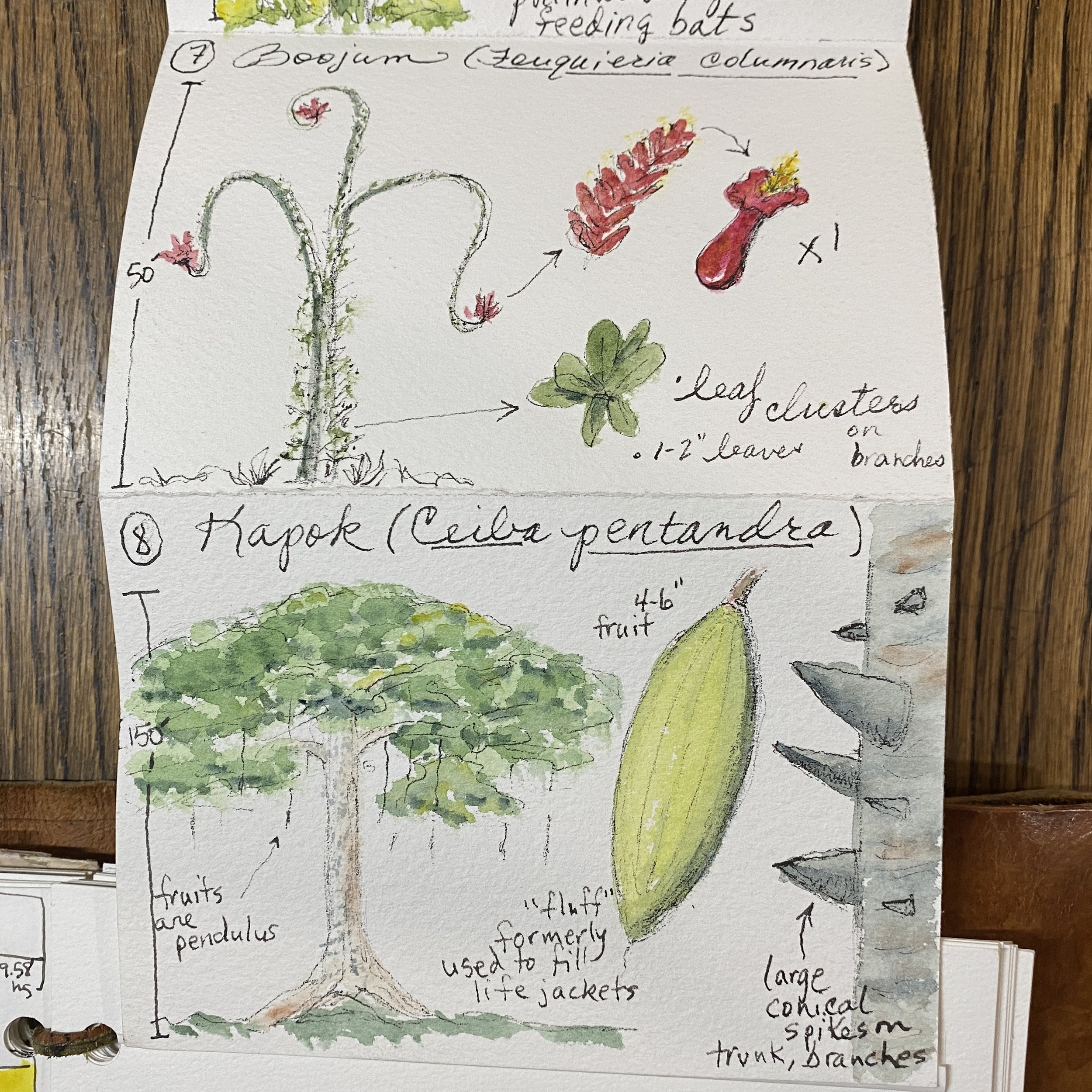
ATTENDEES’ Pages from the Workshop

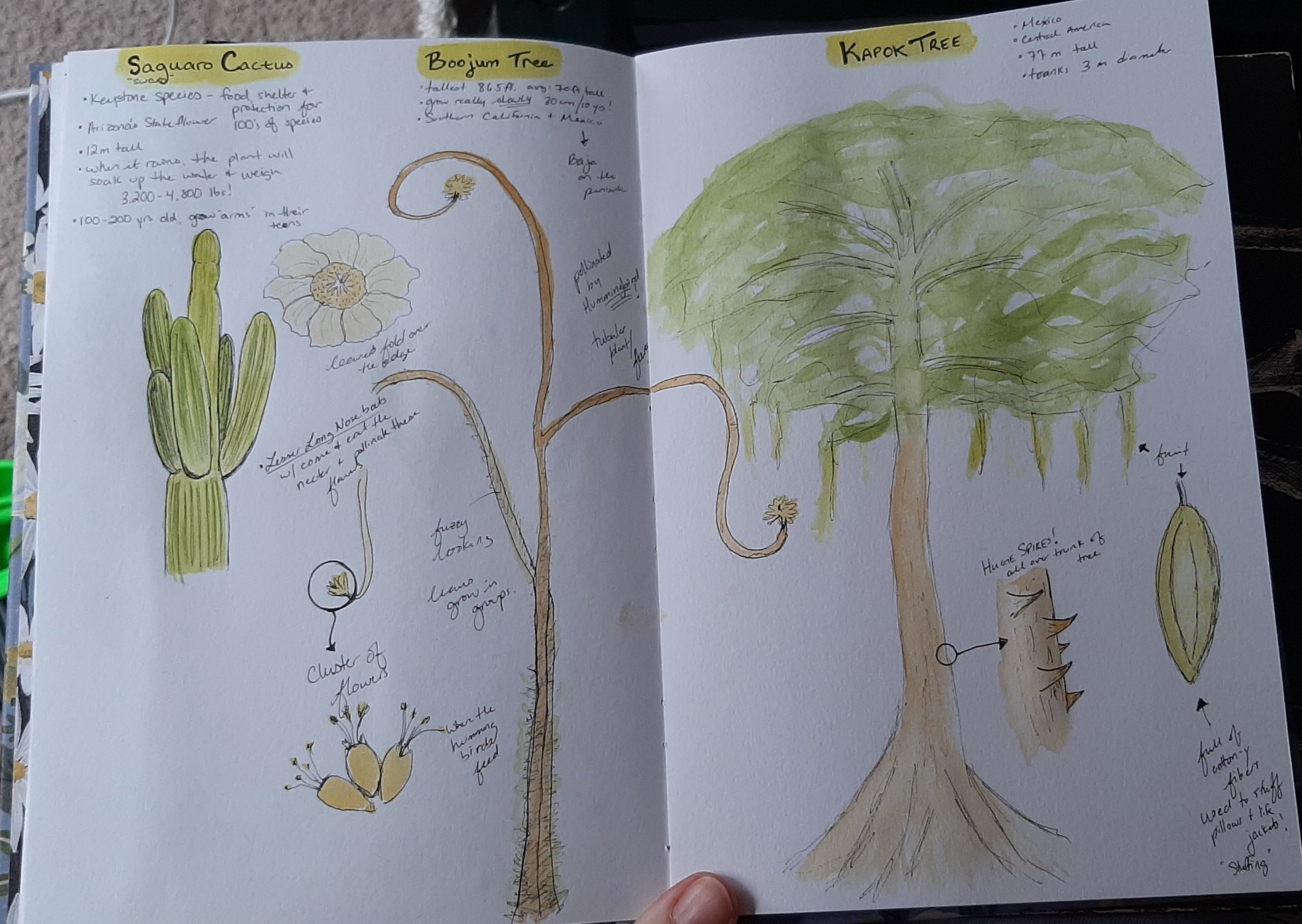
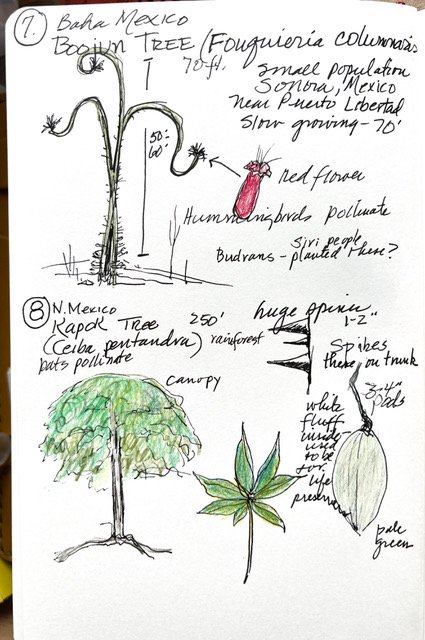
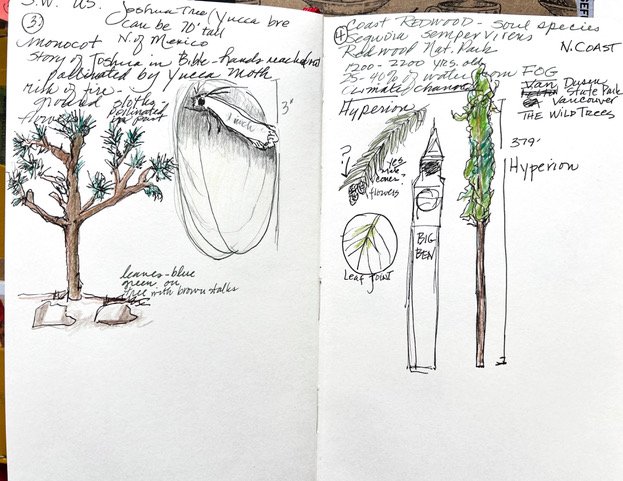
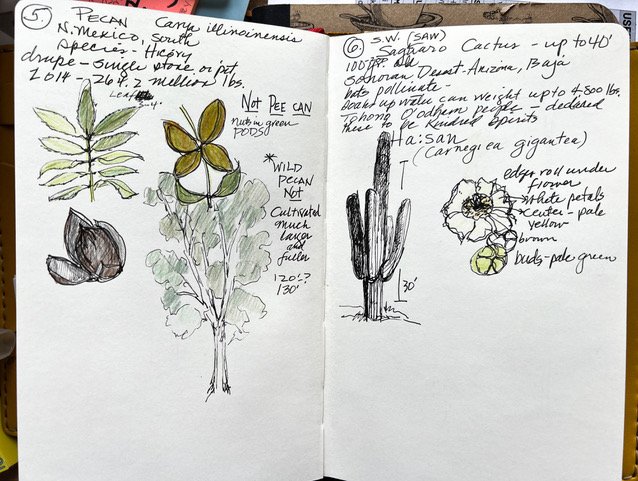
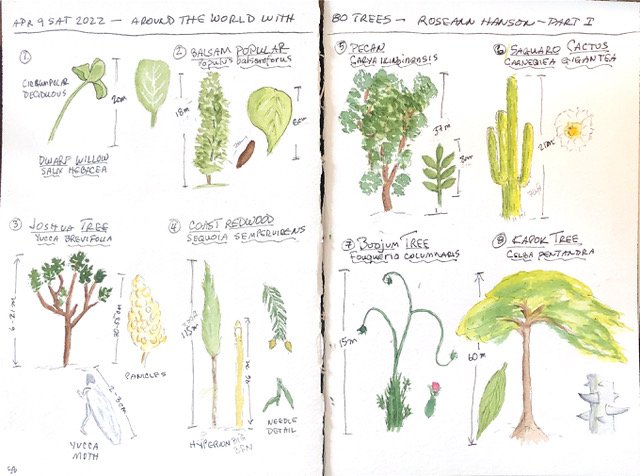
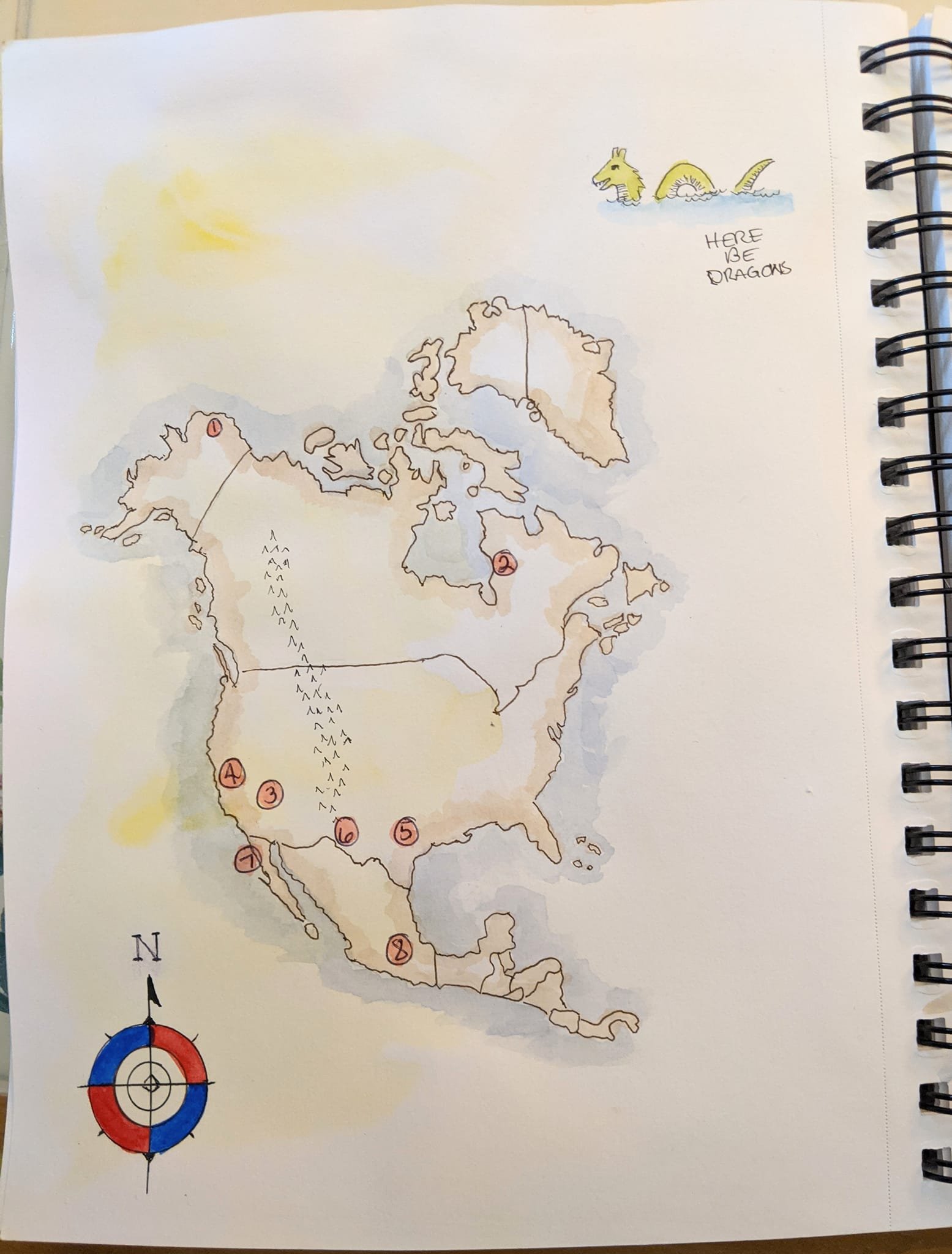
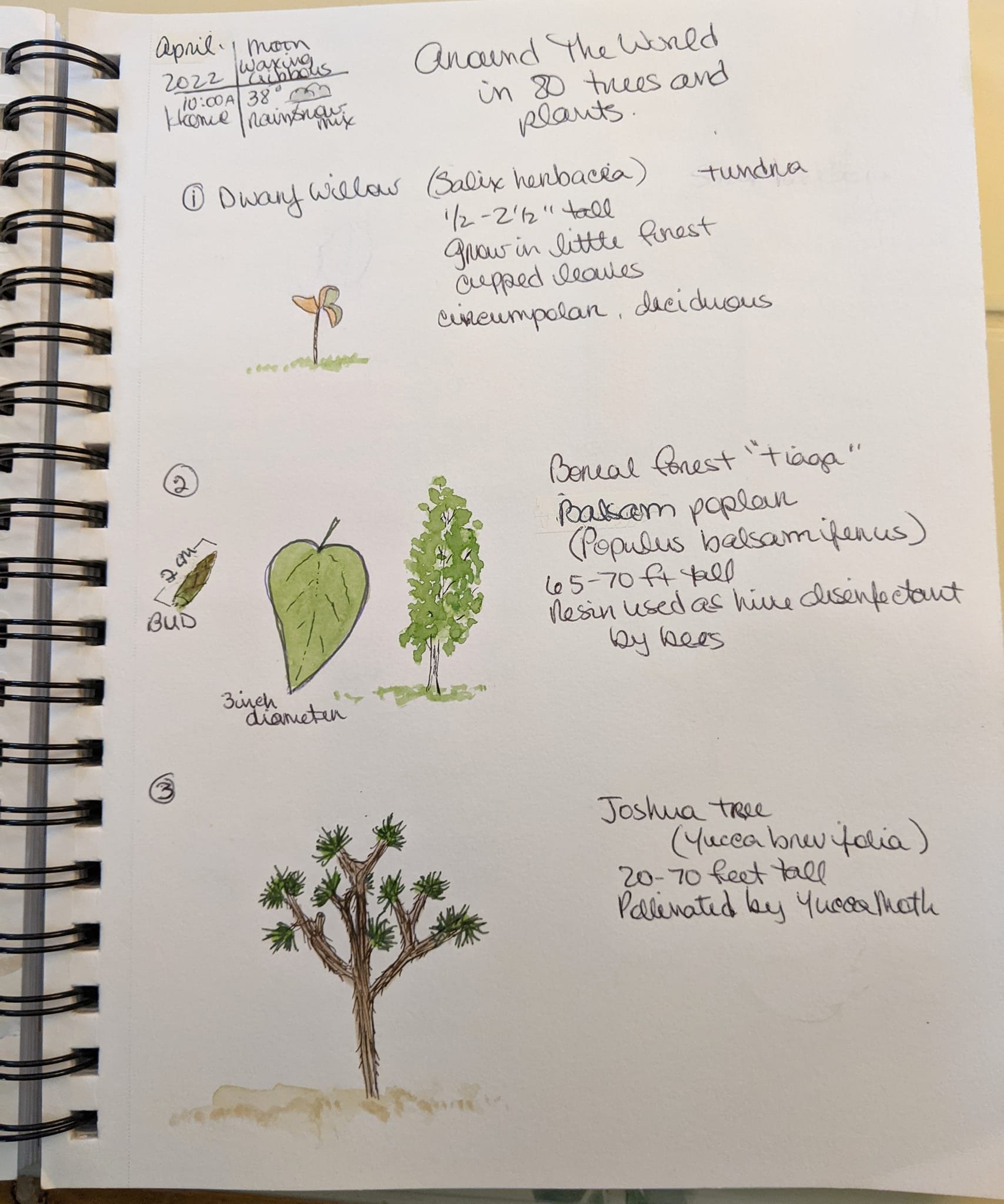
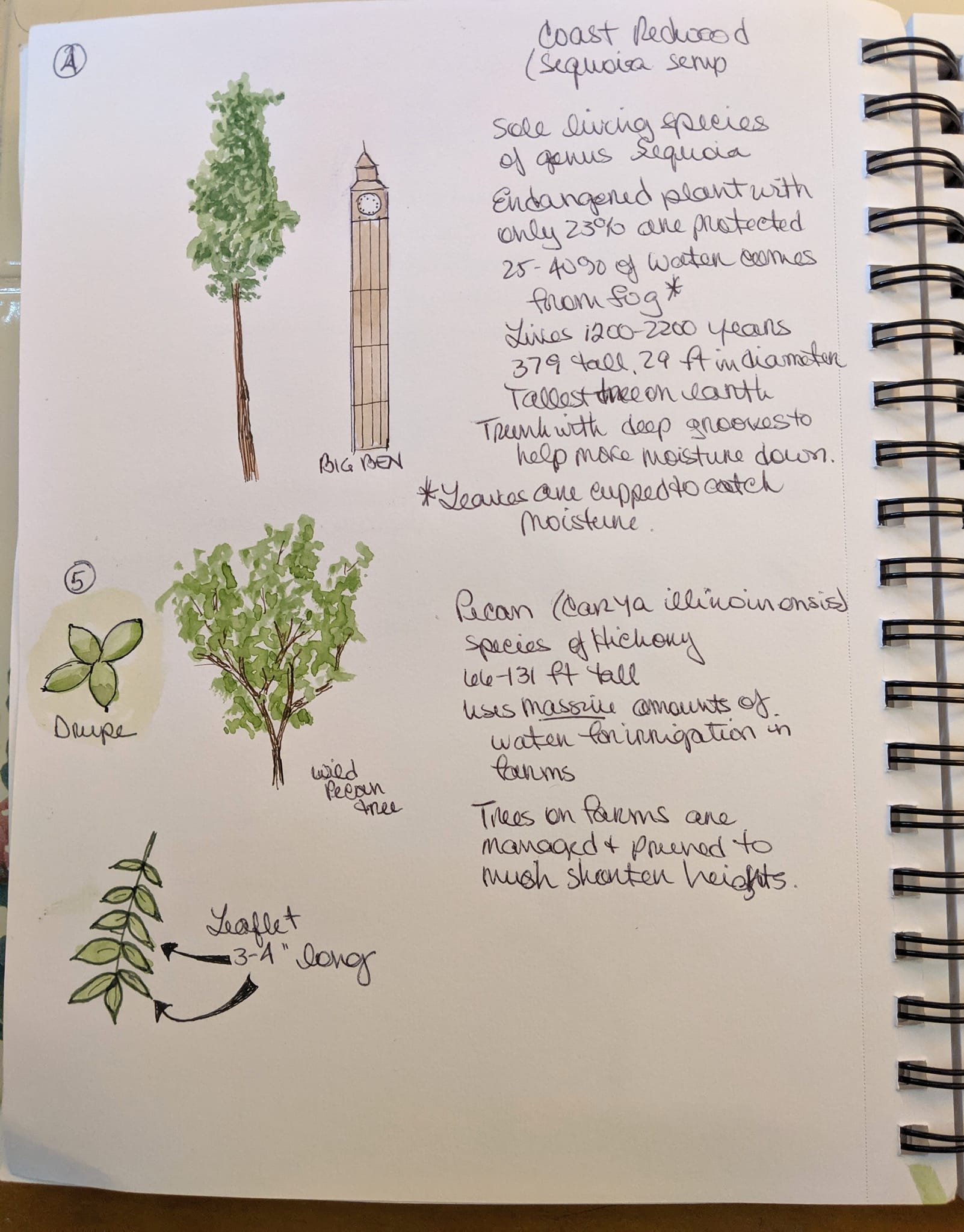
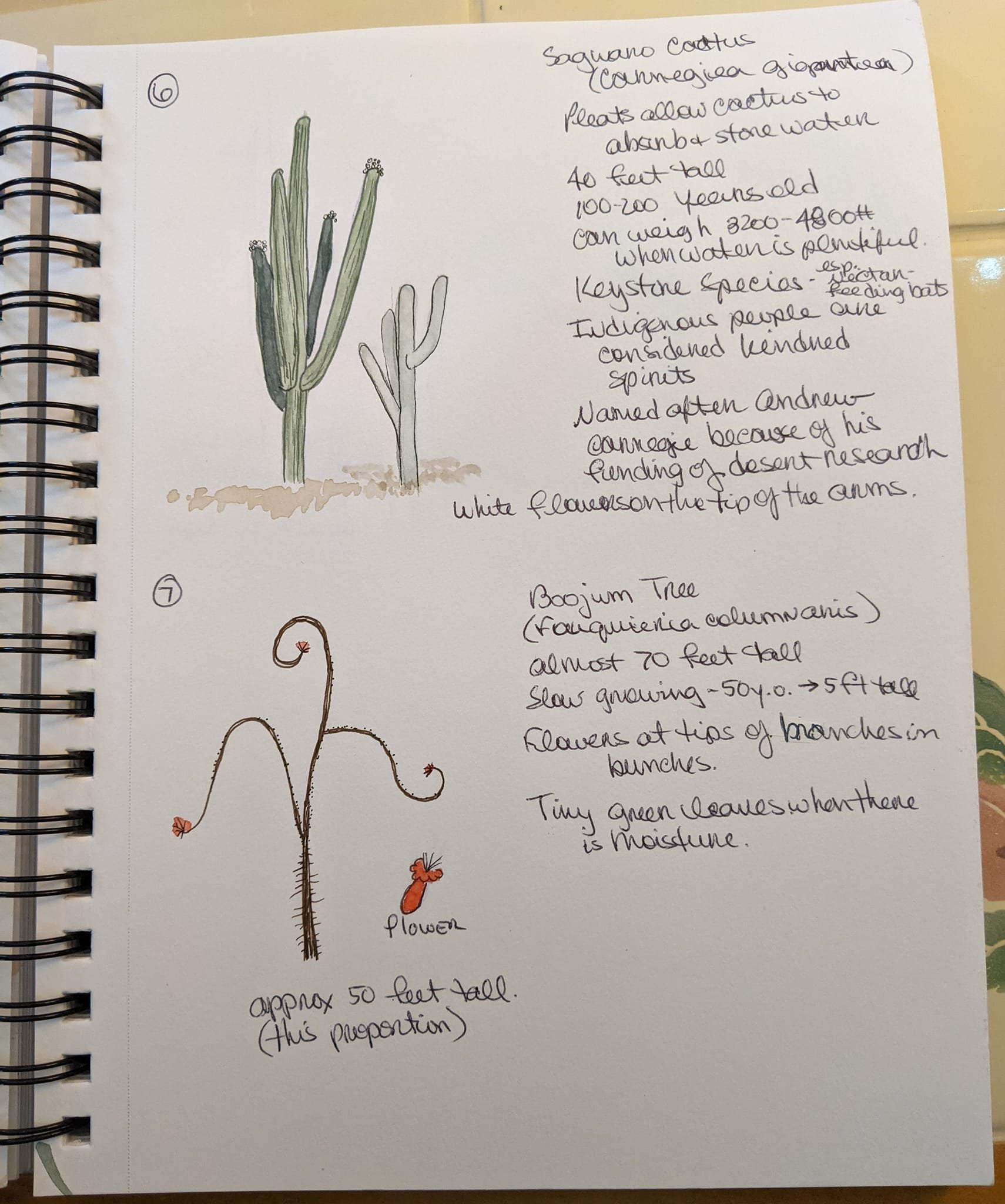
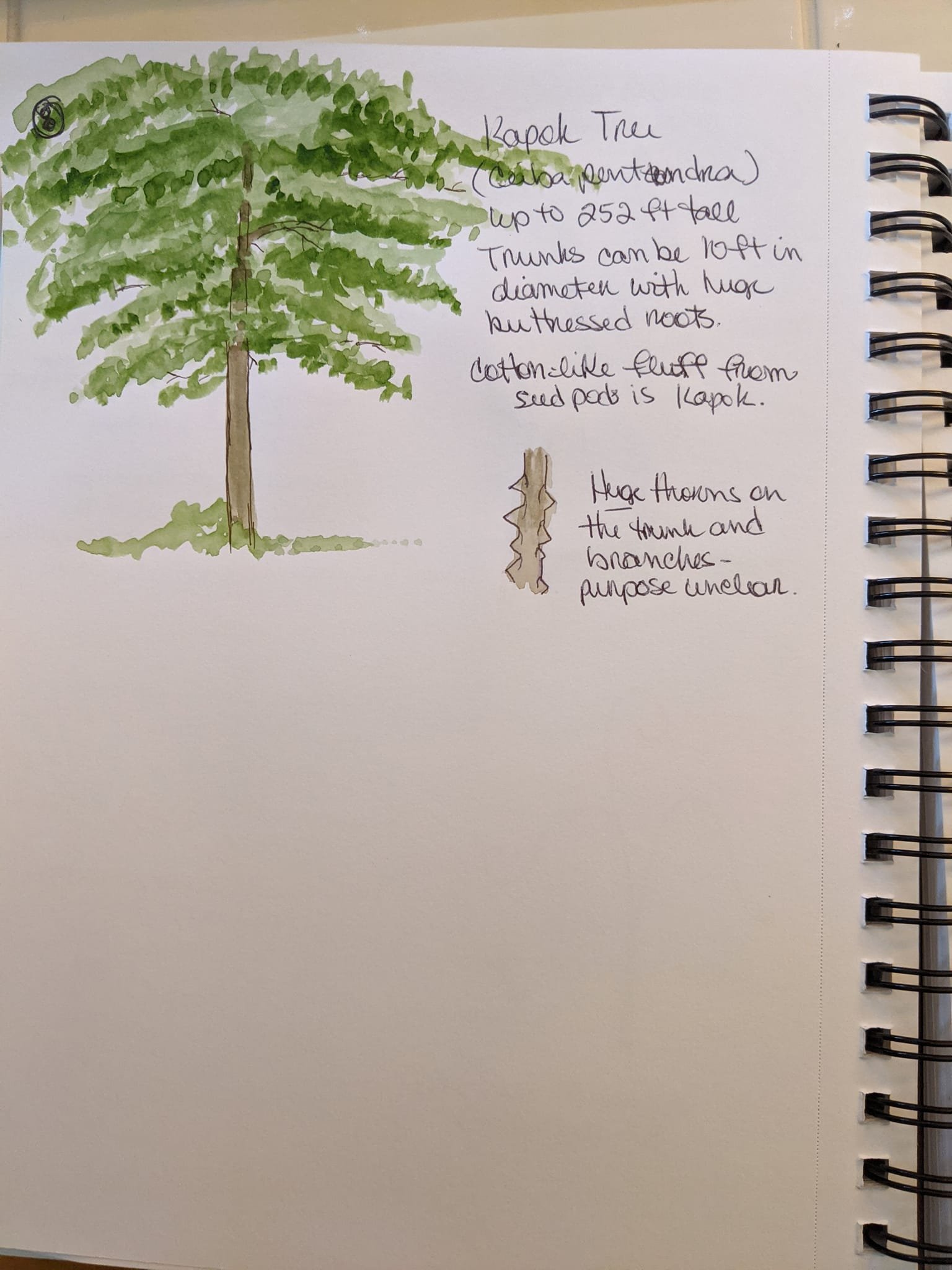
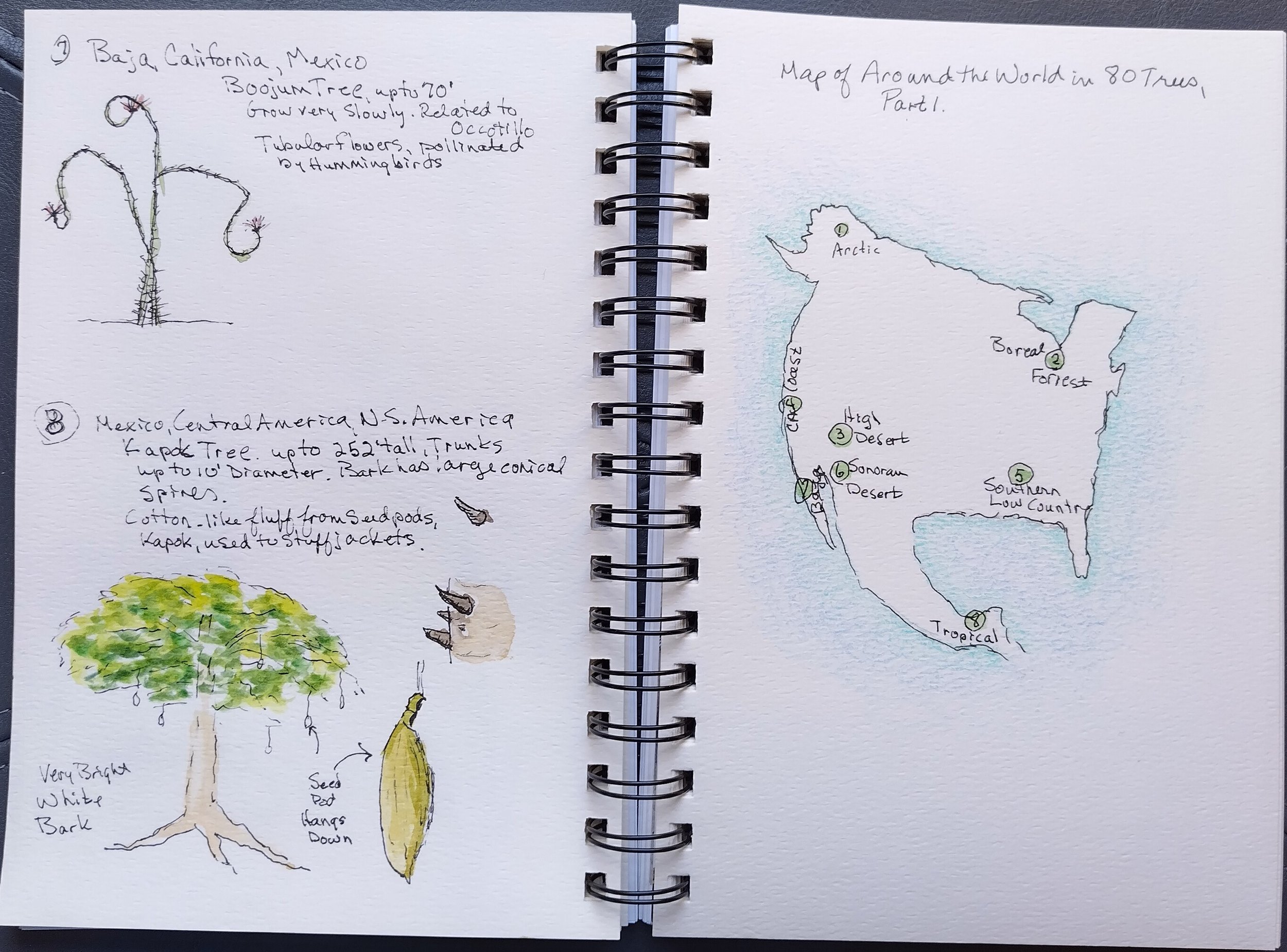
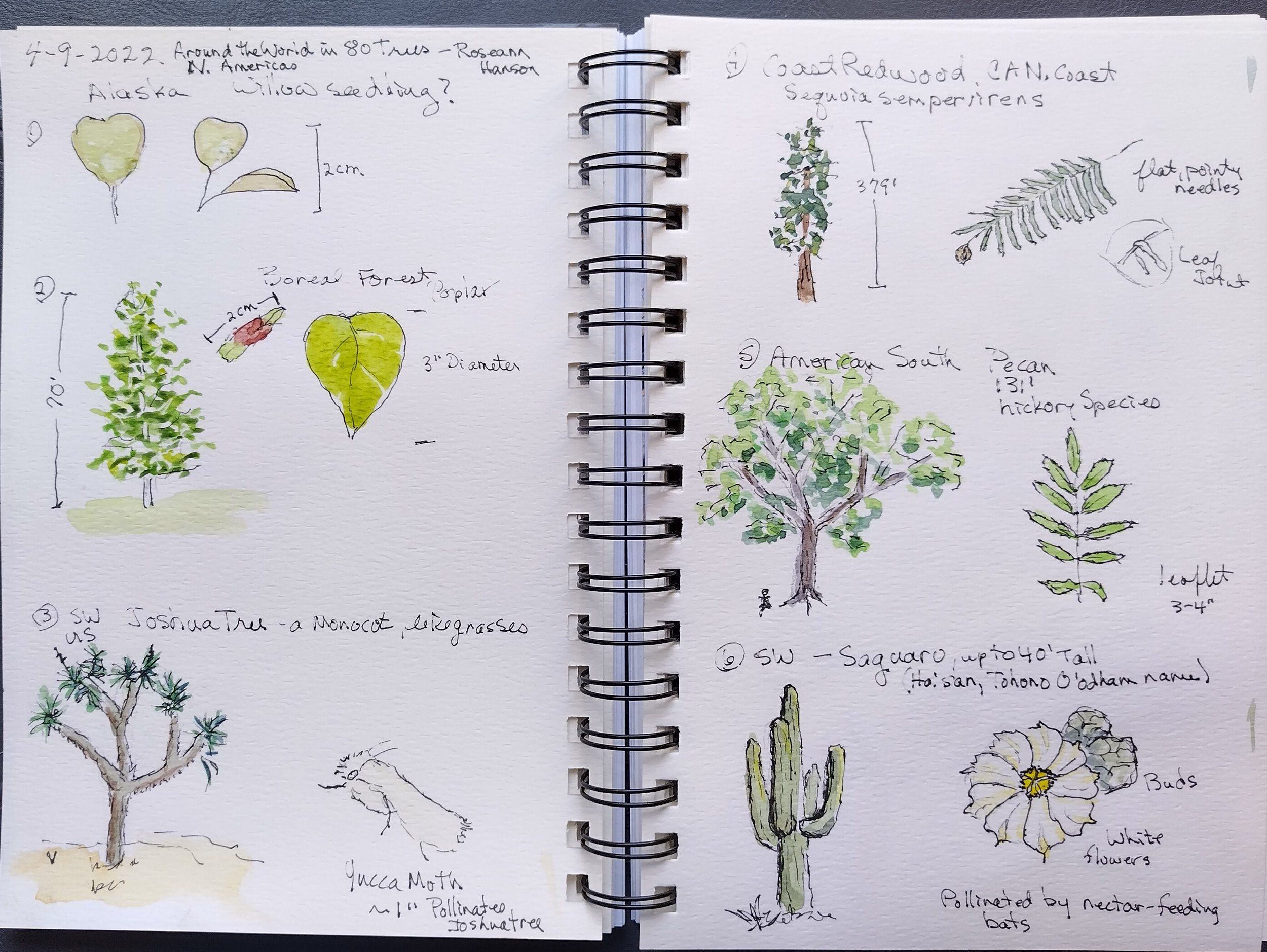
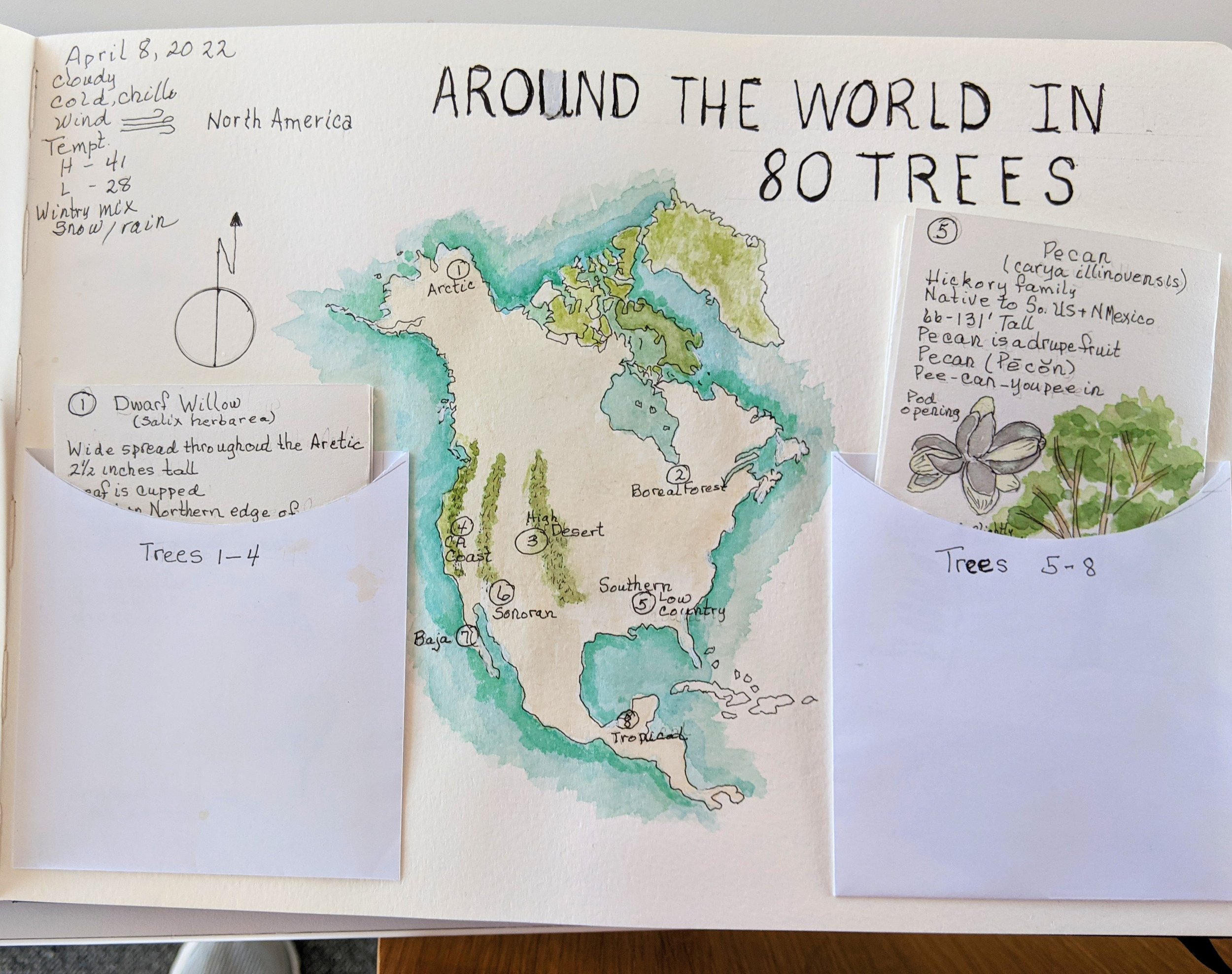
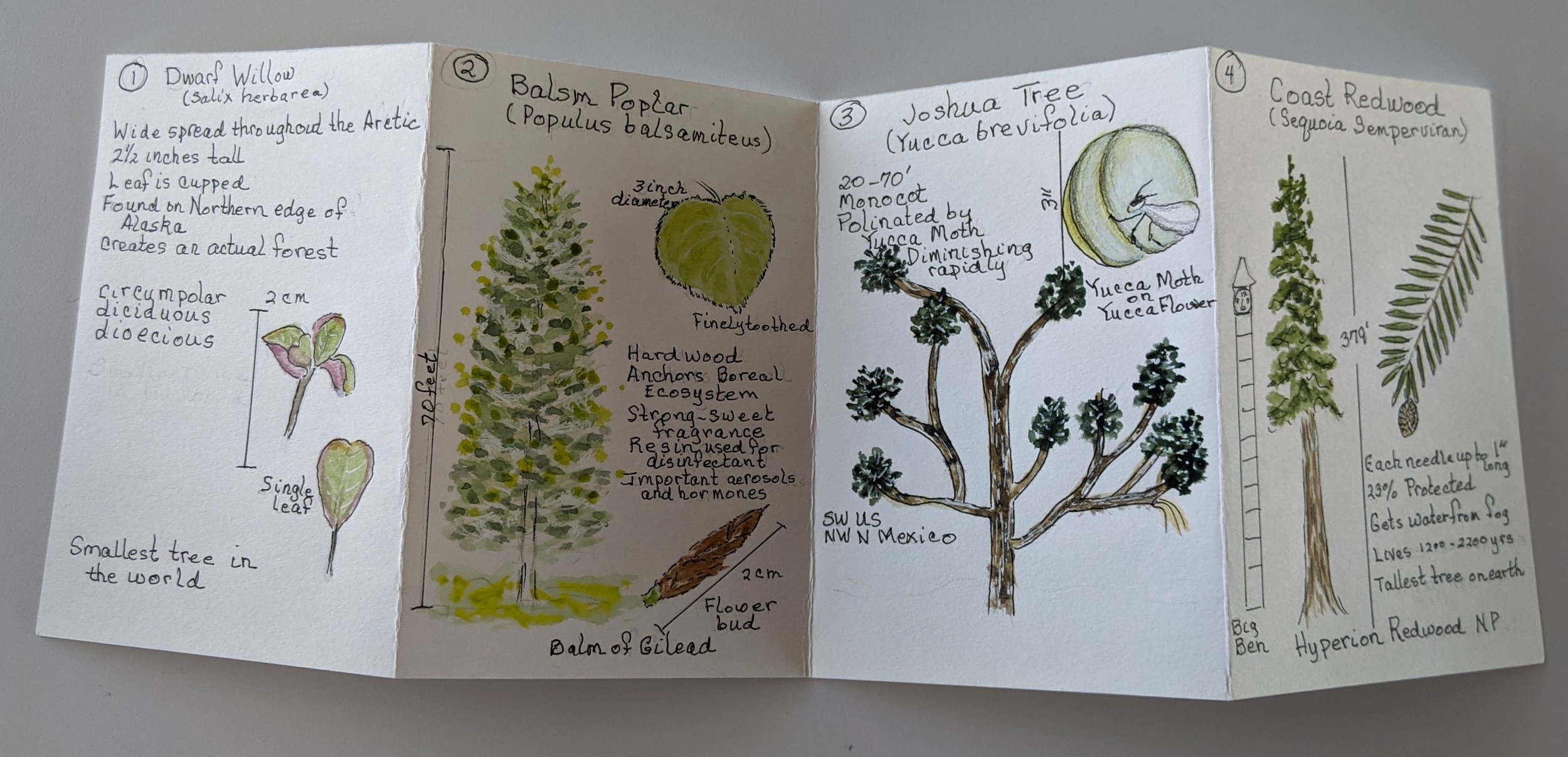
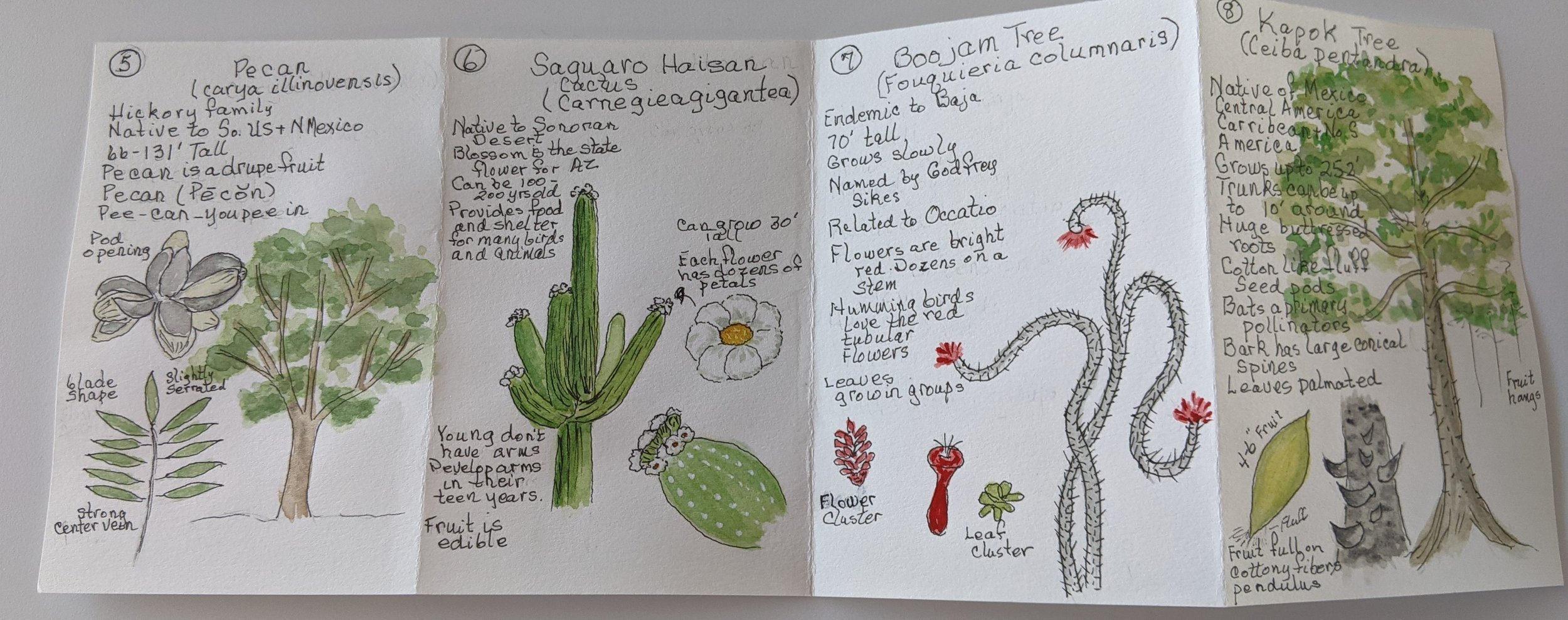
Field Arts Workshop: Landscapitos! Little drawings, big impact
Adding small landscape drawings and paintings to your journals creates a wonderful sense of place, greatly enhancing your pages. John Muir Laws calls them “landscapitos!” Don’t be intimidated! These are fast, fun, and addictive.
I’ll take you on two or three explorations using my Virtual Field Trip technology; I’ll walk you through how I choose a scene to sketch, how I “edit” down the view so I’m not overwhelmed, and how I quickly map out the drawing using big shapes. Then we’ll add some beautiful watercolor.
Have your journal and pencil or pen with waterproof ink handy, along with your favorite watercolors. Have you seen my new Earth Palette? These are especially fun paints for landscapitos.
Length: 1 hour, 30 minutes
Resources from the Workshop
CHAT transcript — click > HERE <
Information and links from the workshop:
My favorite paints: Minimalist = a true primary triad (cyan, magenta, yellow) plus two wild-card colors for making browns and black. I like Daniel Smith Manganese Blue, Quinacridone Rose, and Aureolin Yellow, plus Burnt Sienna and Indanthrone Blue. Or, love Greenleaf & Blueberry’s Cyan, Magenta and Yellow, and their Red Ochre and Mayan Blue 2. https://www.exploringoverland.com/academy#color
https://www.exploringoverland.com/shop/minimalist-paint-tins-2-sizes-with-or-without-paint-samples
My notebook: Handmade leather, tutorial here: https://www.exploringoverland.com/field-arts-tutorials-list/2020/8/18/adding-pages-to-my-handmade-leather-journal
Grids: https://www.dickblick.com/products/compose-it-grids/
Perspex Palette: https://www.exploringoverland.com/shop/clear-perspex-palette-with-magnet-strip
Aspect Ratios information:
ASPECT RATIO = SHORTER EDGE ÷ LONGER EDGE
3 ÷ 3.75 = 0.8
4 ÷ 5 = 0.8
Click on image at right to enlarge:
White painter’s tape or washi tape:
https://www.dickblick.com/products/blick-artist-tape/
https://www.amazon.com/MT-Solids-Masking-Tape-MT01P208/dp/B00DHZP2FS/
mt Washi tape can be found with a cute little cutter.
Field Trip: Southern Colorado
https://360exploring.s3-us-west-1.amazonaws.com/Mountains-Mesas-2020/output/index.html
Field Trip: Kenai Peninsula, Grewlingk Glacier (we didn’t have time for this one, but if you practice landscapitos here, please credit Kim McNett as photographer)
https://360exploring.s3.us-west-1.amazonaws.com/Alaska/output/index.html
Landscapitos from the Workshop
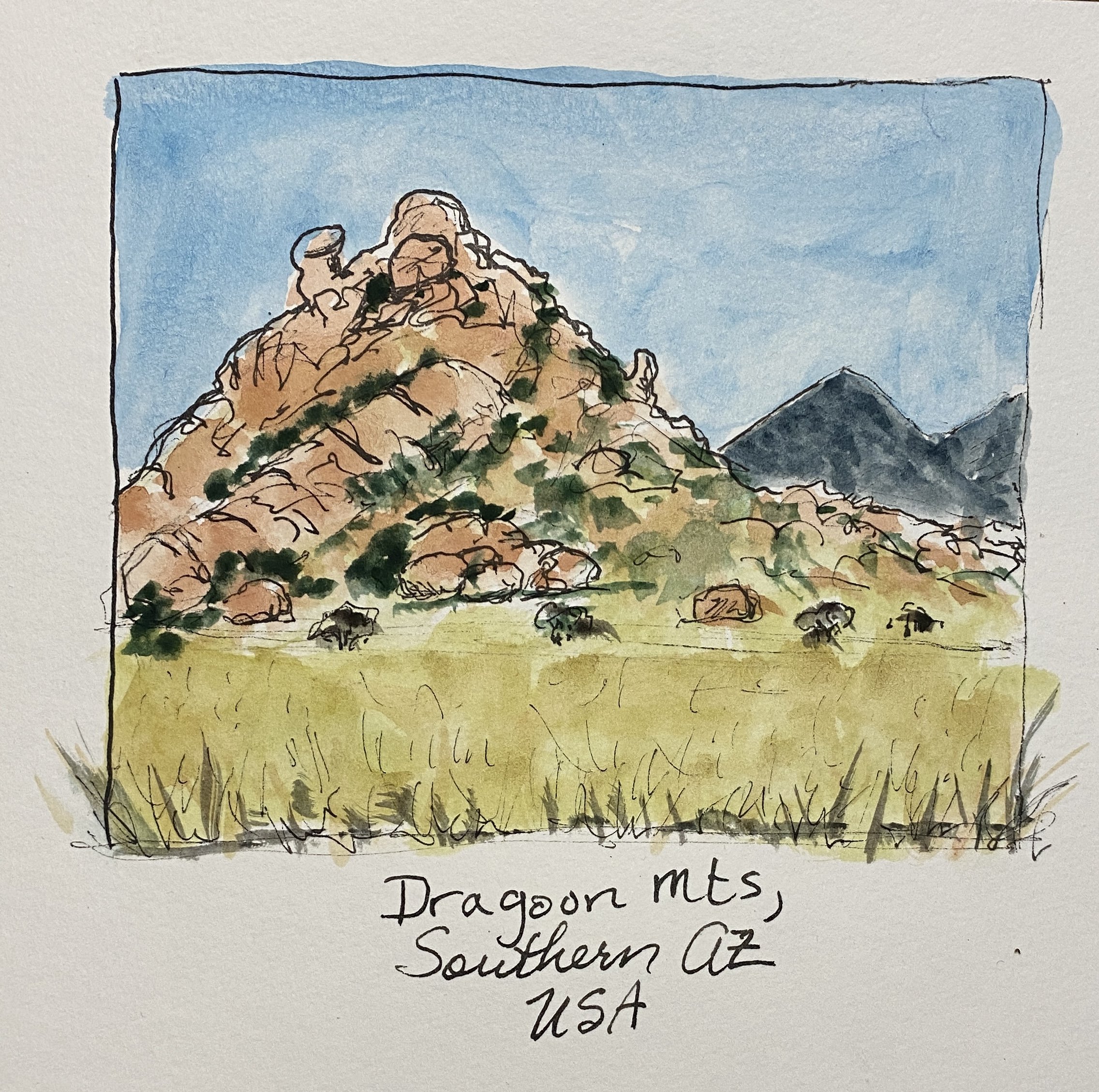
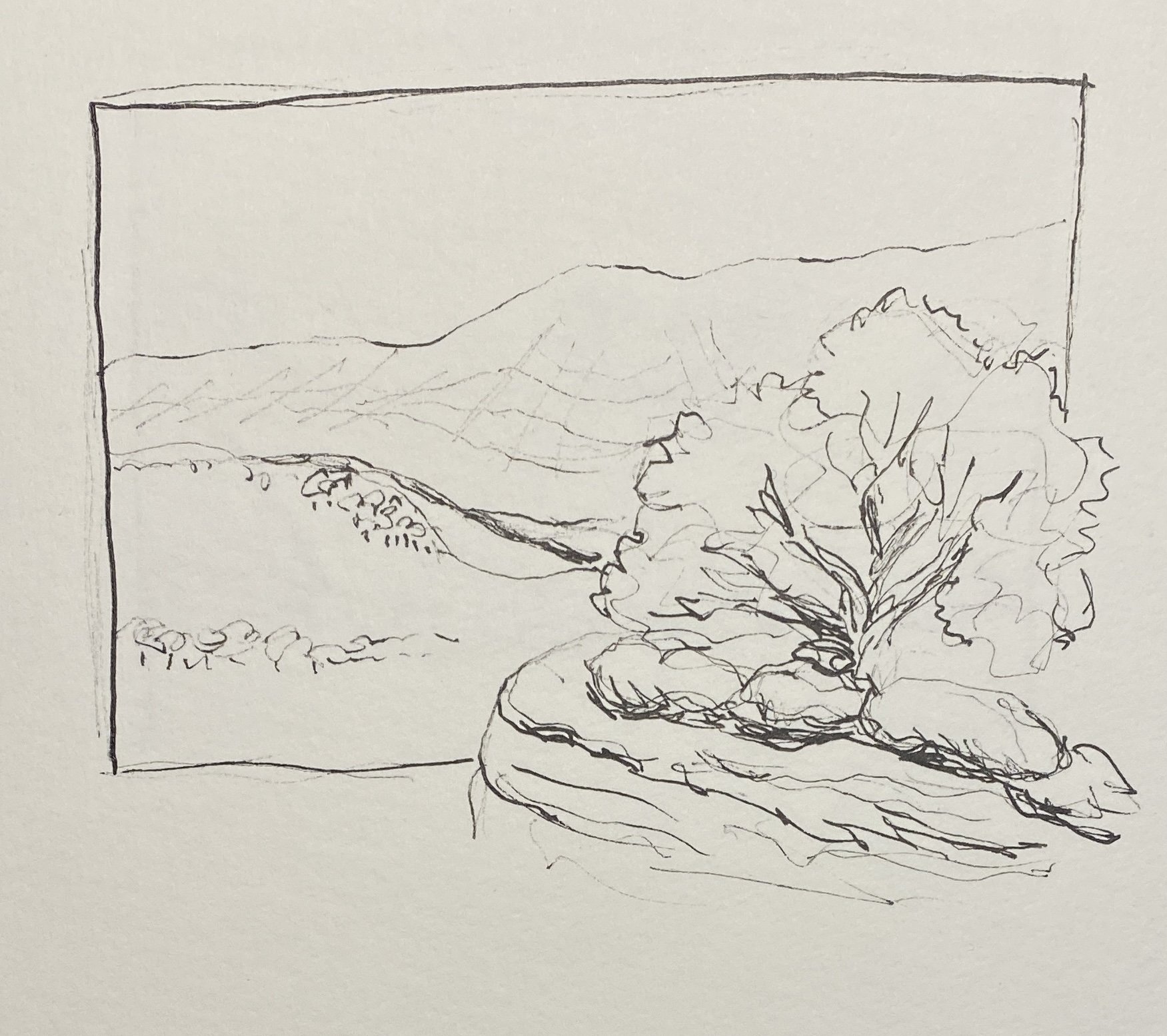
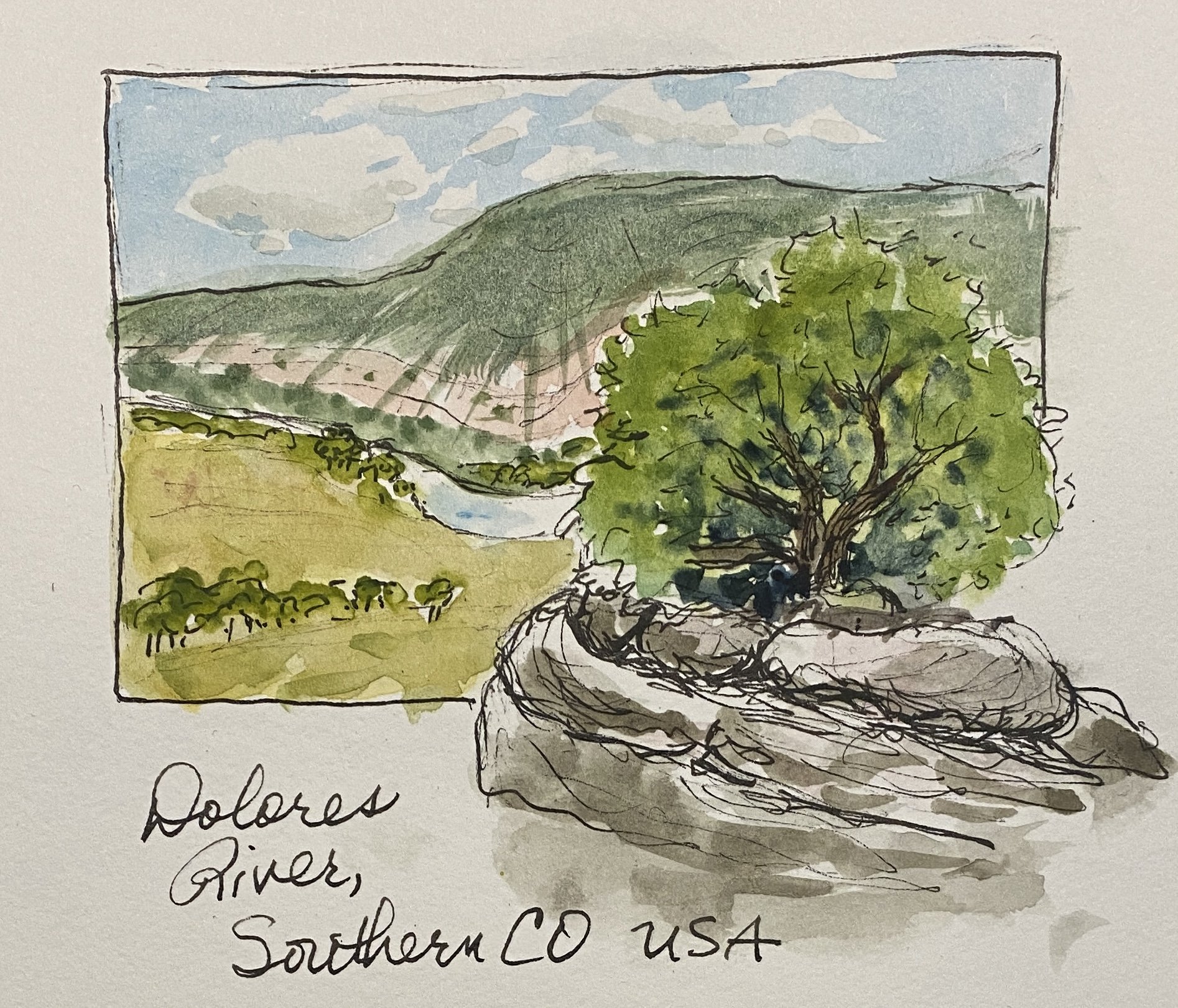
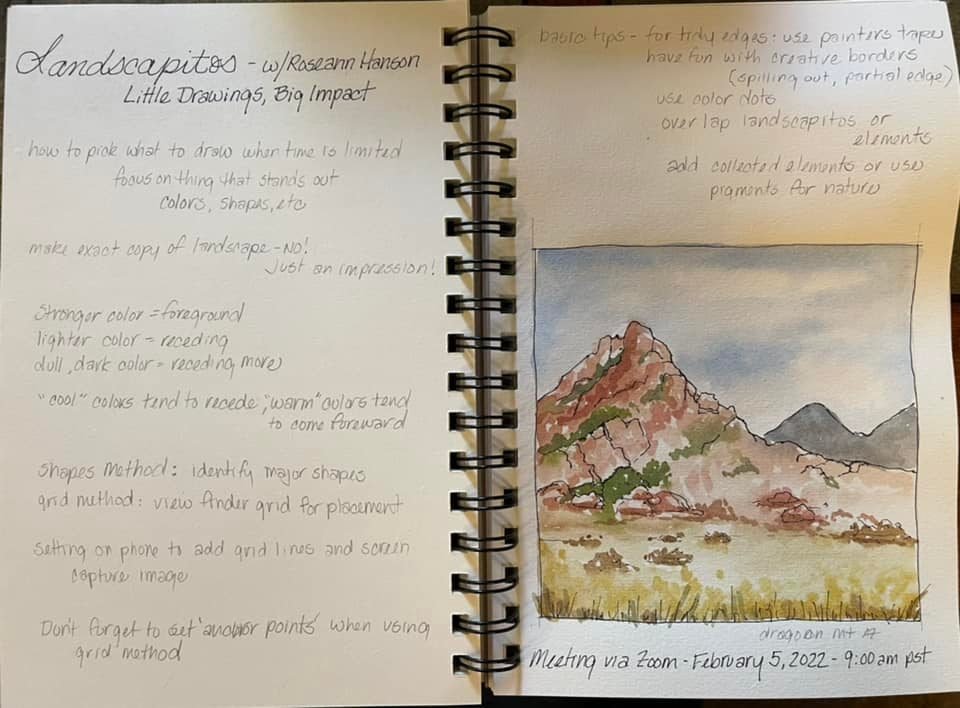
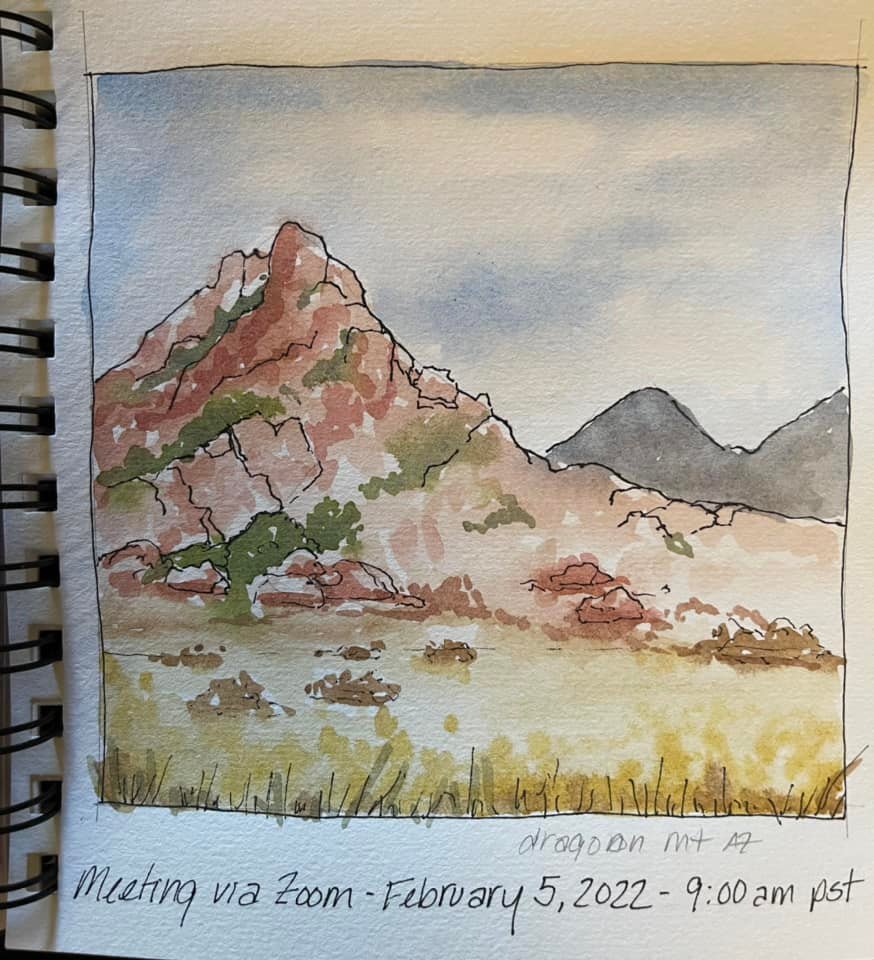
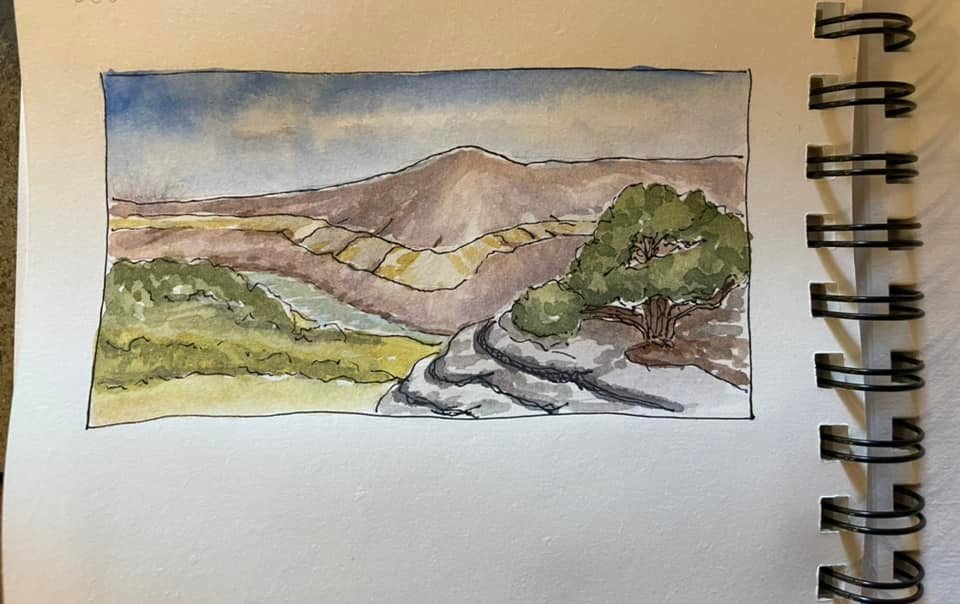

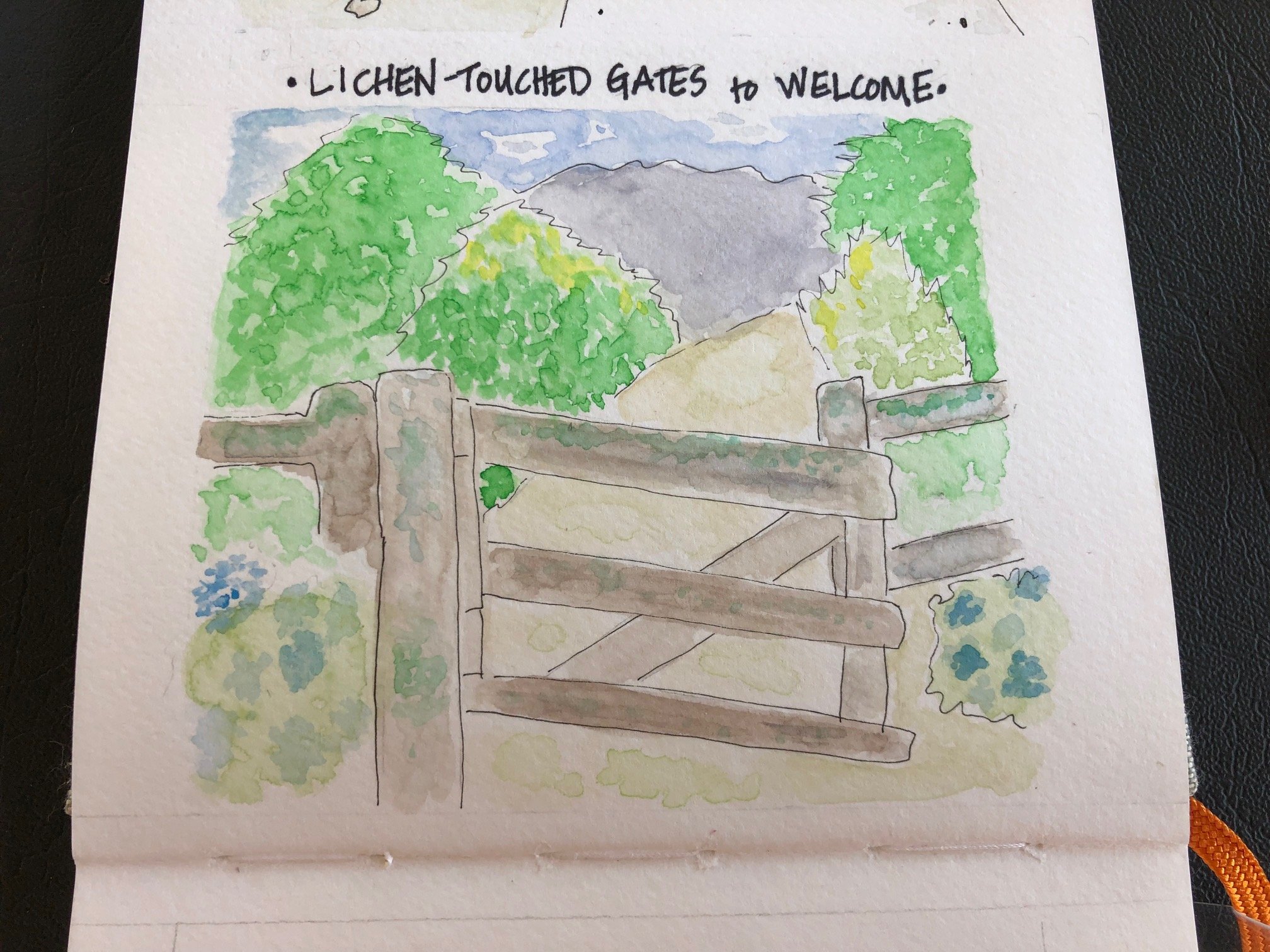
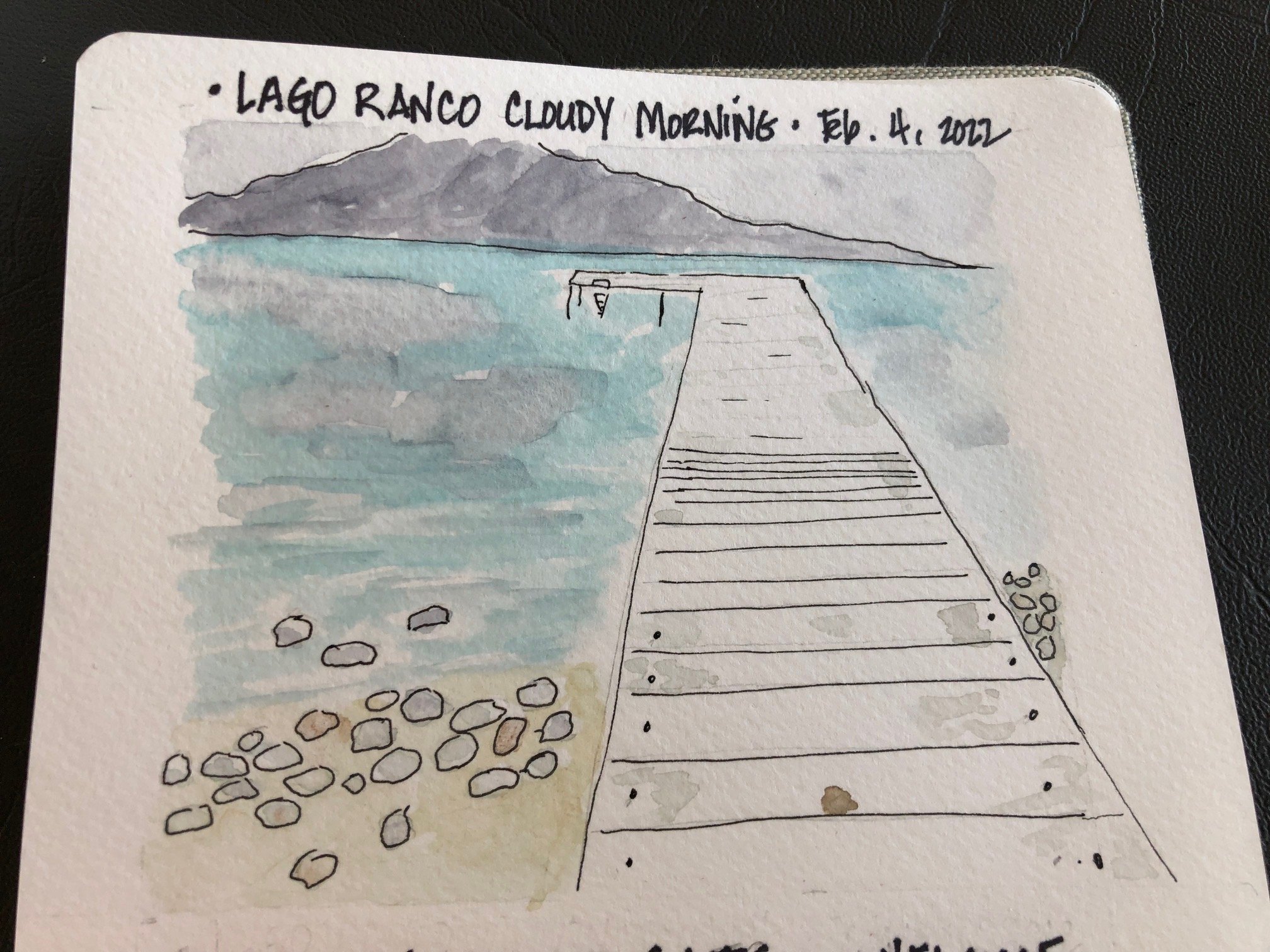
Practice isolating big shapes — Dragoon Mountains, Southern Arizona, USA
From the Virtual Field Trip “Mountains and Mesas” here: https://360exploring.s3-us-west-1.amazonaws.com/Mountains-Mesas-2020/output/index.html
This is the Dolores River, southern Colorado, USA.
Mini Plant Press: Tips on using
I’ve used mine for decades to press flowers and leaves and small clippings of stems and even berries.
The Mini Plant Press comes with white cardstock paper, which will work fine for pressing most leaves.
Depending on the moistness of the plant parts, you may want to cut some newspaper or watercolor paper to absorb moisture if the plant parts are more succulent or you want to press berries or flowers that have a lot of flesh.
Tip: in erasable pencil, write on the white cards all the location metadata for your specimen: latitude / longitude, elevation, name of location and page number in your field journal where you will write up details of the collection: any other information about the habitat, nearby plants, anything you think is relevant to your specimen. Even include weather for the day if it’s relevant to, say, whether the flower is open or the leaves are closed up like in the photo above, showing classic nyctinastic leaf “behavior”—the Texas ebony’s leaves change orientation depending on light intensity and temperature. So I would add in my notes that the location was my backyard, and the weather is cold and cloudy.
After you load your cuttings and label them, reassemble your Mini Plant Press as shown, with the rubber bands evenly spaced to ensure compression. Times will vary widely as to when your specimens are dry, depending on relative humidity and the water content of the specimens.
I add my pressed specimens back into my journal (often leaving space for them) either by gluing in with archival-quality PVA glue such as Gamblin’s from an art supply store (works well for small leaves; even put the clear-drying glue over the surface of the leaf to help preserve it). I also save small plastic sleeves and bags in which to slide my pressed items, then glue or tape them in with white gaffer’s (washi) tape. Above you can see a pressed Alaskan fireweed flower in a sealed bag (important! so you don’t accidentally disperse seeds in other environments, potentially spreading invasive species) next to my sketch of the whole plant and a description.
Field Arts Workshop: Layout Strategies for Beautiful (Organic) Pages
Tennis star Arthur Ashe famously said: “There is a syndrome in sports called ‘paralysis by analysis.’” The same is true for art. A study published in the Journal of Neuroscience found that the prefrontal cortex—which is housed in the cerebrum—is the part of the brain responsible for planning, executive function, and working memory. Further, the findings showed that overactivity in the prefrontal cortex can interfere with brain processes necessary to perform fluidly; simply put, this can cause people to “choke,” whether you are an athlete or an artist.
This fun and inspiring workshop is going to focus on how we “loosen up” and let go of Type-A-style planning so that our pages become beautiful in an organic way, enhanced by our science-oriented data—which is the most beautiful thing of all.
We’ll also have some fun with a few tools and tricks: a caliper to measure proportions (which happen to coincide with the “Golden Mean” . . . don’t worry we’ll cover that, too!) and a fun protractor for making perfect circles.
Length: 2 hours
Resources from the Workshop
Handout with images, tips and links: https://www.dropbox.com/s/swadhrq8gdms0mg/Organic%20Page%20Layout%20-%20Final%20PDF%20Roseann%20Hanson.pdf?dl=0
CHAT transcript — click > HERE <
Click to initiate download of a PDF of the workshop presentation (50mb file): https://www.dropbox.com/s/cwglitp4269b6n0/Organic%20Layout%2012-04-2021.pdf?dl=0
Links from the workshop:
Virtual Field Trip to Arctic Alaska: https://360exploring.s3.us-west-1.amazonaws.com/Arctic+Alaska/output/index.html
Helix Round Protractor:
From the Field Arts shop, in the Discovery Kit: https://www.exploringoverland.com/field-arts-shop
From Amazon, search for “Helix Round Protractor”
Screen shot of the Virtual Field Trip to Arctic Alaska by Roseann Hanson
Layout sketch idea #1
Layout sketch idea #2
Field Arts Workshop: Ancient Ochres
Human use of pigments to express ourselves may be—literally—a watershed moment in evolutionary time. Perhaps among the first to be used were iron oxides (ochres) such as at France’s famous Lascaux. Archaeologist Tammy Hodgskiss wrote: “People may say ochre is the earliest form of art and symbolism, but there’s more to it. Ochre shows how our brains were developing, and that we were using our environment. It bridges the divide between art and science.”
In this deep dive into the science of artistic pigments and look at our earliest history as artists, we will also learn to create beautiful images in our field notebooks and nature journals using natural earth pigments such as ochres (yellow, red, purple), manganese, lapis lazuli, graphite, and more.
Length: 2 hours
Resources from the Workshop
CHAT transcript — click > HERE <
Click to initiate download of a PDF of the workshop presentation: https://www.dropbox.com/s/qk9sp3baj3v8u7s/Ancient%20Ochres%2011-13-2021.pdf?dl=0
Pigment and natural paint sources:
Greenleaf & Blueberry – handmade in Colorado by Jess Greenleaf and her team, amazing quality and natural pigments
Clearwell Caves (you will need to call; scroll to the bottom of this page for pricing)
Natural Earth Pigments – great pigments and mulling equipment
Cornelissen & Sons – classic London colourists for artists for several hundred years
Kremer Pigments – fantastic source with full disclosure of pigment origins; lots to choose from in earth / iron oxides https://shop.kremerpigments.com/us/shop/pigments/
For the Love of Soil – women-owned who are also soil scientists
Beam Paints – indigenous women-owned; I don’t have personal experience with the quality of these paints
Natural pigment demo landscapito of Cave Creek Canyon in the Chiricahua Mts., southeast Arizona; pigments from top to bottom: Chiricahua Red Ochre (wildcrafted by Roseann); Yellow Ochre (Greenleaf & Blueberry); Sleeping Beauty Turquoise (Daniel Smith); Lapis Lazuli (made by Roseann from pigment from Cornellisen & Sons, London); Point Reyes Quaternary Dune (wildcrafted by Roseann).
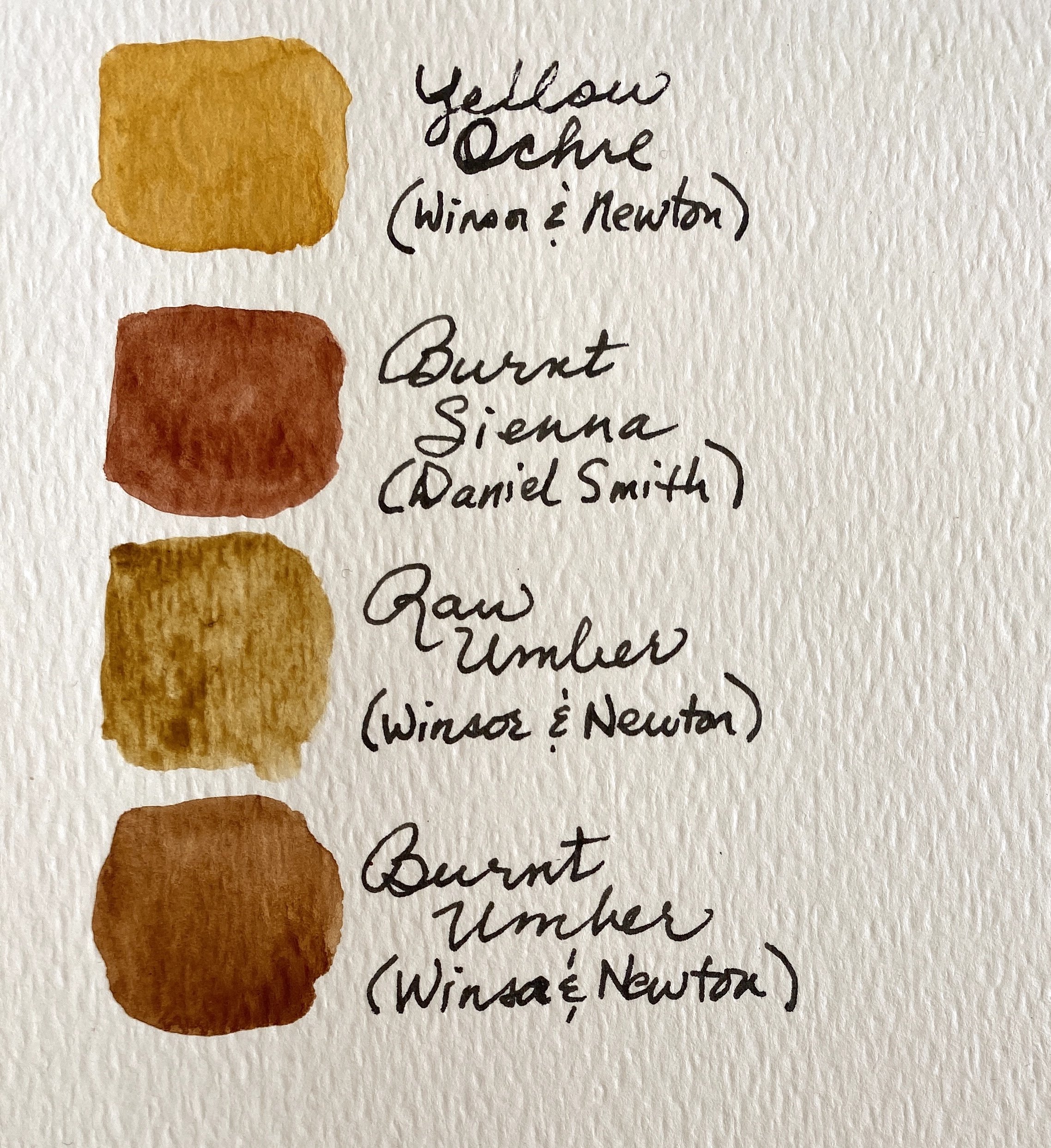
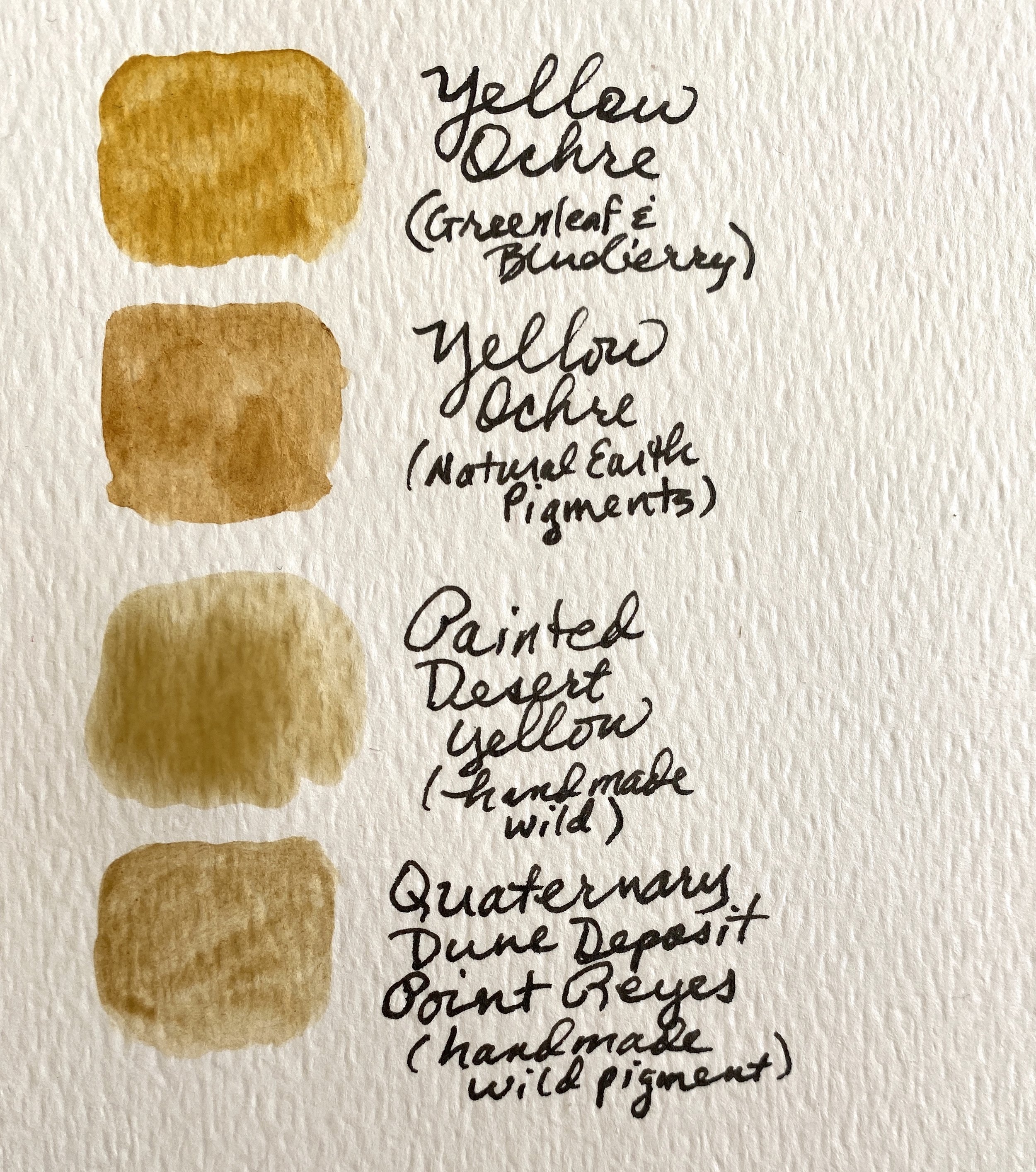
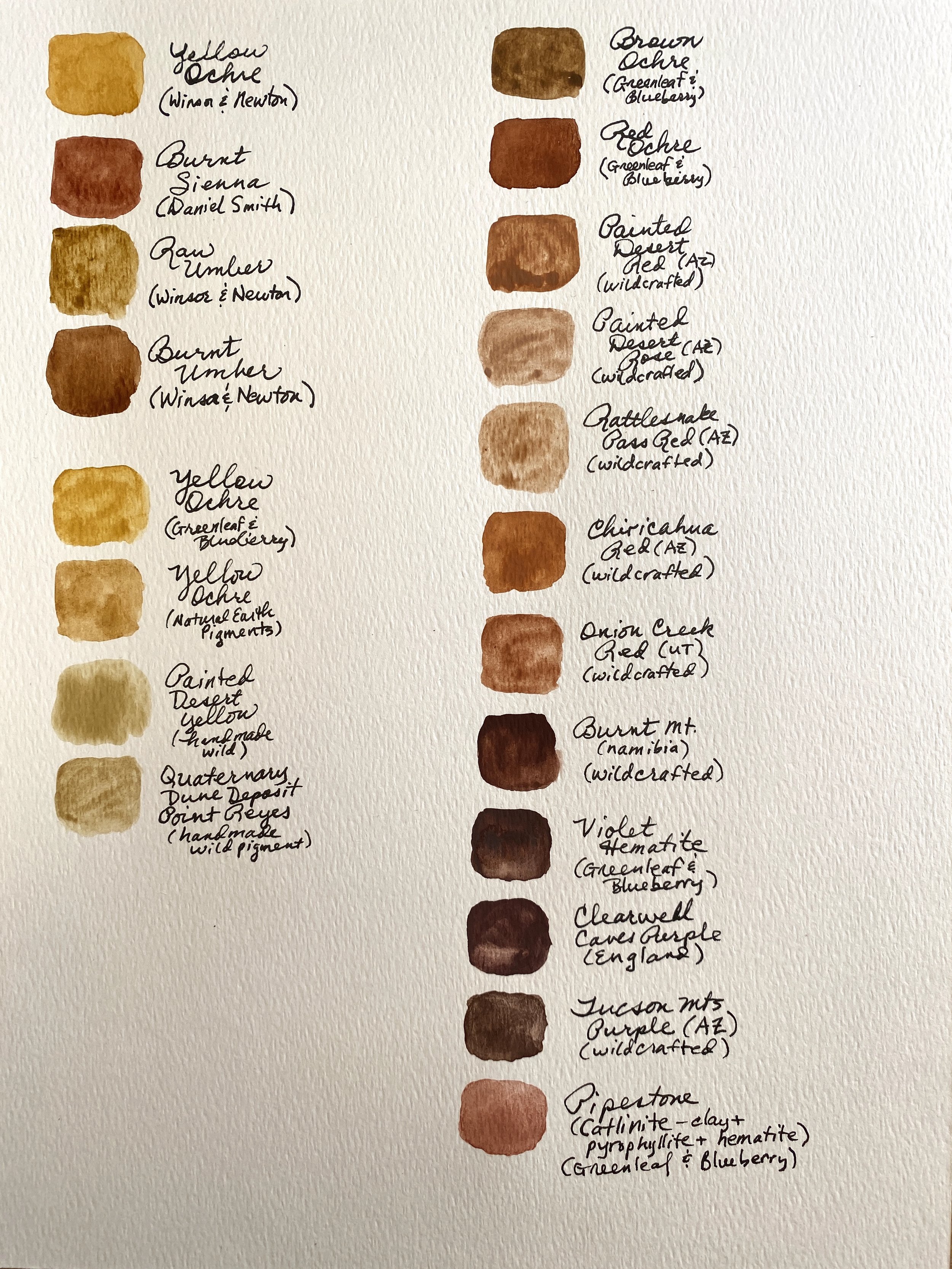
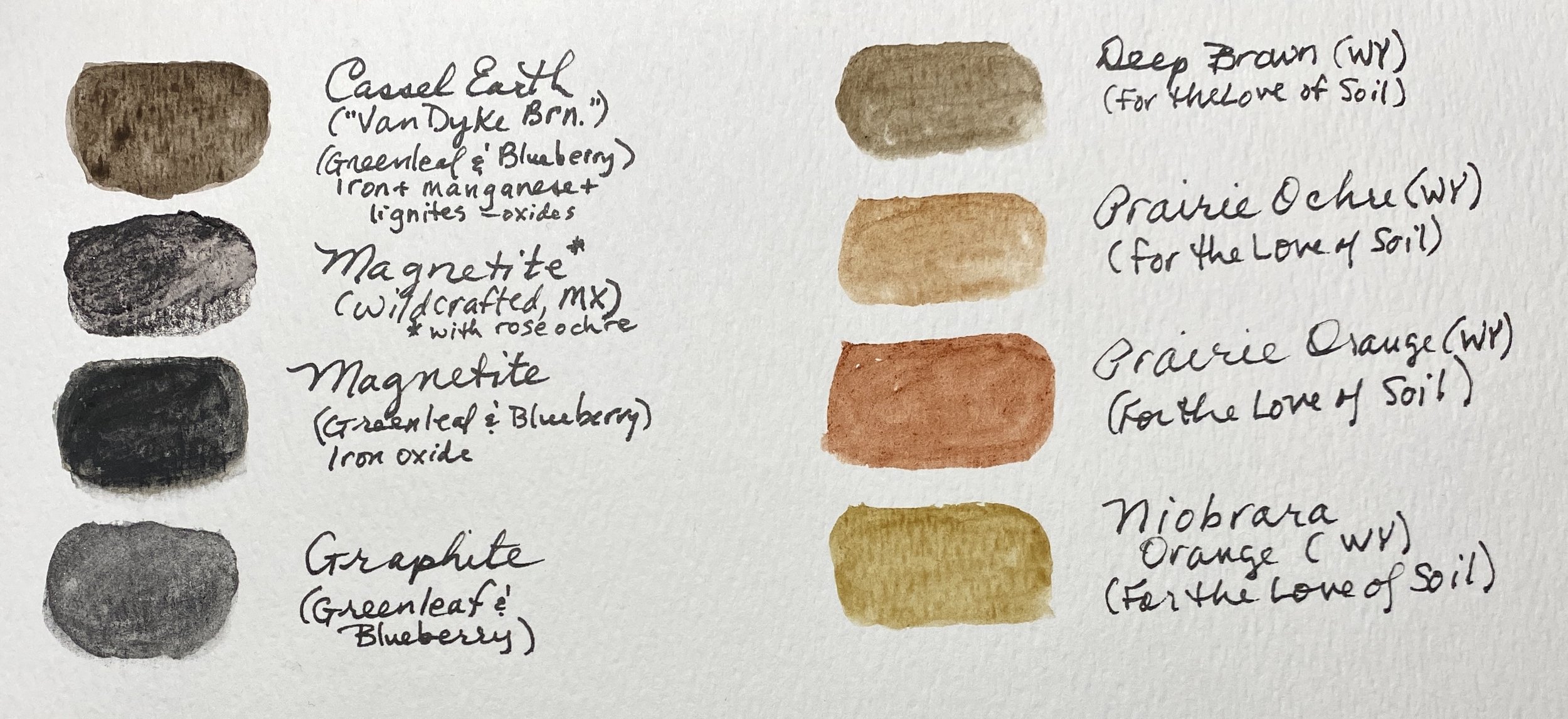
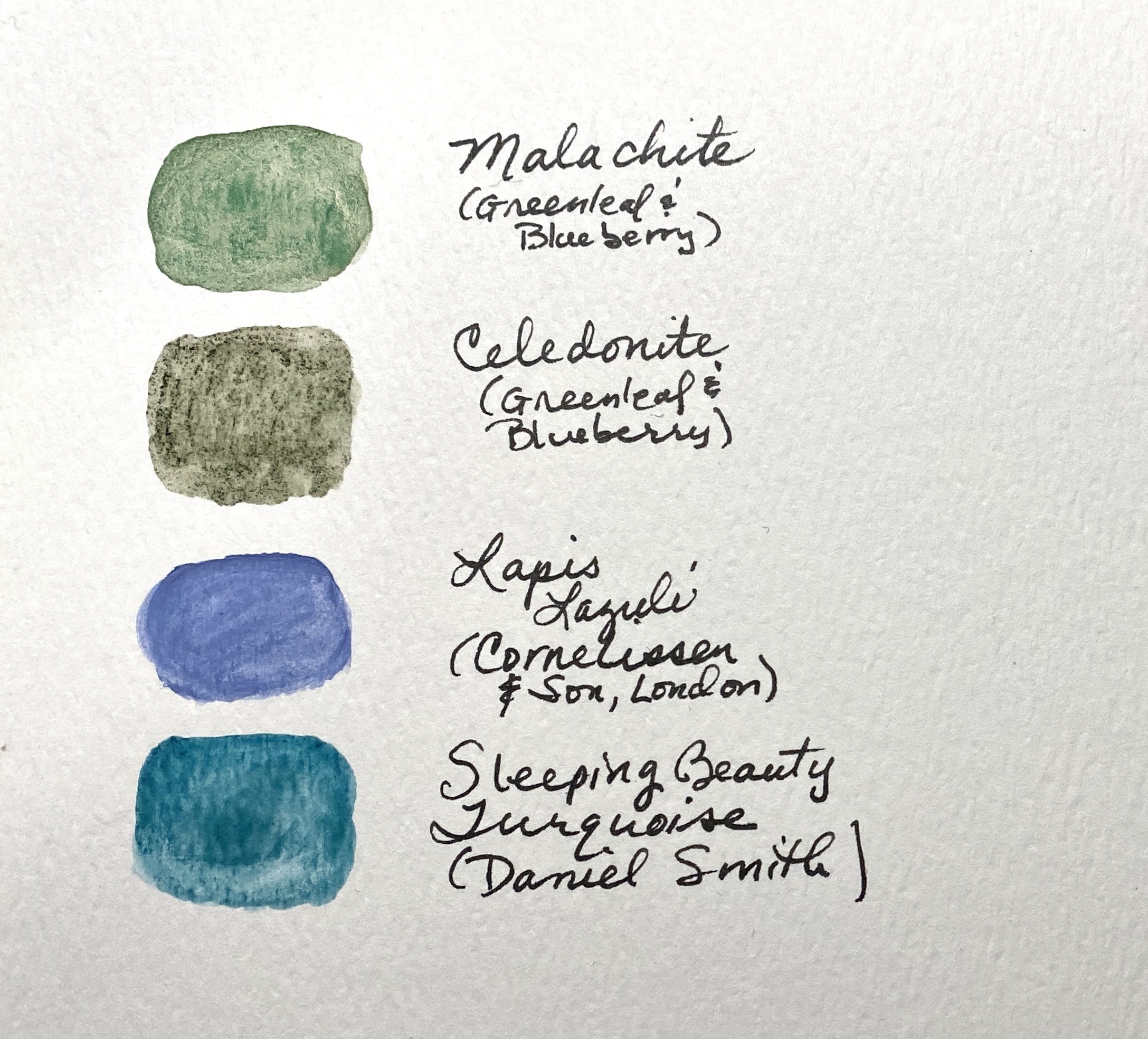
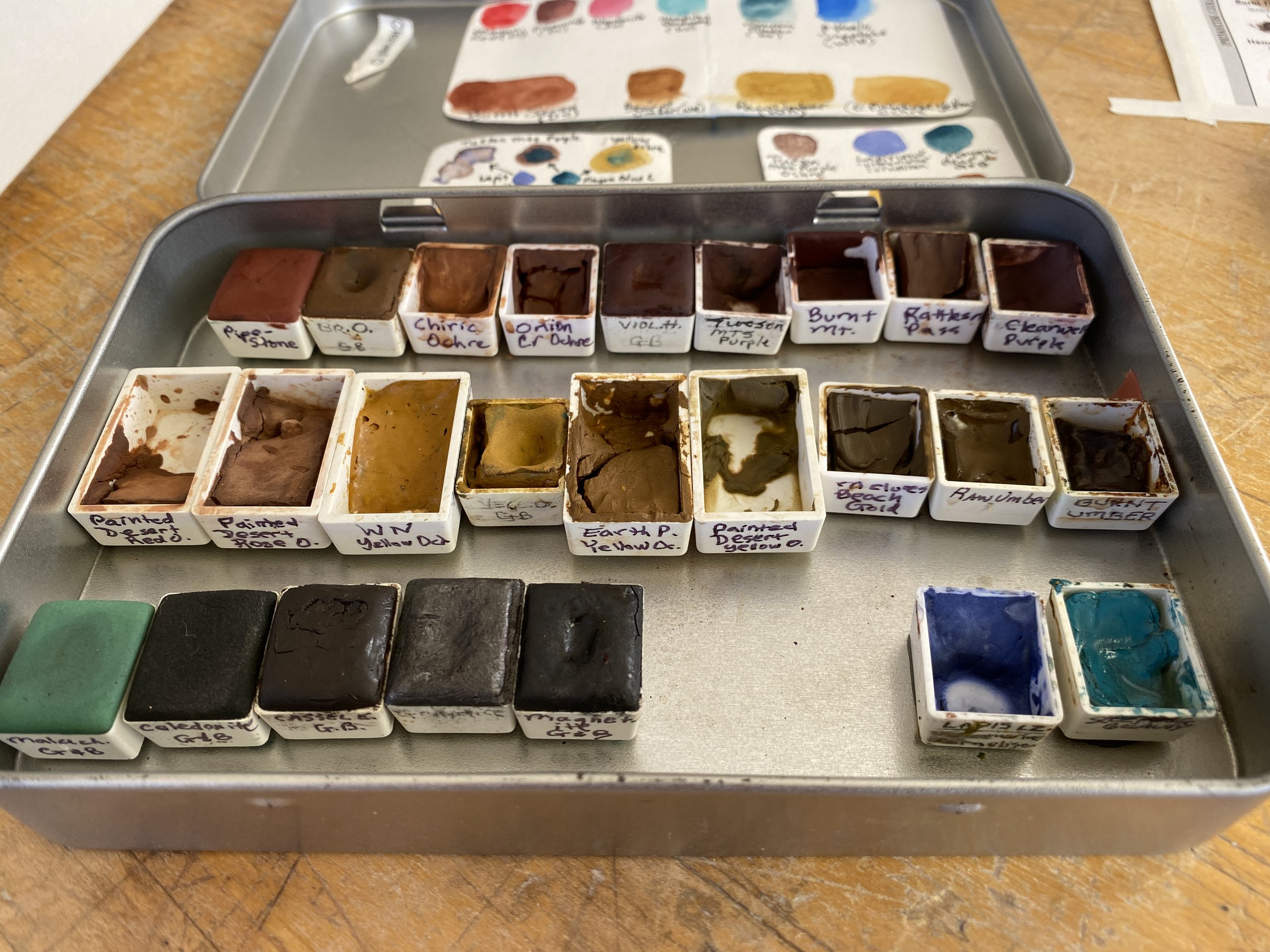
Images from Workshop Participants
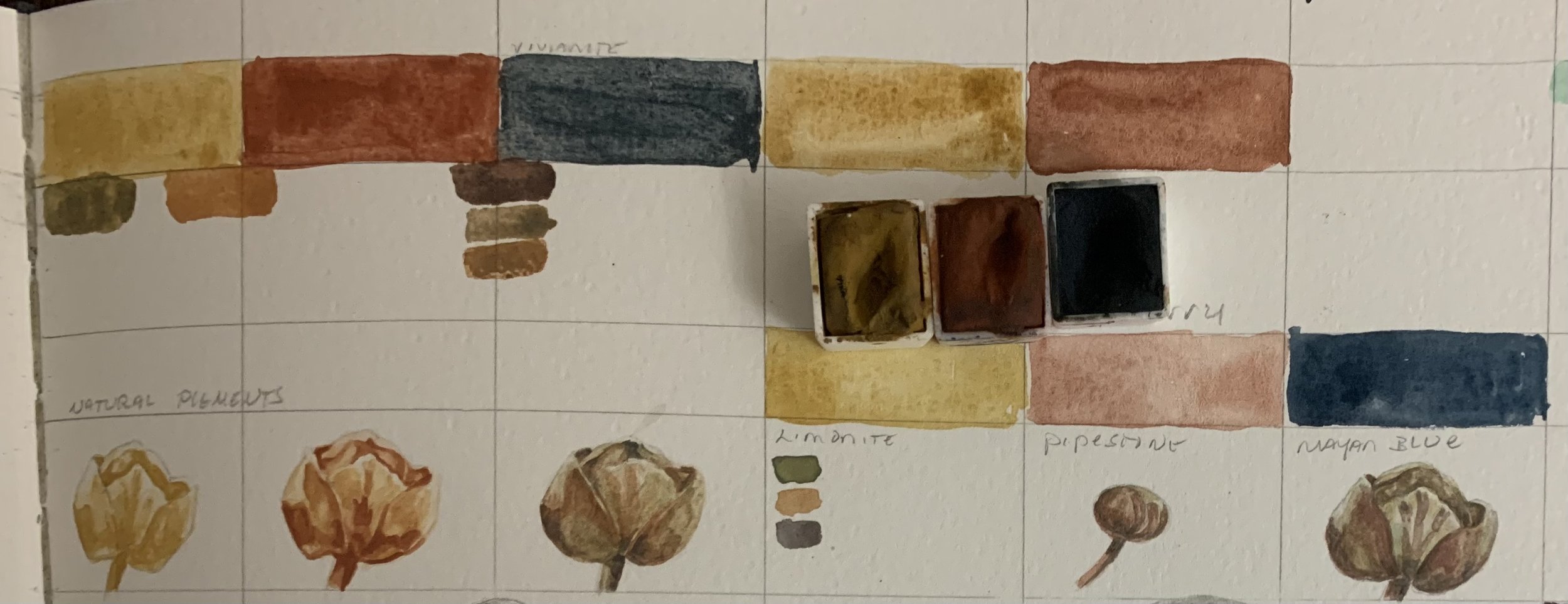
Virtual Field Trip to Arctic Alaska
I recently returned from a two-week exploration of the Alaskan high and middle Arctic—and fell in love! I'd love to take you there, so jump aboard as we head back to Point Barrow and Uqtiagvik, and then journey up the "haul road" to Prudhoe Bay, enjoying the Brooks Range and looking for caribou and muskox. [You can view my journal pages from my journey by clicking the link above.]
Length: 2 hours
Resources from the Field Trip
To access the Virtual Field Trip online, my interactive journey with dozens of images and videos and maps: https://360exploring.s3.us-west-1.amazonaws.com/Arctic+Alaska/output/index.html
CHAT transcript — click > https://www.dropbox.com/s/epenu1vs7lxtkgl/Chat%20Transcript%20Virtual%20Field%20Trip%20Alaska.pdf?dl=0
Click image at ABOVE to initiate download of the workshop PDF with all the information. Or, use: https://www.dropbox.com/s/xhbhlextkbvnr4v/Alaska%20Virtual%20Field%20Trip%2010-2021.pdf?dl=0
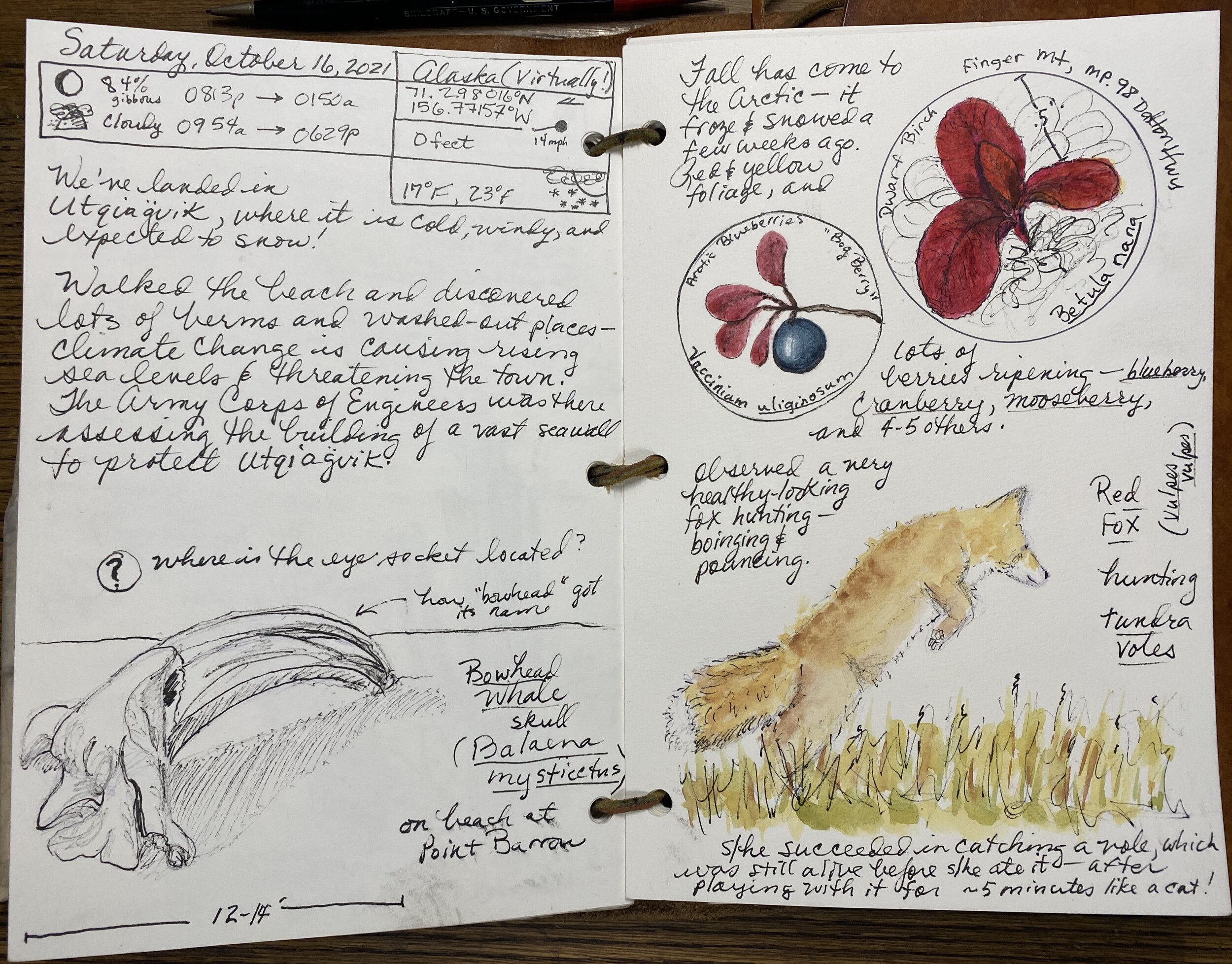
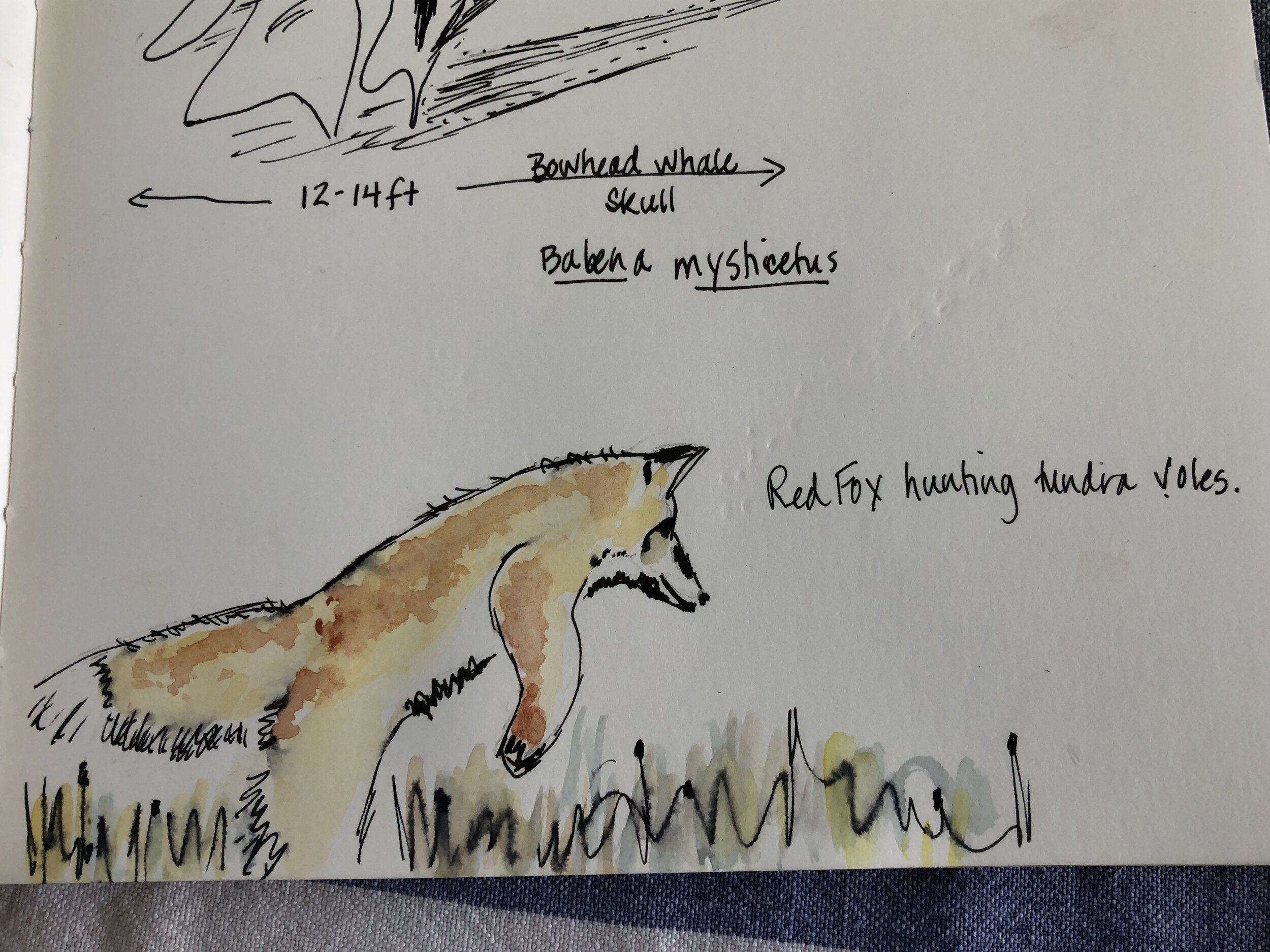
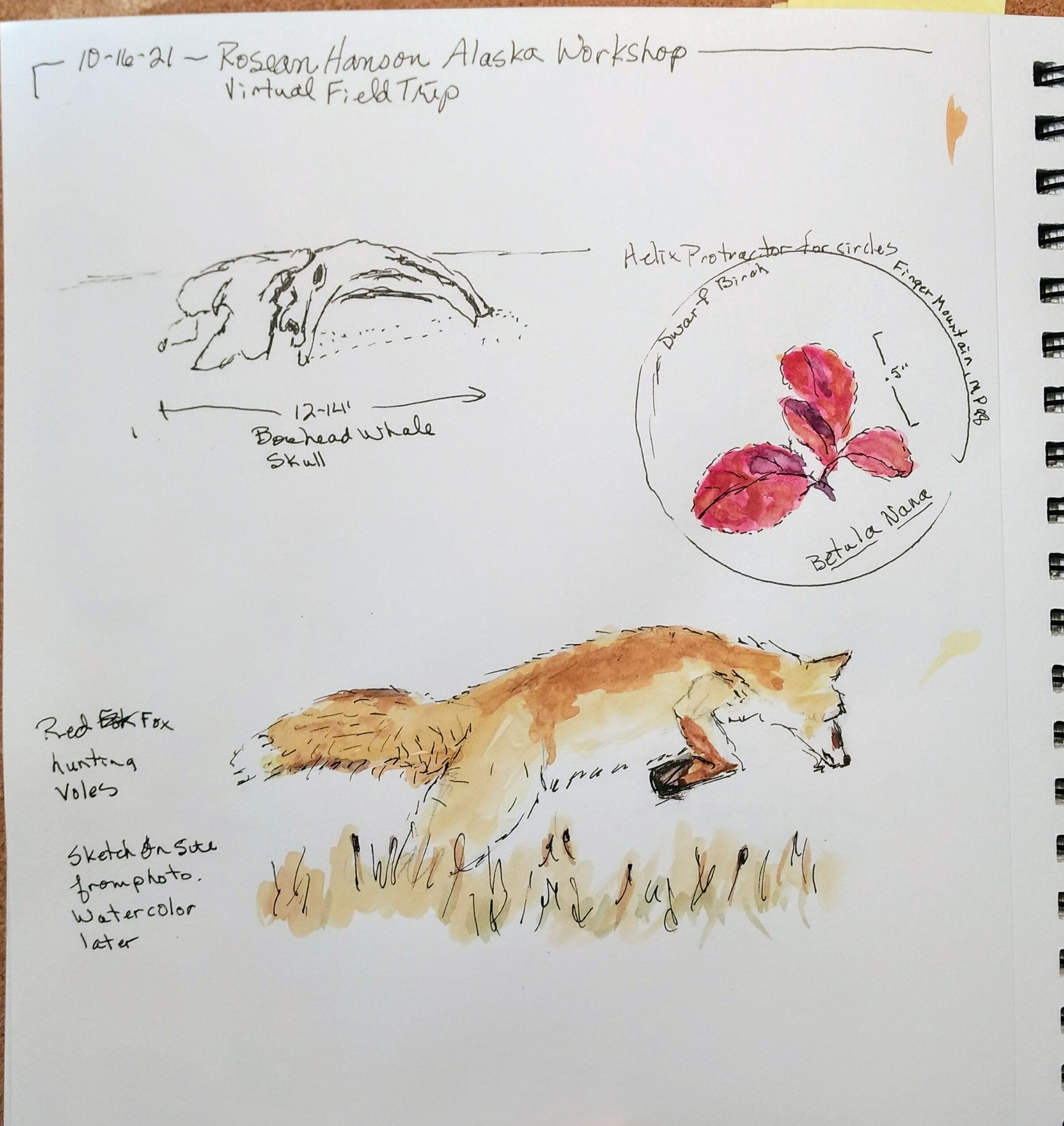
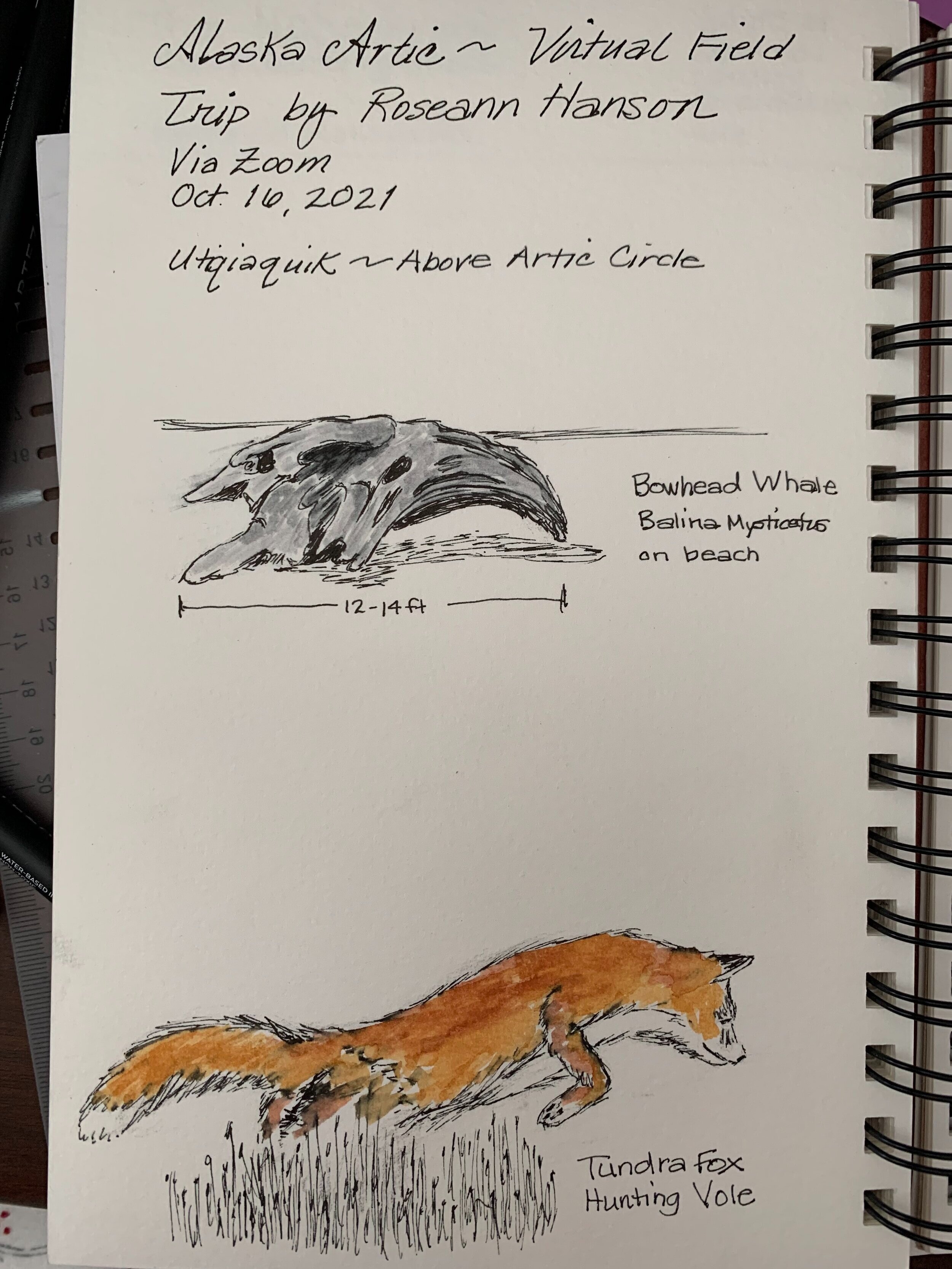
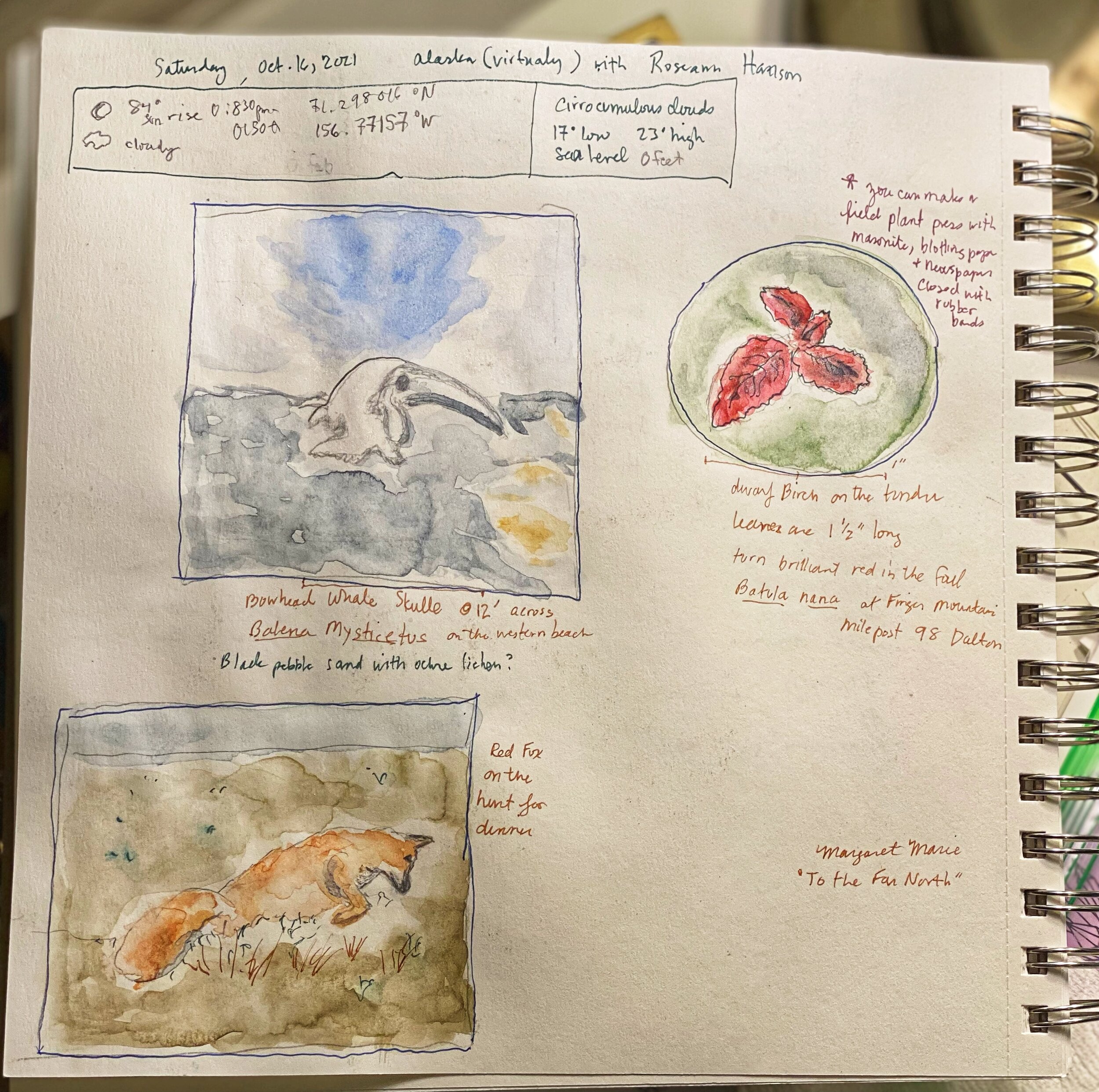
Field Arts Workshop: Elegant Ink for Field Notebooks
Join me for a celebration of the art of elegant ink in our sketchbooks. While I do love color in my journal, I also love the beauty of well-wrought pen sketches.
We’ll cover types of pens and inks (from ballpoint to fountain pens, including the pluses and minuses of the types); practice mark-making and values; and work on a couple of different types of sketches using one image to create each, so we can see how different styles of linework each produce a different “feel” on your pages.
Length: 2 hours
Images at right: Creating various “palettes” for your marks is a great exercise and very useful to keep tucked in a pocket of your journal for reference. The different types of stroke, texture, and tone are like words in a language or paint colors in a palette: you choose each for a different effect, feel, tone, or emphasis.
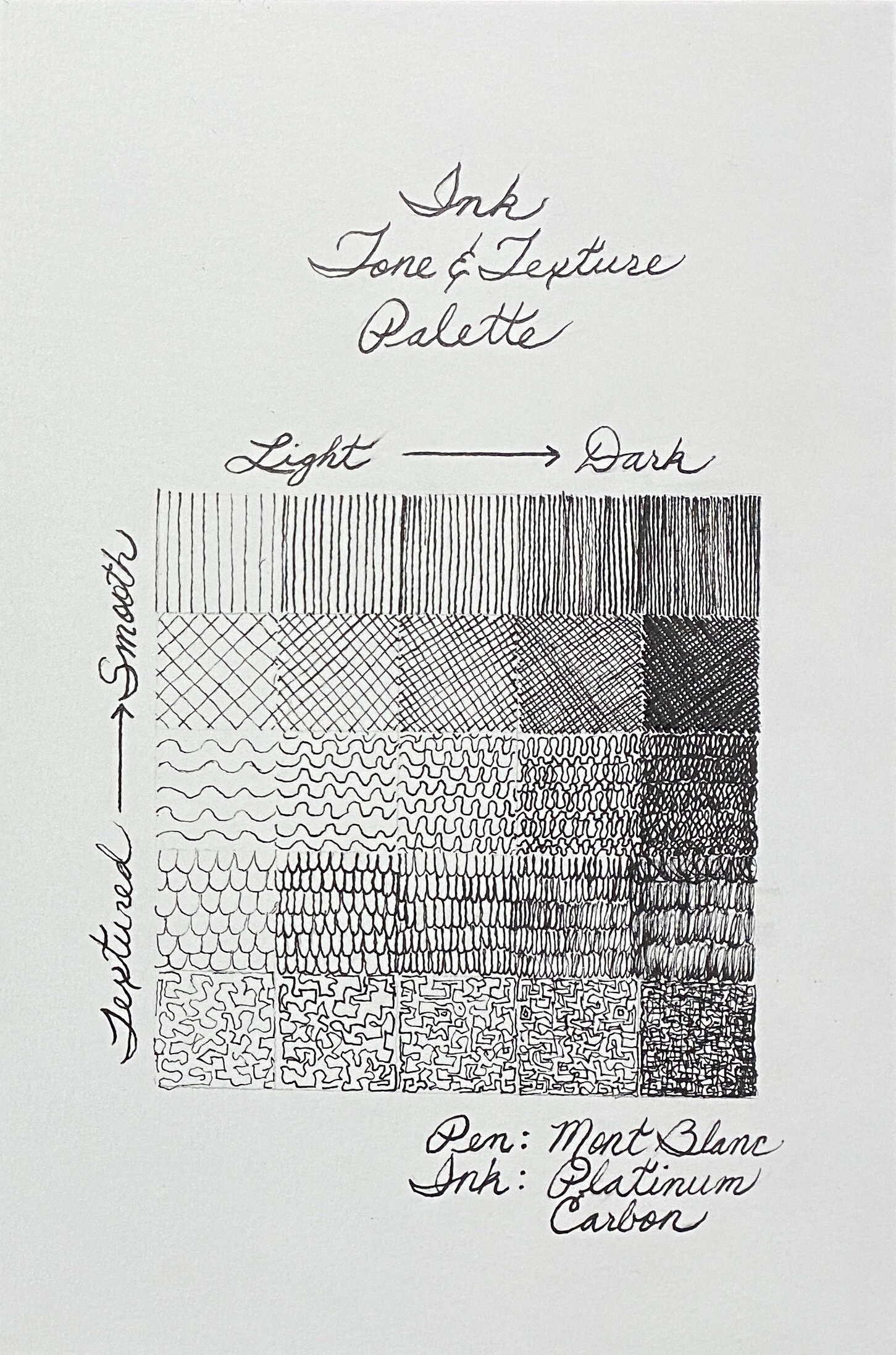
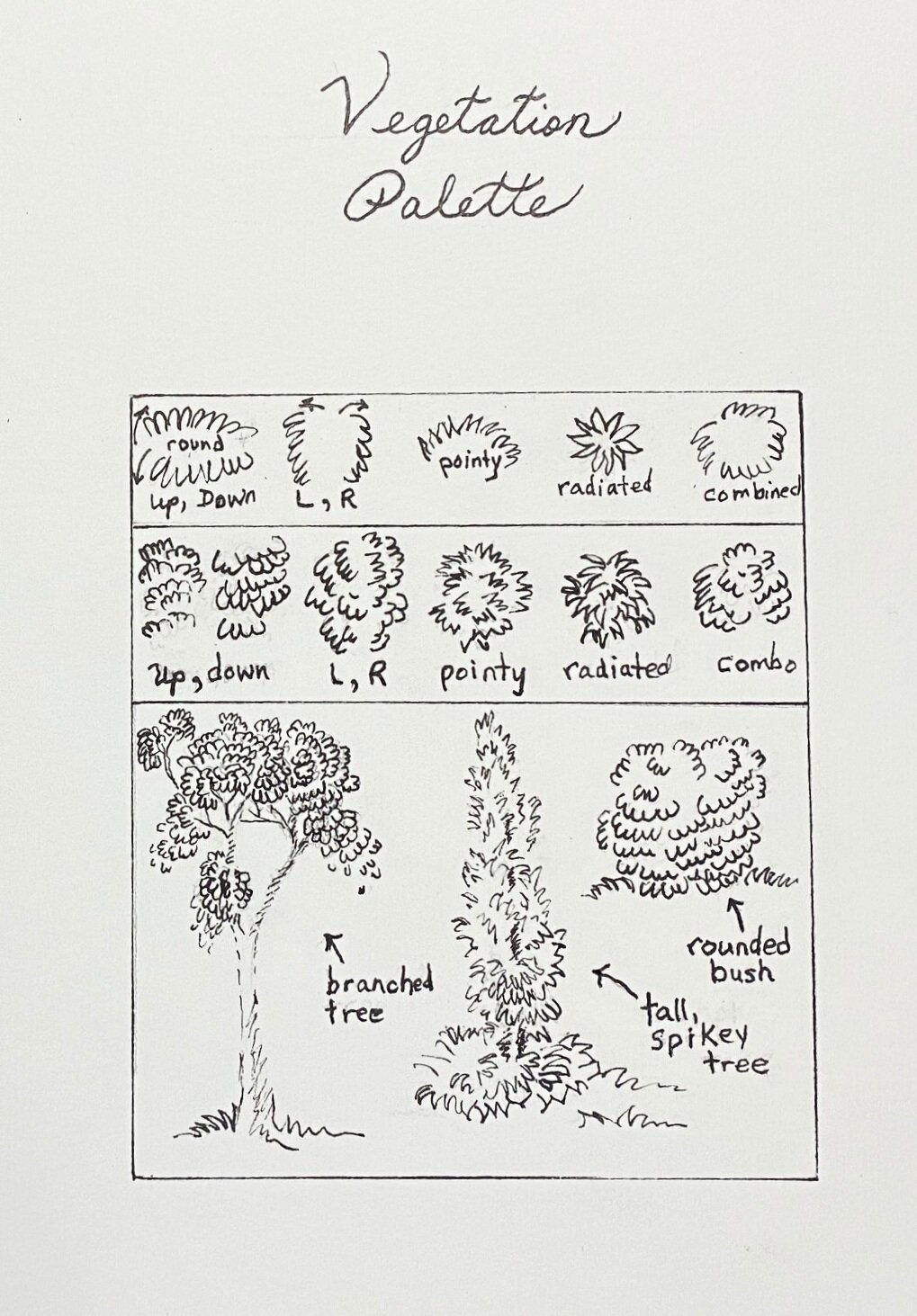
Resources from the Workshop
CHAT transcript — click > HERE <
Click image BELOW to initiate download for the workshop PDF with all the information, sample images, and links. Or, use: https://www.dropbox.com/sh/rvlzr0a9hezdgjr/AACw6pH9jwhj6sQ-rvmM_GGwa?dl=0
Bonus! I did a short video (no sound) of how to clean and refill a fountain pen:
DEMOS FROM THE WORKSHOP
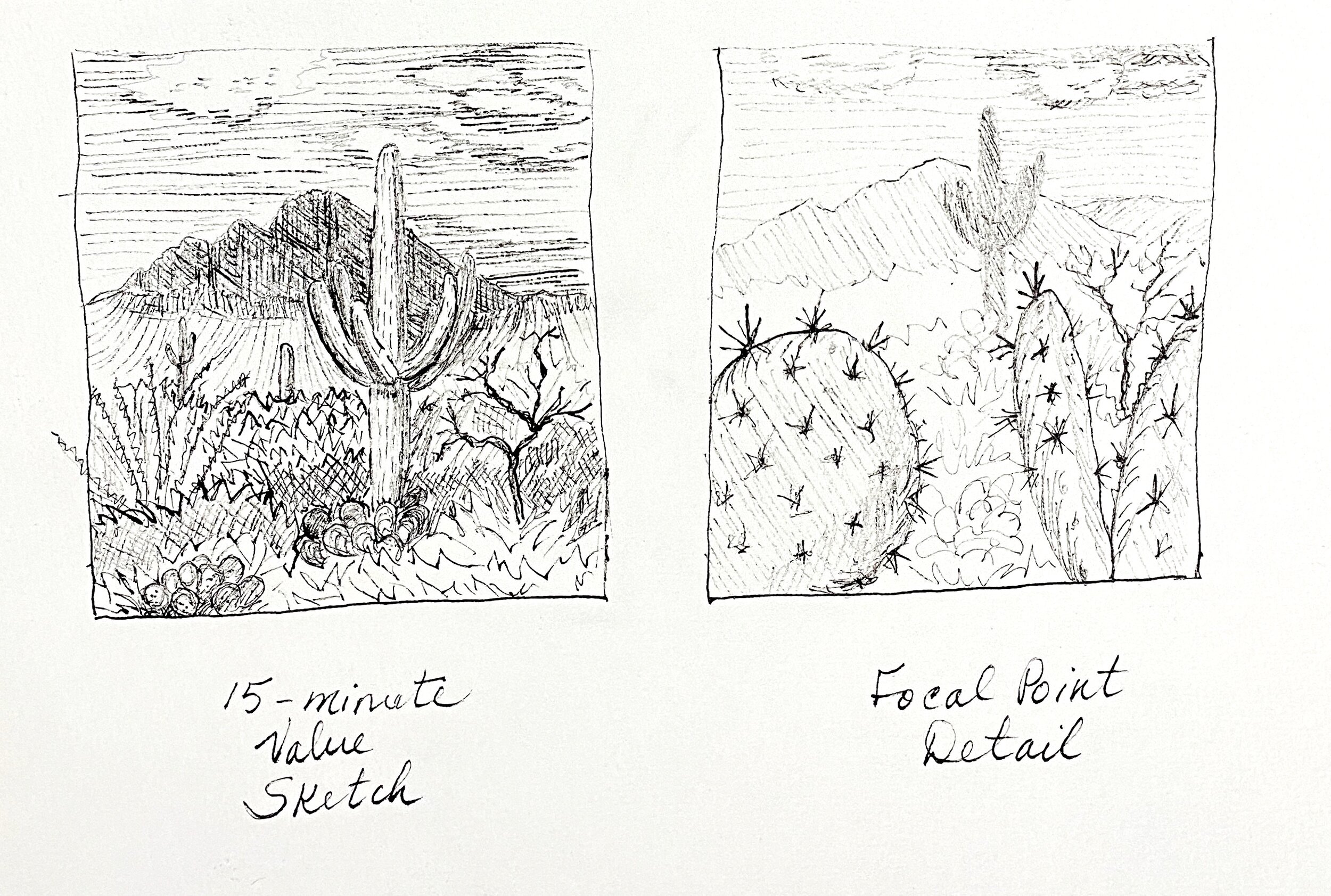
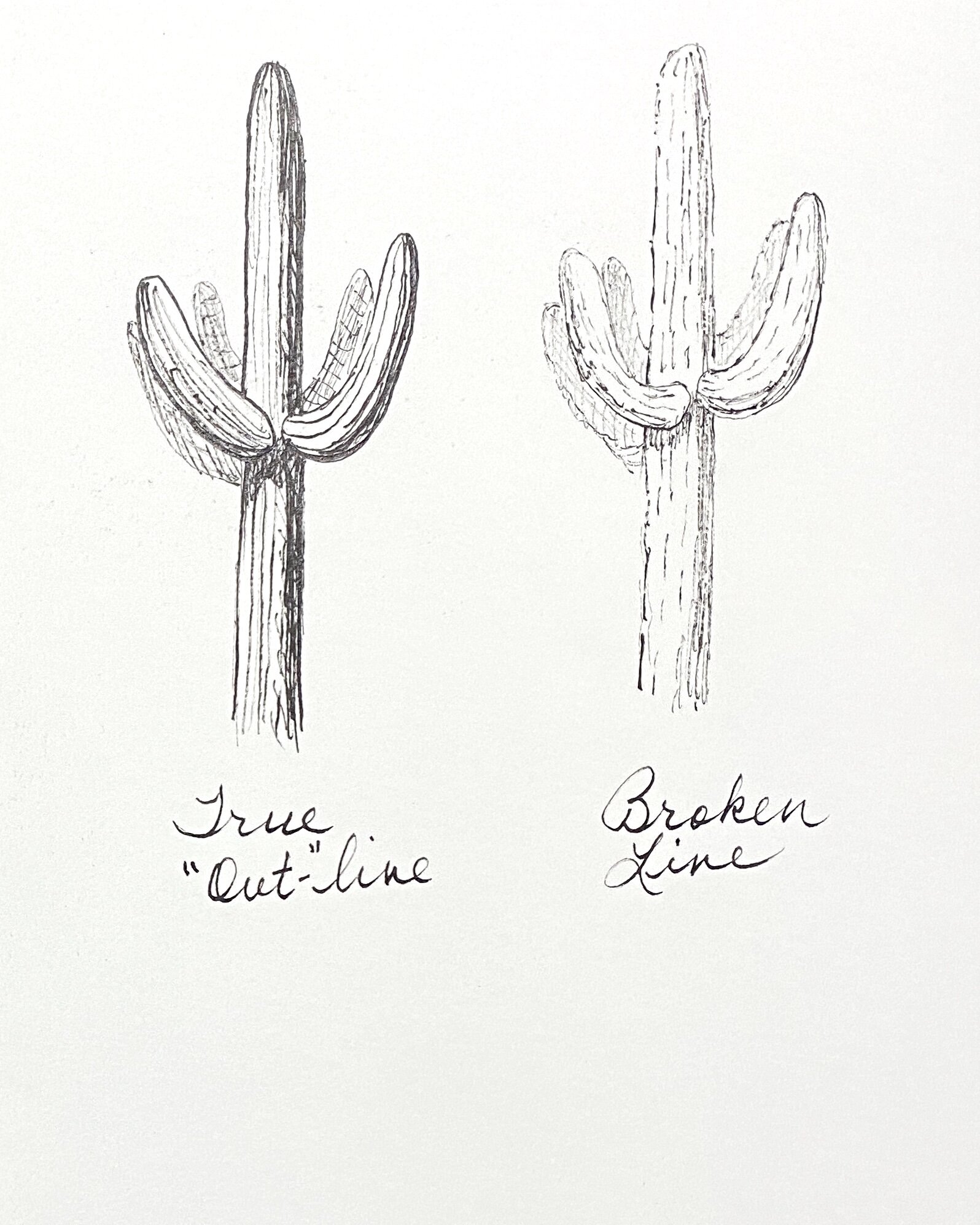
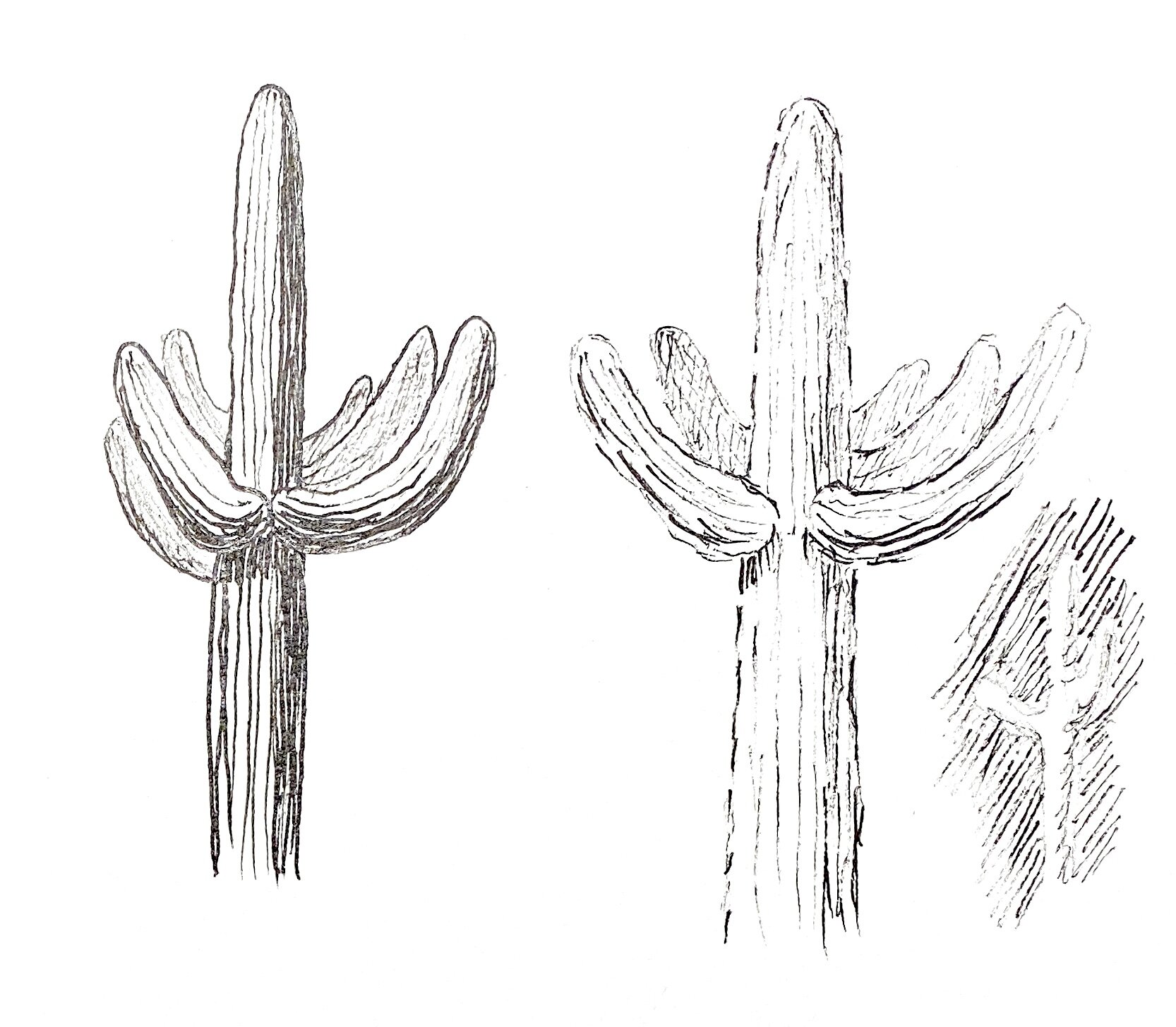
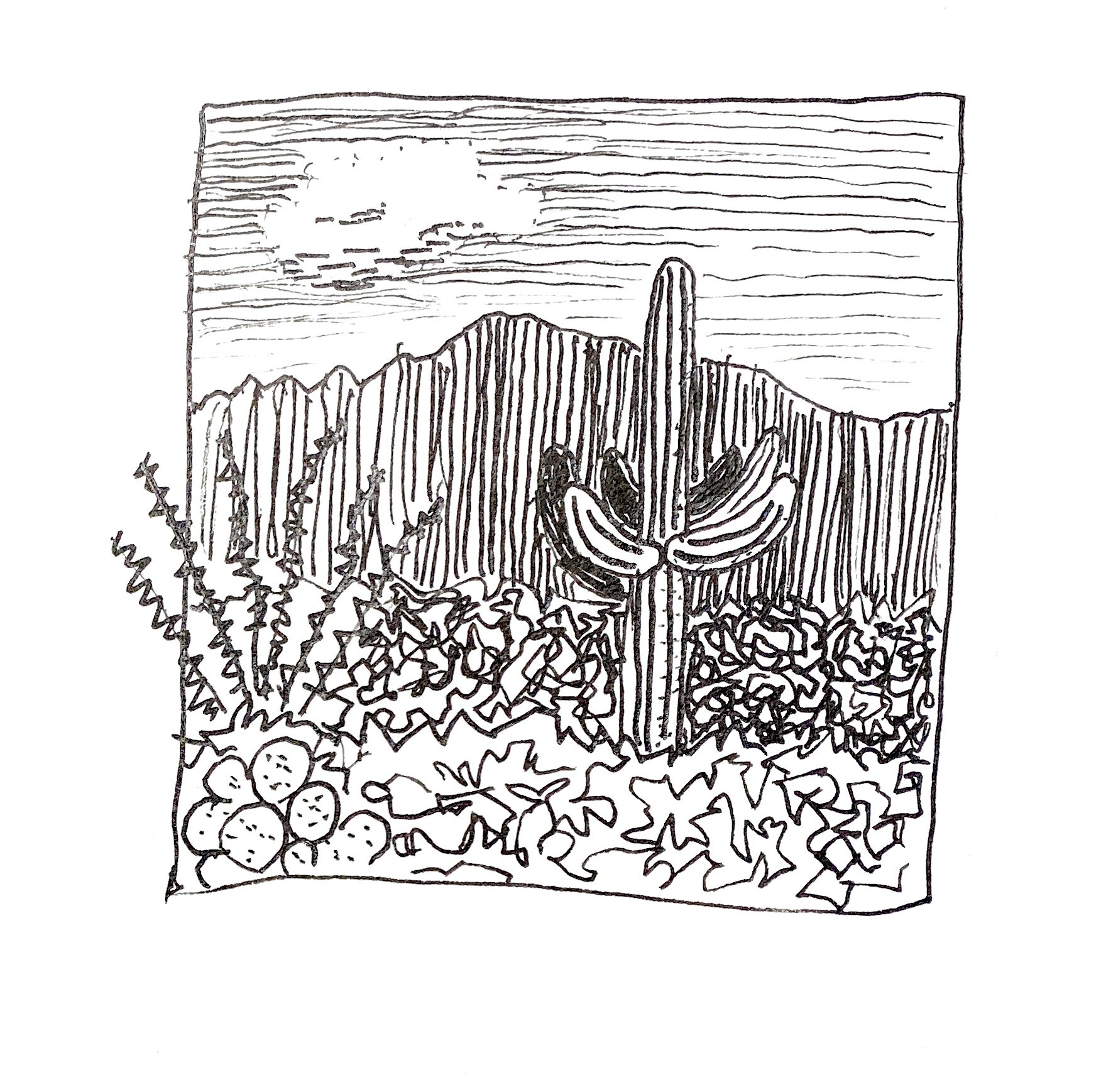
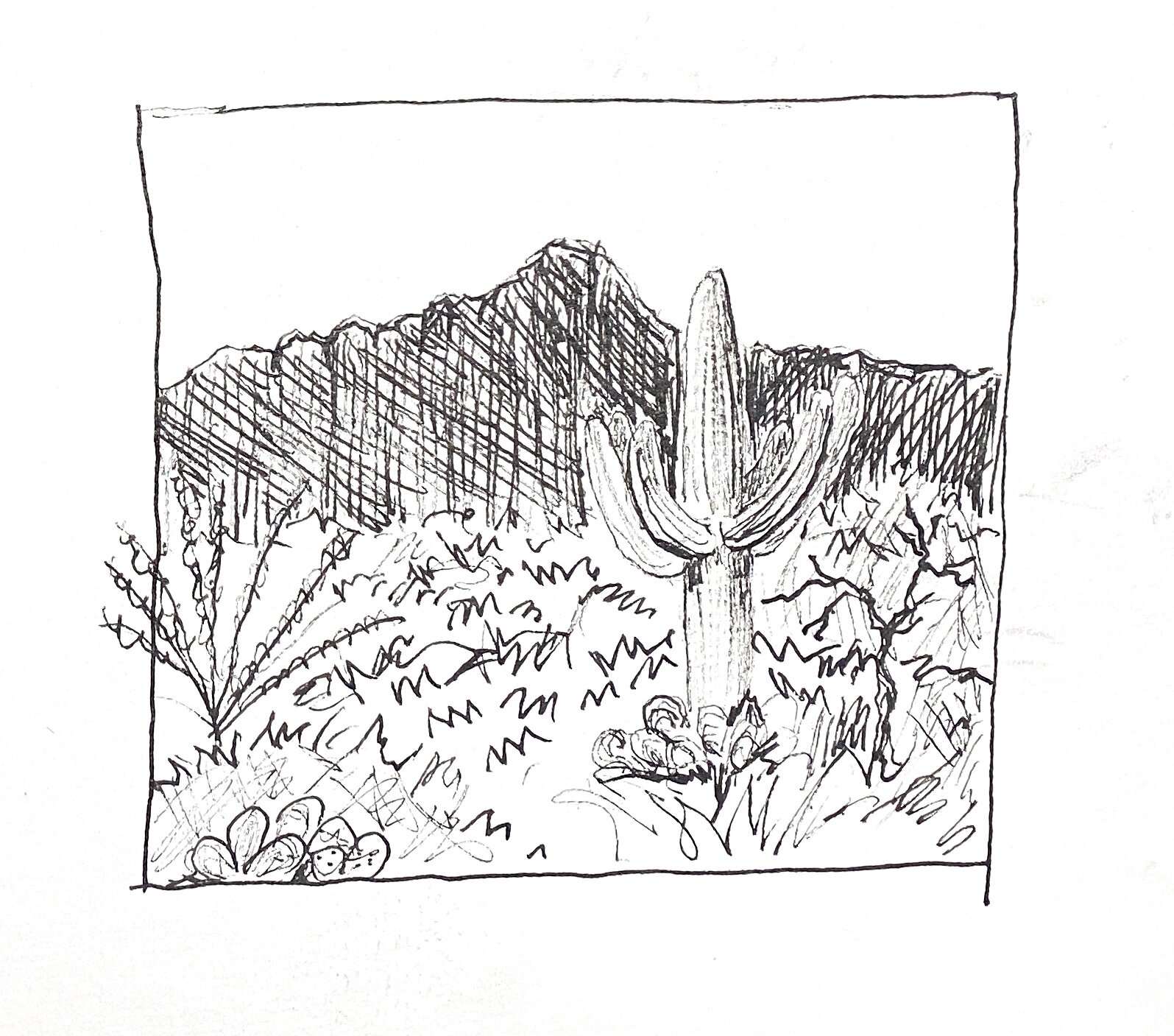
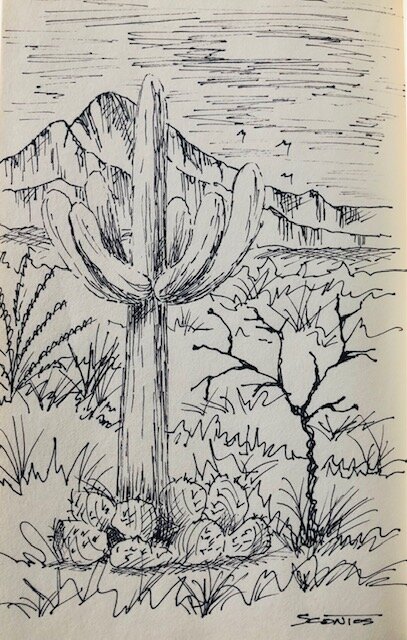
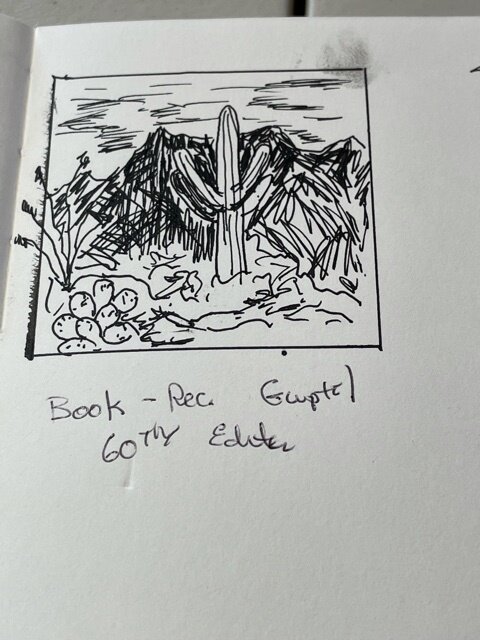
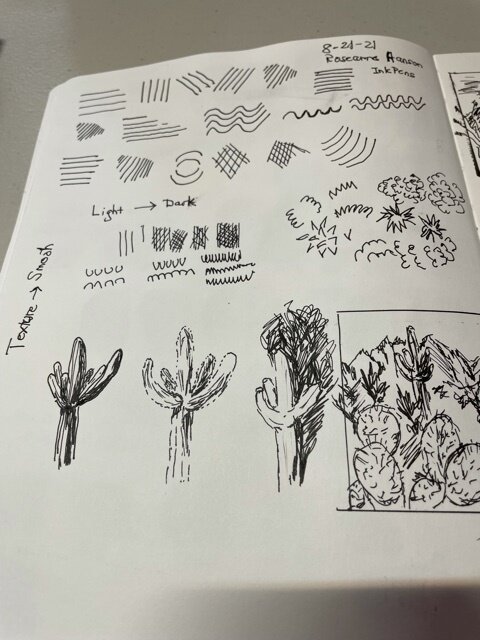
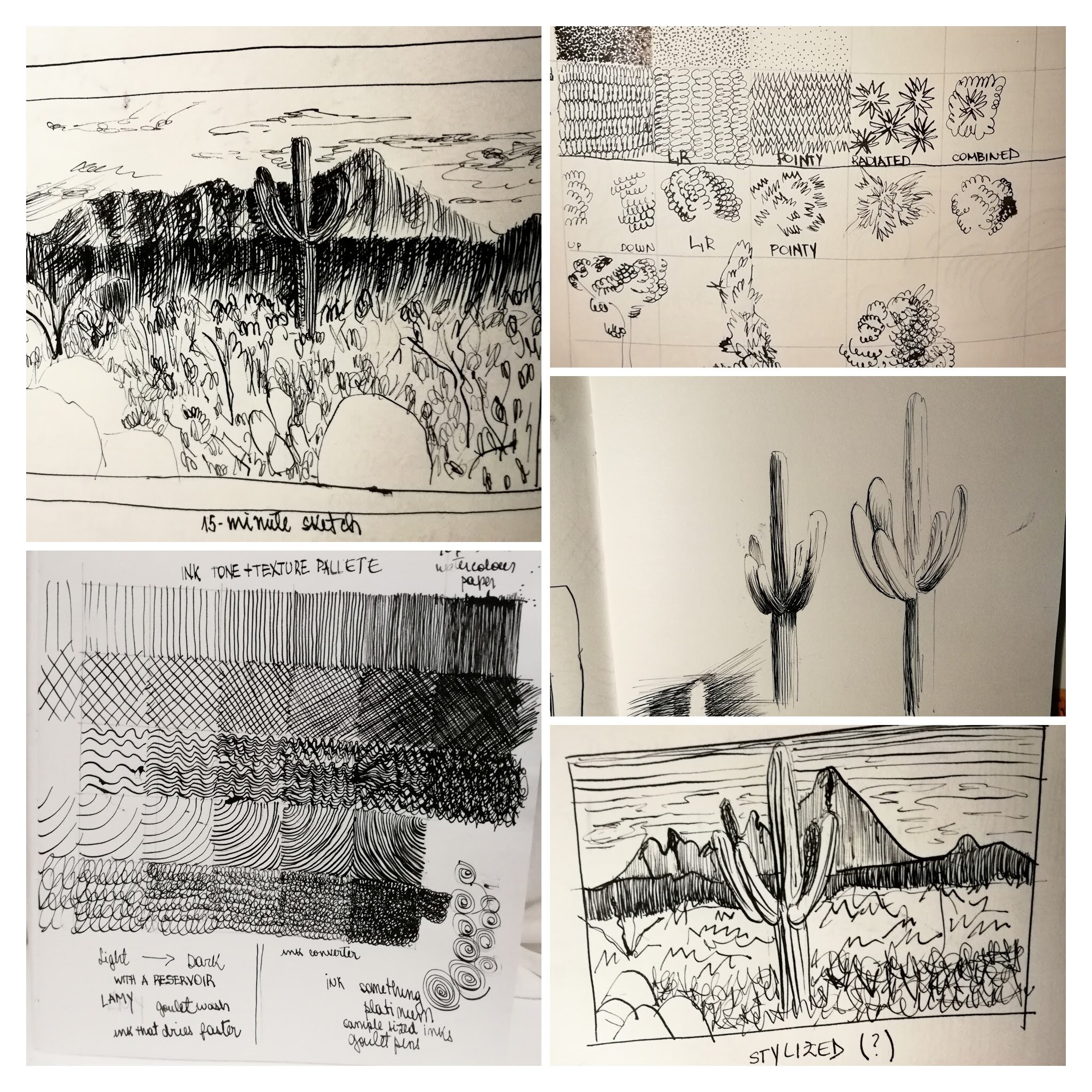
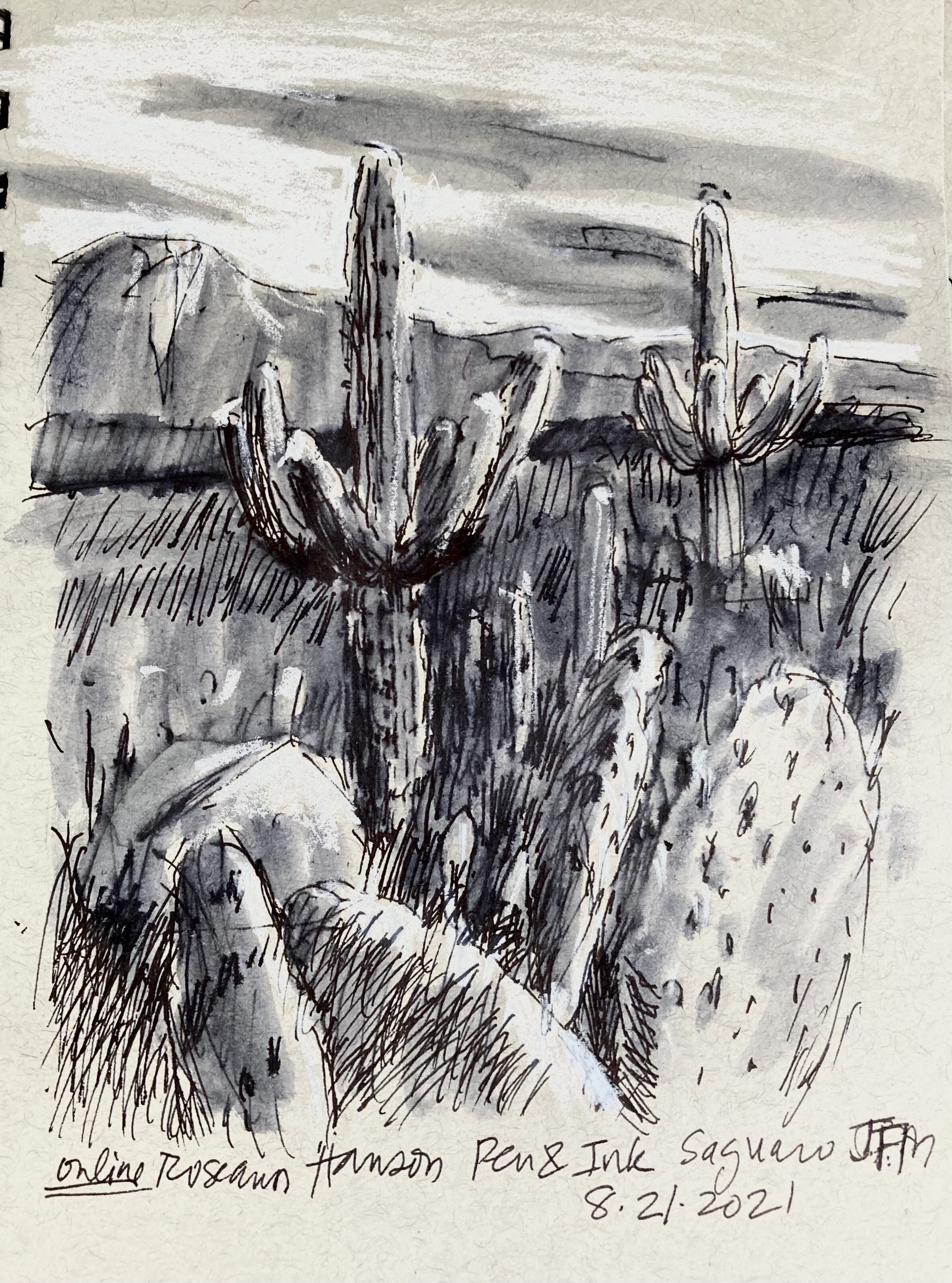
Field Arts Workshop: Weather 101 for Field Notebooks
Creating a cloud ID chart is a great way to practice cloud-painting skills as well as to learn the main cloud types.
Metadata for your field notebooks is a crucial addition, to give your entries a solid foundation in context: date, time, sunrise / sunset, moon phase, and weather. Weather is fun to learn: What are the clouds? How do you ID them? How do you tell the wind speed? What are the symbols for recording weather?
In this free Field Arts tutorial, we will dive into learning about weather data, what is climate vs. weather, where weather forms and how, and how to ID clouds. Then we’ll create a cloud-chart that you can keep in your journal for future reference.
Length: 2 hours
Resources from the Workshop
pdf with all links and download link for images and ALL THE charts (CLICK IMAGE):
Click image to initiate download. Or, use: https://www.dropbox.com/sh/rvlzr0a9hezdgjr/AACw6pH9jwhj6sQ-rvmM_GGwa?dl=0
SUGGESTED PAINTS AND SUPPLIES:
Ruler and pencil
Pen with waterproof ink
And for the color, two approaches:
1) Traditional:
- watercolor paper (9x6 or larger), at least 90 pound
- cobalt or cerulean; these are pretty and wash easily, and also lift easily. French ultramarine is wonderful but does not lift as well and does granulate a little, so it will settle into the texture on your paper, which you may or may not like.
- burnt sienna to mix with your blue to create a nice gray for the clouds
- alternatively, shadow violet
OR
2) gouache:
- toned paper (dark grey or tan)
- gouache paint in white and blue and burnt sienna
I actually found the toned with white gouache to be much easier for this chart exercise!
You can find my list of minimalist colors and tips on color mixing here: https://www.exploringoverland.com/field-arts-tutorials-list/2020/7/5/minimalist-watercolor-for-nature-journaling
COLORS I DEMONSTRATED:
Manganese Blue (Old Holland)
Cyan (Greenleaf & Blueberry)
Cobalt (Daniel Smith)
Cerulean (Daniel Smith)
French Ultramarine (Daniel Smith)
Pthalo Blue (Green Shade, Daniel Smith)
Goache Set from Caran D’Ache (white, yellow, blue, red, burnt sienna)
This is the reference image for creating your own cloud chart for your journal.
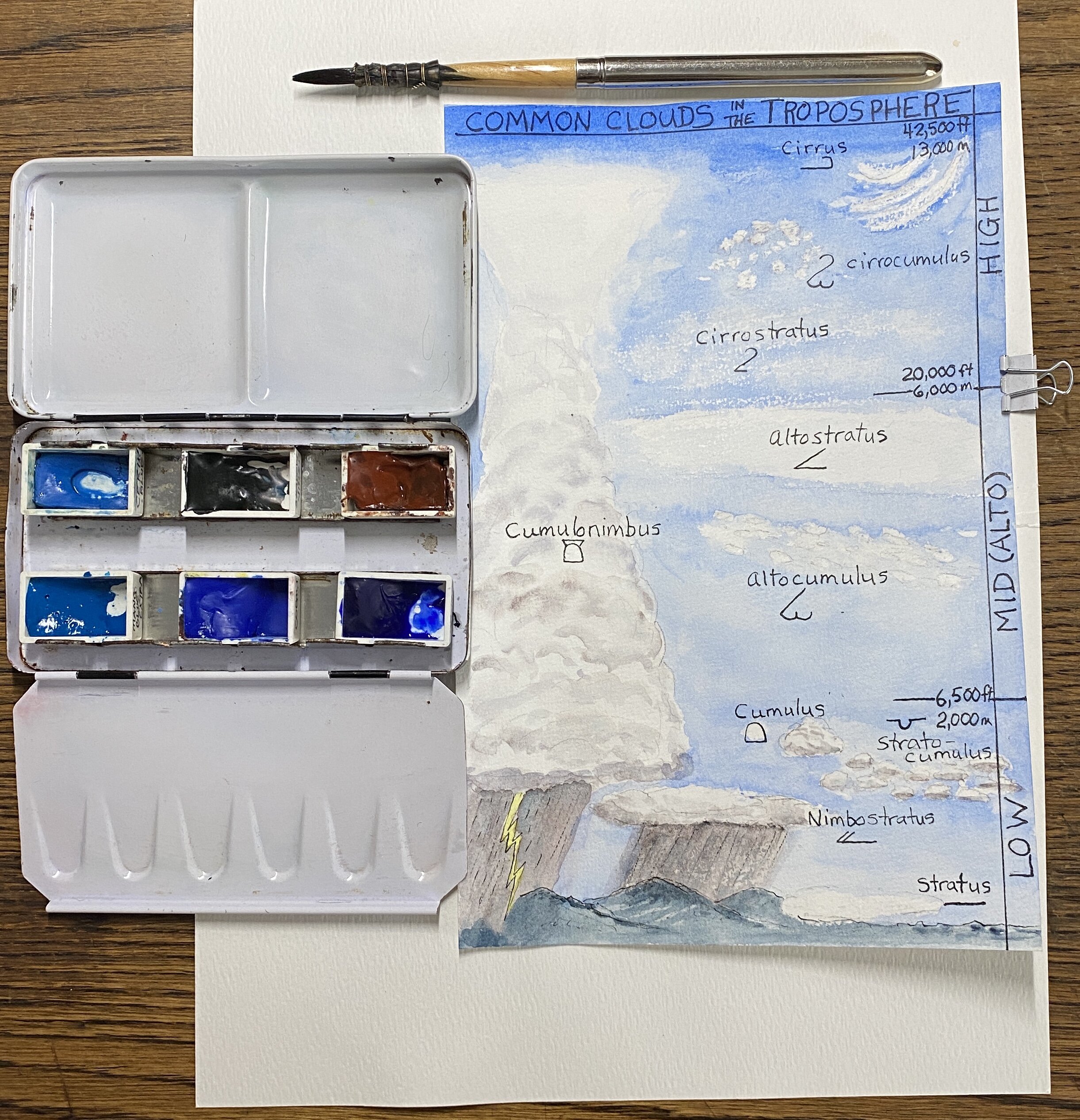
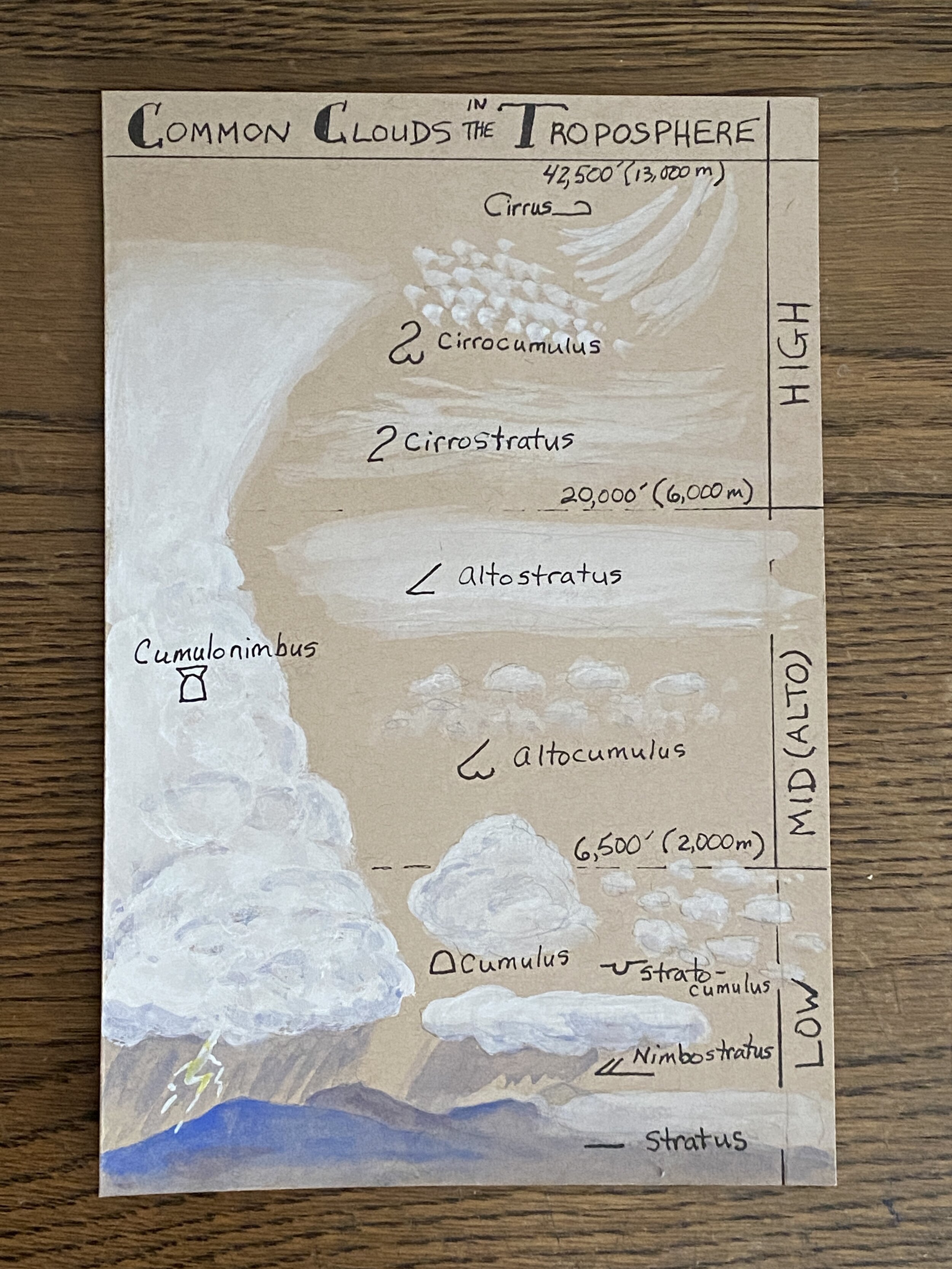
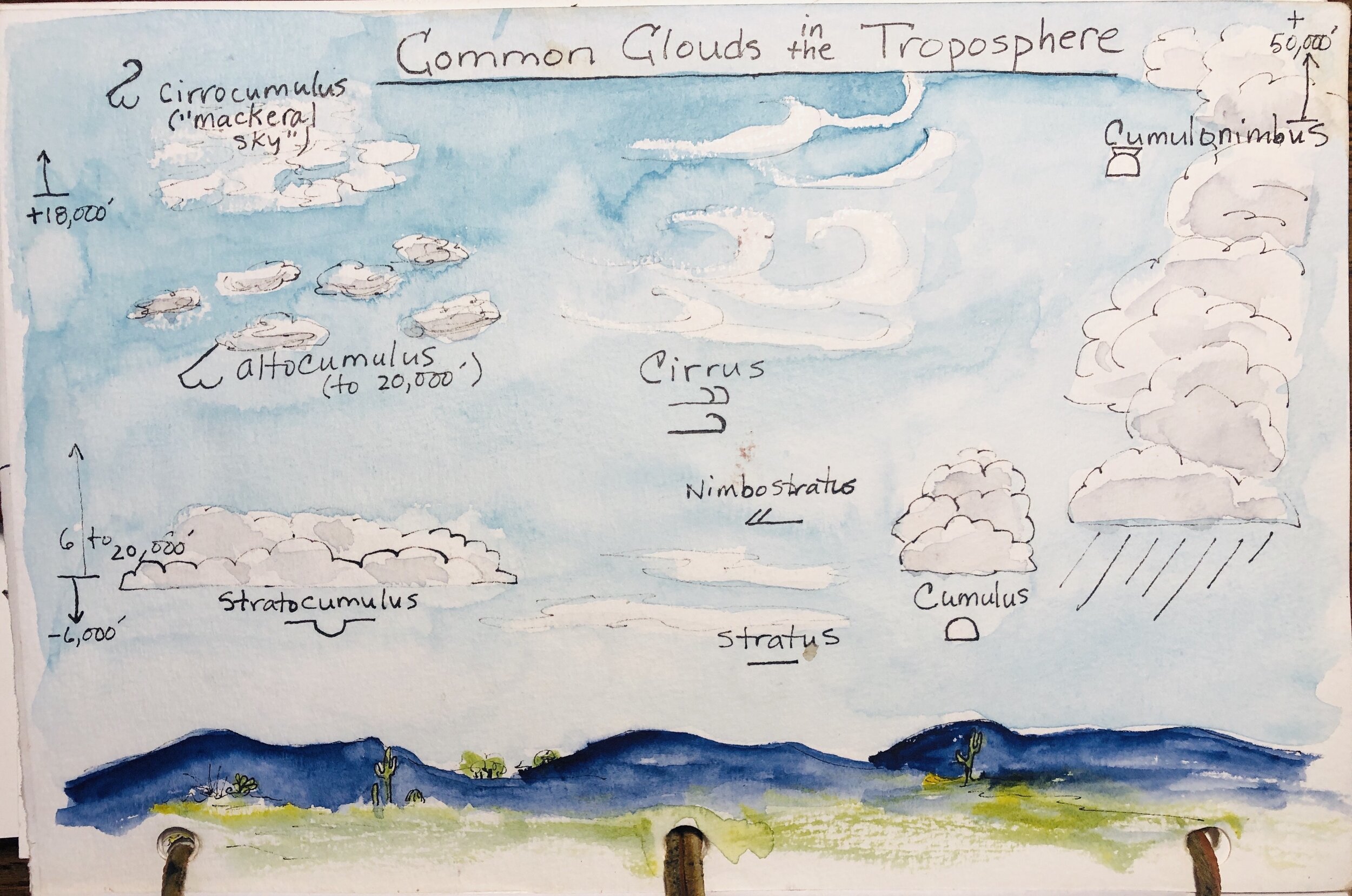
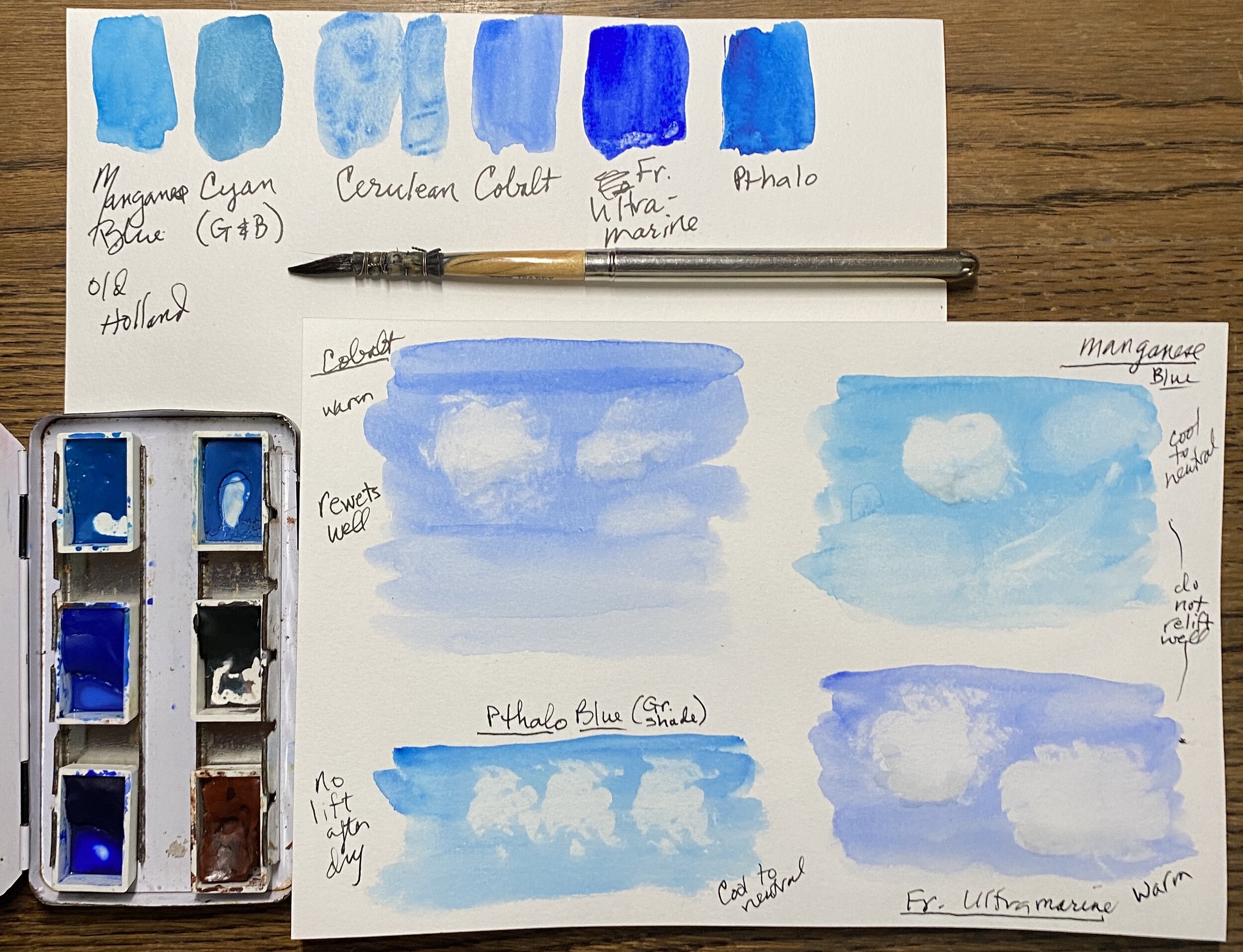
Field Arts Workshop: Animal Tracking 101 for Field Notebooks
Female lion and cub tracks, Great Rift Valley, Olkiramatian, Kenya (click to enlarge).
Join me for a free online workshop on the basics of animal tracking—and different ways to add them to your field notebooks and nature journals. I’ve spent 30 years tracking wildlife and teaching tracking for conservation groups, and my husband Jonathan Hanson and I wrote the Basic Essential Guide to Animal Tracking.
Learn how to quickly tell canine from feline tracks, domestic dogs from wild, different gait patterns, and how to “read” a track story.
I’ll also show how to use my clear Perspex Palette-Easel ) to trace a track, and a template for making your own unique track ruler, as well as a free Quick Tracking Tips card.
Length: 2 hours
Resources from the Workshop
Perspex palette with dry erase:
Downloads (Tracking Tips Bookmark and Tracking Ruler):
Here’s a free printable tracking ruler, or order the same plastic original one that I use in the workshop, from Sue Morse at KeepingTrack.org. Sue is one of my tracking mentors. Her book is amazing, and recently updated.
field guides:
“Basic Illustrated Animal Tracks” by Roseann and Jonathan Hanson https://www.amazon.com/Basic-Illustrated-Animal-Tracks/dp/1493017179
The two best deep-dive tracking training books:
Paul Resendez, “Tracking and the Art of Seeing” https://www.amazon.com/Tracking-Art-Seeing-Animal-Tracks/dp/0062735241
and Sue Morse, “Wildlife and Habitats” https://keepingtrack.org/keeping-track-store
Good in depth basic field guides:
“Scats and Tracks of the Desert Southwest” by James C. Halfpenny, illustrations by Todd Telander https://www.amazon.com/Scats-Tracks-Desert-Southwest/dp/1560447869
and
https://www.amazon.com/Mammal-Tracks-Sign-American-Species/dp/0811737748
Recommended in the chat:
Oldie but goodie: Animal Tracks by Olaus J. Murie, Peterson Field Guide Series. Love the line work and clear illustrations.
“Mammal Tracks & Sign” by Mark Elbroch
For kids: John Townsend “Life-Sized Animal Tracks”
Animal Tracks of Alaska by Sheldon and Hartson is a handy little guide to take with you, has info on many different animals including common birds and amphibians.
“Foundations for Awareness, Signcutting and Tracking” - Robert Speiden
John Rhyder’s Animal Tracks Field Guide (stipple drawings of tracks in United Kingdom) https://www.woodcraftschool.co.uk/books
Wild Tracks!: A Guide to Nature's Footprints - is another good kids book
Leslie Dendy’s “Tracks, Scats and Signs” (Take Along Guides)
ROSEANN’S DEMO PAGES FROM THE WORKSHOP:
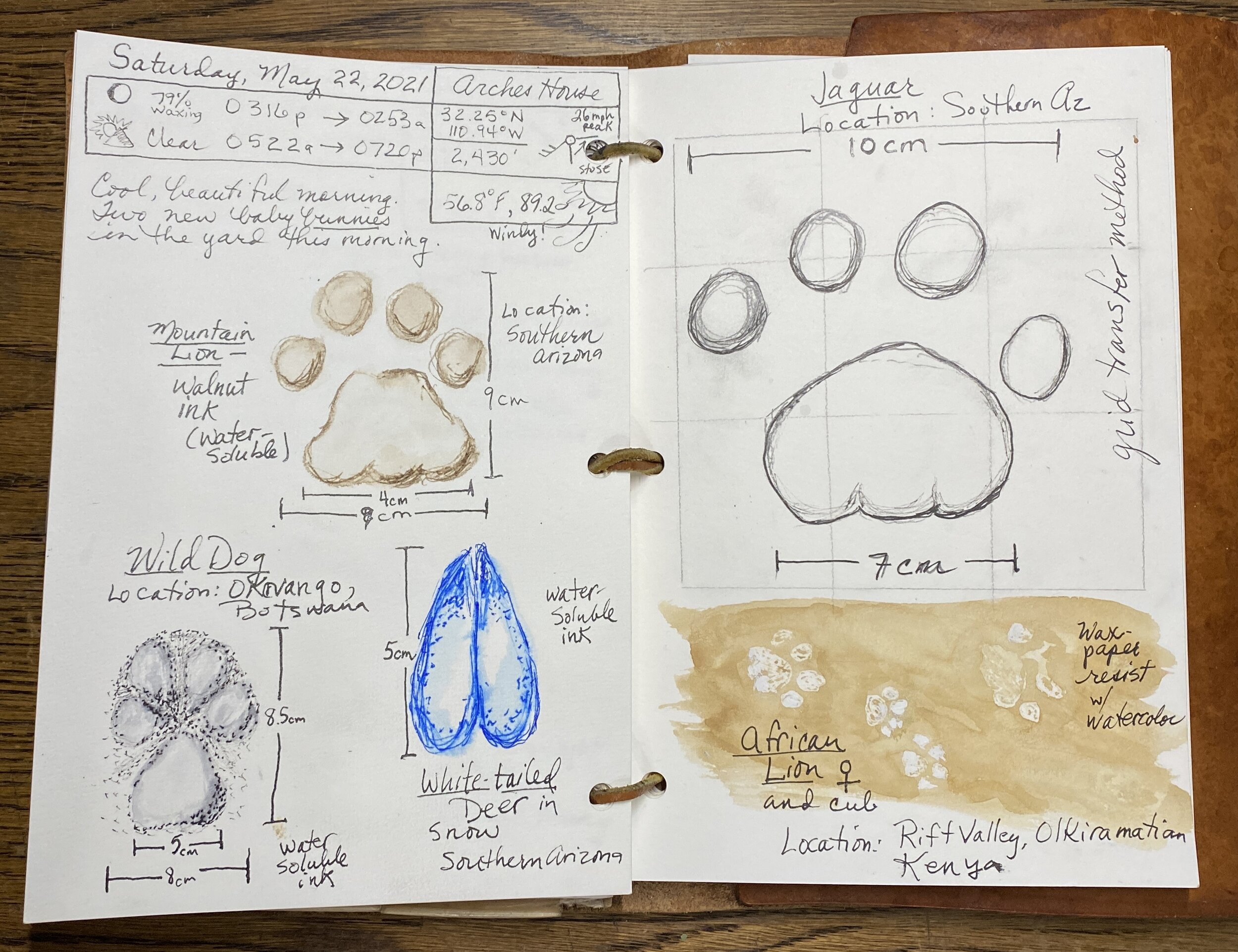
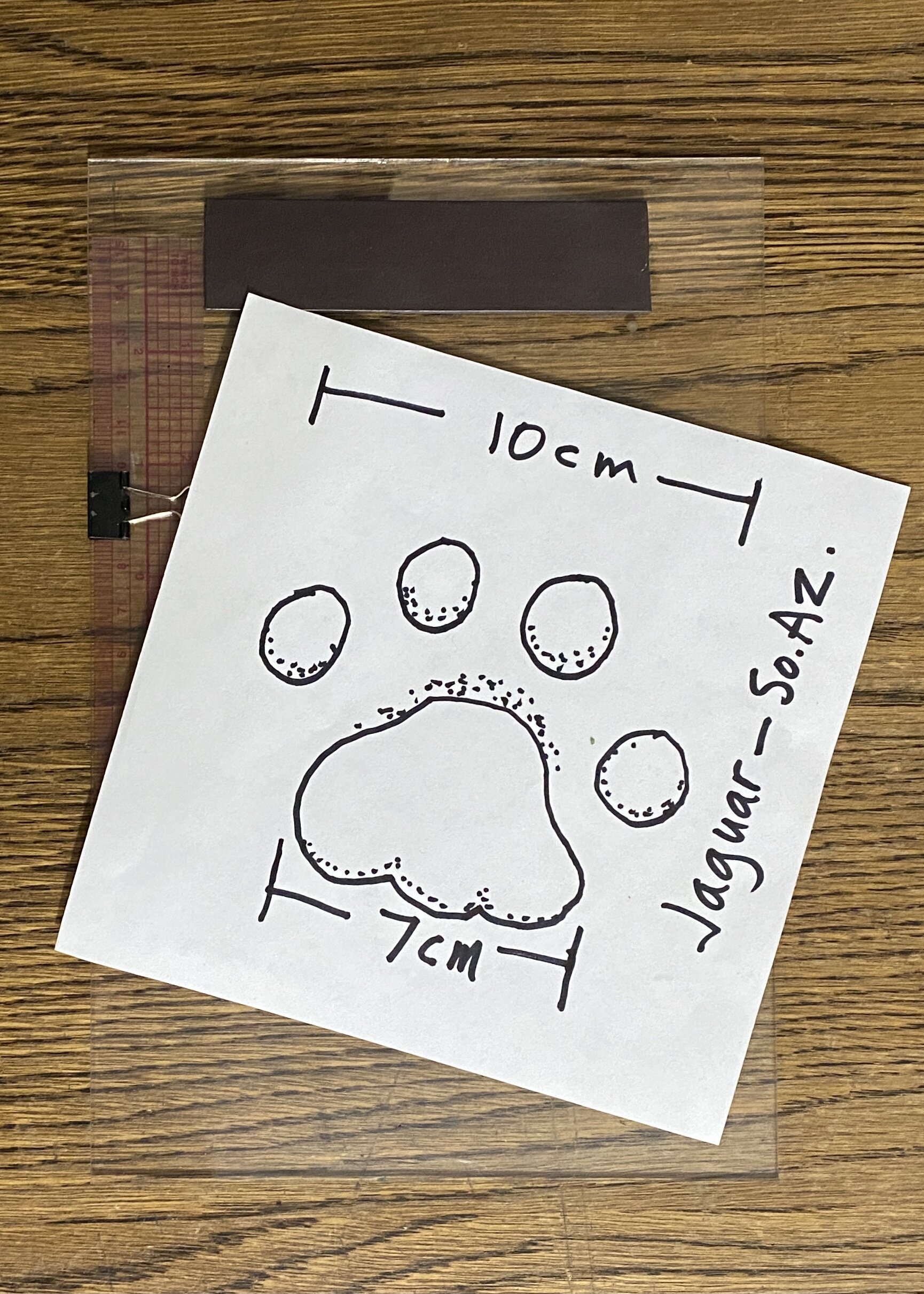
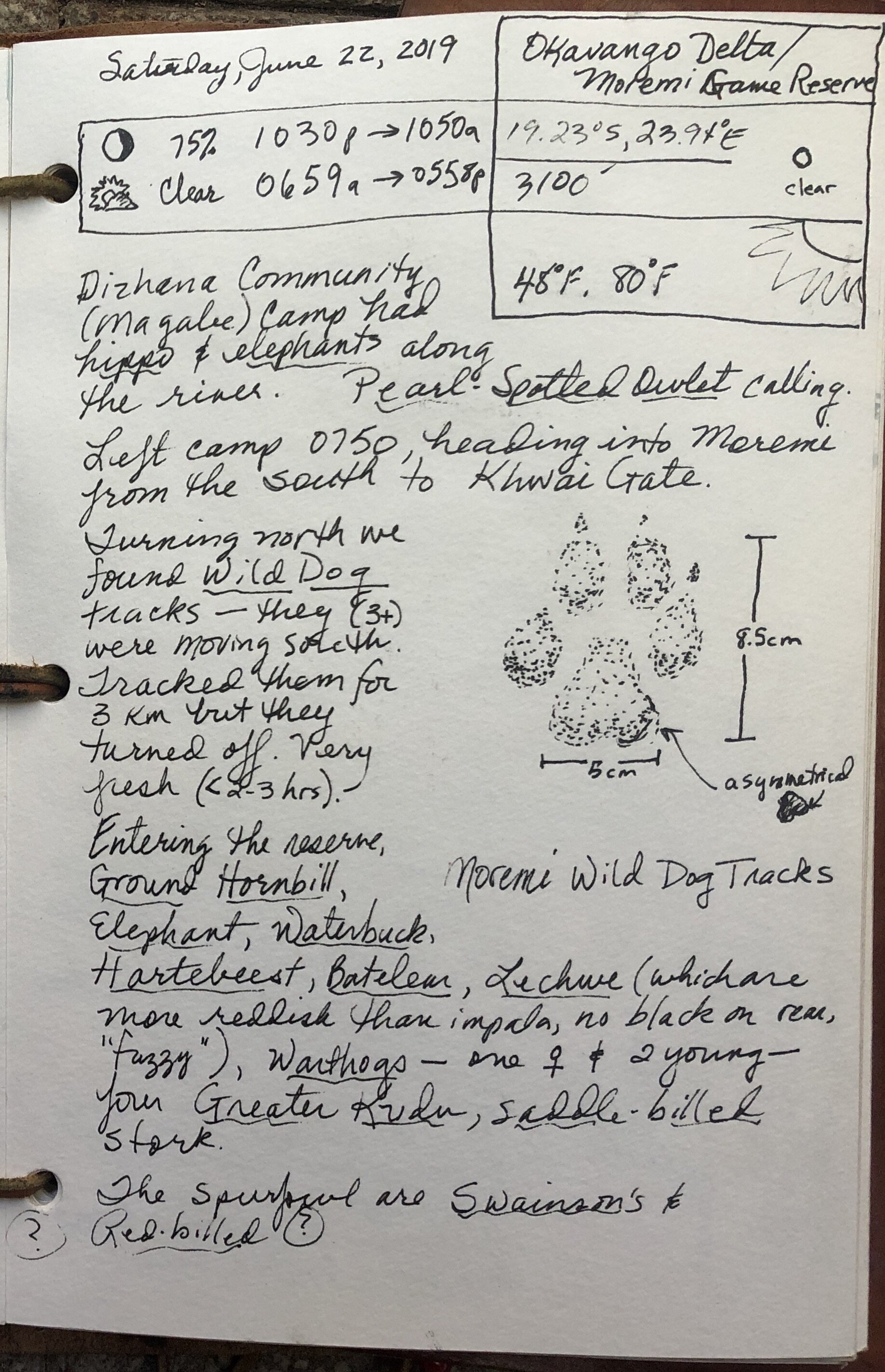
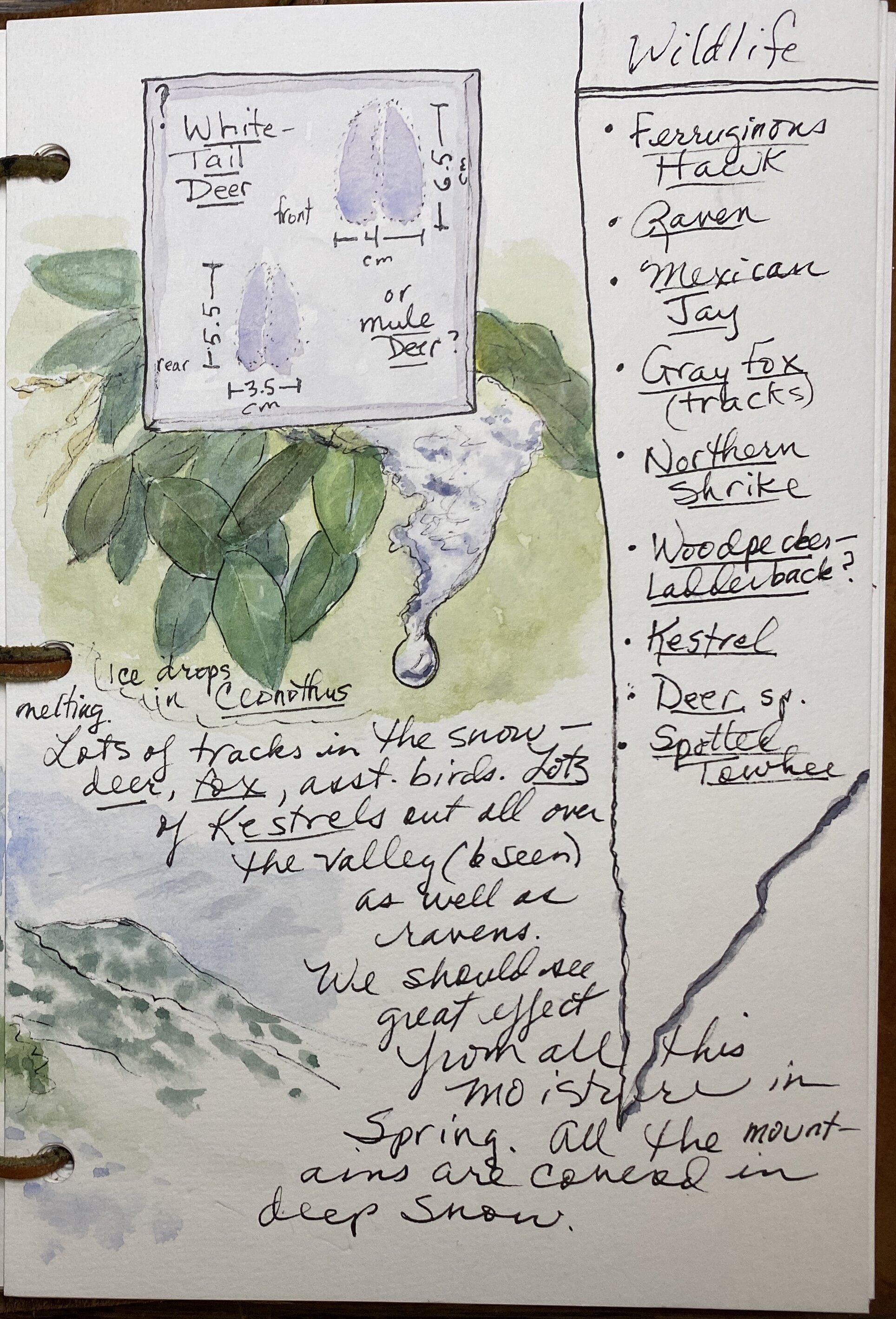
You can find my list of minimalist colors and tips on color mixing here: https://www.exploringoverland.com/field-arts-tutorials-list/2020/7/5/minimalist-watercolor-for-nature-journaling
ROSEANN’S DEMO IMAGES FROM THE WORKSHOP:
Mountain lion track (southern Arizona).
Wild Dog tracks (Botswana, Okavango Delta).
Mountain lion tracks (southern Arizona).
Field Arts Workshop: Cartography 101 for Field Notebooks
Let’s explore cartography for your nature journals and field sketchbooks. Adding maps is fun and although they can be challenging and even intimidating, they will greatly enhance not only your journals but your understanding of a place.
Traditional maps with features such as contours and shading to show relief
Linear maps that unfold or scroll from point-to-point on an exploration of a place or region
Picture-highlight maps of a place, including non-scale ideas for quick mapping
Behavior maps depicting such things as an animal foraging or defending a territory
Length: 2 hours
Resources from the Workshop
Google Interactive View of the Northern Ranges, Yellowstone:
Downloads (Cartographic Elements and Features):
JPG of cartographic elements and features (printable for your journals):
PDF of cartographic elements and features (larger format):
Video of Yellowstone Northern Ranges:
https://www.nps.gov/media/video/view.htm%3Fid%3D17806168-1DD8-B71B-0BE946127DB84B95
METADATA AND NATURE DATA for MAPPING LOCATION:
Location: Confluence of Yellowstone River and Lamar River, “Yell-Mar,” in the Northern Ranges
Latitude: 44 degrees 55’ 13” N
Longitude: 110 degrees 22’ 04” W
Elevation: 1849 meters (6066 feet)
Low:36 degrees F
High: 55 degrees F
Sunrise: 1135 am
Sunset: 0937 pm
Moon phase: 73% waning
ROSEANN’S FIELD NOTES PAGES from THE WORKSHOP:
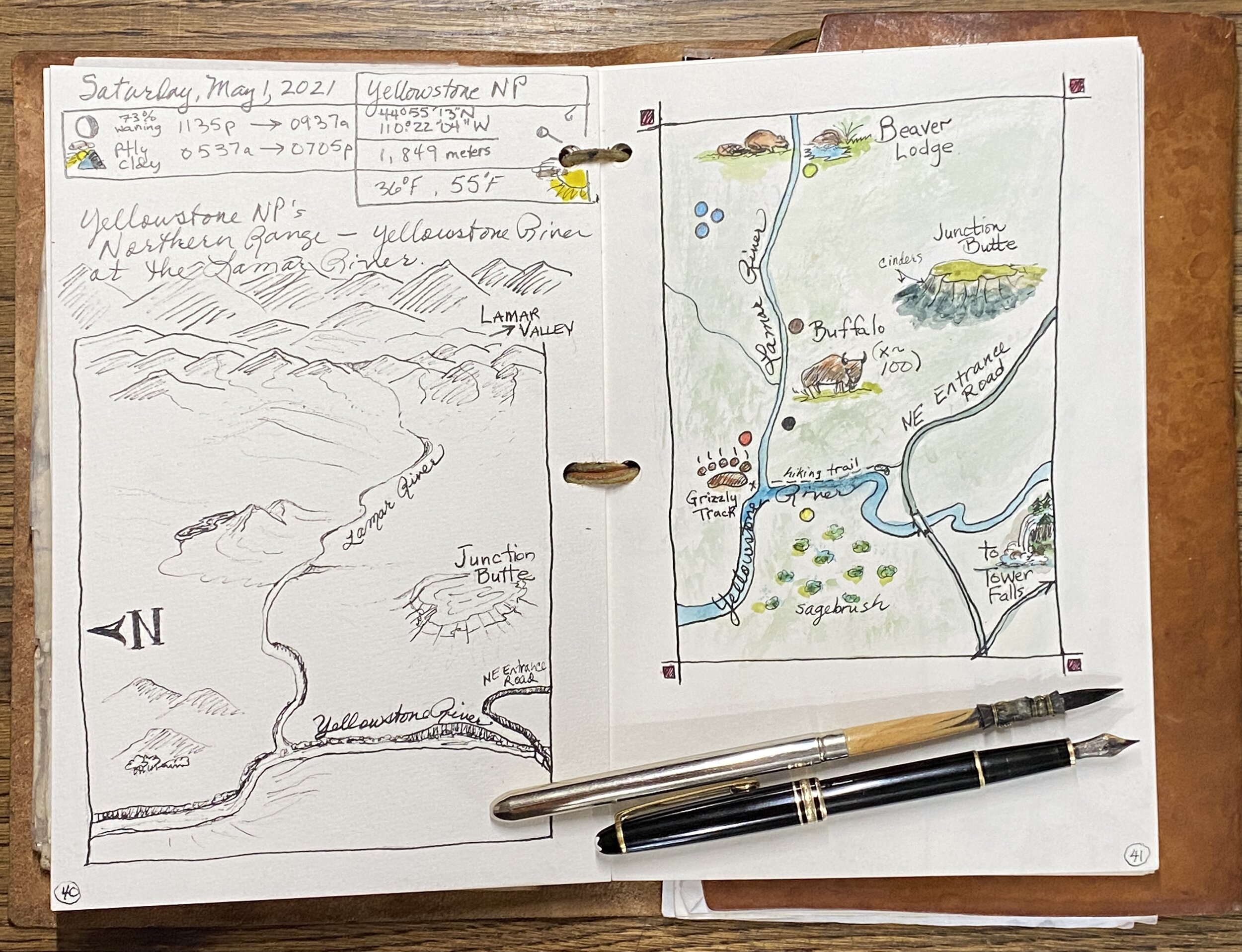
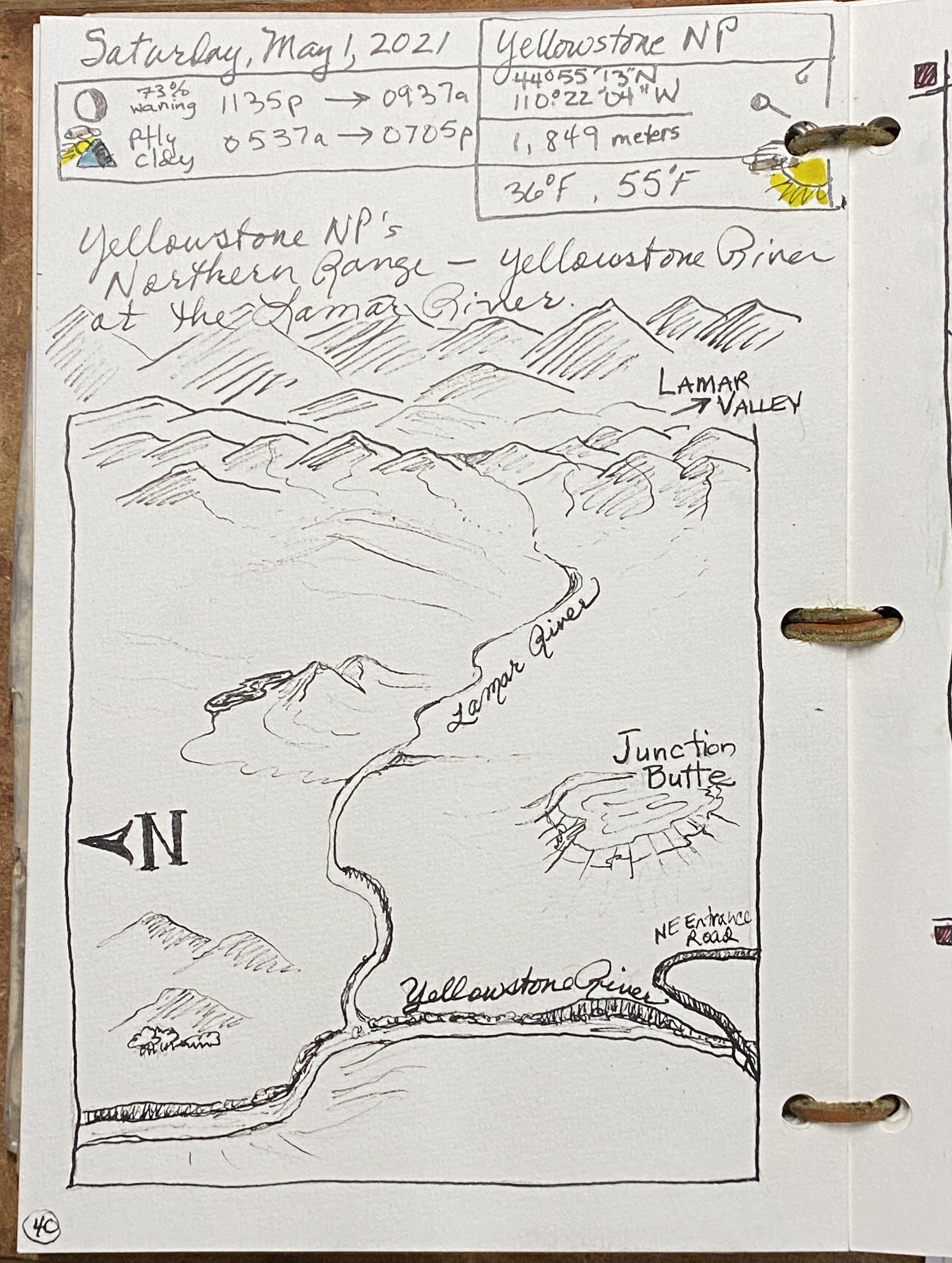
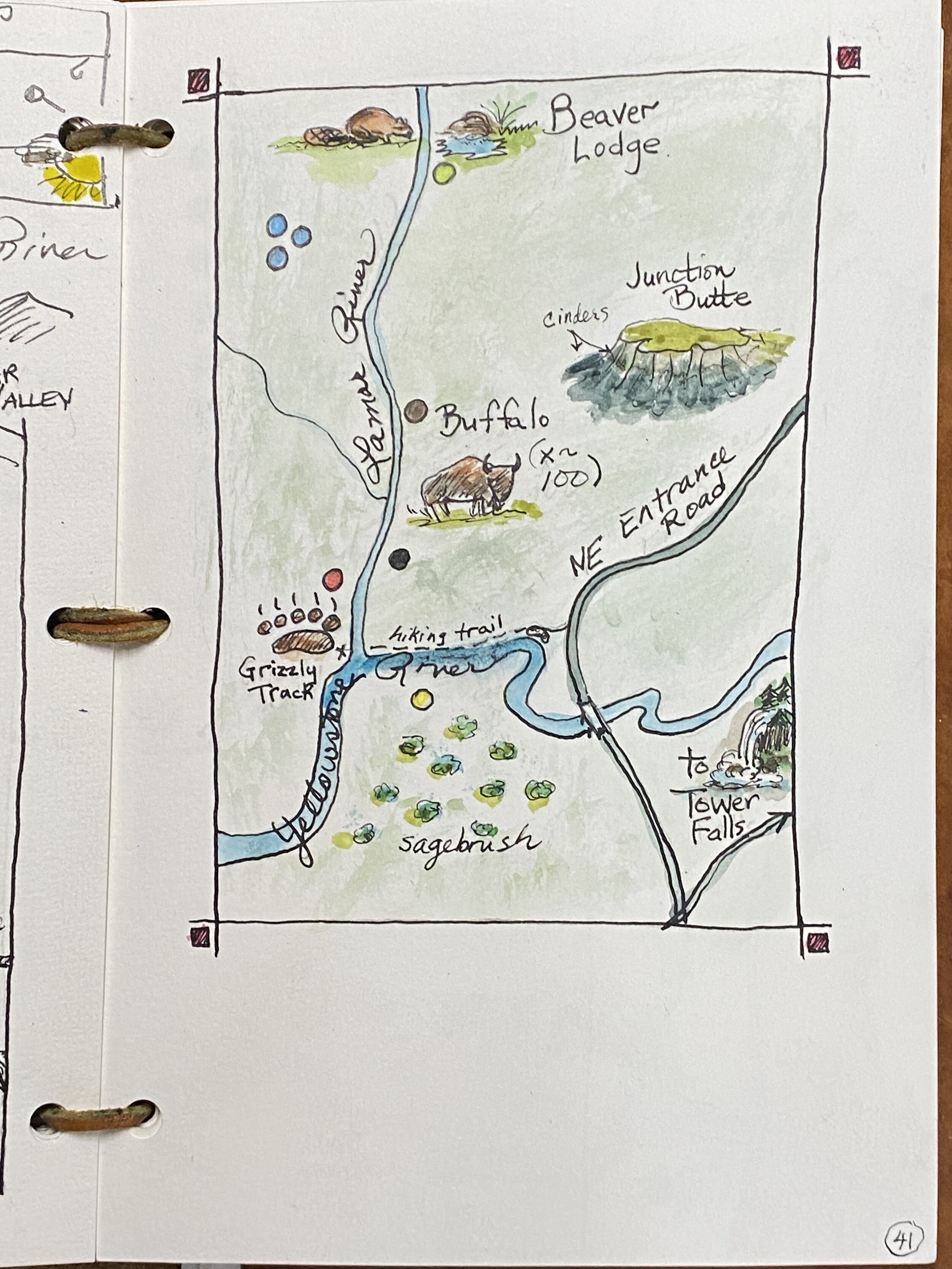
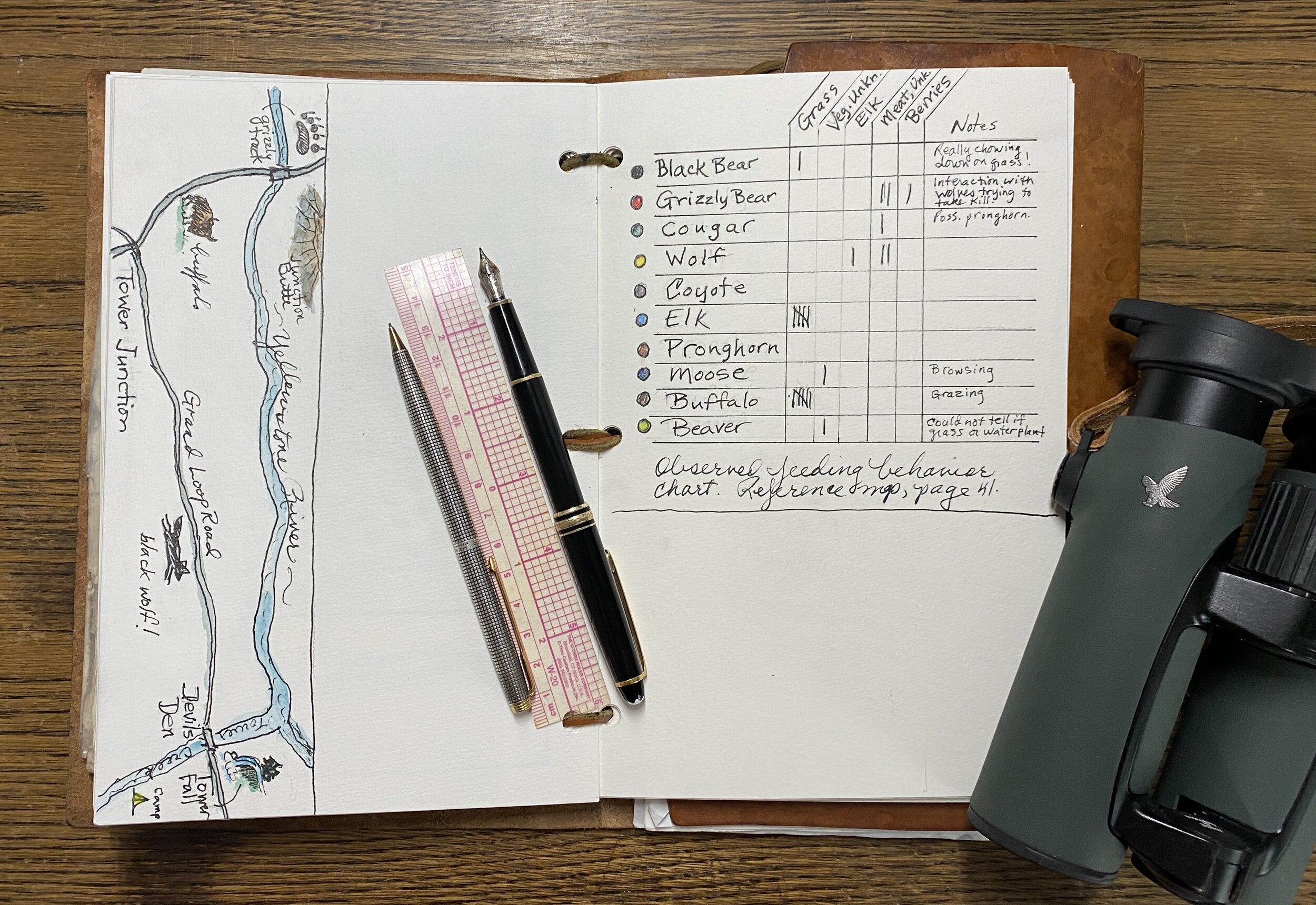
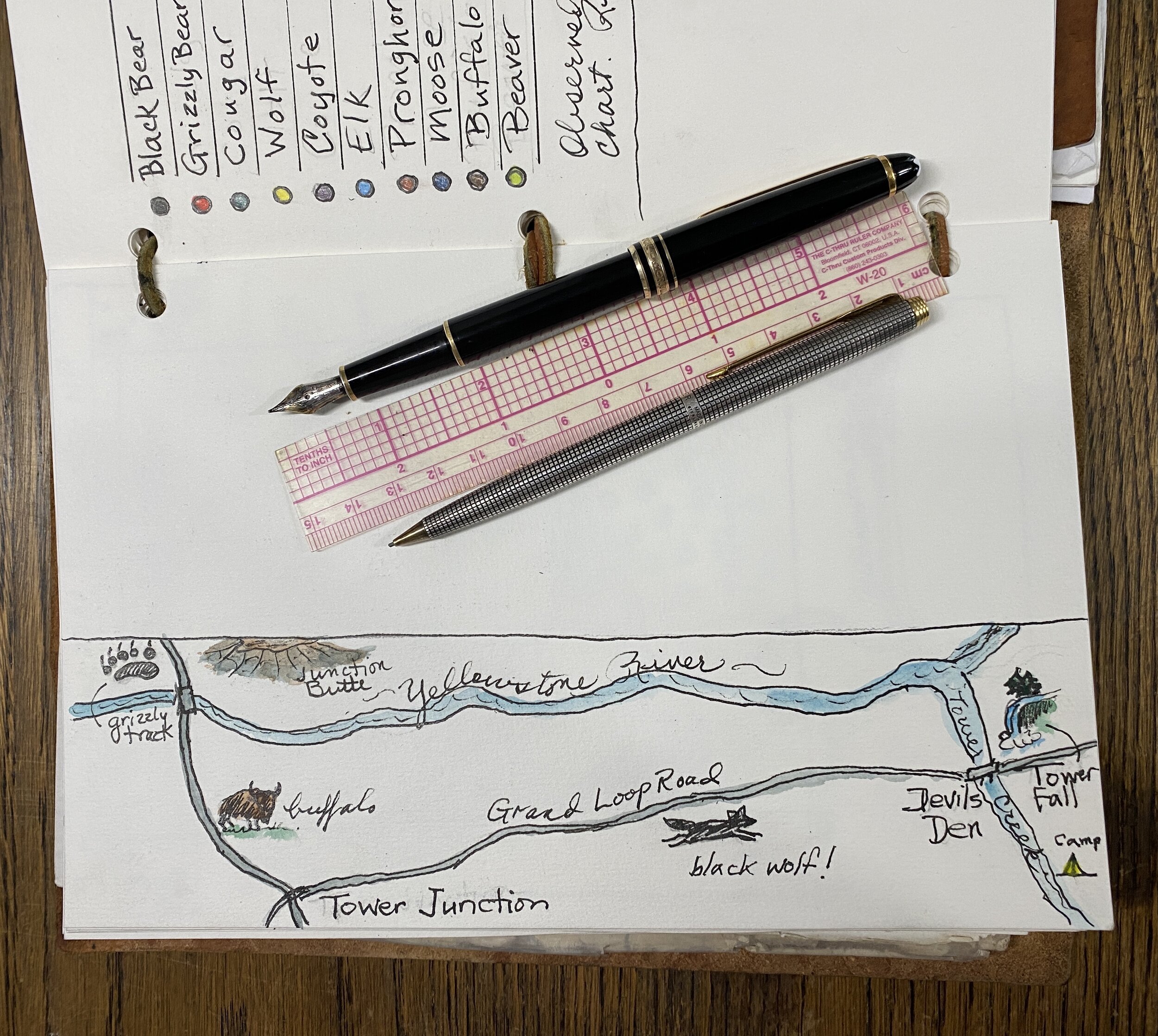
You can find my list of minimalist colors and tips on color mixing here: https://www.exploringoverland.com/field-arts-tutorials-list/2020/7/5/minimalist-watercolor-for-nature-journaling

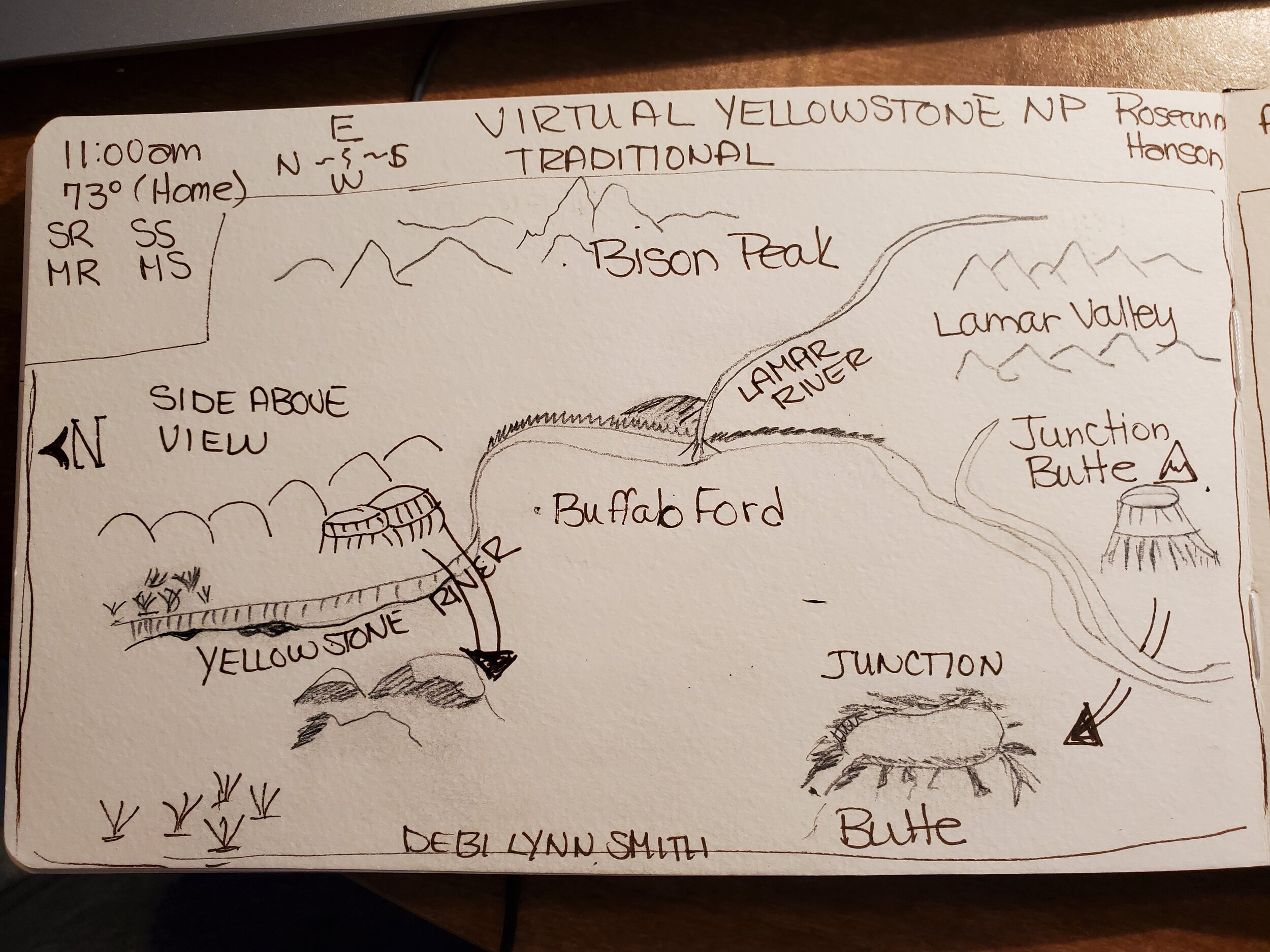
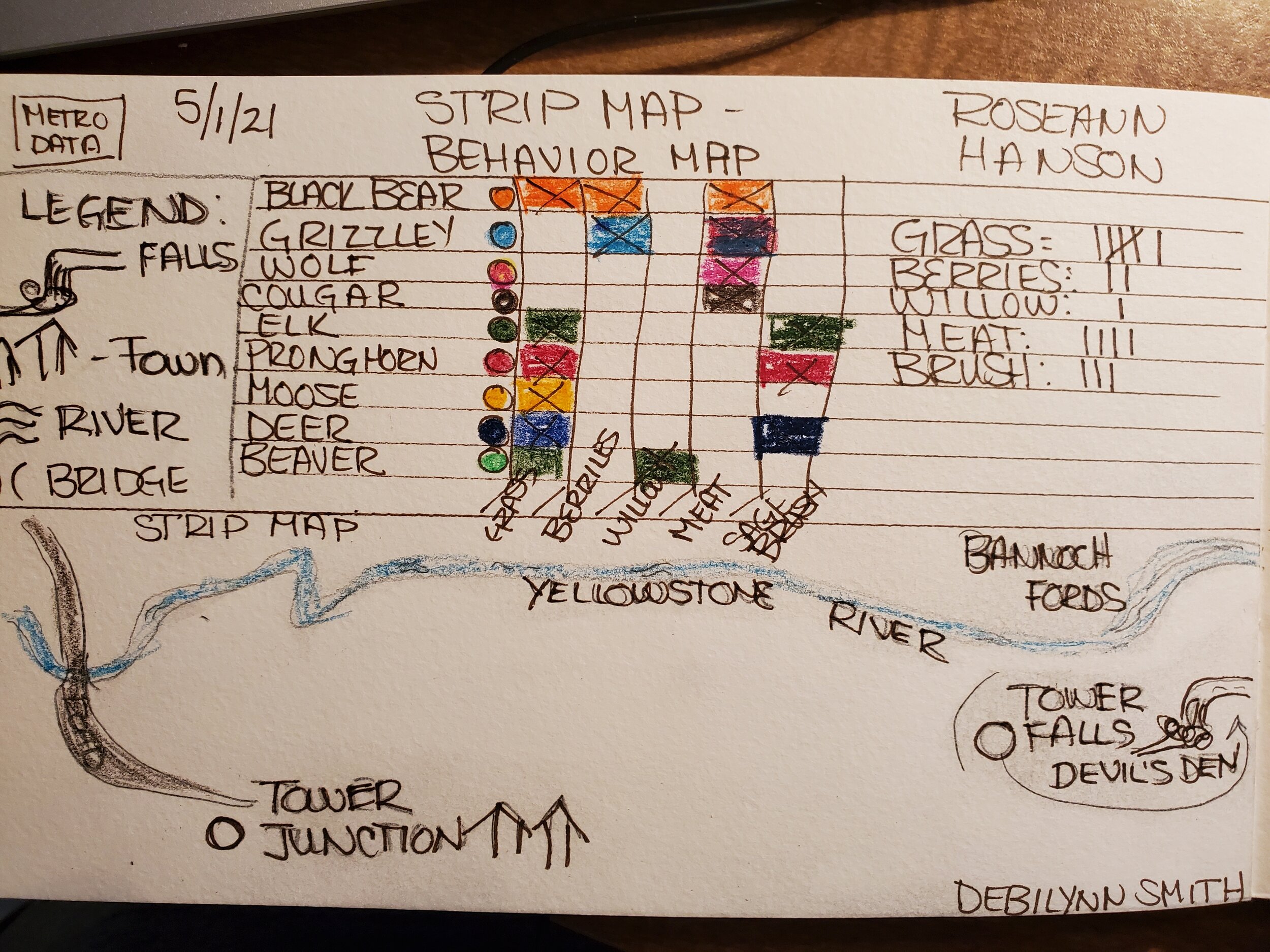
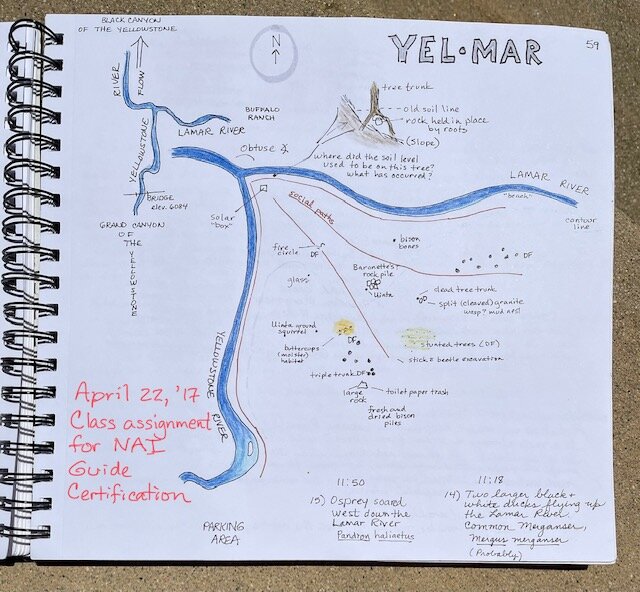
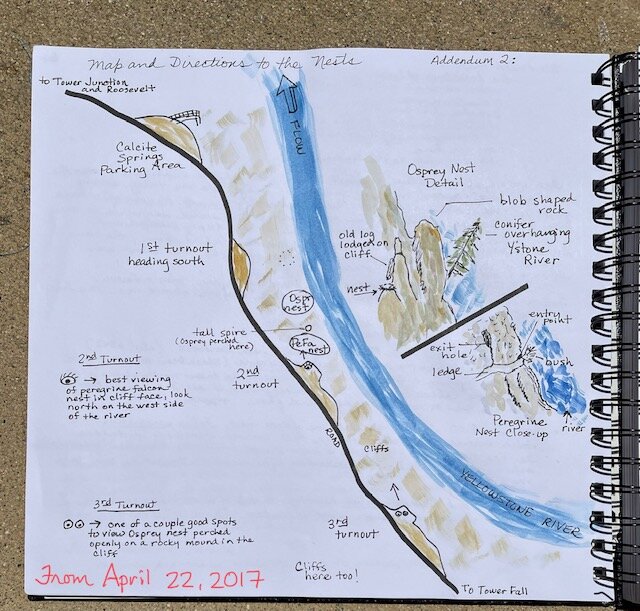

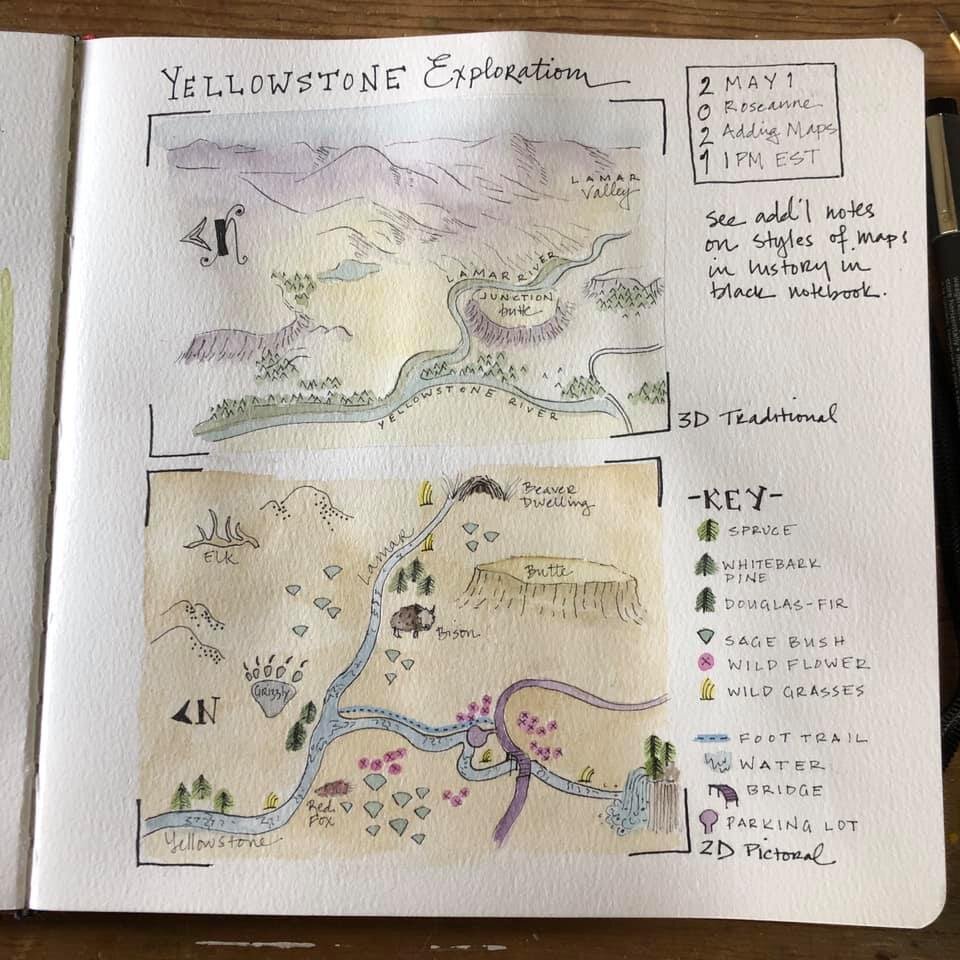
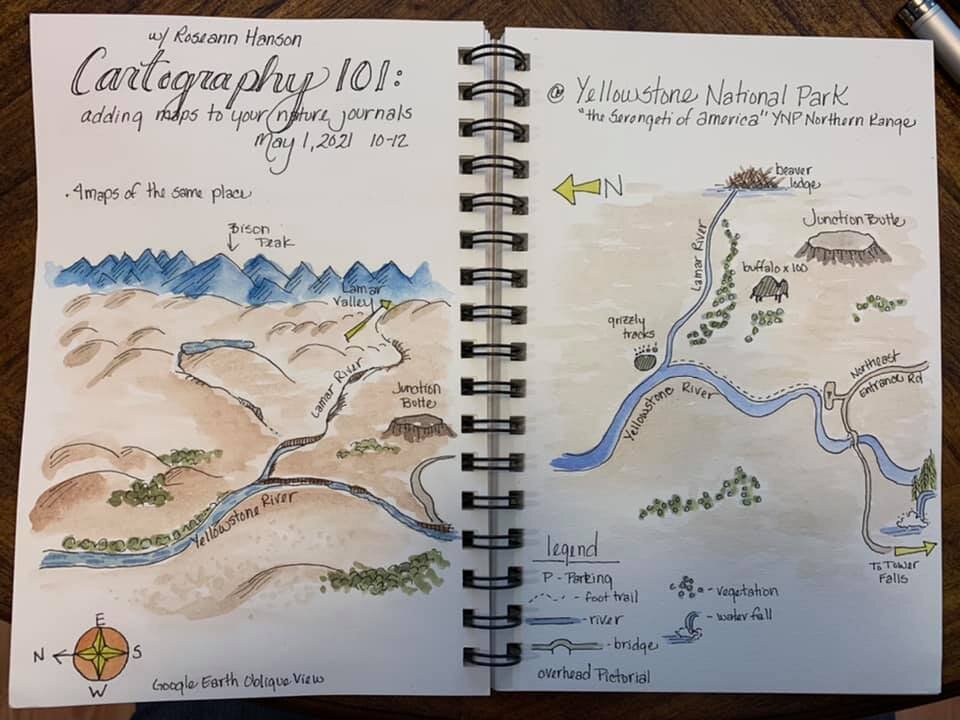
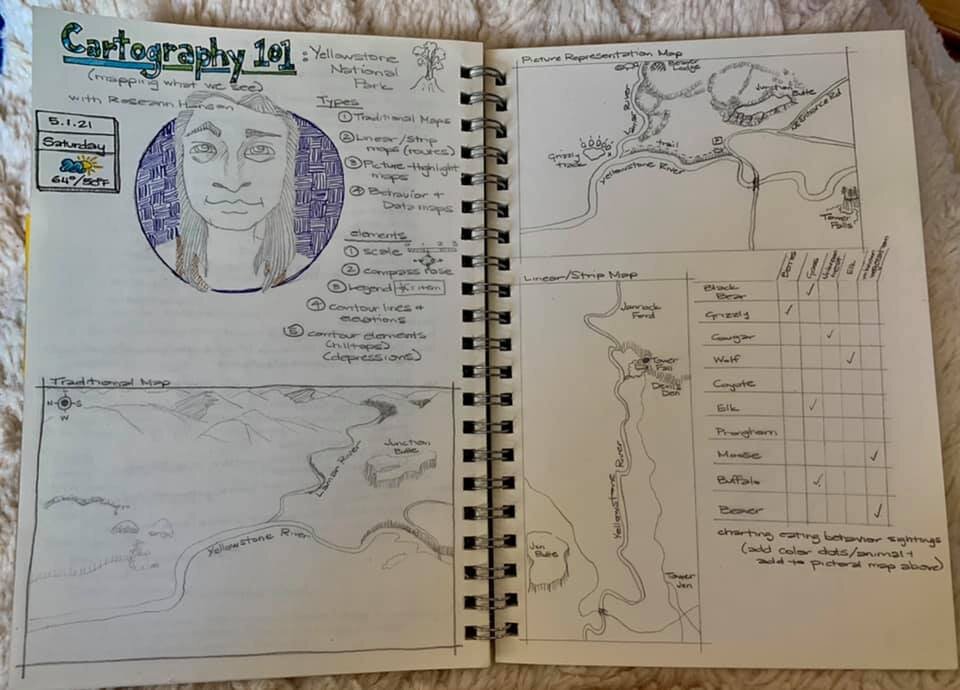
1. Traditional Map - original view
2. Pictorial Map - original view
3. Linear or Strip Map - original view
4. Behavior Map - original view
Virtual Field Trip: Let's Explore Mars!
Join me on a truly out of this world virtual field trip sketching the Martian landscape!
Let’s see how many different reds we can use to depict the Red Planet as we explore the astrobiology of Mars aboard the Mars Curiosity and Perseverance Rovers. We’ll also dive into the natural history of the dunes and weather, and learn about space travel . . . all from the comfort of your Earth studio!
Sketch along or just observe, I’ll narrate as I go to demonstrate why I choose to focus on what subjects and how to quickly capture them in your field notebooks and nature journals.
Length: 1.5 hours (although it might go a little over)
Resources from the Workshop
Google Mars Interactive View:
https://www.google.com/maps/space/mars/@0,-110.9387418,22963938m/data=!3m1!1e3
NASA Mars Science:
Astrobiology:
METADATA AND NATURE DATA for MARS:
Location: Gale Crater
Latitude: -4.521663 degrees S
Longitude: 137.38952 degrees W
Elevation: -4,501 meters (-2.8 miles)
Low: -105 degrees F
High: 9 degrees F
Sunrise: 0530 am
Sunset: 0630 pm
Two moons:
Phobos (largest moon) has a transit of 66 hours
Deimos has a transit of 10 hours
ROSEANN’S FIELD NOTES PAGES from THE WORKSHOP:
You can find my list of minimalist colors and tips on color mixing here: https://www.exploringoverland.com/field-arts-tutorials-list/2020/7/5/minimalist-watercolor-for-nature-journaling
participants’ field notes pages:
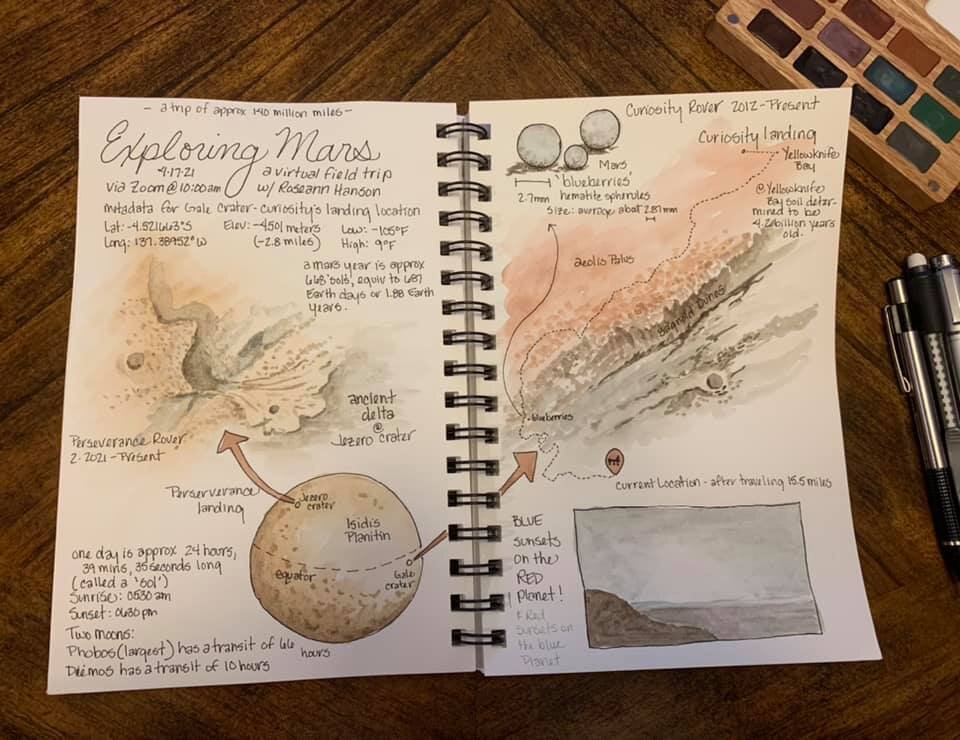
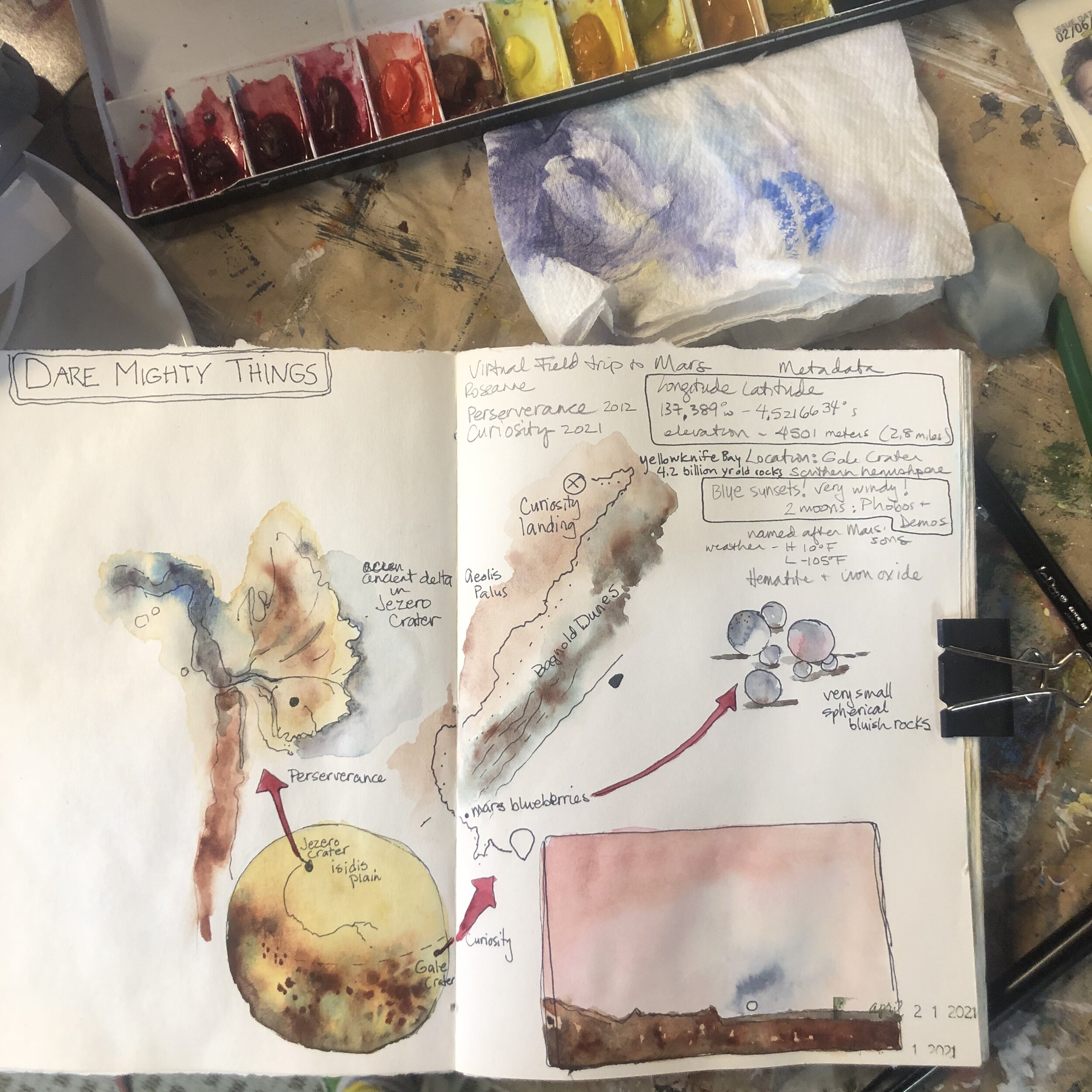
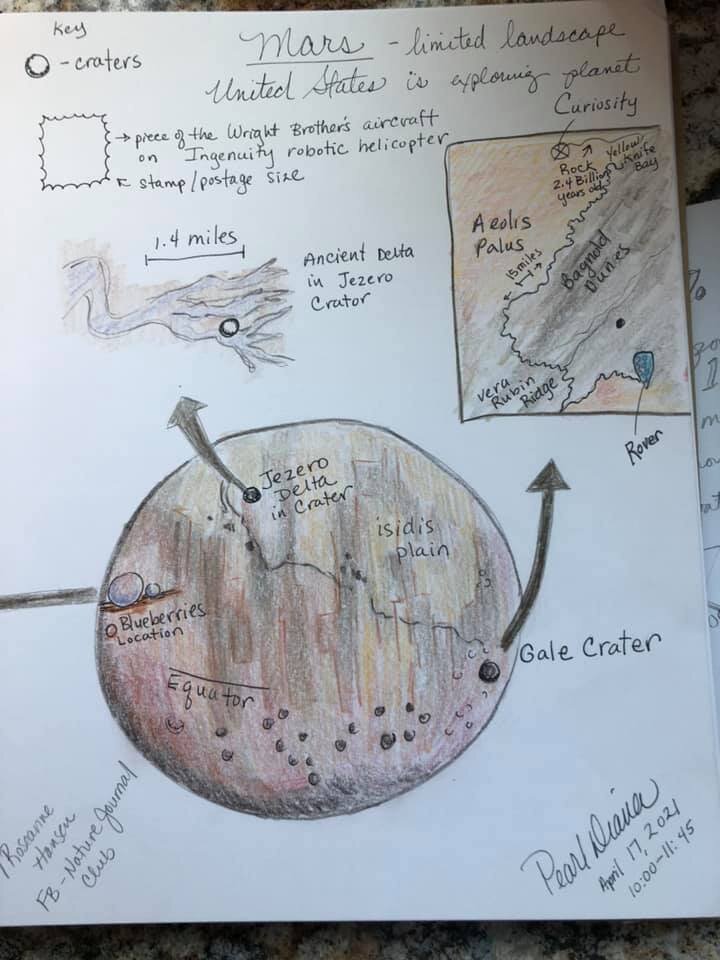
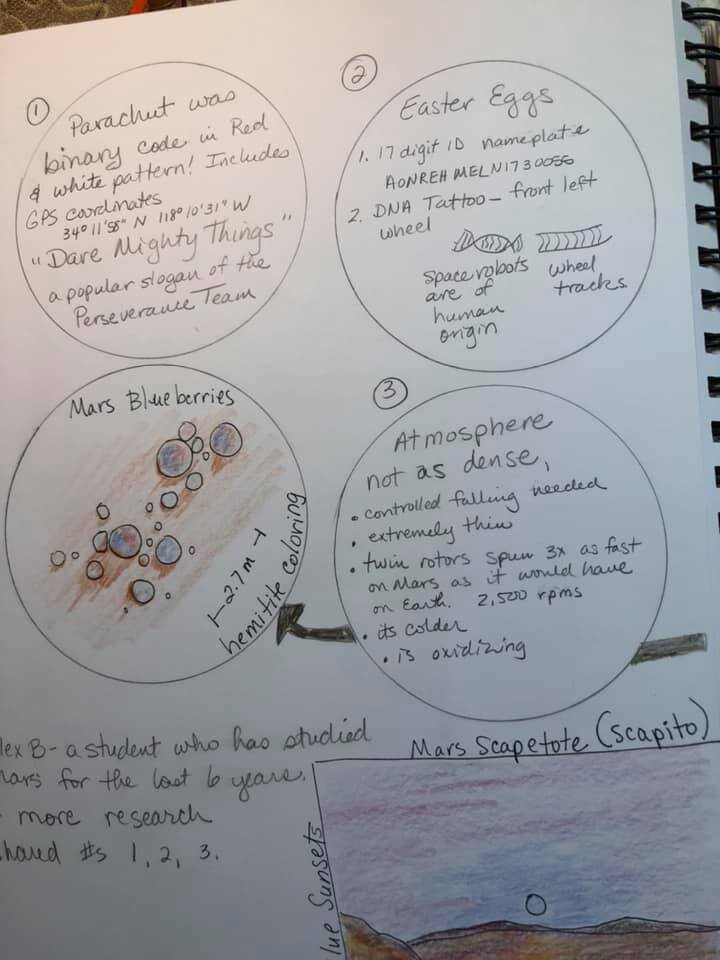
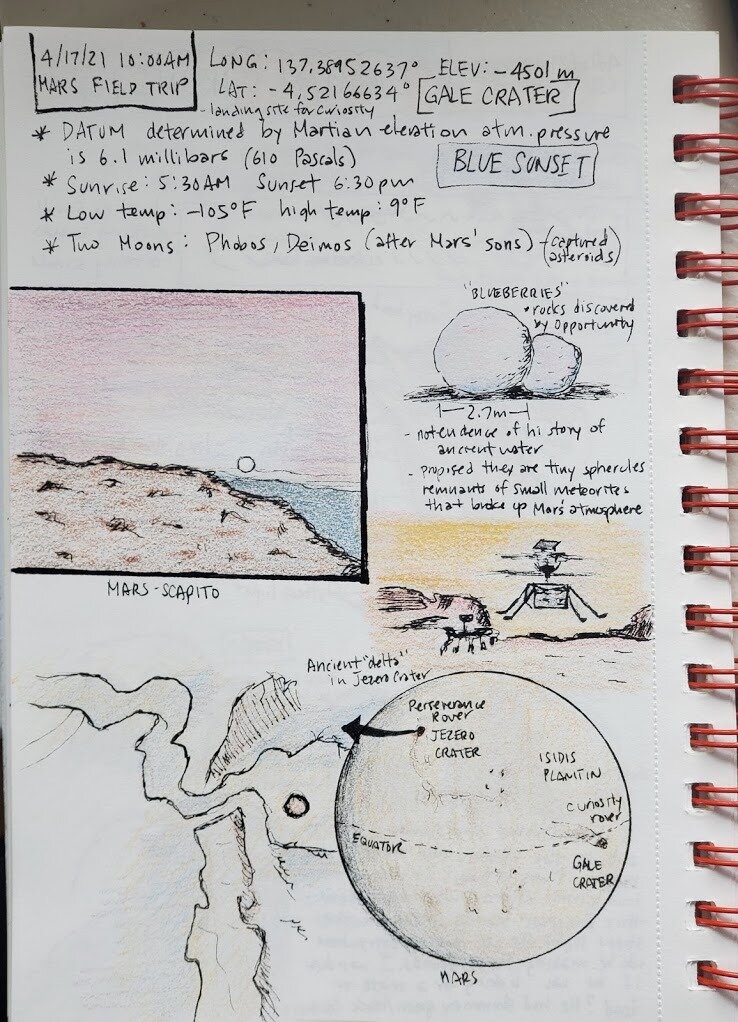
Curiosity landing site in Gale Crater; path of the rover as of today.
Jezero Crater; Perseverance landing site.
Blue sunset.
Mars “blueberries,” average 2.7 mm in diameter.
DARE MIGHTY THINGS
The Perseverance parachute design contains binary code with two messages: “Dare Mighty Things” —the motto of the mission — and the JPL address in Pasadena.
Far better is it to dare mighty things,
to win glorious triumphs,
even though checkered by failure . . .
than to rank with those poor spirits
who neither enjoy nor suffer much,
because they live in a gray twilight that
knows not history nor defeat.
– Theodore Roosevelt
Field Arts Workshop: Optics 101, Choosing and using binoculars and scopes
Field optics are vital tools for naturalists and explorers. But the range of options can be confusing:
Porro or roof prism?
Best magnification / lens diameter combo?
Close focus?
Field of view?
Waterproof?
What is meant by BaK4 glass? Flat field? Multi-coating?
Jonathan and Roseann have been using field optics professionally for over 35 years—and were early fans of Swarovski Optik: Jonathan used an early pair of 10x50 Habichts in his sea kayaking business in the 1990s. They will walk you through all the elements of what makes a quality pair of binoculars or spotting scope, and what is worth paying for—or not. Using Swarovski, Leica, and a few other brands as examples, they will also make recommendations based on workshop attendees’ field uses (we’ll send you a questionnaire before the workshop).
This workshop is suitable for anyone who uses or is considering buying field optics: naturalists, travelers, explorers, birdwatchers, and hunters.
An interactive Q & A session will be included, with Ben Lizdas of Swarovski Optik.
When: Saturday, March 13, 2021
Length: 1.5 hours
SPECIAL DEAL: Note that for a limited time (March 13 – 28), 7P Overland will be offering select Swarovski optics in their shop with a special Exploring Overland deal: free shipping and a free cleaning kit. https://7p.io/product-category/expedition-optics/
Introduction to Nature Journaling for a Wild Life - Tucson Festival of Books
Join me for a 38 minute talk where I introduce my book, Nature Journaling for a Wild Life, its features, and show pages from my journal, and then do a demo in my own journal of how I set up and add sketches and watercolor to my pages.
Nature Journaler Best Practices – Check-in for beginners (or anyone)
The hardest part of nature journaling isn’t the sketching and painting—it’s maintaining your practice.
If you are new to nature journaling, or struggling with an ongoing practice, join us for a check-in session to share our experiences and frustrations making nature journaling a regular part of our lives.
The aim of this 90-minute session will be to talk about success or struggles, and our community will help find solutions and suggestions.
We had a lot of great sharing during this workshop with breakout sessions.
Zoom does not support recording individual breakouts, but we were able to record one, and our leaders give synopses of the other two.
Some of the main takeaways and suggestions we have:
Give yourself permission to shape your practice to what works for you.
Be kind to yourself and to your output.
The most important thing to establishing a lasting practice is to make it a habit, and to do that you really do need to make frequent journal entries (at least when you are starting out; those of us who have been doing this for decades, it’s now a habit, so going a week or two without journaling is not going to end our practice).
If you are overwhelmed with journaling daily or even 3-4 times a week, make it a very simplified way of journaling: do a spread in your journal that represents a week, labeling it with the dates. Then, each day add one thing . . . a bird you saw (draw it if you want) or just describe in good notes . . . some phenomenon like leaves budding . . . the weather . . . any observation. You can do this in boxes (seven) or just anywhere on the page spread. By the end of the week you have a nice double-page spread, and your daily practice is supported, well on its way to habit!
Virtual Field Trip: Winter Wonderlands
Join me on a virtual field trip sketching winter wonderlands around the world! Experiment with different ways to represent snow and ice . . . from the comfort of your warm studio!
We’ll learn about wavelengths and why snow is white and glaciers are blue; explore using blue for shadows in show; practice winter “colorways;” how to represent animal tracks; and sketch some icicles.
Sketch along or just observe, I’ll narrate as I go to demonstrate why I choose to focus on what subjects and how to quickly capture them in your field notebooks and nature journals.
If you’re shy, don’t worry—we don’t require anyone to share their work and you can remain completely anonymous and worry-free!
Length: 2 hours
Resources from the Workshop
WHAT COLORS?
French Ultramarine Blue - granulating, makes lovely grays by mixing with Burnt Sienna. Also makes beautiful snow-shadow and sky colors.
In my mini triad palette Daniel Smith (CMY = cyan, magenta, yellow) plus two extras —
Manganese Blue Hue
Quinacridone Rose
Aureolin Yellow (Cobalt Yellow PY40)
Burnt Sienna
Indanthrone Blue
Other useful colors:
Readymade grays - Payne’s Gray or Jane’s Gray (which is French Ultramarine and Burnt Sienna already mixed).
Fun - Shadow Violet and Moonglow, are more purpley grays.
PRACTICING WINTER COLORWAYS WEBLINKS
Study in Blue, by Scott Kranz Photography:
https://www.scott-kranz.com/landscape-portfolio
Lake Solitude, Grand Tetons, Wyoming:
Kenai Fjords, Alaska:
CANELO HILLS VIRTUAL FIELD TRIP IN 360-DEGREE VIEW:
https://360exploring.s3-us-west-1.amazonaws.com/WinterWonderland/output/index.html
METADATA AND NATURE DATA for CANELO HILLS, SOUTHEASTERN ARIZONA, USA:
31.557 degrees N
110.55 degrees W
5,182 feet
Sunrise 7:12AM / Sunset 6:02PM
Moonrise 2:42AM / Moonset 1:12PM
High 65 / Low 37
Clouds: Altocumulus “mackerel” sky
Original pages by Roseann, completed onsite during the real field trip in January.
Virtual Field Trip Pages by Roseann
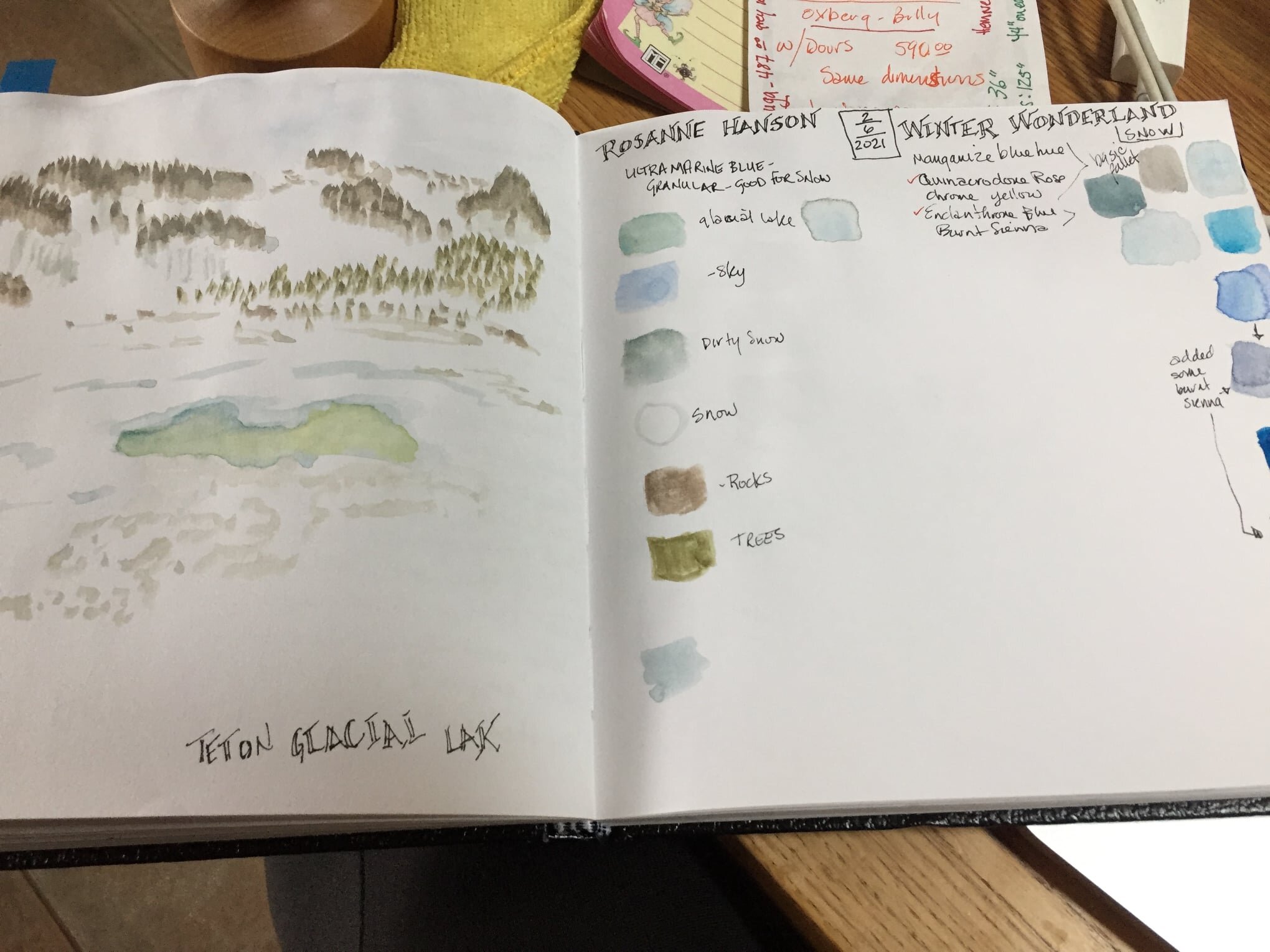
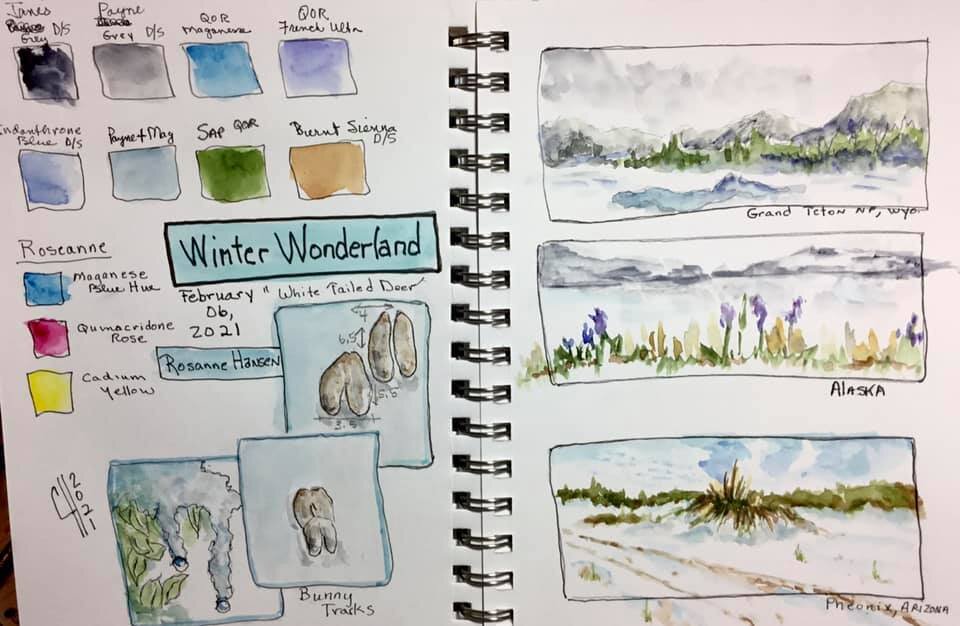
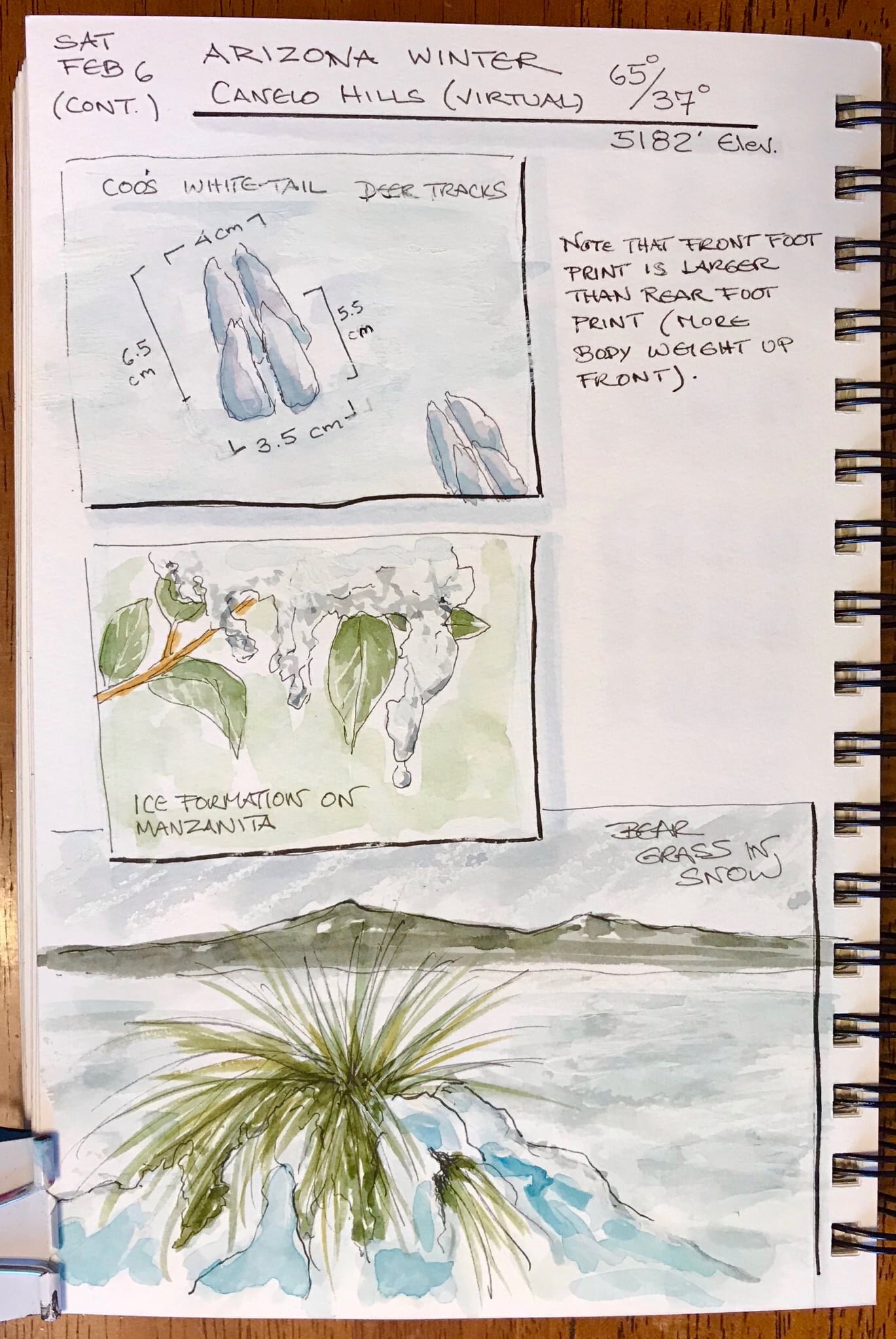

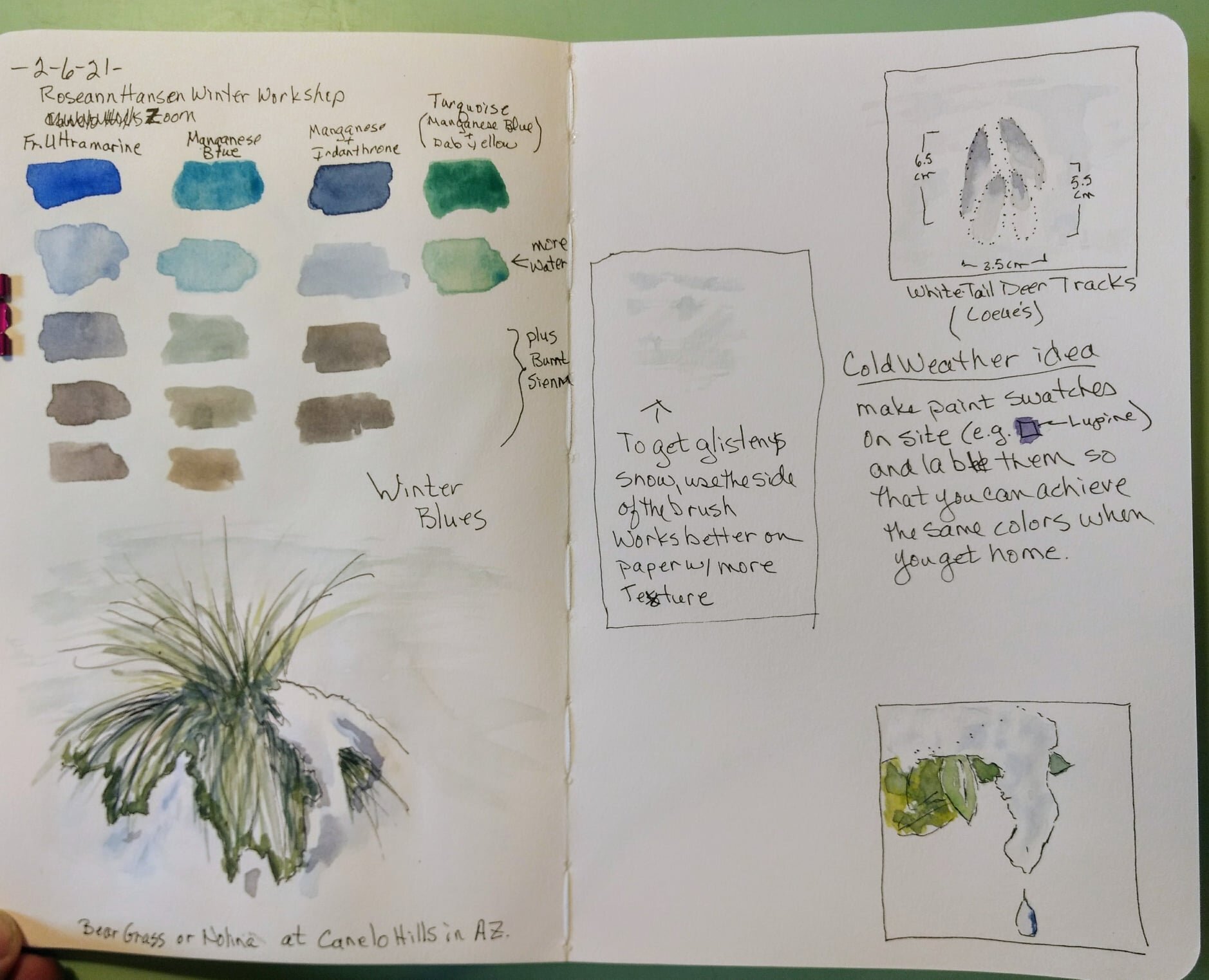
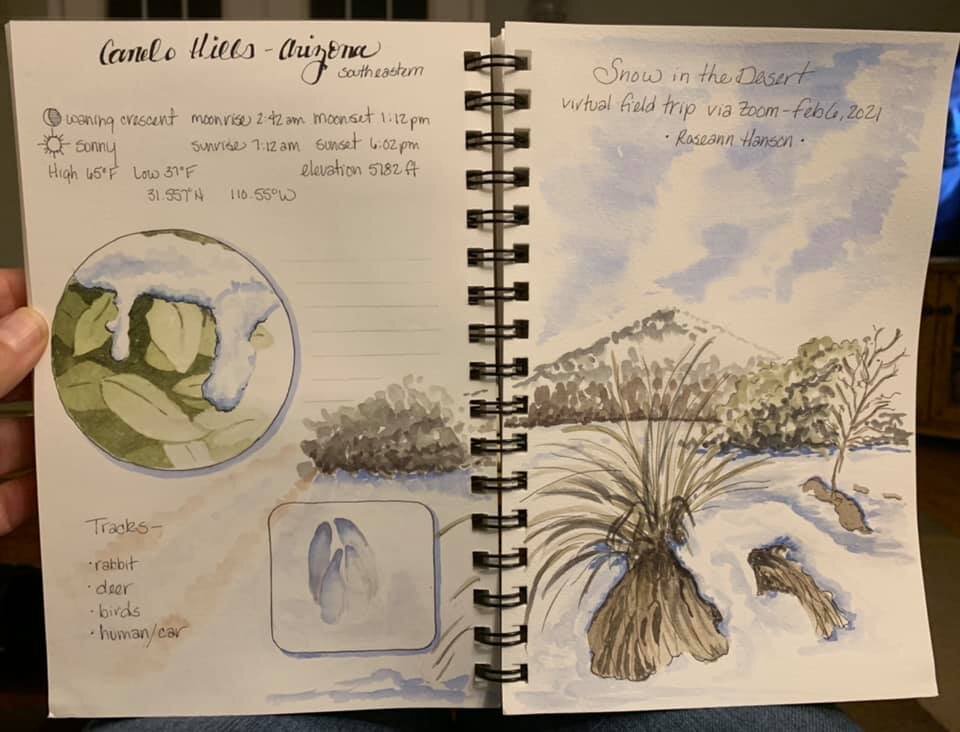
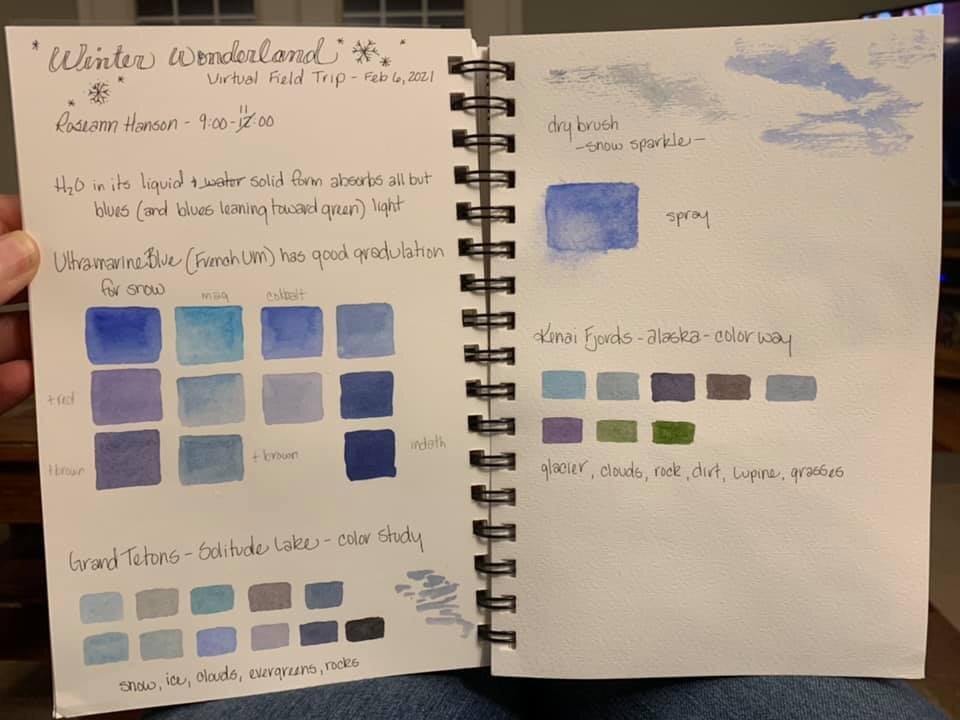
Support free tutorials! Click to contribute to the Tip Jar!
Using Grids: 3D cube landscapes and more
Join me for a free online workshop on how to draw “3-D” landscape cubes — in which you envision taking a giant cutter and pulling a cube out of a landscape, showing the sliced edges and details such as soil and creeks and roots (see here and here for examples). John Muir Laws details them in his wonderful book The Laws Guide to Nature Drawing and Journaling.
These are not easy to do— I struggled with these complex drawings “live” in the field. Where to place the cube, how to envision placing the elements correctly. I always drew mine from photos, then actually printed them and sketched the cube over the photo, or used Photoshop to put a cube over the digital photo.
But with a fun new tool ( the new clear Perspex Palette-Easel ) I will show you how to easily capture a very fun view of a landscape. Make your own (I’ll include instructions), or order one from my shop ($13 with a dry-erase marker or $12 without).
Length: 2 hours
Resources from the Workshop
IMAGE FOR PRACTICE DRAWING GRID LANDSCAPITO
IMAGE FOR PRACTICE-DRAWING CUBE LANDSCAPE
METADATA AND NATURE DATA for ROMERO POOLS, SANTA CATALINA MOUNTAINS, TUCSON, ARIZONA, USA:
32.414359 N, -110.872213 W
3713 feet elevation
Sunrise 0722 am
Sunset 0529 pm
Moonrise 0136 pm
Moonset 0258 am
Moonphase 75% illumination / waxing
High / Low temperatures - High 63/ Low 45 (degrees F)
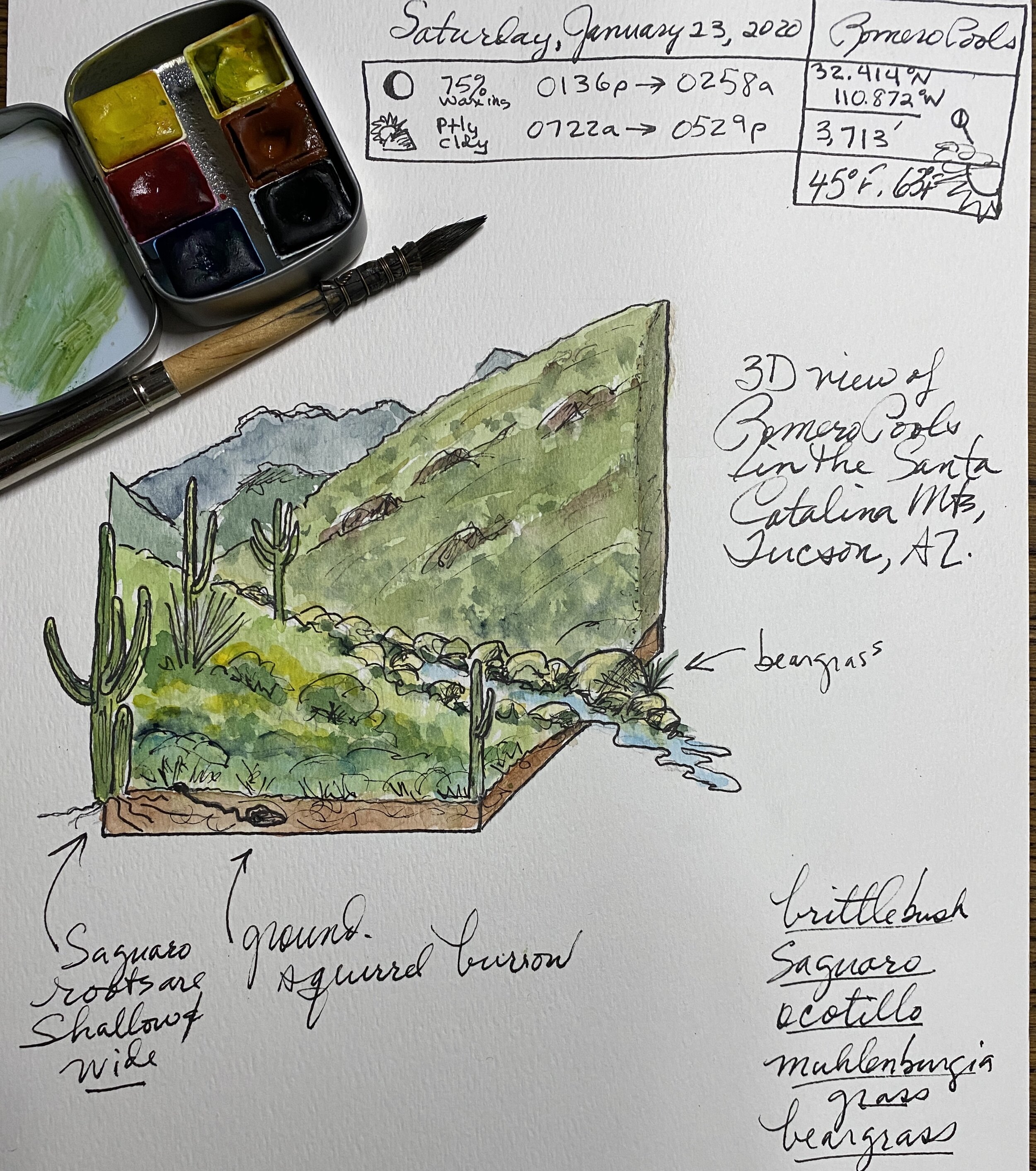

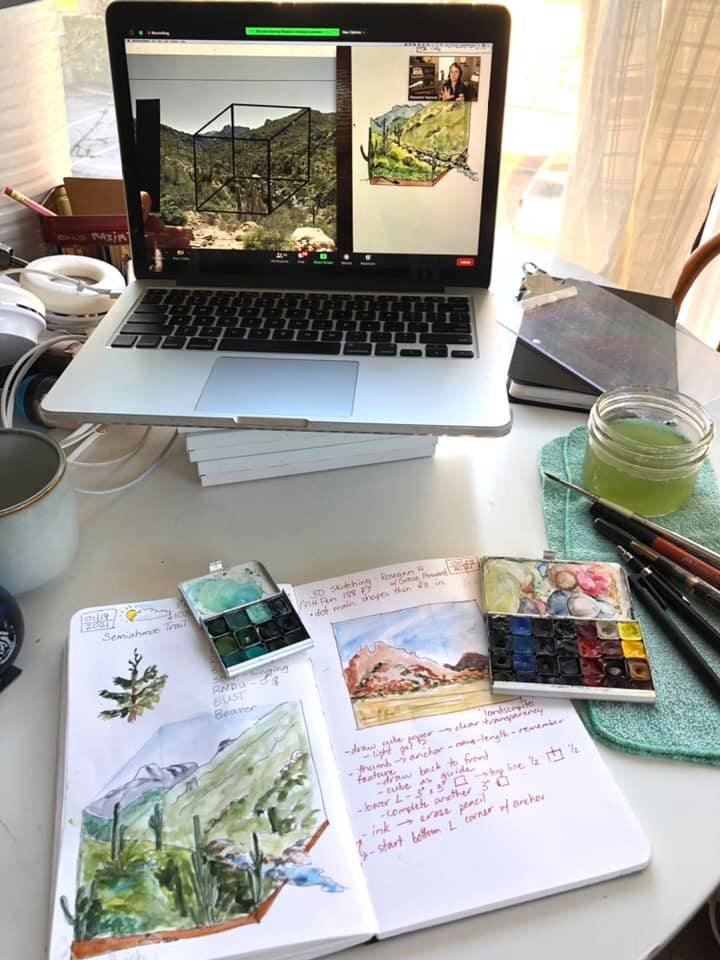
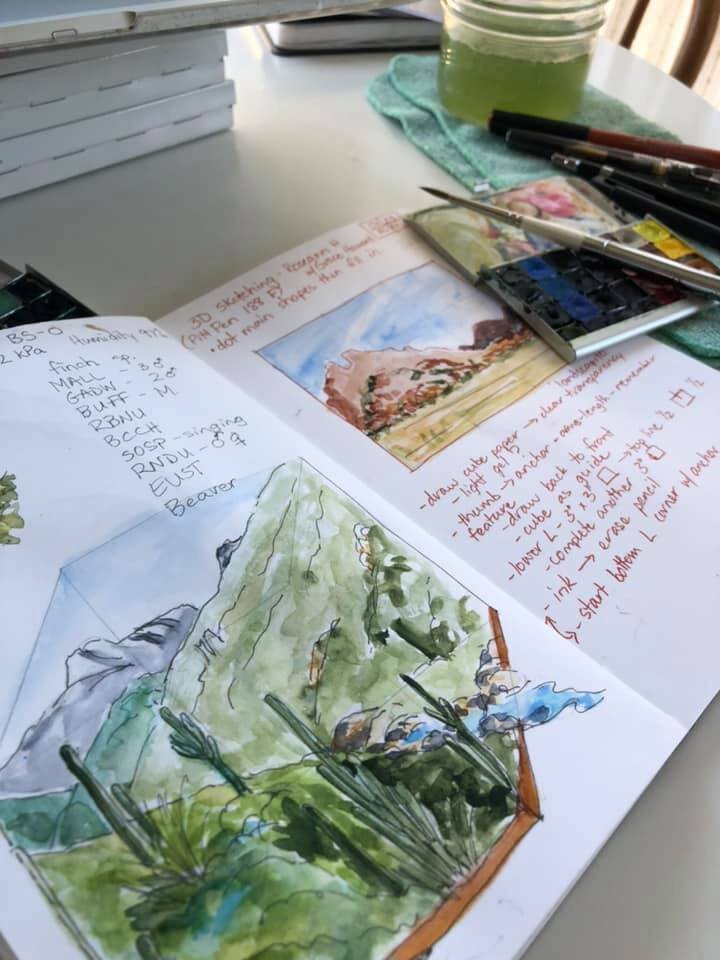
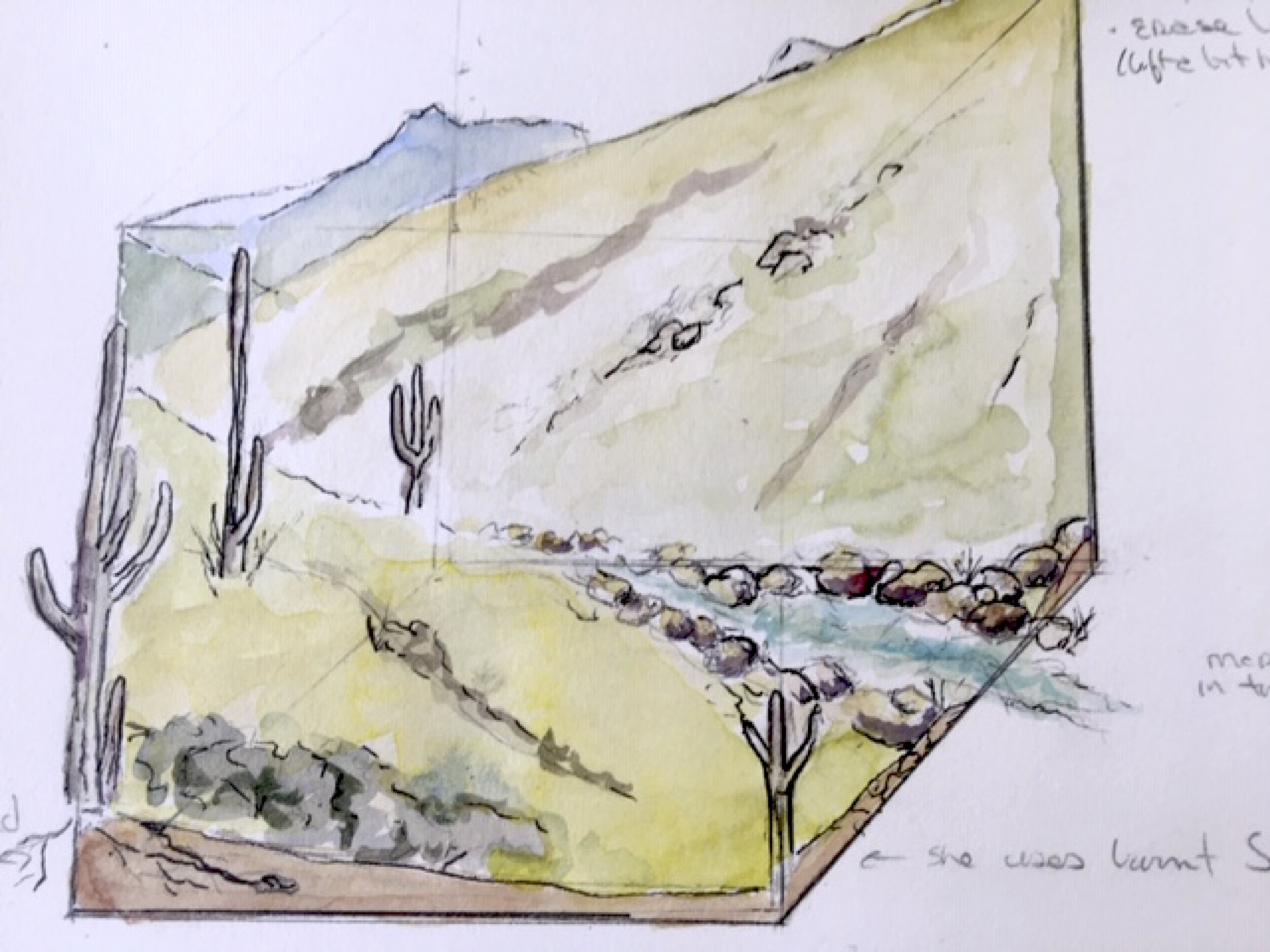
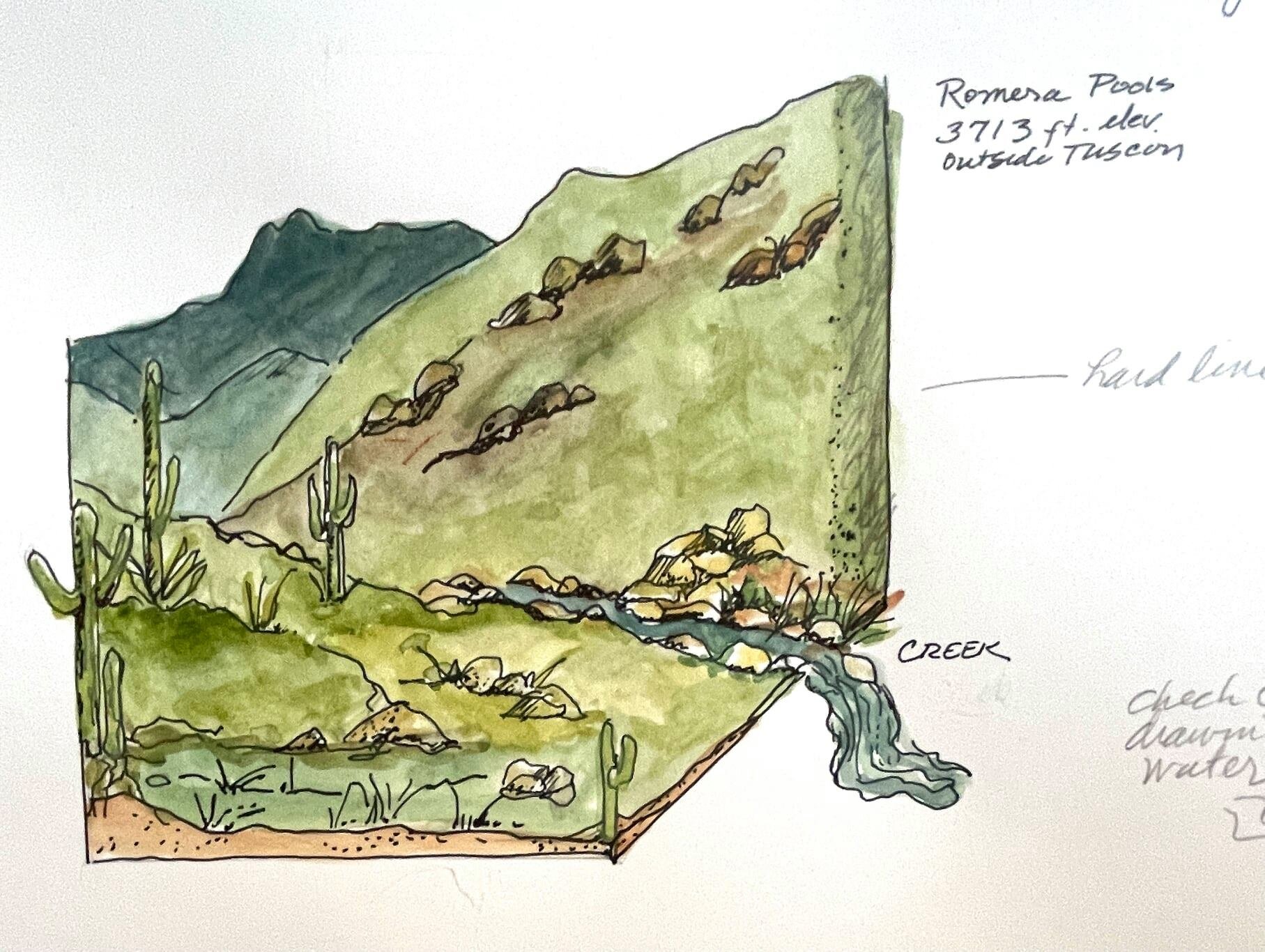

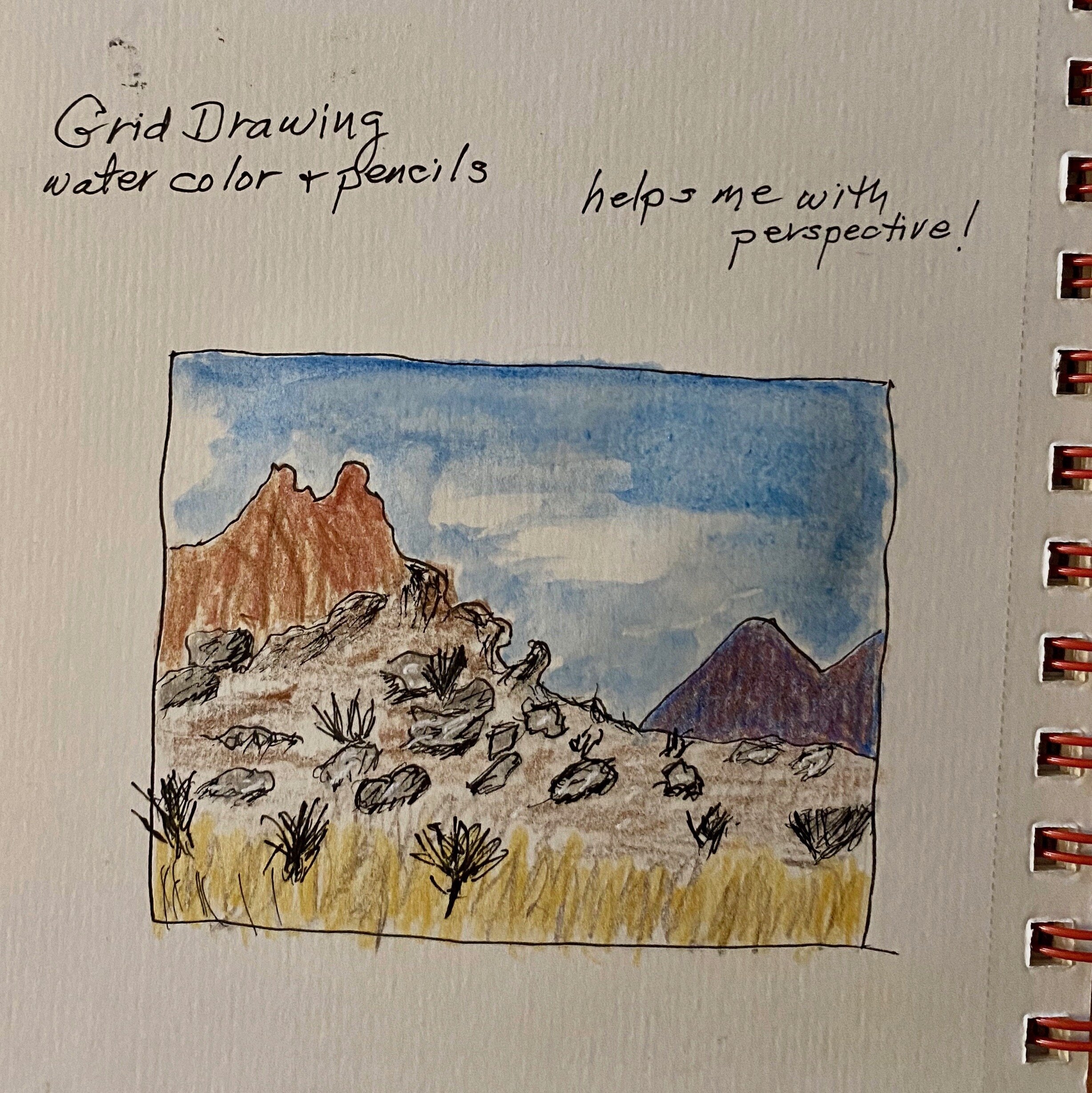
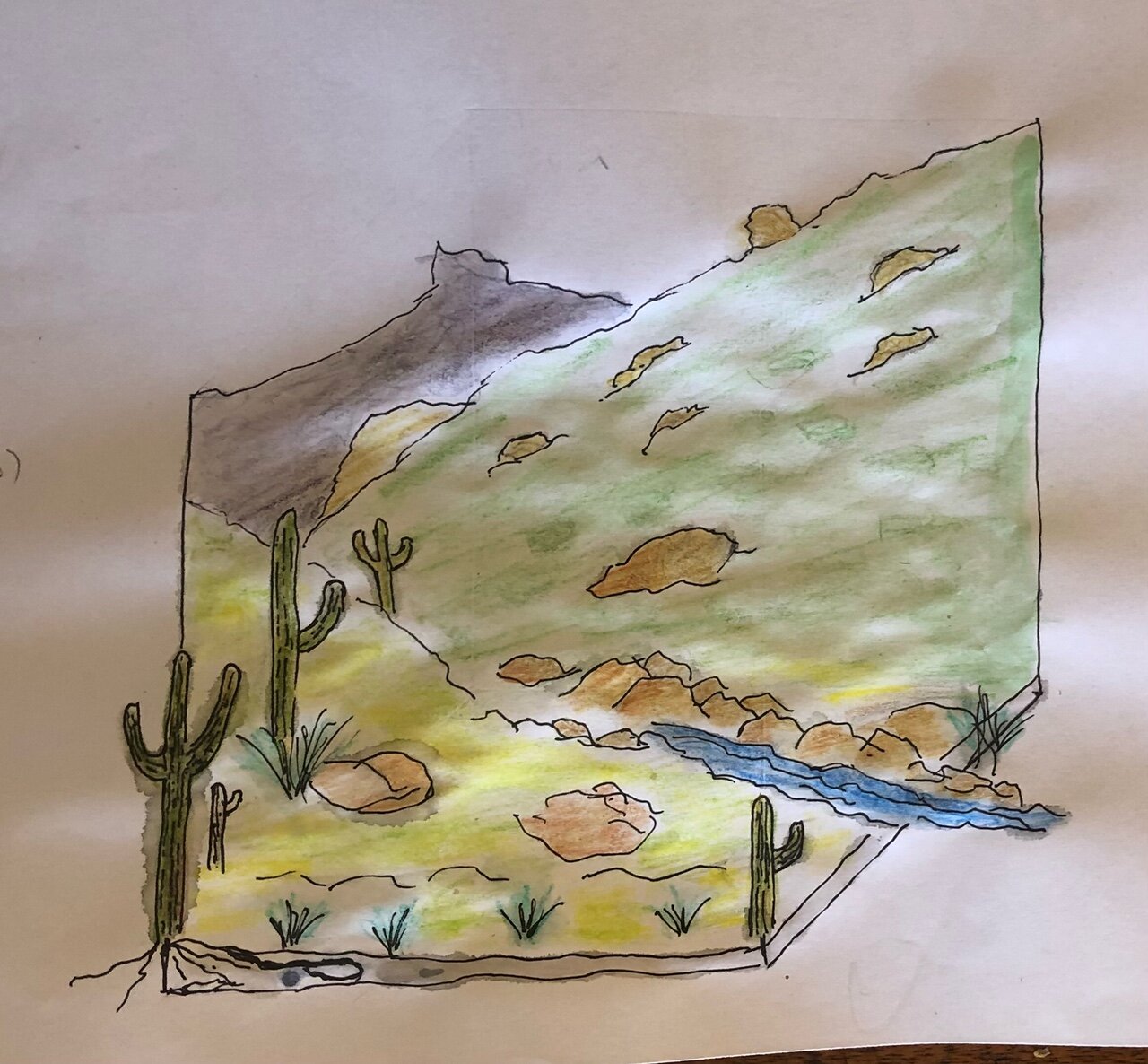
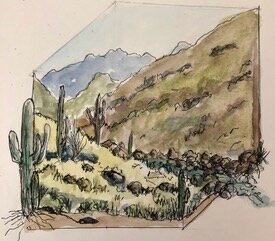
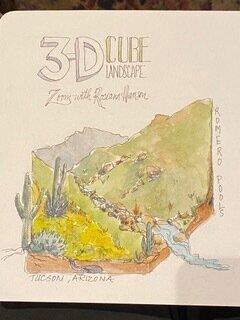
Support free tutorials! Click to contribute to the Tip Jar!
Virtual Field Trip: Mountains and Mesas
Join me on a virtual field trip from Moab, Utah, to Aspen, Colorado, all along backcountry roads through some of North America’s most spectacular scenery as the colors begin turning fiery yellow and red.
Sketch along or just observe, I’ll narrate as I go to demonstrate why I choose to focus on what subjects and how to quickly capture them in your field notebooks and nature journals.
Here is the link to my special Virtual Field Trip experience online so you can explore on your own, at your own pace; click on the “i” icon at the beginning of the “tour” so you can get the instructions on accessing the images and videos (the only scene I sketched that isn’t on the tour is the Gunnison River, which I included below):
https://360exploring.s3-us-west-1.amazonaws.com/Mountains-Mesas-2020/output/index.html
Resources from the Workshop
METADATA AND NATURE DATA:
Gunnison River fall scene.
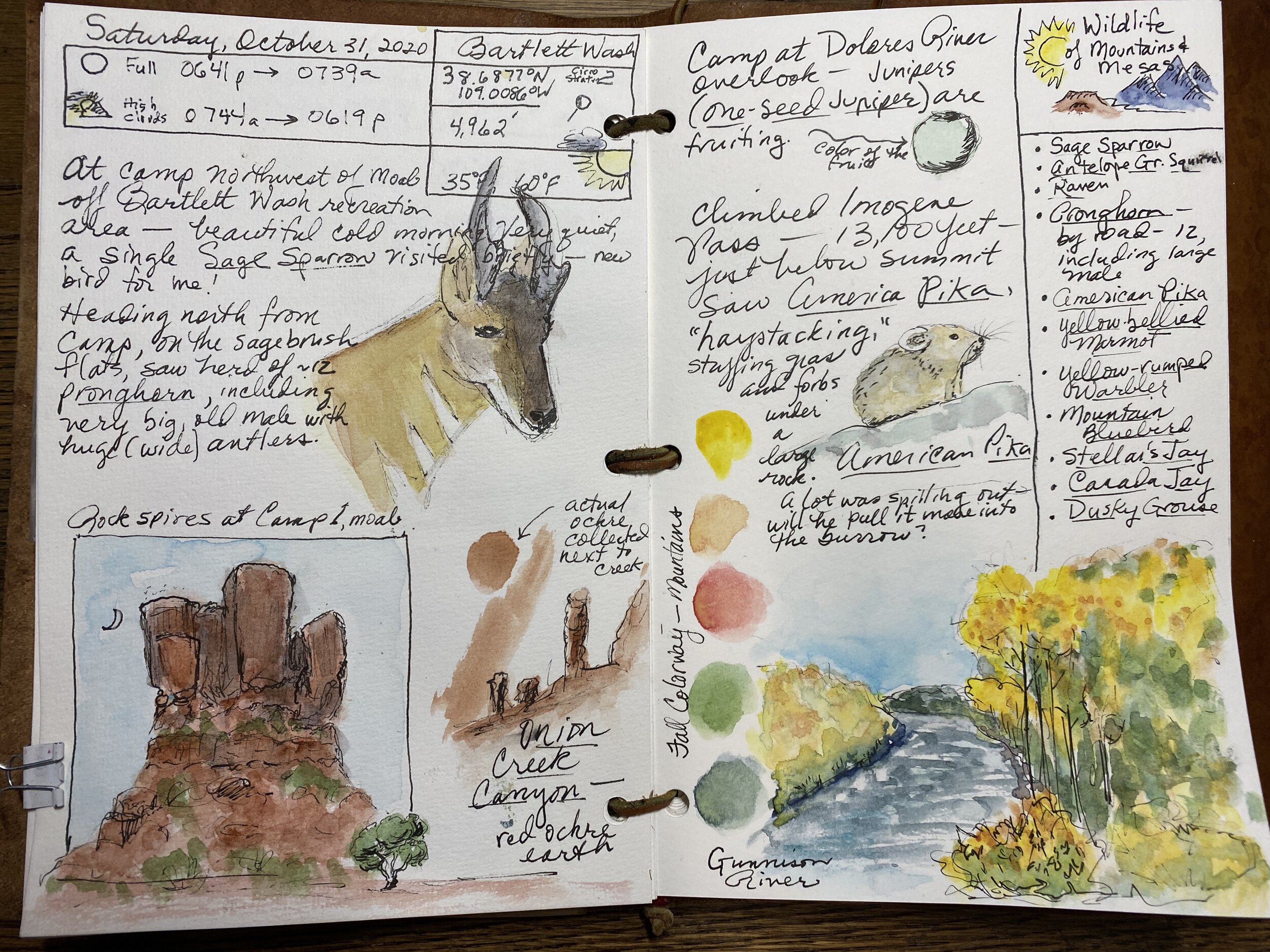
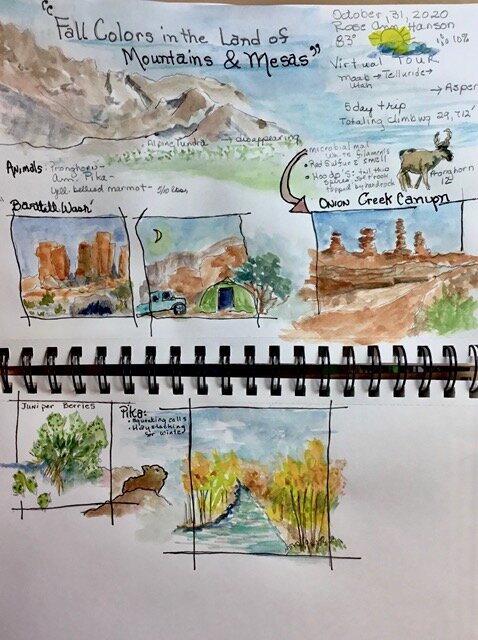
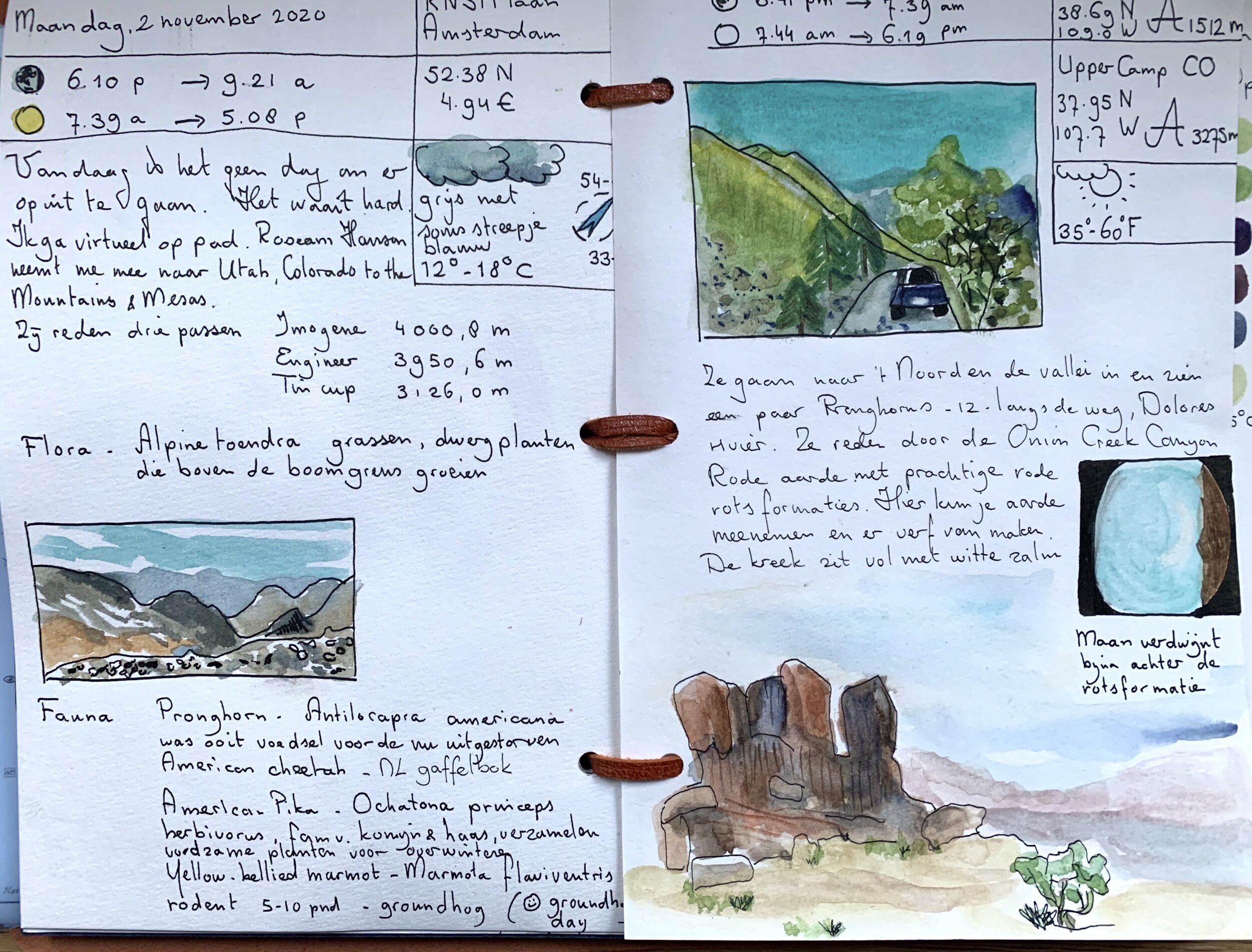
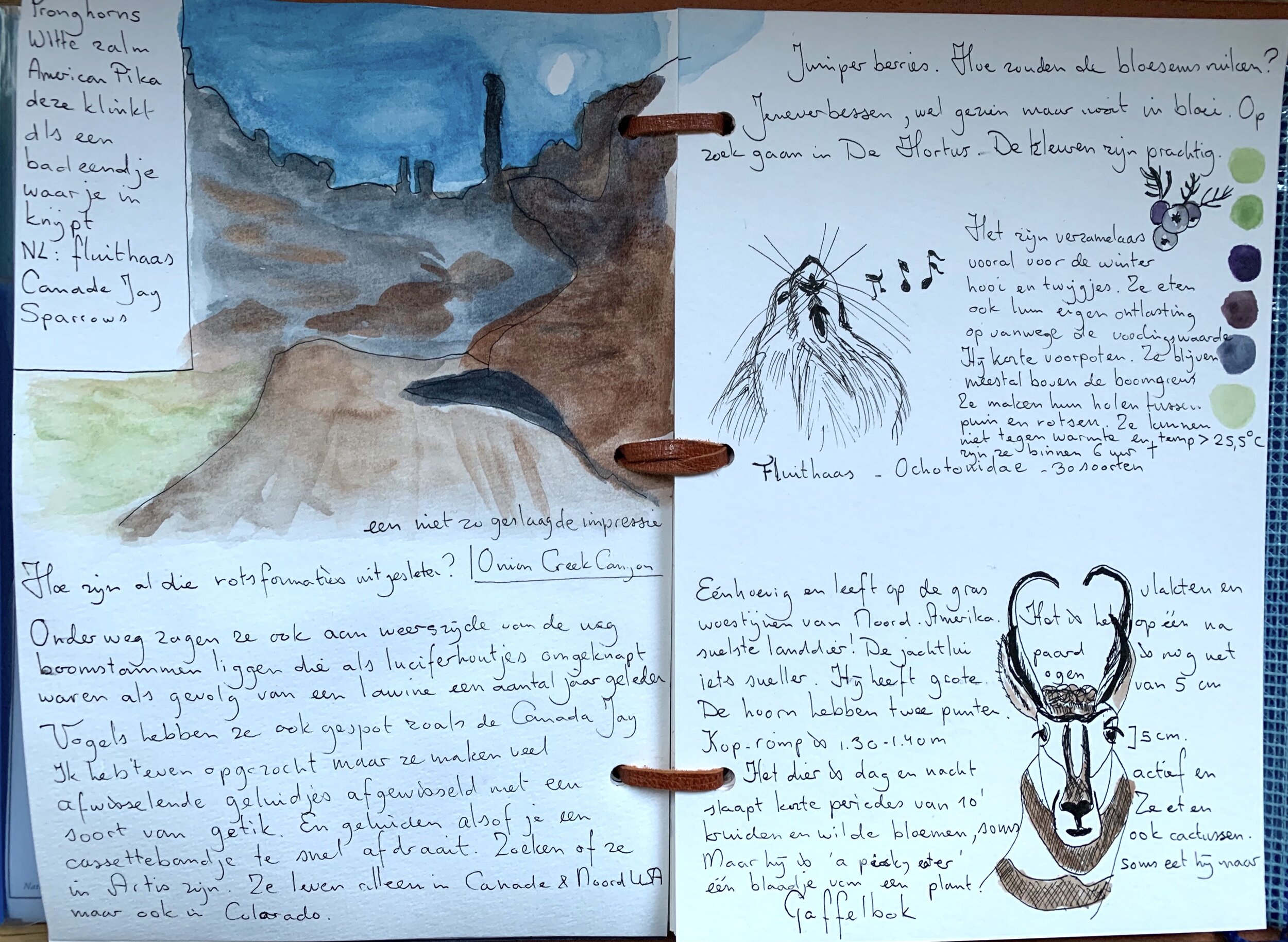
Support free tutorials! Click to contribute to the Tip Jar!
Virtual Field Trip: Monarchs & Milkweeds Micro Safari
Join me on a new kind of exploration—a micro safari! You don’t have to go far to discover wonderful things. We’ll hunker down in a field of milkweed and observe, learn about, and sketch monarchs, as well as many other insects. BONUS: If we have time we might just scoot down to Mexico to observe winter monarch habitat as well. (EDITING NOTE: We had to blur-out some of video at the end; I didn’t have permission to use the PBS / BBC footage even for a free education clip! Sorry about that! You can see the video clip in the link below.)
Footage in the explorations is from: Yosemite Nature Notes; Dominique Lalond Nature Films on YouTube; PBS Nature.
Roseann’s pages from the demonstrations in the workshop.
I mostly use a limited palette of five transparent watercolors (all Daniel Smith): aerolin yellow; quinacridone rose; manganese blue; burn Sienna; indanthrone blue). For the iridescent beetle, though, I followed John Muir Laws’ tutorial in his book The Laws Guide to Nature Drawing and Journaling, and first laid down a pthalo green and a little bit of pthalo blue, then added the darks with blue-black mixed with ultramarine blue and burn Sienna, which lifts off easily. The pthalos are very staining so are good to use if you are lifting color from on top of them.
Resources from the Workshop
Metadata and Nature data:
IMAGES FROM EACH STOP (CLICK TO ENLARGE; RIGHT-CLICK TO DOWNLOAD):
Workshop Attendees’ Pages
Adding Pages to My Handmade Leather Journal
In this short tutorial I demonstrate how I lace pages into my simple leather journal using leather shoelace. I've been using this system for over 20 years and it is inexpensive and versatile, allowing me to archive my pages in three-ring binders.
To see previous posts on how I made my journal and my Minimalist Stand-Up Sketching Kit and printable downloads for weather data, use the links below.
Virtual Field Trip: Unique Grasslands of the World
Join me as we explore three of the world’s grasslands—Australia’s Southern Tablelands in New South Wales, Brazil’s Cerrado, and Alberta’s Southern Prairies—to observe, take notes on, and sketch some well-known animals as well as some lesser-known and fascinating creatures! Sketch along or just observe, I’ll narrate as I go to demonstrate why I choose to focus on what subjects and how to quickly capture them in your field notebooks and nature journals.



